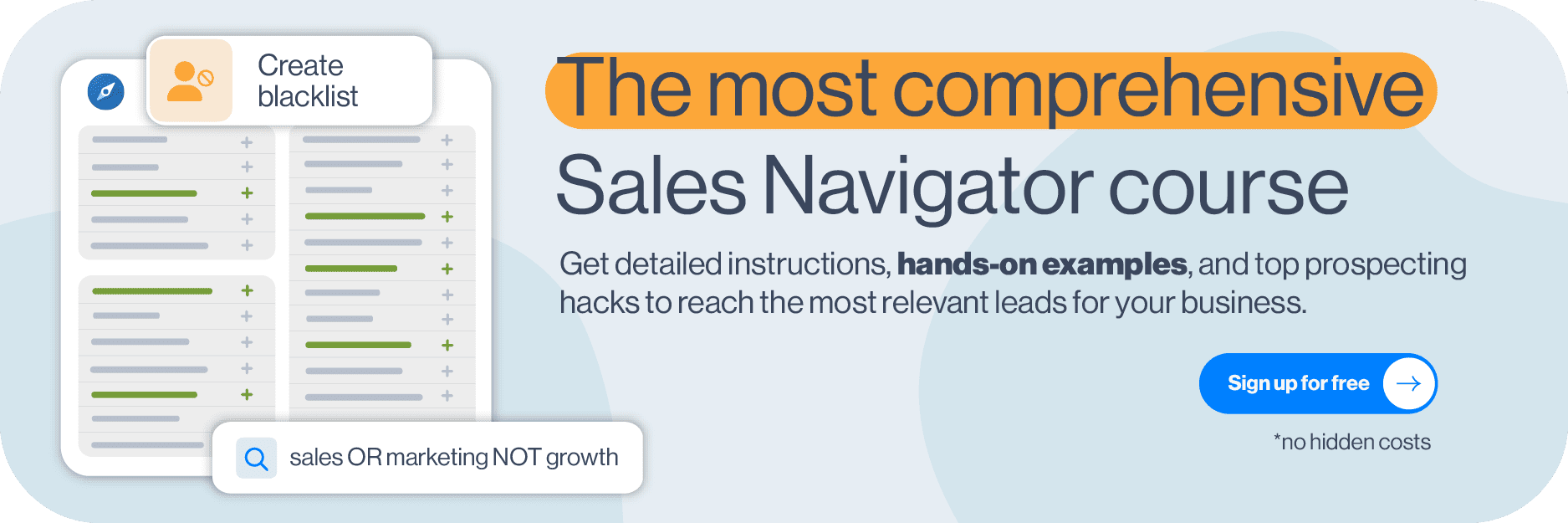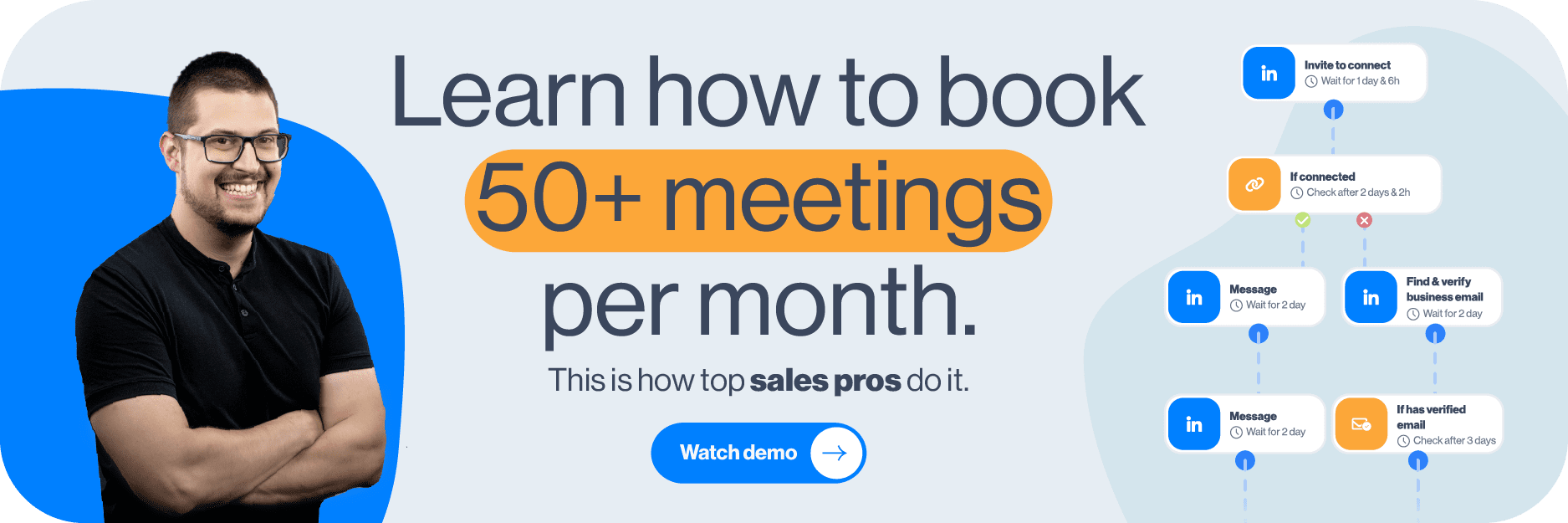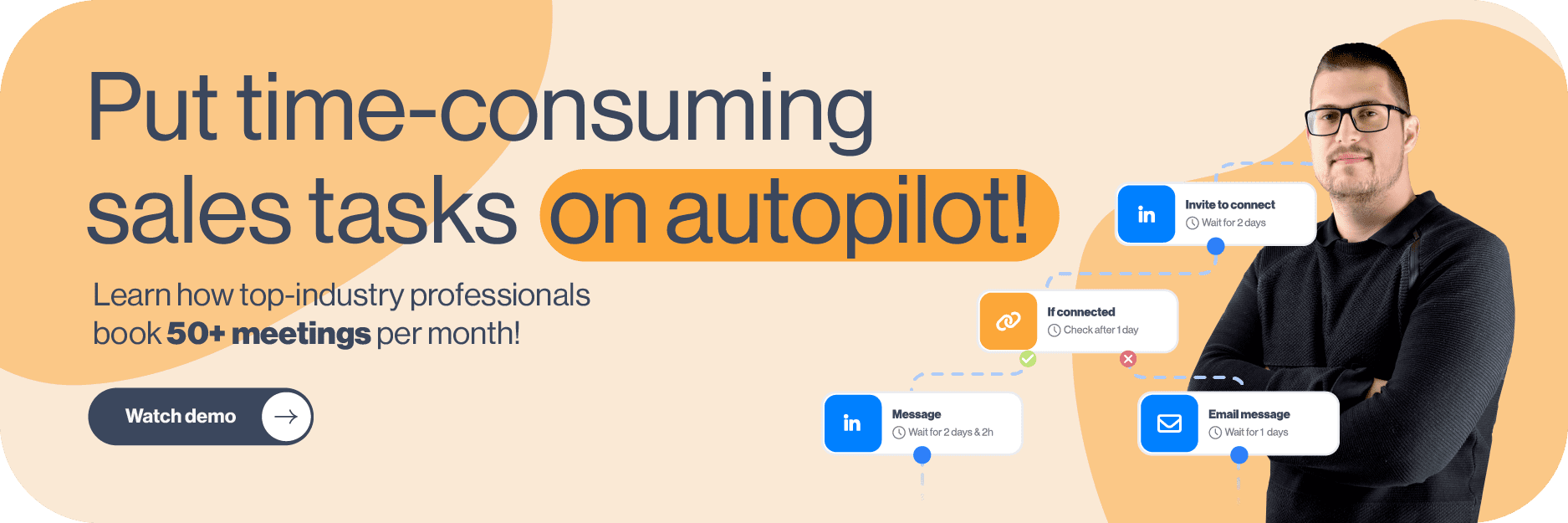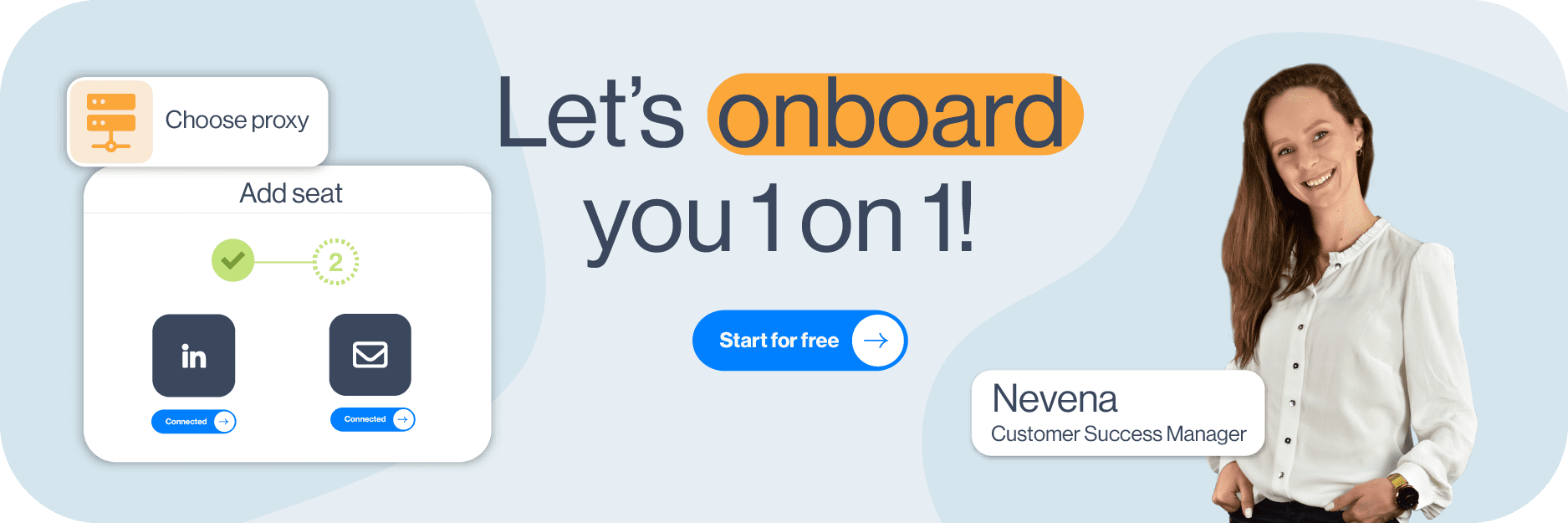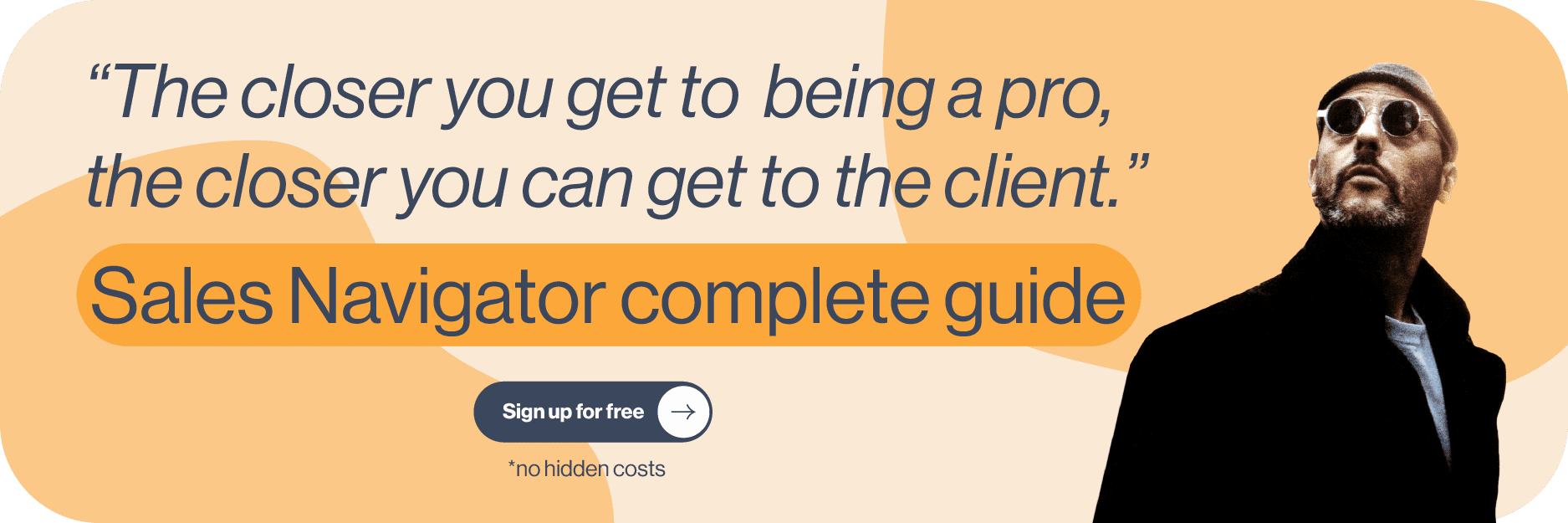Spread the word about your product or service to as many people as you can, and you’ll surely get someone to buy it. That may be true, but think about how much time and resources you’d spend in the process. Precision matters in outreach as much as it does in everything else in business and life. And that’s what targeted outreach is all about.
Targeted outreach helps you connect with people and businesses that need your product or service only—the same ones that can increase your return on investment (ROI) and conversion rates.
The question is, how do you make it work for you?
That said, in this blog, we’ll be covering:
- What targeted outreach is,
- Who and how can benefit from it,
- How to plan and execute a targeted outreach campaign,
- Actionable strategies and best practices for targeted outreach,
- Common challenges you may encounter.
As a bonus, you'll get message templates to immediately transform your outreach strategy from a shot in the dark to a laser-focused one.
Off we go!
What is targeted outreach?
Targeted outreach is a type of outreach that focuses on engaging specific, predefined groups or individuals. It implies delivering tailored messages, resources, or services that align closely with the needs, interests, and behaviors of these targeted audiences.
While traditional outreach employs a broad, one-size-fits-all strategy, targeted outreach is more nuanced. Namely, it uses detailed data and insights to not only identify the target audience but also understand them. In contrast to traditional outreach, which relies on mass communication channels and broad demographic information, targeted outreach is all about relevancy and personalization.
Benefits of targeted outreach
Blasting your message to everyone and anyone might get you a few bites. However, targeting your outreach is a much smarter, more efficient way to connect with leads. It's a tactic sales professionals, marketing specialists, and B2B founders, in particular, stand to gain a lot from.
But the question is, what?
Firstly, one of the primary benefits of targeted outreach is superior LinkedIn lead generation and that on other platforms.
When you are precise about who you’re targeting and why, the results are higher-quality leads. Moreover, when you aren’t wasting your time chasing irrelevant prospects, you can afford to spend more time nurturing those more likely to convert.
Then, there’s better brand awareness and recognition.
When messages are tailored to resonate with specific audiences, they are more likely to be noticed and remembered. This relevance makes the outreach more effective and also helps in building a stronger connection with prospects. Over time, this leads to increased brand loyalty but also a more substantial presence in the market.
However, increased conversion rates and a higher return on investment (ROI) are perhaps the most compelling benefits of targeted outreach.
Targeted campaigns are more likely to generate returns, as the goal of this strategy is to minimize wasting efforts on uninterested parties. This fact alone is precisely why targeted outreach strategies are some of the most cost-effective sales and marketing strategies.
How to plan your targeted outreach campaign
Looking to jump on the targeted outreach wagon?
Congrats! That said, let’s see how you can prepare and launch one such campaign.
Targeted outreach preparation
1. Define your target audience
The first and arguably most important step in planning your targeted outreach campaign is defining your target audience. After all, without knowing who you're talking to, your message is likely to miss the mark.
So, how do you pinpoint your ideal audience?
Start by identifying your Ideal Customer Profile (ICP).
Your ICP represents the type of company or individual who would most benefit from your product or service.
To define it, consider factors like:
- Industry
- Company size
- Location
- Challenges they face
For example, if you're offering a software solution for project management, your ICP might be mid-sized tech companies in urban areas that struggle with team collaboration.
Once you've nailed down your ICP, it's time to refine it further by creating detailed Buyer Personas.
A Buyer Persona is a semi-fictional representation of your ideal customer in your ideal company. You define it based on market research and real data about your existing customers.
This should include:
- Demographic details—age, gender, education
- Professional information—job title, responsibilities, goals
- Behavioral insights—pain points, decision-making process, preferred communication channels
Combine your ICP with detailed Buyer Personas, and you’ll have a crystal-clear picture of who you should target. Doing so will allow you to tailor your outreach messages accordingly, making them more relevant and compelling to those who receive them.
2. Conduct online research
Now that you know who you should be targeting, it's time to find leads and understand their pain points.
This is where online research comes in handy, with LinkedIn being one of the most valuable tools available.
For most of your research, you’ll rely on LinkedIn search filters to identify key prospects and gather insights.
However, if you are subscribed to Sales Navigator, you might be better off using it for this part of the process.
Why? Because Sales Navigator filters include a total of 34 Lead filters, 16 Account filters, and a Keyword filter.
Arvind Rongala, CEO of Edstellar—a one-stop instructor-led corporate training and coaching solution—explained that Sales Navigator played a big role in the company’s targeted outreach. It helped them define their target audience, which would later result in a 30% increase in lead generation, a 25% rise in sales, and a significant improvement in customer retention.
He mentioned that:
‘’Tools like Google Analytics and LinkedIn Sales Navigator provided valuable insights into the demographics, interests, and behavior of our potential clients.’’
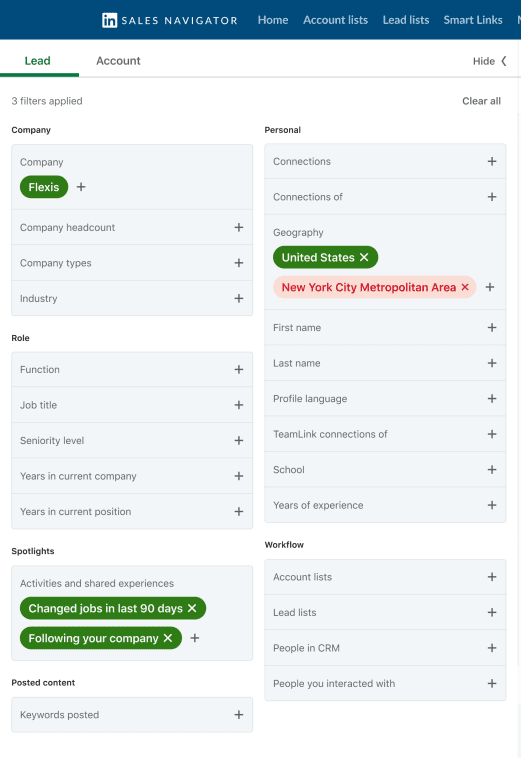
Now, as for researching leads, what you want to do first is use the search bar and filters to look up companies that fit your ICP. Once you have a list of potential companies, explore their LinkedIn pages to gather information about them, check their recent updates, and learn about their company culture.
Then, look for decision-makers within these companies.
Pay attention to their:
- Job titles
- Responsibilities
- Career history
- Posts they published
These can help you understand their roles within the company, but also how your product/service can solve their problems.
Another good place to find and research leads is LinkedIn’s collaborative articles. Think of these as "knowledge topics" filled with real answers submitted by the LinkedIn community.
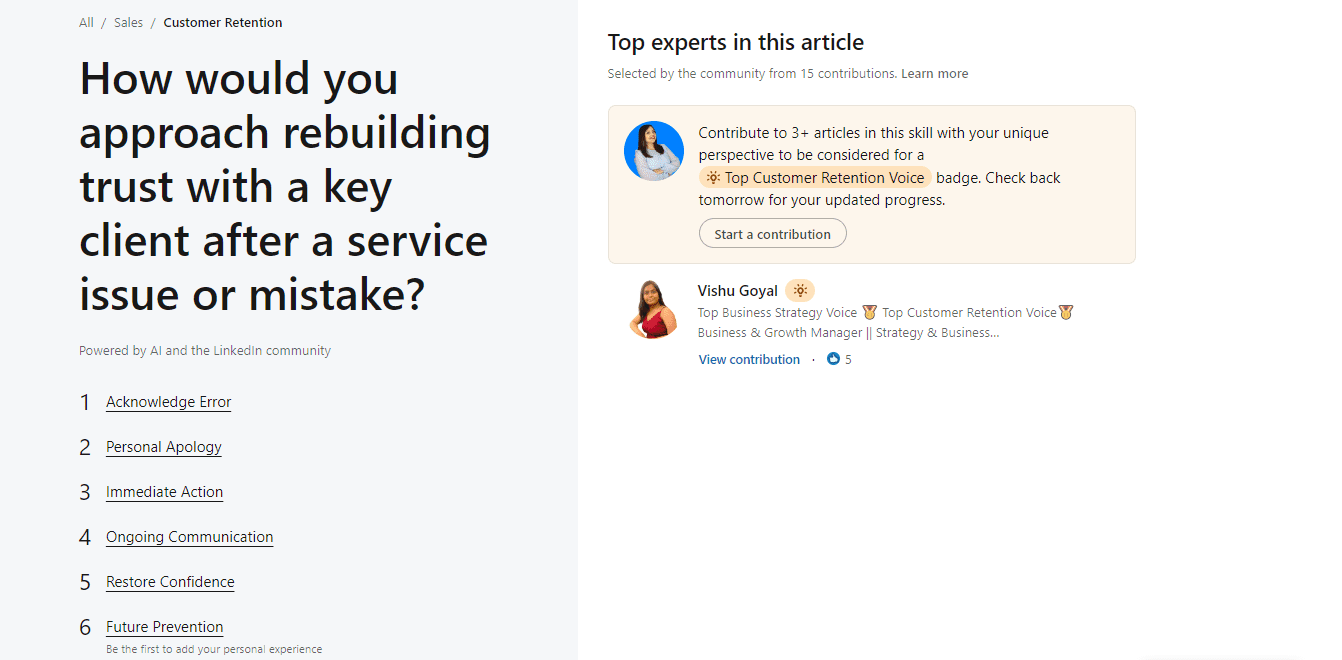
Check if any of your potential leads have contributed to them. If they have, fish for information regarding:
- The topics they are discussing,
- Pain points and interests they have potentially mentioned.
Once done with LinkedIn prospecting, compile the info you gathered into one centralized document.
And if you’ve found your leads through filtered searches, hold onto the URLs. You might need them later.
But more on that in a bit. 😉
Targeted outreach execution
1. Develop your message
Planning your targeted outreach efforts is only part of the process, and it’s the execution that matters.
But before you begin reaching out to your target audience, you need to craft messages that your prospects will find intriguing.
As you do, think about what you want to achieve with them.
Are you looking to book more meetings, invite people to join your community, or simply make an introduction?
Either way, your goal should be clear from the get-go. This way, you won’t lose focus, and your messaging will remain direct and to the point.
Don’t be afraid to leverage what you learned during research! Instead, use the information about your prospects’ pain points, interests, and company challenges to craft messages that speak directly to them. Generic messages are easy to ignore. However, a tailored message shows that you've done your homework and makes you stand out in their inboxes.
As for the message itself, start it with a strong, engaging opening. This could be a relevant observation, a question, or a compliment. For instance, if you noticed a company update or a recent achievement on their LinkedIn page, feel free to mention it.
It’s important not to beat around the bush, though.
In fact, aim to deliver your message in a few short paragraphs at most, as busy professionals appreciate brevity.
Also, make sure to avoid jargon and keep your language clear and straightforward.
Here’s an example of a LinkedIn message that follows through on these practices:
‘’Hi Alex,
I noticed on your LinkedIn that you recently attended the Sales Leadership Forum. I came across a report that explores strategies discussed there, particularly around improving forecast accuracy and reducing sales cycle times.
Would you like me to send it to you? I’d love to hear your thoughts !''
2. Choose the right channels
So, you have your message. Now what?
It’s time to decide on the channel to use for targeted outreach.
Email remains one of the most effective ones, with, according to HubSpot, the email open rate ranging from 25% to 41%. As for the average response rate, some sources indicate it's as low as 1%, whereas others report it to be up to 8%.
Apart from email, most professionals who use LinkedIn for B2B marketing or sales use it to reach out to their leads directly. Besides, the average response rate for LinkedIn messages is much higher. For example, we at Skylead had an average response rate of around 39%.
Beyond email and LinkedIn, social media platforms like Facebook and X can also be effective, depending on your audience.
Even the old-fashioned cold-calling might work on some prospects, although success rates can widely range between industries.
However, that begs the question: What channel should you opt for?
We say multiple ones!
A multichannel approach allows you to reach prospects through various touchpoints and, thus, increases your chances of engagement.
This way, you have the highest chance of getting through, even if the prospect is more active on one channel over another.
But more on that in the next section.
3. Create a multichannel targeted outreach campaign
The multichannel route is the best one to take for your targeted outreach. That much we’ve established.
But why engage your prospects through several channels manually when you can do it all on autopilot?
Enter email and LinkedIn automation.
LinkedIn automation implies the use of LinkedIn automation tools to automate repetitive tasks on this platform. These typically include sending connection requests, messages, LinkedIn inMails, profile visits and follows all on autopilot.
But since the premise of multichannel outreach is to use, well, multiple channels, using a LinkedIn automation tool isn’t enough.
You need LinkedIn automation AND cold email software—just like our very own Skylead!
And you know what's great about our tool? You don’t necessarily need to find your leads’ emails yourself. Skylead can discover and double verify emails for you at no additional cost and without breaking your targeted outreach flow or without leads being part of your network.
Now, let’s walk you through the process of creating a targeted outreach campaign involving LinkedIn and email in Skylead.
Firstly, go to your Campaigns page and click ‘’Create new campaign.’’
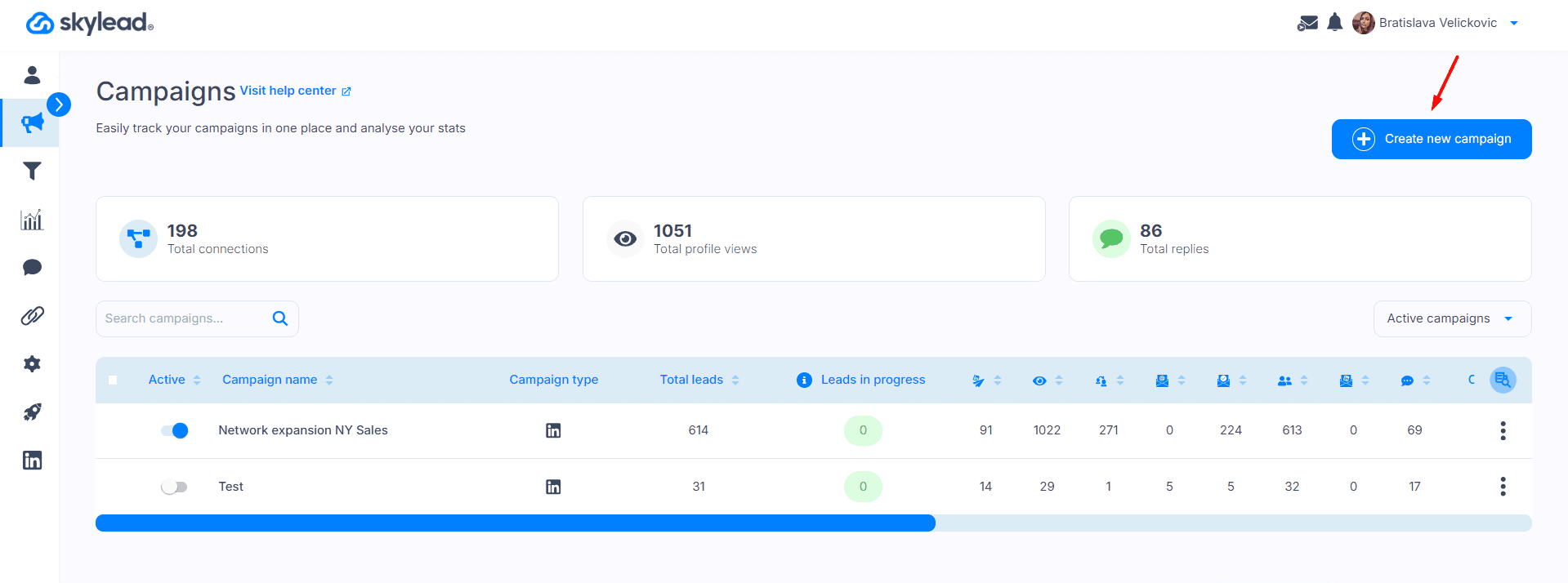
Next, choose your campaign type, name it, and insert the URL you saved while prospecting. Skylead will use it to extract leads.
You can use:
- LinkedIn search, post, and event URL
- Sales Navigator search and lead list URL
- Recruiter search, Talent Pool, and Pipeline URL
You can also import your leads' information into the software directly. In that case, upload a CSV file with precise leads’ information.
Choose the connection degree based on whether you want to target your 1st, 2nd, or 3rd-degree connections, and hit ‘’Next.’’
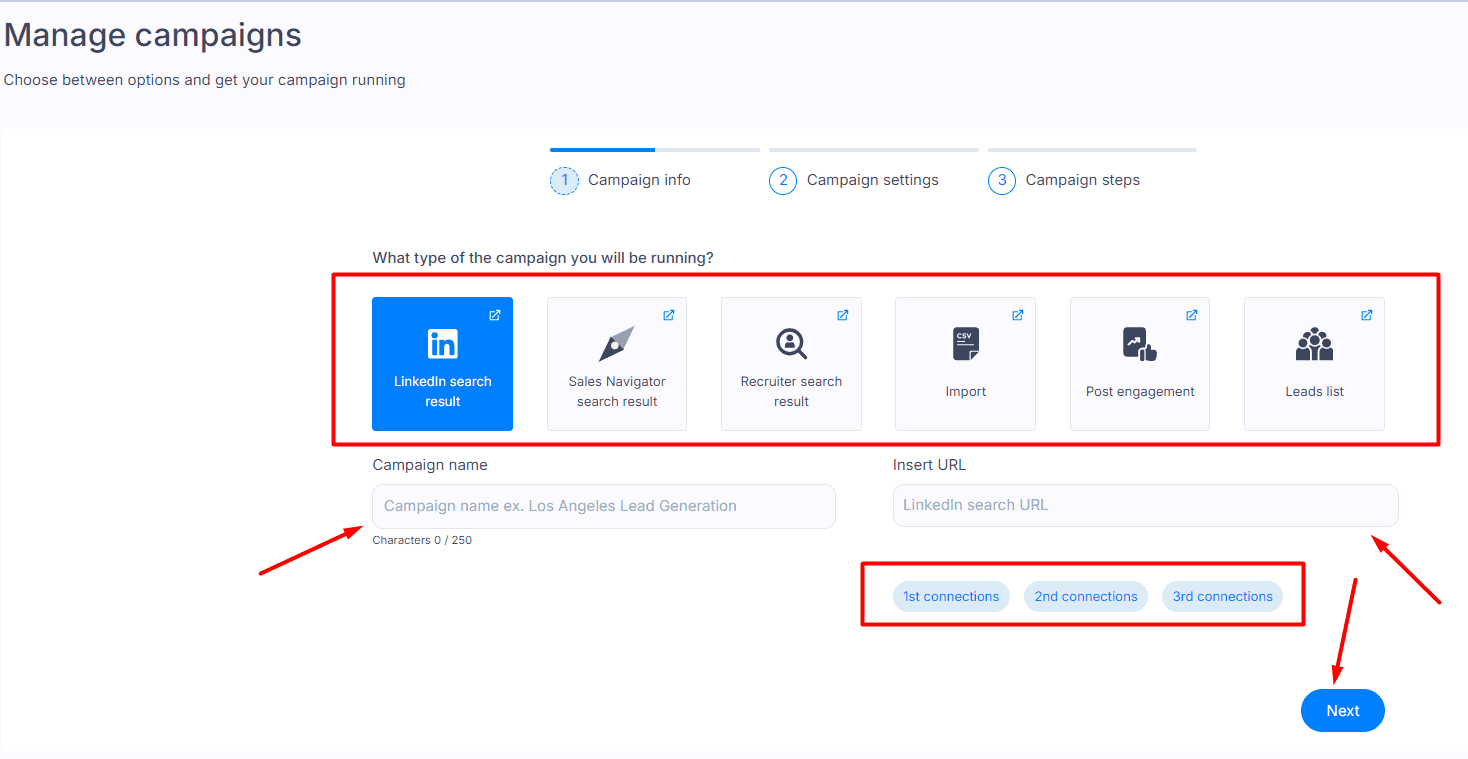
Your next step is defining campaign settings.
That said, there are 3 types of settings:
- Global
Under email settings, you can select the email accounts to use in the campaign. Skylead lets you connect an unlimited number of email accounts at no extra cost. In turn, it helps you scale your email outreach by allowing you to send tens of thousands of emails a month.
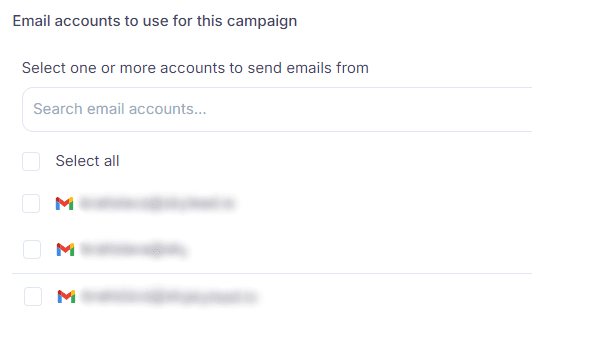
Feel free to check out our blog about launching a 1st outreach campaign to learn more about available settings. You can also play around with them on the spot.
Finally, when you're happy with the setup, you can move on to create a sequence.
How to make a targeted outreach sequence
Skylead was the first tool on the market to introduce smart outreach sequences, or as we call them, Smart sequences.
Smart sequences combine if/else conditions with LinkedIn and email actions to create coherent outreach flows. These unfold according to your leads’ behavior and, thus, help you maximize touchpoints with them.
For instance, you can start with a LinkedIn connection message and move on to email if the prospect isn’t responsive. Nonetheless, if neither proves fruitful, you can always go back to LinkedIn and try your luck with an inMail.
To create one, continue by clicking the ‘’Create sequence’’ button.
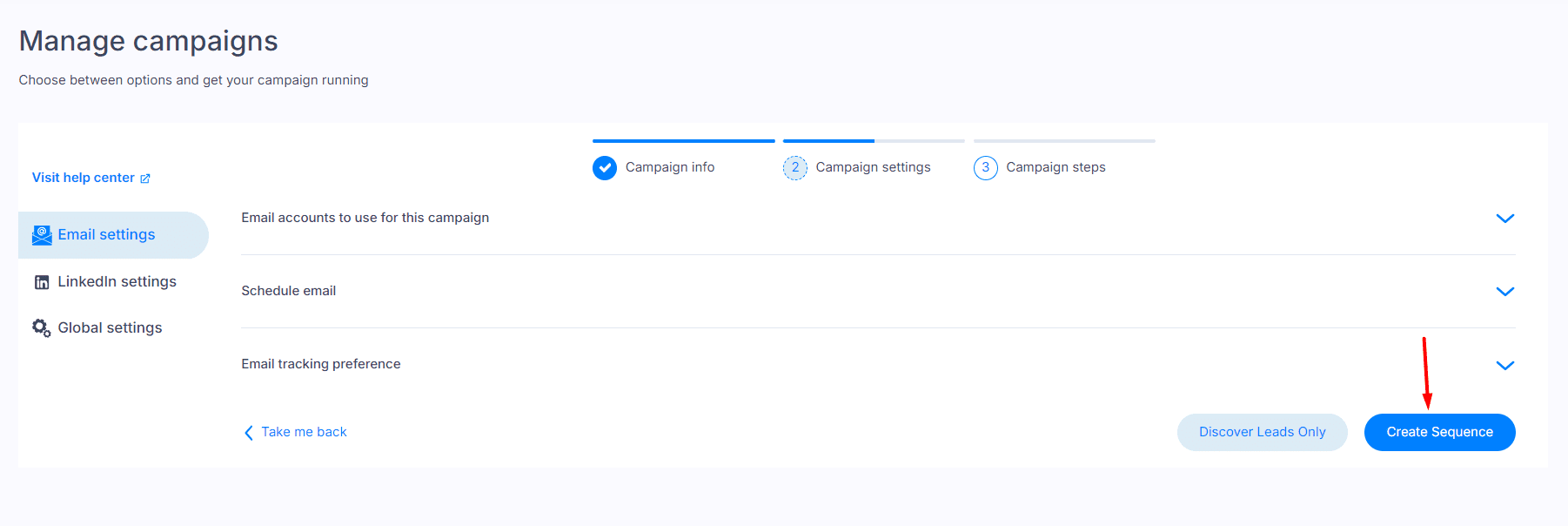
You can create a new one from scratch or use one of our proven Smart sequence templates.
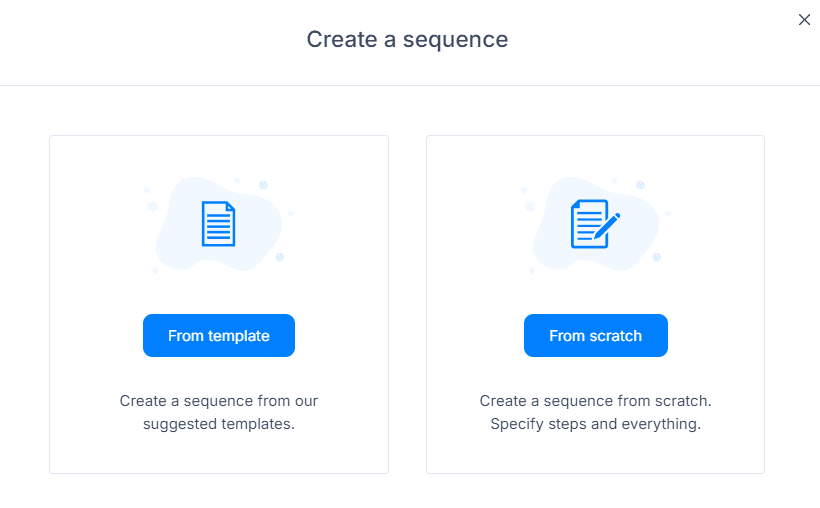
However, for the sake of this blog, let’s show you how to create a new Smart sequence.
So, choose ‘’From scratch’’.
You’ll immediately be taken to a Smart sequence builder page.
Then, on the right pane, you’ll see elements, a.k.a. available actions and conditions.
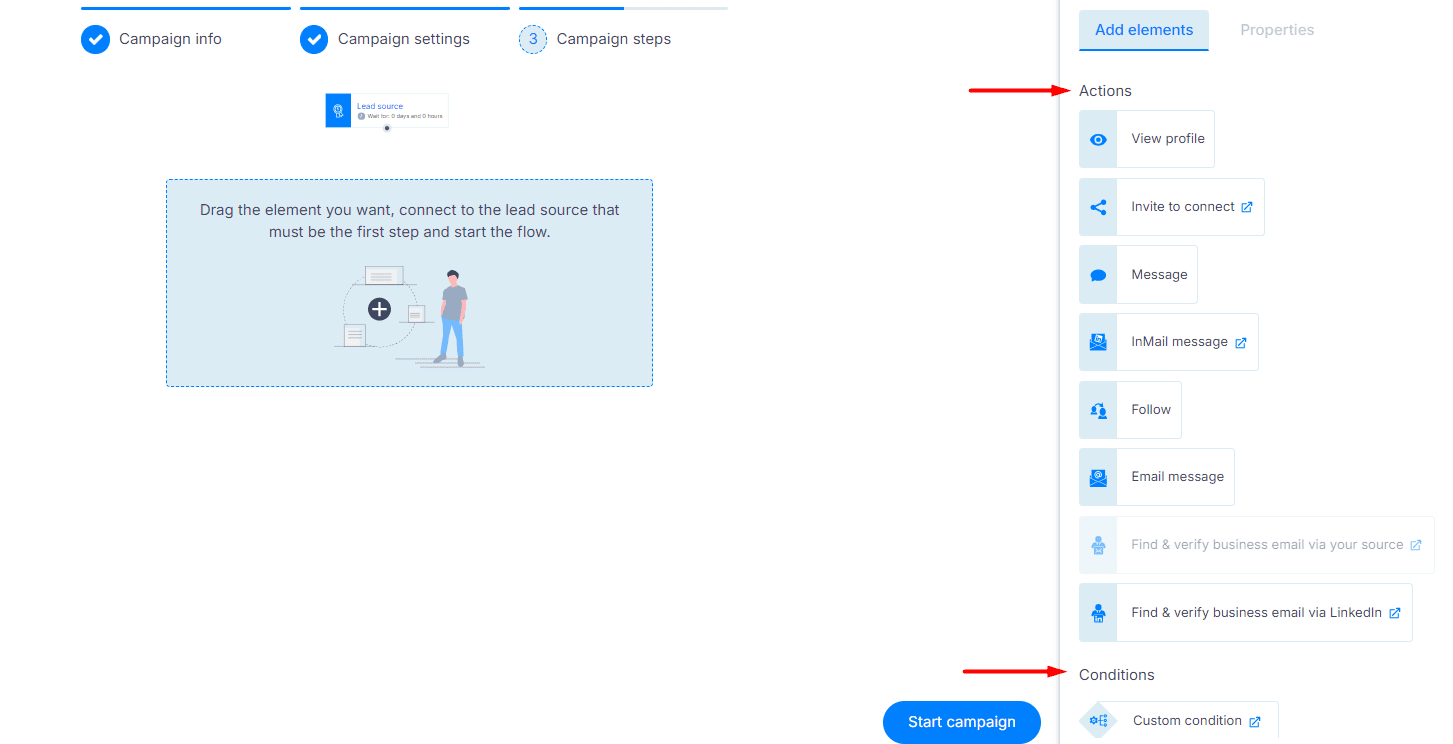
To build a Smart sequence, drag and drop the elements into the open space and connect them in a coherent outreach flow.
Here’s a rundown of the available ones.
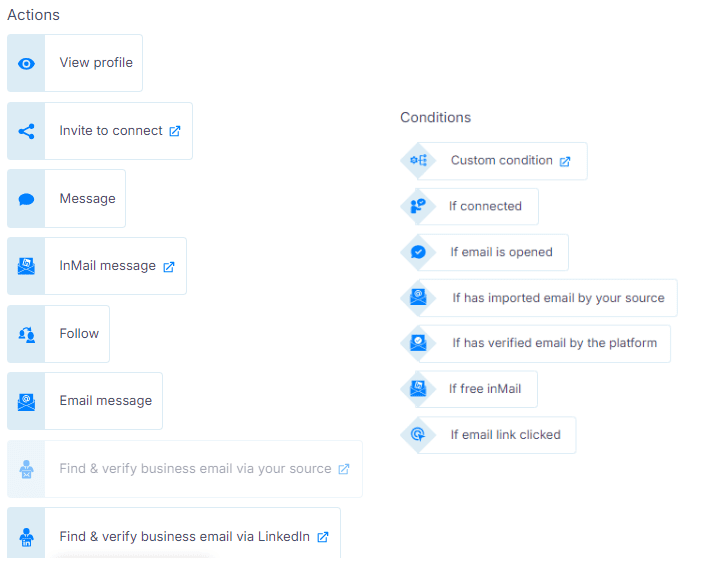
Message-based actions let you insert variables for personalization and perform A/B testing of up to 5 different message variants.
As for variables, you can opt for pre-set ones or create your own if you use a CSV file as a lead source.
Additionally, you can insert an image or GIF into your message and personalize it to each recipient for added flair.
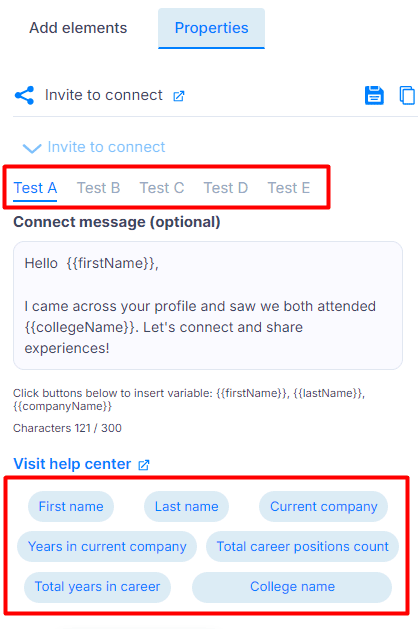
The last thing to do is set delays between different steps.

Finally, this is what one Smart sequence can look like.
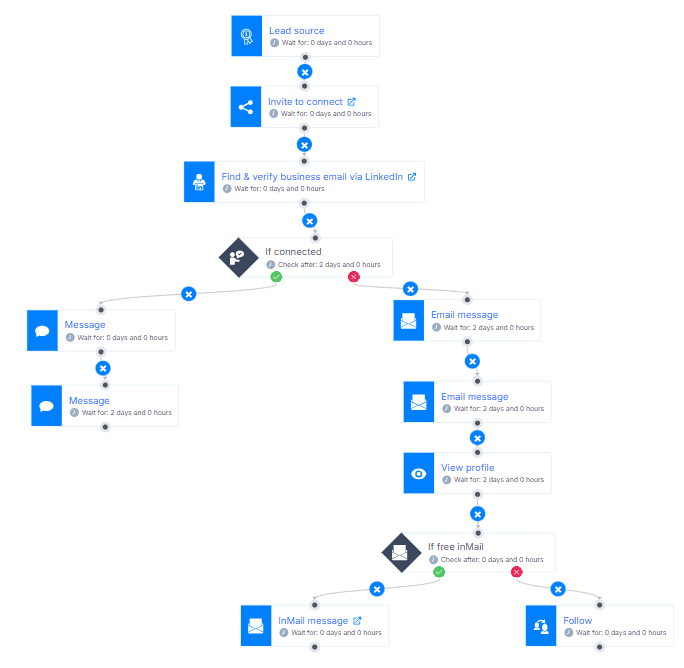
Once you’re happy with it, you can save it as a template.
Then, hit the ‘’Start campaign’’ button and watch your targeted outreach efforts come to fruition!
Actionable strategies and best practices for targeted outreach
Want to maximize the effectiveness of your targeted outreach?
If so, use the following strategies and best practices to connect with your leads on a deeper level and give your conversion rates a boost!
1. Personalize, personalize, personalize
As we’ve already established, personalization is the backbone of targeted outreach.
When you take the time to customize your messages, recipients feel more valued and understood. This can significantly boost response rates.
Start by using their name in your communication and referencing specific details you previously learned.
Here’s an example of a message that includes personalized details:
‘’Hi Sarah,
Seeing as your focus is on customer engagement at Innovate Marketing, I thought you might appreciate this guide on enhancing customer retention. It dives into actionable tactics for maintaining long-term relationships with customers, which could offer some fresh perspectives for your team.
Feel free to check it out here—I’d love to hear your thoughts!’’
You might be thinking: all of this takes a lot of time and effort.
Why, yes. But it doesn’t have to. At least, not with Skylead.
Our tool can help you save up to 11 hours a week on time-consuming targeted outreach tasks such as this one.
Instead of tweaking information message by message, why not rely on Skylead to fill in variables according to each lead?
Variables are placeholders used to increase the level of personalization in cold outreach messages. Skylead lets you use pre-set ones that automatically get filled in based on information available on your leads’ LinkedIn profiles, including:
- First name
- Last name
- Current company
- Years in current company
- Total career positions count
- Total years in career
- College name
- Occupation
However, you also have the option to create custom variables using any information you want to catch your leads’ attention even further.
But if you really want to stand out in their inboxes, we’ve got another surprise in store: our native Image & GIF personalization feature.
To use it, upload any image or GIF you want to our image editor.
Then, enrich it with your or your lead’s:
- Profile image
- Company logo
…and add any text of your choice, complete with variables.

Finally, insert the unique visual into your message, kick off your campaign, and watch your response rate increase to 63% & more!
Don’t trust this is possible?
Just look at the impressive results we had with this image!
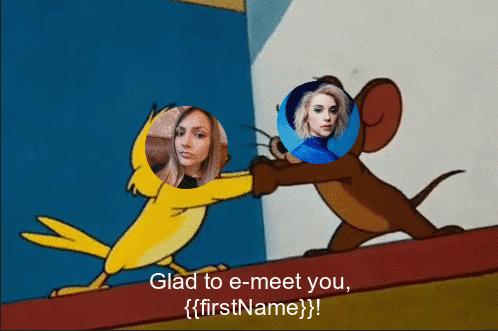

2. Provide a strong value proposition
Your targeted outreach messages need to convey the value you bring to the table. That said, it’s not enough for your prospects to understand what you’re offering. They need to understand why it matters to them specifically.
A strong value proposition addresses their pain points and demonstrates how your solution can solve them.
Now, say you were selling project management software. Don’t bore your prospects to death by talking about the features on and on! Instead, position your tool as one that increases efficiency, saves time, and reduces operational costs.
Here’s an example message to paint a better picture:
"Hi Lisa,
I know how challenging it can be to keep multiple projects on track, especially with the fast-paced environment at AdVantage Pro. That’s where TaskFlow can make a difference. Our software centralizes tasks and automates routine processes so you can focus on what really matters.
With TaskFlow, you’re looking at saving around 10 hours a week and cutting operational costs by up to 20%—giving you more time to drive the strategic growth you’re aiming for."
If you can, also incorporate testimonials or case studies in your pitch to back up your claims and build credibility in your prospects’ eyes.
So, ensure your value proposition is front and center in your messages, and you’ll capture attention immediately.
3. Nurture relationships beyond initial contact
Targeted outreach is not a one-and-done process. The connections you establish need to be nurtured for the cold prospects to remain warm leads.
So, after your initial contact, send follow-ups to keep the dialogue alive.
Remember to check in regularly and keep providing value long-term.
You can do so by, for example, sharing a useful ebook, inviting them to a webinar, or giving them early access to new features. This shows you’re always working to support their business, making them more likely to turn to you when they need your services.
Take a look at this example:
"Hi Alex,
I wanted to follow up and share something I think you’ll find valuable. Next week, we’re hosting a webinar on advanced project management strategies specifically designed for teams like yours at Bright Ideas Co.
It’s a great opportunity to dive deeper into techniques that can help streamline your processes and drive better results. I’d love for you to join us—let me know if you’re interested, and I’ll send over the details.’’
Challenges of targeted outreach and how to solve them
While targeted outreach can bring excellent results, chances are not everything will go according to the plan. That's why you must prepare for challenges and learn how to overcome them once they come.
Rejections
You'll encounter 3 types of leads during targeted outreach:
- Unresponsive leads
- Those who react positively to what you are offering them
- Those who react negatively or throw objections your way
Objections are a natural part of the process, but receiving them doesn't automatically mean a lead has gone to waste.
Sales representatives, for example, encounter them on a daily basis. However, top sales reps are top for a reason because, as our CEO, Relja, puts it:
‘’They see each objection as a different opportunity.‘’
So, instead of dreading the objections, learn how to handle them gracefully to turn them into precisely that!
Objection handling involves active listening to understand where the lead is coming from without interrupting or becoming defensive.
It also implies acknowledging their concerns to defuse tensions and allow for a constructive conversation.
When faced with a specific objection, you also want to address it with relevant information that highlights the benefits of your product or service. Use data, case studies, or testimonials to back up your claims.
Also, if the objection concerns pricing, emphasize the long-term value and ROI your product/service offers. On the other hand, if it concerns features, explain how your solution better meets their needs than competitors.
Furthermore, keep in mind that sometimes an objection might signal that the lead needs something slightly different. So, be flexible and offer alternatives or adjustments that might better suit them.
If they remain hesitant, don't push too hard. Instead, suggest a future check-in and express your willingness to help whenever they are ready.
Poor time management
Targeted outreach is more complex than traditional outreach. As such, it takes more time. Therefore, it's not surprising that some people who use it struggle with poor time management.
Inefficient time use can lead to missed opportunities and subpar results.
Nonetheless, you can get ahead of it if you prioritize tasks based on their impact on your outreach success. Focus on high-value activities such as identifying high-potential leads, personalizing messages, and analyzing campaign performance.
Not making data-driven decisions
Speaking of analyzing campaign performance, did you know that many people tend to overlook it?
When you don’t keep up with campaign results, you miss out on making data-driven decisions that can improve its performance.
Fortunately, Skylead streamlines campaign tracking thanks to a dedicated Reports page.
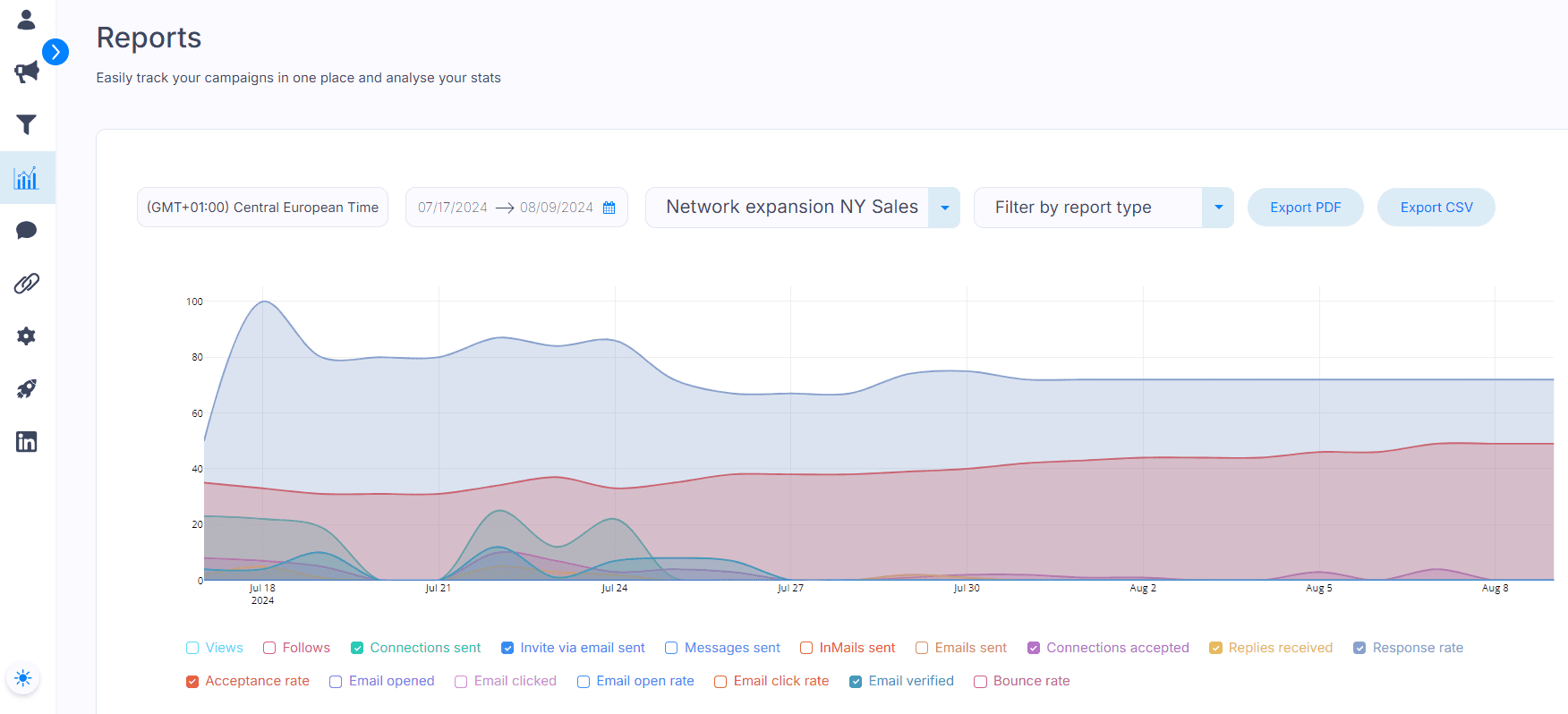
Here, you can analyze your campaigns for any given time period in 3 different view modes:
- Graph - To observe oscillations and spot trends easily;
- Table - To keep track of metrics and review daily changes;
- Step-by-step - To identify the most promising sequences and review the results of your A/B tests.
Now, say your campaign involved multiple channels, multiple emails, and multiple LinkedIn accounts. Think how much time you'd be losing switching between them manually only to keep the conversations going.
Luckily, Skylead also comes with a Smart inbox that holds all your email and LinkedIn correspondences in one place. And since it does, it makes it possible to streamline your workflow without missing important interactions. What's more, you can even label chats for added organization and improved ROI and conversion tracking.
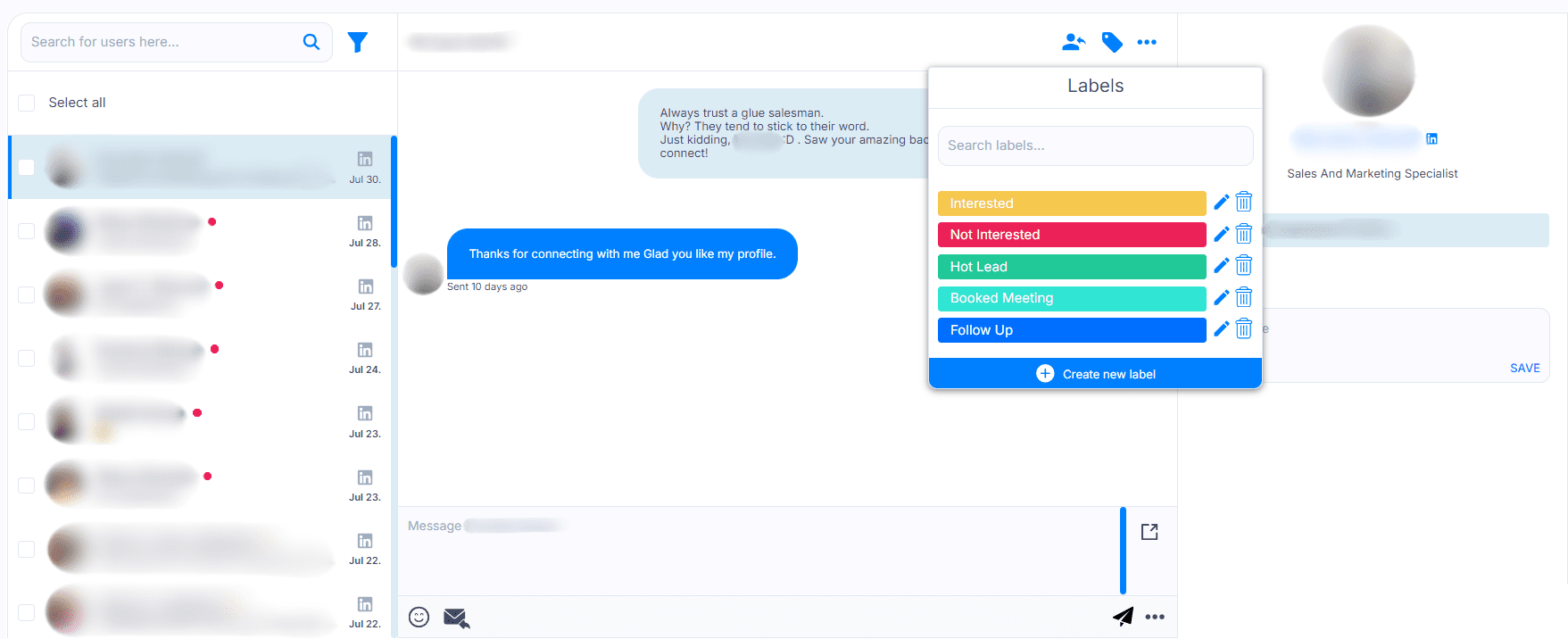
Targeted outreach message templates for sales & marketing
1. Targeted outreach message templates for sales
#1 Connection request
Results we got:
- Acceptance rate: 34%
- Response rate: 17%
Hi {{FirstName}},
I noticed your work in {{Industry}} and thought we could connect.
I'm researching how companies like {{LeadsCompanyName}} can achieve {{UniqueValueProposition}}.
Let's connect on this!
Example:
Hi Emily,
I noticed your work in the tech industry and thought we could connect.
I'm researching how companies like InnovateX can achieve scalable growth through data-driven marketing strategies.
Let's connect on this!
#2 Email
Response rate: 13%
Subject: {{YourProduct}} - Outperforming top {{IndustryRole}}...
Hi {{firstName}},
Can your current {{Solution}} {{UniqueValueProposition}}?
Clients like {{ClientExample}} are {{SpecificResultsAchieved}} with less than {{TimeSpent}} of work every {{TimePeriod}}.
Would love to share some examples if you're open to it.
Best regards,
{Signature}
Example:
Subject: Skylead - Outperforming top sales rep...
Hi Alex,
Can your current platform fully automate your process of LinkedIn outreach + find valid business + send emails + image personalization at scale (see screenshot example)?
Clients like TechMasters are reaching over 3,000 unique prospects across LinkedIn + email with less than 3 hours of work every single month.
Would love to share some examples if you're open to it.
Best regards,
Sarah Mitchell
2. Targeted outreach connection message and email when referencing someone’s post
#1 Connection request
Results we got:
- Acceptance rate: 76%
- Response rate: 35%
Hi {{FirstName}},
I saw your post about {{PainPoint}} and how it’s impacting your team at {{LeadsCompanyName}}.
I’ve been working on a solution that addresses this challenge by {{UniqueValueProposition}}.
Let’s connect and explore this!
Example:
Hi Jessica,
I saw your post about the difficulties with customer segmentation and how it’s impacting your team at TechWave Solutions.
I’ve been working on a solution that addresses this challenge by using AI-driven analytics to create more precise segments.
Let’s connect and explore this!
#2 Email
Response rate: 3%
Subject: Give your {{Field/Activity/Sector}}a boost with {{Product/ServiceName}}!
Hi {{FirstName}},
I recently saw your post about {{PainPoint}} and was impressed by your insights at {{LeadsCompanyName}}.
Given your focus on {{SpecificArea}}, I thought you might be interested in a new approach that has helped companies like {{ClientName}} achieve {{SpecificBenefit}}.
Our product/service, {{Product/ServiceName}}, is designed to {{BriefDescriptionOfBenefits}}, and I believe it could directly address {{PainPoint}}.
I'd love to schedule a brief call to show you how {{Product/ServiceName}} can help {{LeadsCompanyName}} achieve greater results.
Would you be available for a chat next week?
Looking forward to hearing from you.
Best regards,
{{Signature}}
Example:
Subject: Give your marketing a boost with EngagePro!
Hi Sarah,
I recently saw your post about the challenges of increasing customer retention and was impressed by your insights at BrightIdeas Co.
Given your focus on customer engagement, I thought you might be interested in a new approach that has helped companies like InnovateX achieve a 30% boost in retention rates.
Our product, EngagePro, is designed to deliver personalized content at scale, driving deeper connections with your audience, and I believe it could help solve the challenges of increasing customer retention you’re facing.
I'd love to schedule a brief call to show you how EngagePro can help BrightIdeas Co. achieve greater results.
Would you be available for a chat next week?
Looking forward to hearing from you.
Best regards,
Lisa Reynolds
Frequently asked questions (FAQs)
1. What specific data sources or tools can be used to identify the target audience?
Leverage platforms like LinkedIn and Sales Navigator or pull data from Google Analytics or your CRM to identify and pinpoint your target audience. The former have filters that allow for precise targeting, whereas the latter offers insights into information like audience demographics, behavior, and preferences.
2. How do you measure the success of a targeted outreach campaign?
To measure the success of your campaigns, you can track metrics like acceptance rates, open rates, response rates, conversion rates, lifetime value, and return on investment (ROI).
3. How do you balance personalization with scalability in targeted outreach campaigns?
To balance personalization with scalability, use automation tools that incorporate variables such as names, job titles, and company details into your messages. Also, opt for tools with dynamic images and GIF personalization that tailor visuals to each recipient. This enhances personalization, making outreach more engaging without increasing manual effort.
Making targeted outreach work for you
Targeted outreach can be a game changer for your business. After all, by focusing your efforts on the right audience, you maximize your chances of success while conserving valuable resources.
Armed with the actionable strategies and templates we provided, you’re now ready for the next phase: implementation!
So, outreach away with all facts in check and watch as your conversion rates soar, your brand recognition grows, and your ROI hits new heights.
But not before you’ve signed up for your 7-day free trial with Skylead—because impactful outreach starts with the right tool!
LinkedIn, as the main professional network, with 1 billion users, is the number 1 tool to help you find leads.
Using LinkedIn lead generation is great. However, there are other sources you can use and combine with LinkedIn to reach more high-quality leads. Extra targeting work always pays off.
We’ve done the work, researched, and analyzed creative ways to find these leads for your business besides our favorite targeting hacks on LinkedIn. This blog will show you lead generation sources that can be beneficial for your outreach efforts, match your ICP and Buyer Persona, and actually convert.
Let’s jump right in! 🏊
What is a lead?
A business or sales lead is a potential customer who is interested in your product or service. Salespeople use lead generation methods to find leads from multiple sources. Then, they reach out and follow up with each one continuously to warm up the lead and convert them.
Leads vs. prospects
A prospect is a qualified lead. For a lead to become qualified, they have to match your ICP, and you need to interact with them. Once they show interest in your product/service, they become qualified and can continue their journey through the sales process.
How to define and find leads
If your goal is to find leads of high quality, cold outreach can be a powerful tool for building solid relationships. If done right, it could help you close more deals. This could depend on multiple factors, ranging from a catchy email subject line and a powerful call to action to creating a strong follow-up email after no response campaign flow.
However, before you get into outreach, your first job is to define your target audience. Here are the 3 main things to consider. 👇
1. Build your inbound strategy
To maximize results, you should consider investing time and effort into building your inbound strategy as well, as inbound and outbound work well together.
Make sure to build your website and fill it with educational content, such as blogs, downloadable templates, lead generation forms, case studies, and documents. Your support team should always be available, and the support chat icon should be visible on the homepage.
2. Define your ICP and Buyer Persona
Both the Ideal Customer Profile and Buyer Persona are your essential documents for defining the type of company or person you’ll target with your outreach. Before you go out to find leads, you should define both.
Just a reminder, the Ideal Customer Profile describes the company that would benefit the most from your product or service. These companies should have the fastest conversion cycle, highest LTV, and highest customer retention and be willing to refer your product or service to others.
On the other hand, a Buyer Persona describes your perfect decision-maker. In other words, a Buyer Persona is a collection of an individual’s personal data such as age, location, likes, dislikes, goals, wishes, challenges, and motivations.

Ideally, both Buyer Persona and ICP should be based on existing customers and data, as it will help you create these documents more precisely.
3. Create your sales leads personalization document
Social selling is about building relationships and helping your sales leads reach their goals with your product or service. But before you can dive into relationship-building, you should gather personal info about your leads.
To personalize your outreach at scale, you would need to do extensive research on what they do and the content they publish or get more personal by finding their hobby. Start by creating an Excel file with columns like:
- First name
- Last name
- LinkedIn profile URL
- Company
Then, continue by inserting information, such as:
- The topic of the content they published
- What stood out for you the most from the particular post
- School they went to
- Field of study
- Jobs they posted
- Company growth information
- Personalized message intro (the message you can create based on the above-mentioned)
In other words, create a column for everything you can find while researching. This document contains actionable data for your outreach. So, read on to see how you can use and benefit from it.
Pro tip: Before you start your outreach be sure you have your LinkedIn prepared to sell for you.
Why you need to update your lead generation strategies
LinkedIn is still our #1 platform for generating leads, right? However, by using different strategies and sources to find leads apart from LinkedIn, you will gain even deeper insights into your potential ICP or Buyer Persona. This will ultimately help you maximize your sales efforts and results.
Below, we will review a list of 30 ways to find leads online and how to use them. We’ll show you how to automate outreach, save 11 hours per week on manual work, and focus on closing deals. Sounds good? Keep reading! 🤓
30 ways to find leads
1. Find leads on company websites
To find leads on company websites, you identify target companies and visit their official websites. Then, you explore the “About us” and “Team” pages to find the decision-makers. While you’re at it, you should also check the “Contact us” page for general contact info.

Once you click, you’ll usually get to names and titles, sometimes, even with LinkedIn icons, do you don’t have to look for them manually.
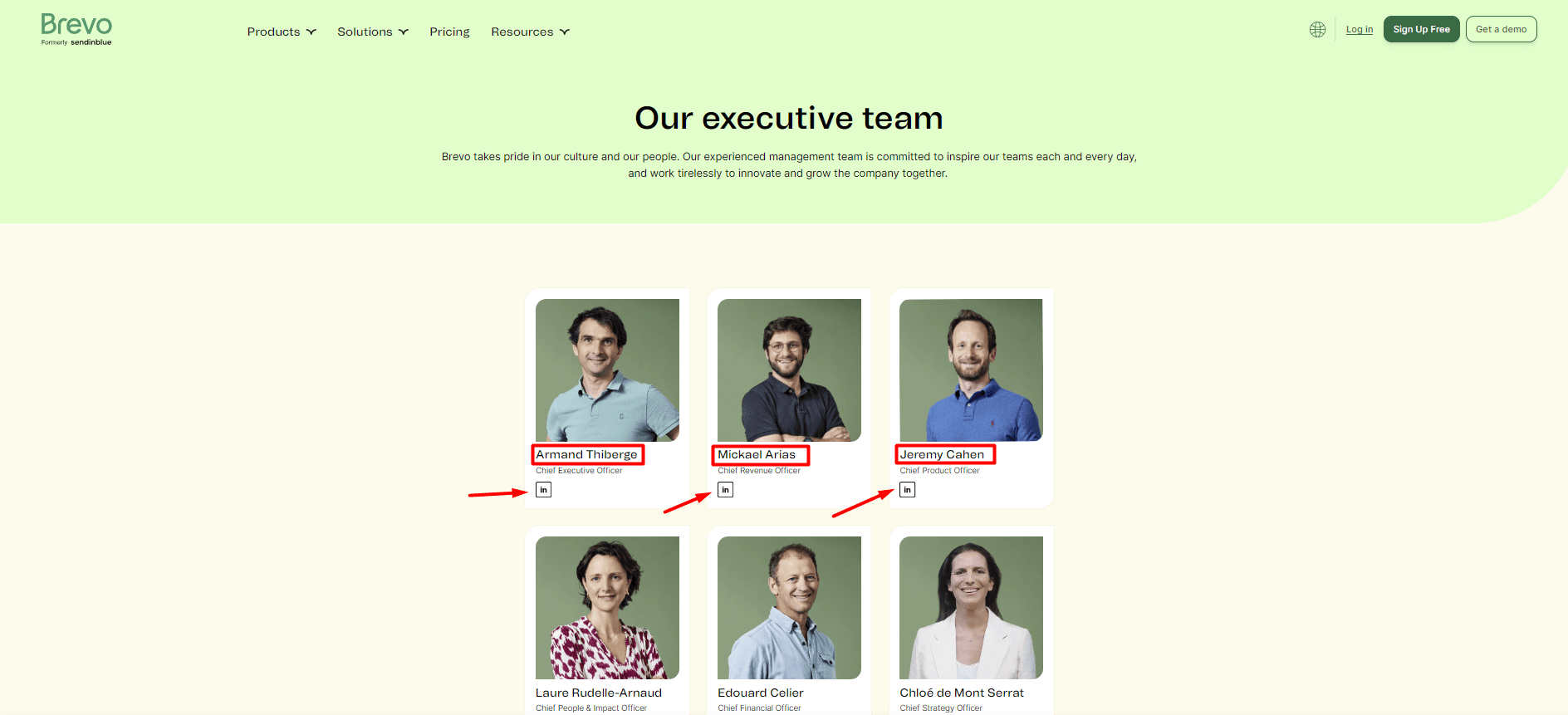
After getting leads on these pages and finding them on LinkedIn, you can send connection requests for a more natural and personalized outreach.

You can also use operators like “site.com email” to find employee email addresses. Or, even better, use an automation tool to Find & verify business emails. Lastly, you can use content to engage and comment on blog posts to get noticed by content creators, start conversations, and get recommended to their colleagues, who are your target audience.
2. Find leads on live events
To find leads at live networking events, you should find relevant events first: industry conferences, trade shows, and meetups. Our advice is to register early to ensure your spot. Also, make sure to review the attendee list if it’s available. Before the event:
- Do the prep work
- Research key participants and companies
- Plan your approach to engage with attendees
In case of a live event, you can go as an attendee, or you can have your own booth. As an attendee or guest, you should attend sessions and participate in all discussions to connect with other attendees. The main goal is to learn about industry news, meet new people, and build relationships with potential leads.
If you have your own booth, you will have a chance to talk to interested parties, distribute marketing materials, and start meaningful conversations. You can also exchange digital cards or connect on LinkedIn immediately.
After the conference, in both cases, you should follow up with new contacts shortly after to keep the conversation going and nurture newly built relationships.
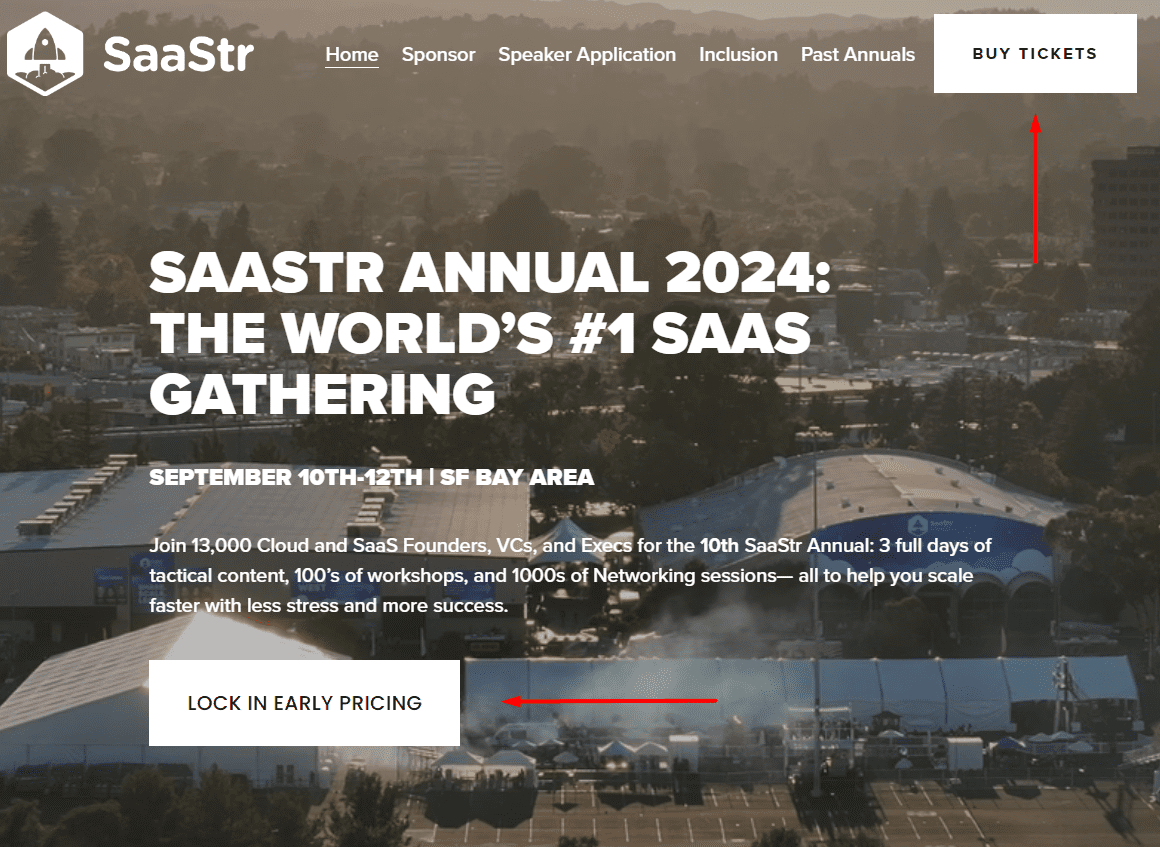
3. Find leads on digital events
With digital networking events, such as webinars, LinkedIn events, and online meetups, the rules are a bit different. Come prepared, research everything about the event and the attendees, and plan your approach.
You should join Q&A sessions, breakout rooms, and chats to connect with attendees. After the event, be sure to reach out on LinkedIn or email and mention your interaction or a specific topic from the event. By keeping the conversation going, you’ll easily generate and nurture B2B leads.
4. Find leads via referrals
You can find leads with a little help from your existing customers. Reach out to satisfied clients, colleagues, and industry contacts for referrals.
To get the most out of your referrals, our advice is to create strong incentives or a reward-based referral program. This will encourage referrers and keep leads coming in. You should also always keep in touch with your network through LinkedIn chat or email.
When you do get the leads from referrals, our advice is to always make sure to follow up and show appreciation to both the referrer and the new contact they brought in.
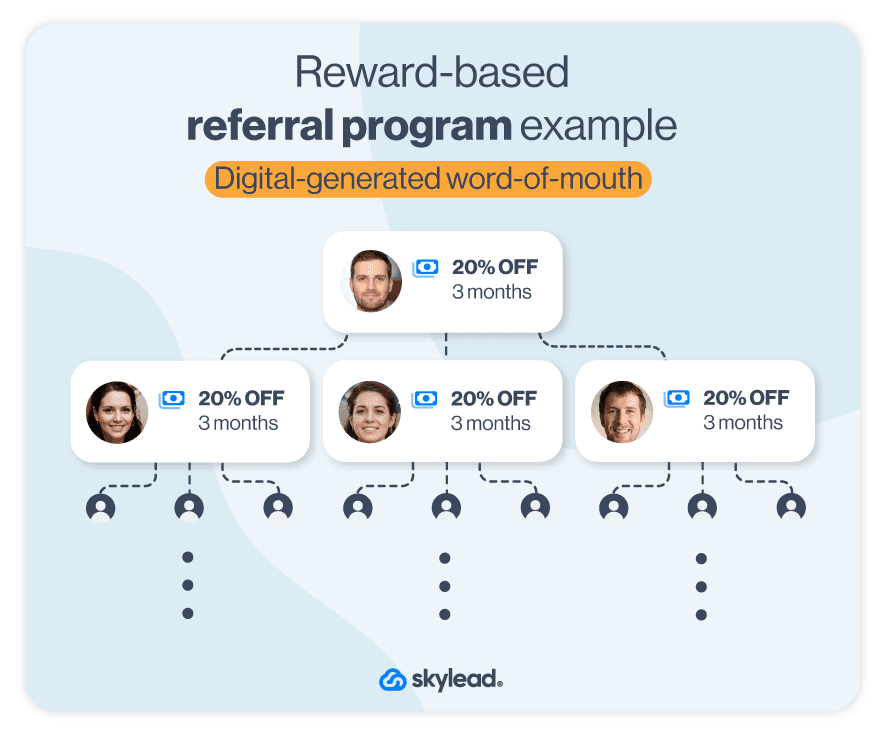
5. Find leads via industry associations
Another way to find leads is to join industry associations and actively participate in their activities. Attend association meetings, conferences, and events to network with other members on LinkedIn or via email.
The trick is to pick associations relevant to your business that have active memberships and ongoing events. For example, if cloud-based companies are your ICP, you could join the Cloud Software Association.
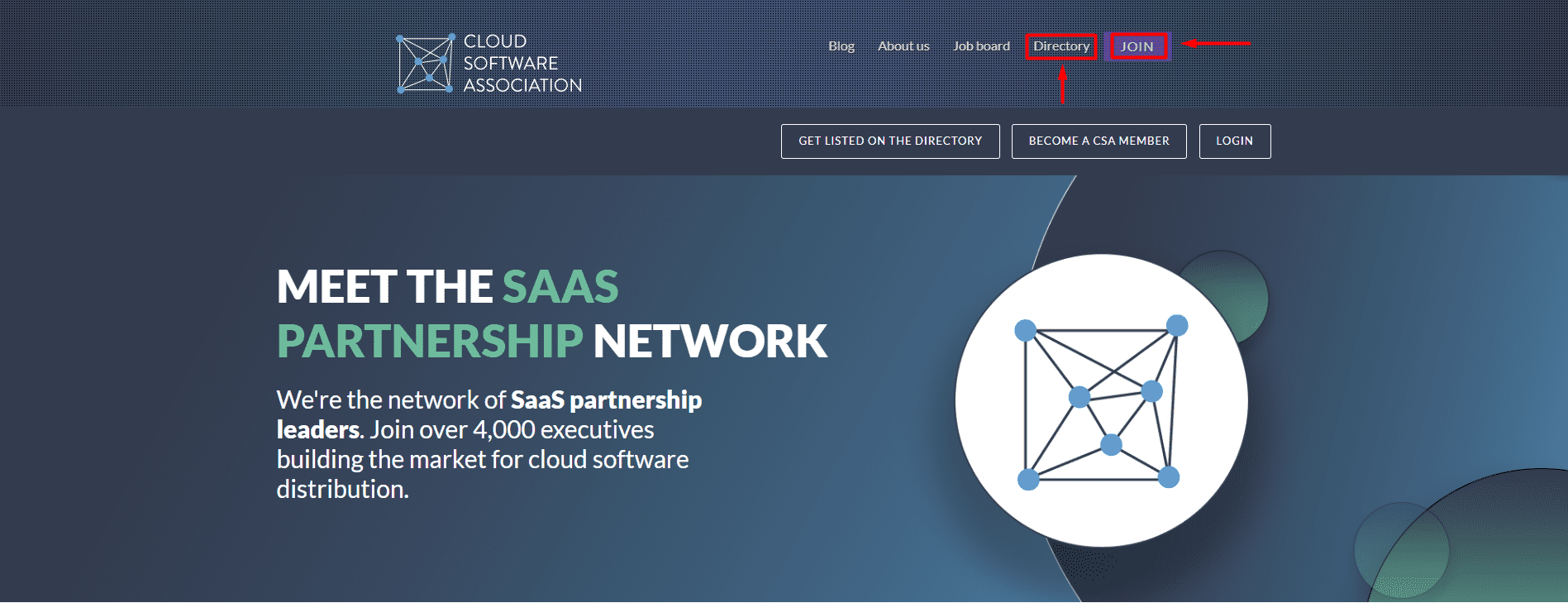
After that, go to their directory and search for businesses of interest. You can use numerous filters to narrow down your search.
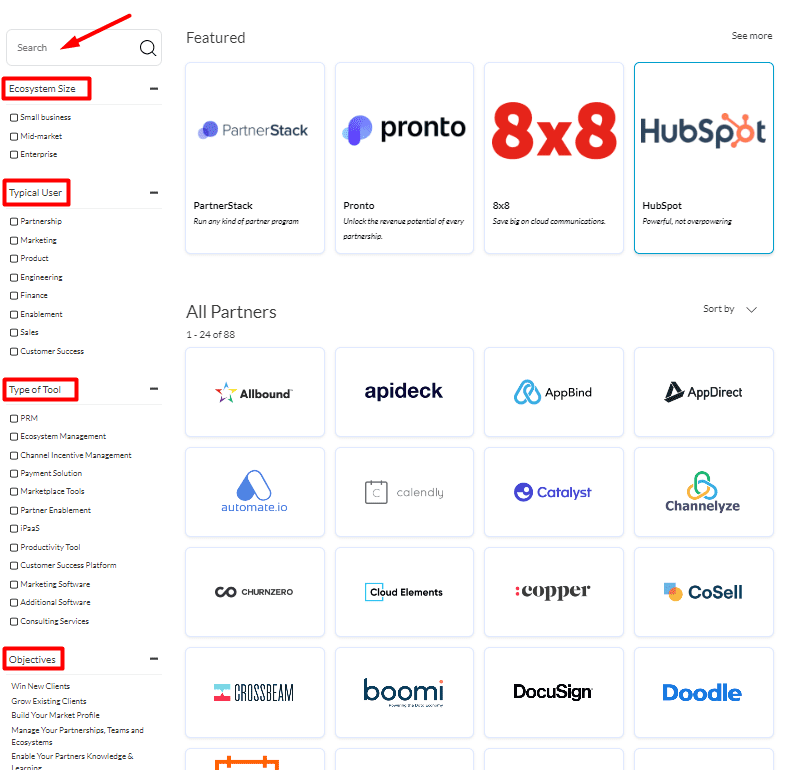
After that, you know the drill. Go to LinkedIn, find the company of choice, go to their people section, find decision-makers, and outreach away!
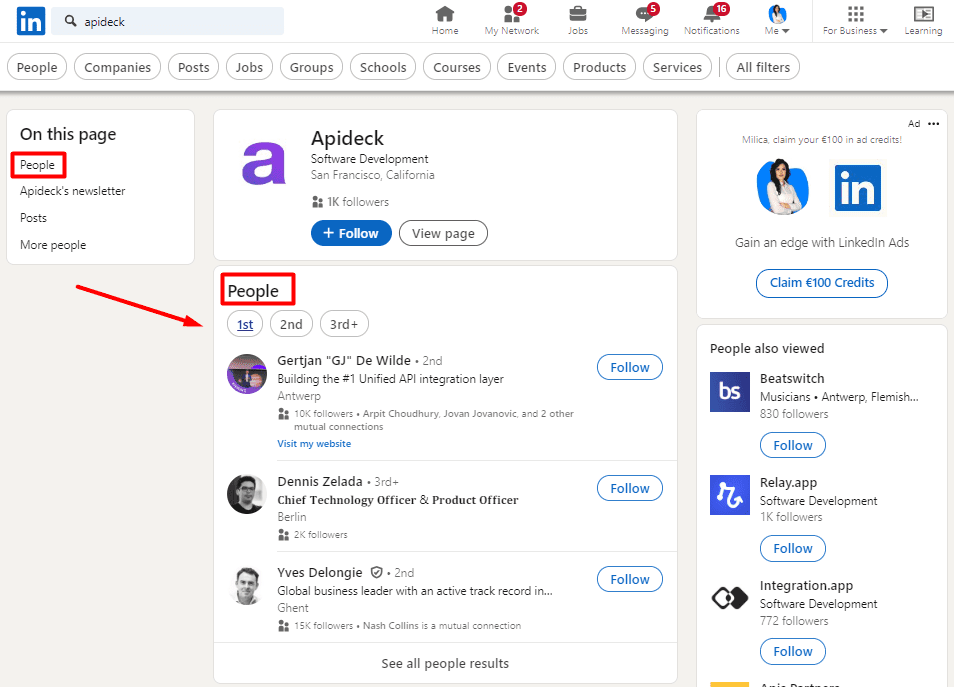
6. Find leads on X
Finding leads on X can be a real game-changer! For example, you can search for your competitors and find negative Tweets or comments. Then try finding them on LinkedIn (if they have their full name and a legit picture) and add them to your CSV file for future outreach. Don’t forget to personalize your outreach and reference how you’ve found them.
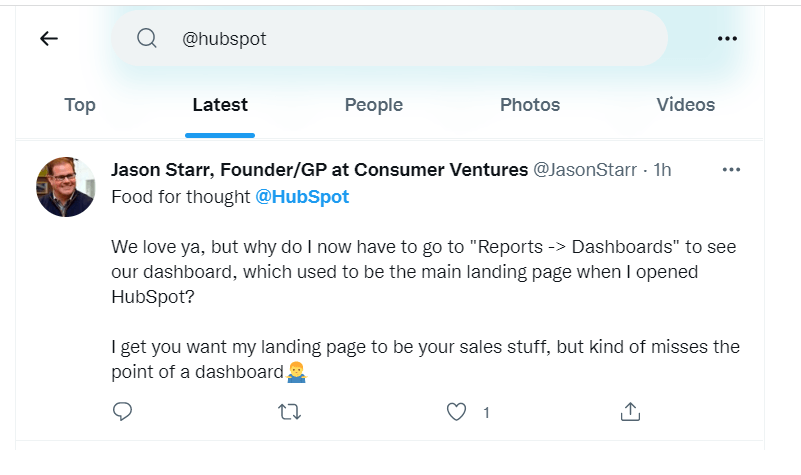
7. Find leads in Facebook groups
Facebook is a perfect place to find your Buyer Persona. However, you just need to dig a little deeper to find them, and join a couple of groups here and there.
The first thing you need to do is to research and find the Facebook groups your sales leads follow. Then, join these groups and wait for approval. From there, you can find your sales leads by the posts they have published. The only thing you need to do is search the group by the keyword.
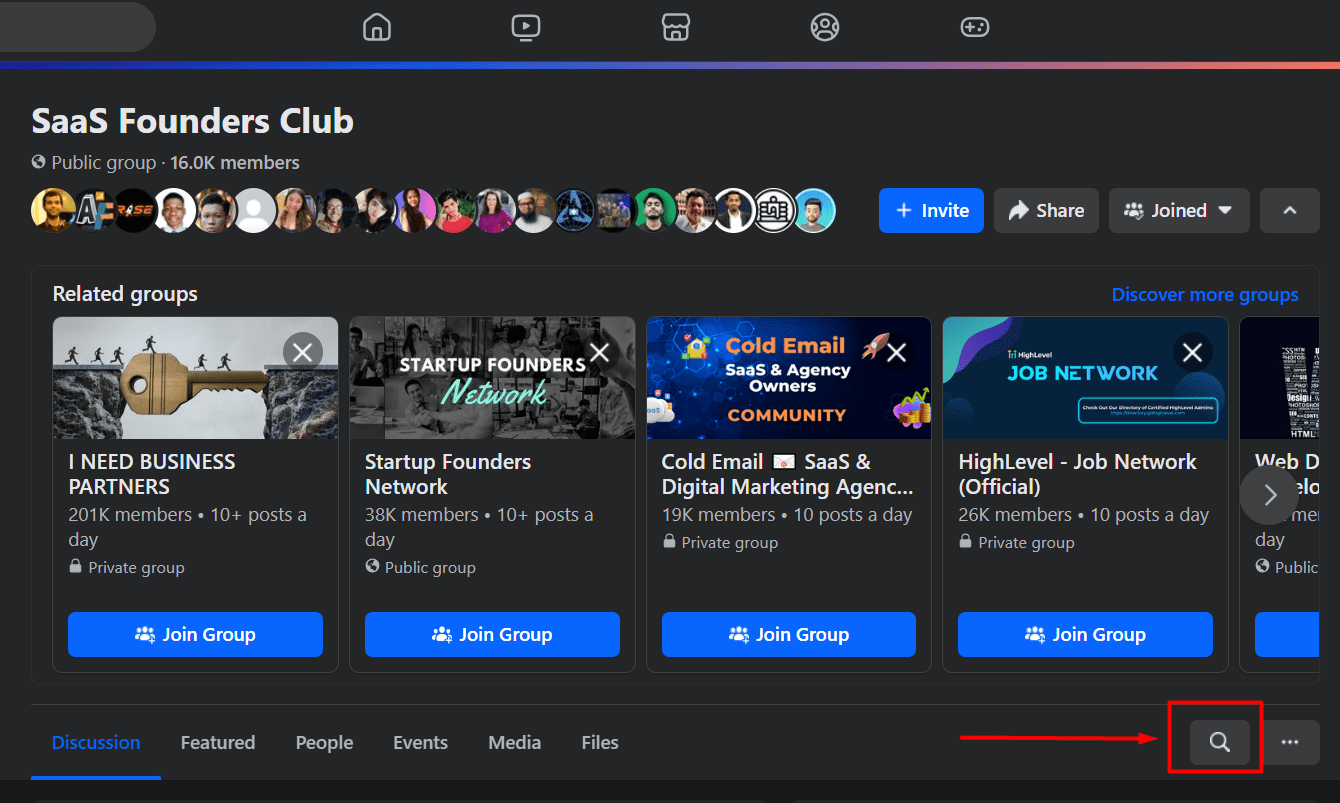
You then search sales leads by, for example, the exact pain point they experience or the goal they want to achieve. This is where you find potential interested parties for your product/service.
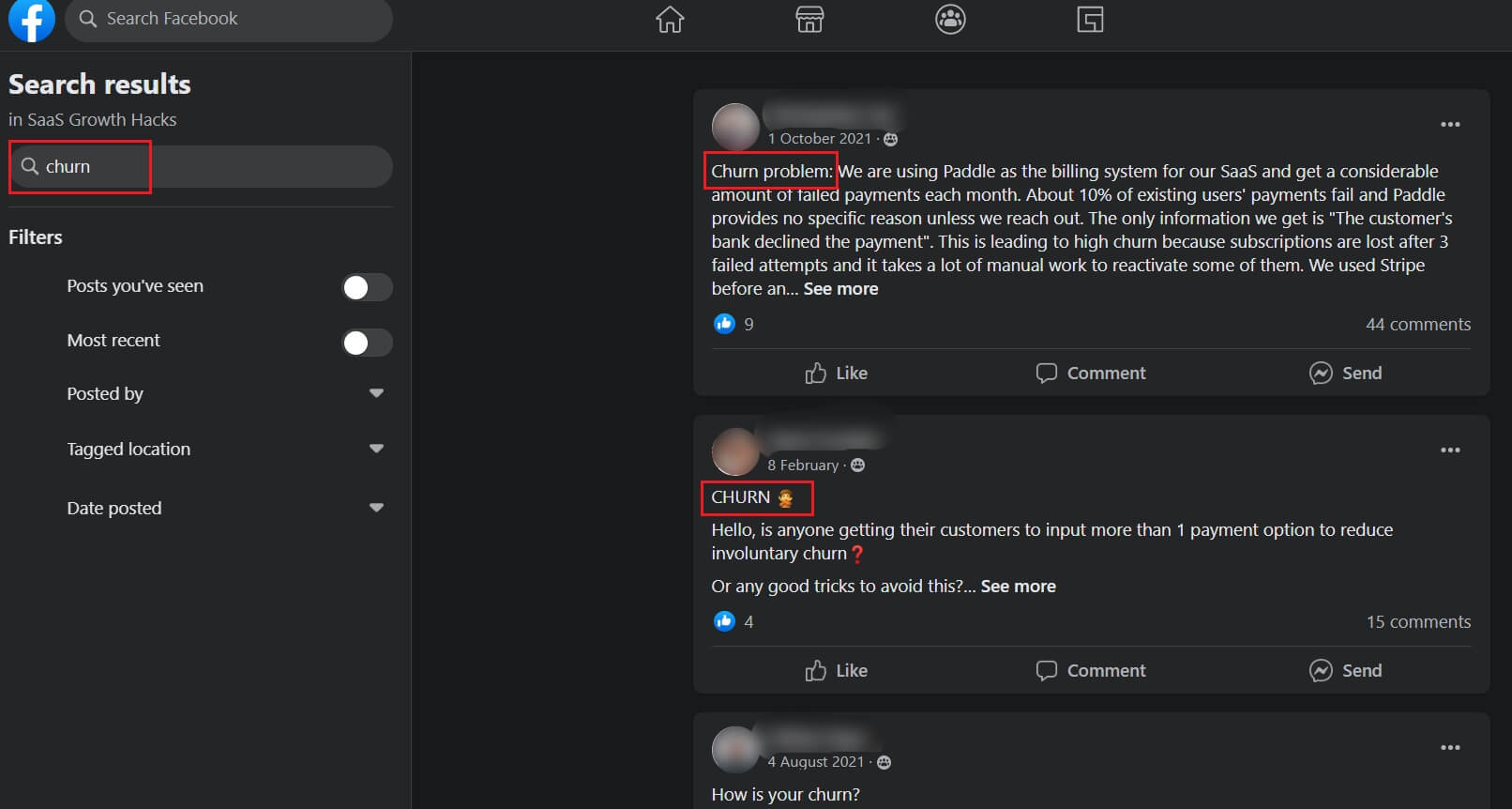
You can message the people who posted directly on Facebook or, better yet, connect with them on LinkedIn and begin your outreach campaign.
8. Find leads on Instagram
Instagram is all about good visuals, hundreds of followers, but also finding leads. Yes, we’re not kidding. Go to the profiles of companies that are your competitors or have similar ICP and Buyer Persona, go to the followers section, and scroll down to find leads.
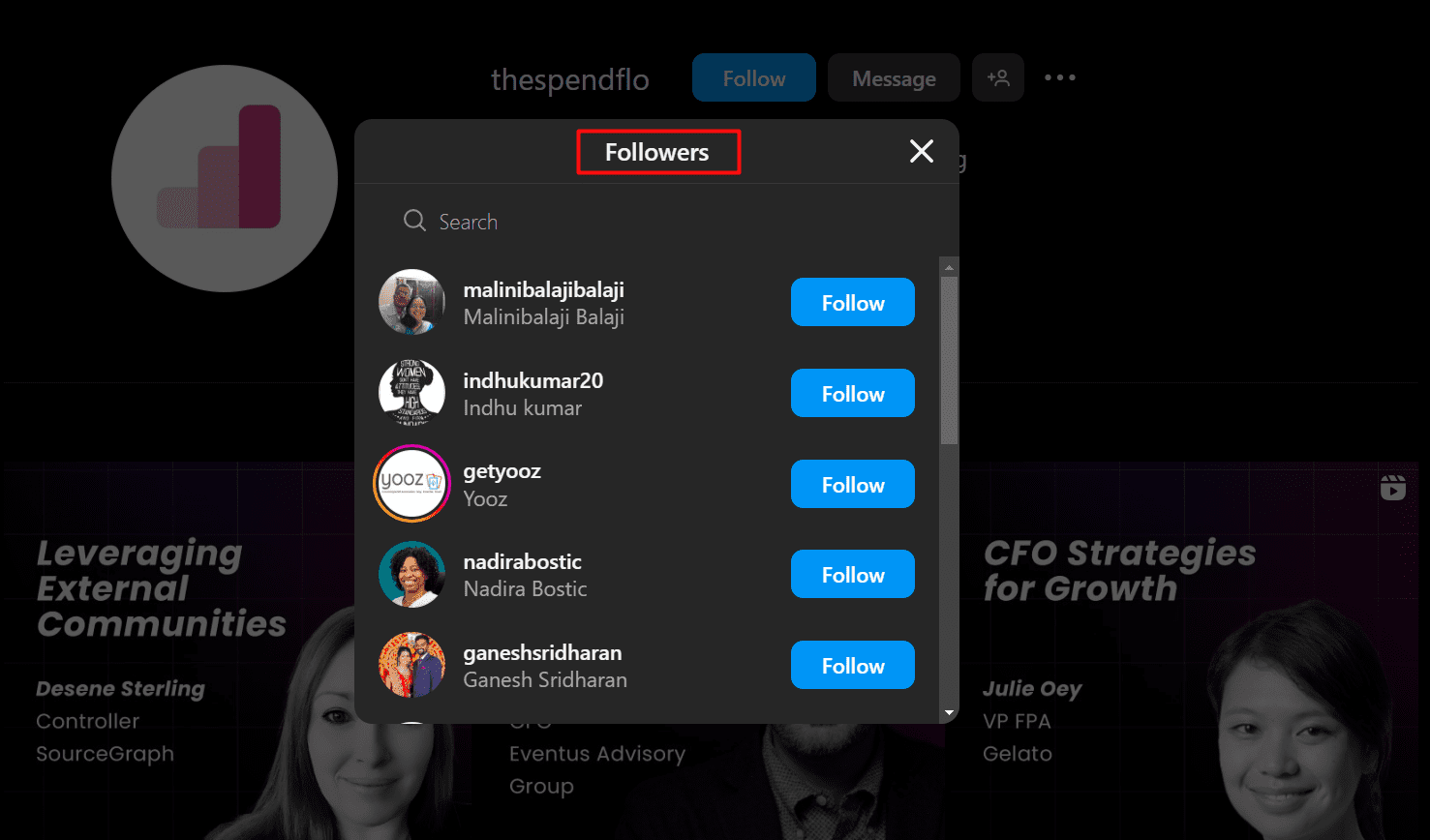
Once you get to them, we’re using our favorite lead gen ally - LinkedIn 👇
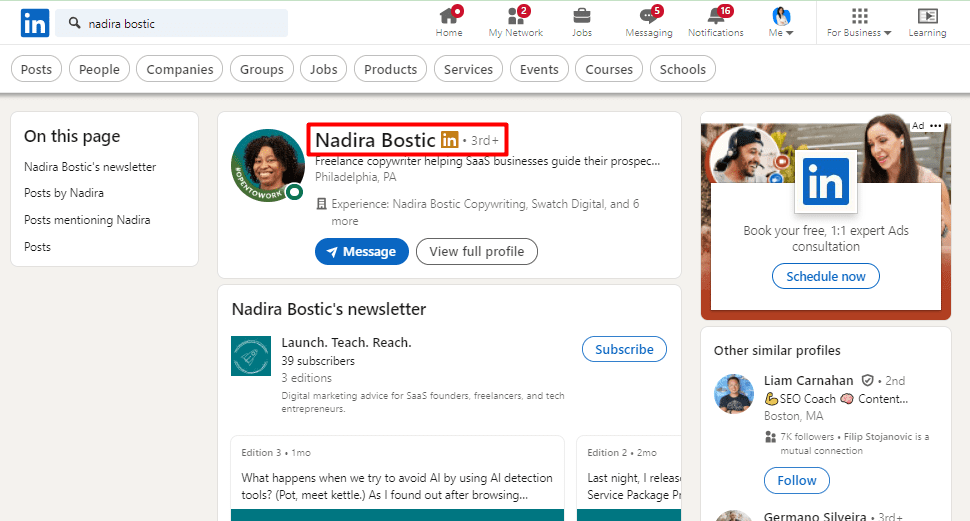
9. Find leads on Reddit (Specific Subreddits)
If done right, finding leads on Reddit can be incredibly effective. Here’s what you’ll need to do:
- Find relevant subreddits
- Actively participate in discussions
- Find content that discusses problems you’re solving and mention your product without sounding too salesy (use the Search comments option for keywords)
- DM those people and ask to connect on LinkedIn
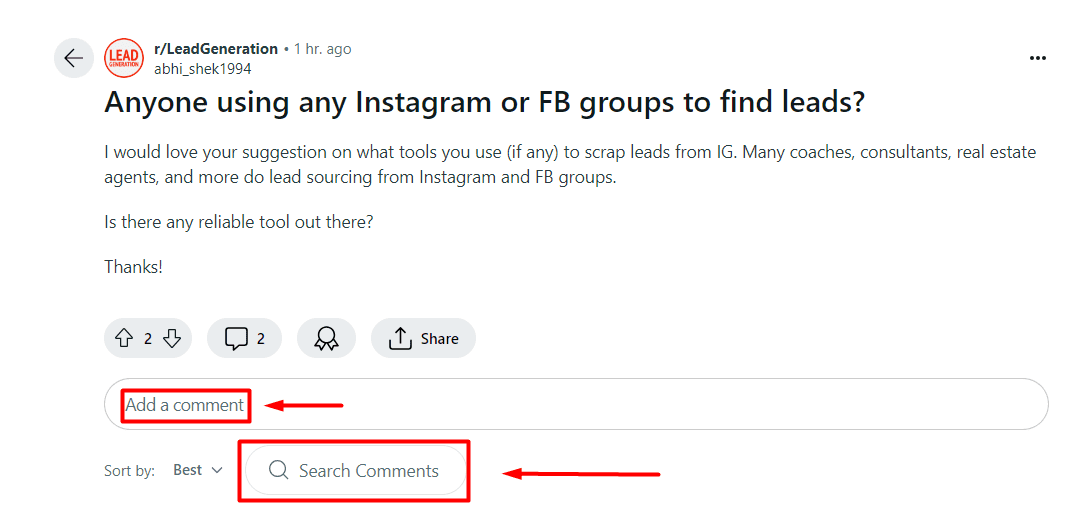
From what we’ve learned from our own experience, people will see your comment as useful and reach out to you themselves, asking for more information. This is usually a sign that you’re providing value where value is needed, so keep up the good work!
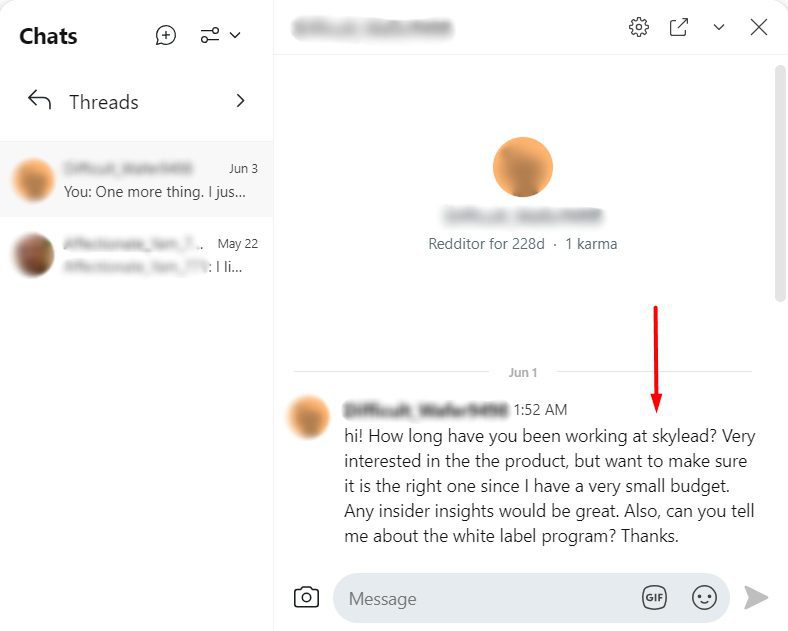
10. Find leads with gated content
You might know this already, but using gated content with lead capture forms is a smart way to get leads. The marketing team creates:
- E-books
- Whitepapers
- Exclusive webinars
- Downloadable templates
Then, they send the list of leads to the sales team, who creates outreach campaigns. In fact, this is how we did it: We’ve offered a sales book that helped us grow our business from 2,500 to 10,000 users in just 9 months. In exchange, people leave contact information through a simple sign-up form on our website. We’ve also promoted our gated content through blog posts, social media, and email campaigns to drive more traffic and capture more leads.
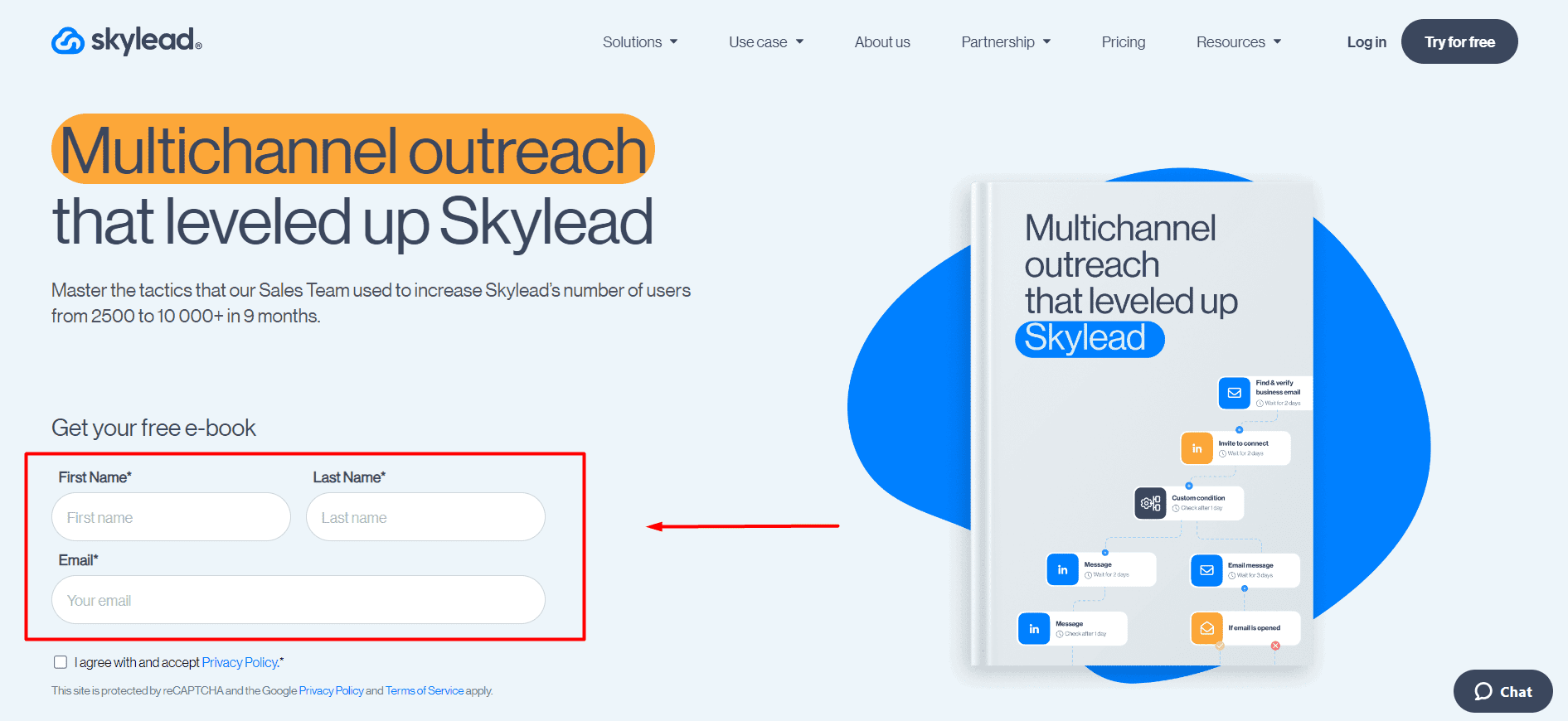
Here are our tips on how to attract leads with quality gated content:
- Strong CTAs: Use clear and enticing calls to action to encourage users to access your gated content.
- Tailor your content: Tailor your gated content to specific segments of your audience to increase relevance and engagement.
- Follow up quickly: Send a follow-up email immediately after someone downloads your content to nurture the lead.
- Use analytics: Track the performance of your gated content to understand what resonates best with your audience.
- A/B test: Test different formats, headlines, and designs to optimize your landing pages and sign-up forms.
- Offer multi-step content: Create a series of gated content pieces that build on each other to nurture leads to conversion over time.
- Integrate with CRM: Make sure your sign-up forms are integrated with your CRM to streamline lead generation.
11. Find leads on review websites
Review websites can be very useful for finding leads. Here are a few review website examples:
Just go to the review website of choice, find your competitor, and then search for people who posted negative reviews. For example, here’s a person who is not satisfied with calendar software. Find them on LinkedIn and put them in your CSV file so you can include them in your automated outreach campaign.
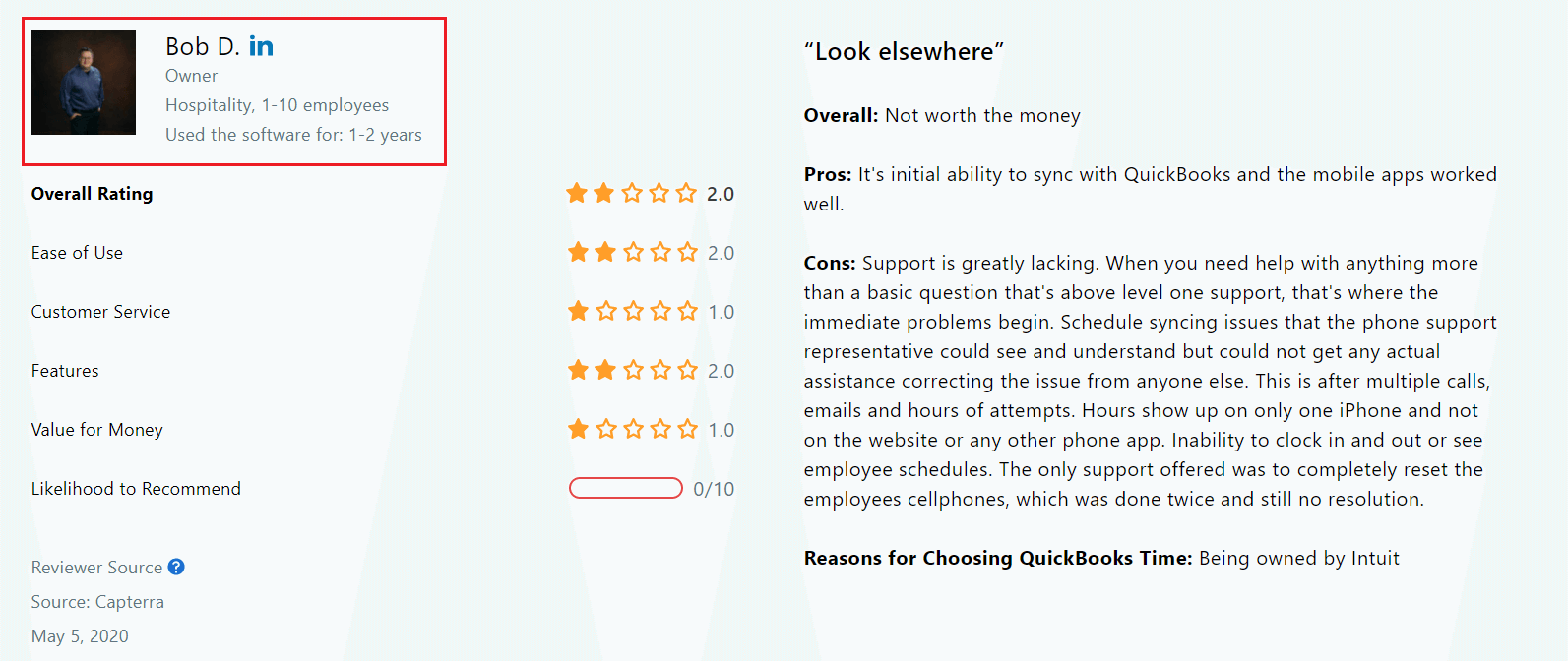
12. Find leads using a LinkedIn X-Ray Search
LinkedIn X-ray search, a.k.a. Boolean search, is a method that allows us to research our leads on Google without using LinkedIn’s internal filters. But why would you do that if you have LinkedIn? Well:
- You’ll get more search results
- You’ll get to see 3rd-degree and out-of-network connections, too
- More relevant search results, thanks to Google’s different algorithms
- A more comprehensive search (thanks to the * symbol (Asterisk) that includes missing words in your search results.
Now, to find leads using LinkedIn's X-ray search, use Google with specific search operators. Enter "site.com" followed by relevant keywords, such as job titles or industries (e.g., "site
.com marketing manager"). This narrows down the LinkedIn profiles that match your criteria. Refine your search by adding location or company filters to target specific leads effectively.

After you’ve pinpointed your leads, you go to LinkedIn and copy-paste their info to your CSV file for future outreach.
13. Find leads in CRM databases
Up until now, we’ve been talking about finding leads elsewhere, but you should not forget to look for leads among your own clients. Or rather, the ones that ended up in the churn box. Go to your CRM database and find the email addresses of clients who went in another direction, so to speak.
Think about why they might have left and use a new feature or update to start the conversation again or rather a check-in message. Since you’ve already had a relationship with them, restarting the conversation should be easier than with cold leads.
Our advice is to review your earlier conversations and create a separate automated outreach campaign tailored for these old/new leads.

14. Find leads via partnerships and alliances
It’s time to partner up! Start by identifying potential partners whose services complement yours or similar businesses that are not your competition. Reach out to these companies to find out about mutual benefits and opportunities for collaboration. Partnering up can open doors to new networks, which will increase your lead pool.
Here’s an example. Our partner included this image in their newsletter when we launched Product Hunt. It was a perfect opportunity to show us off to their user base and inform them about our special event.
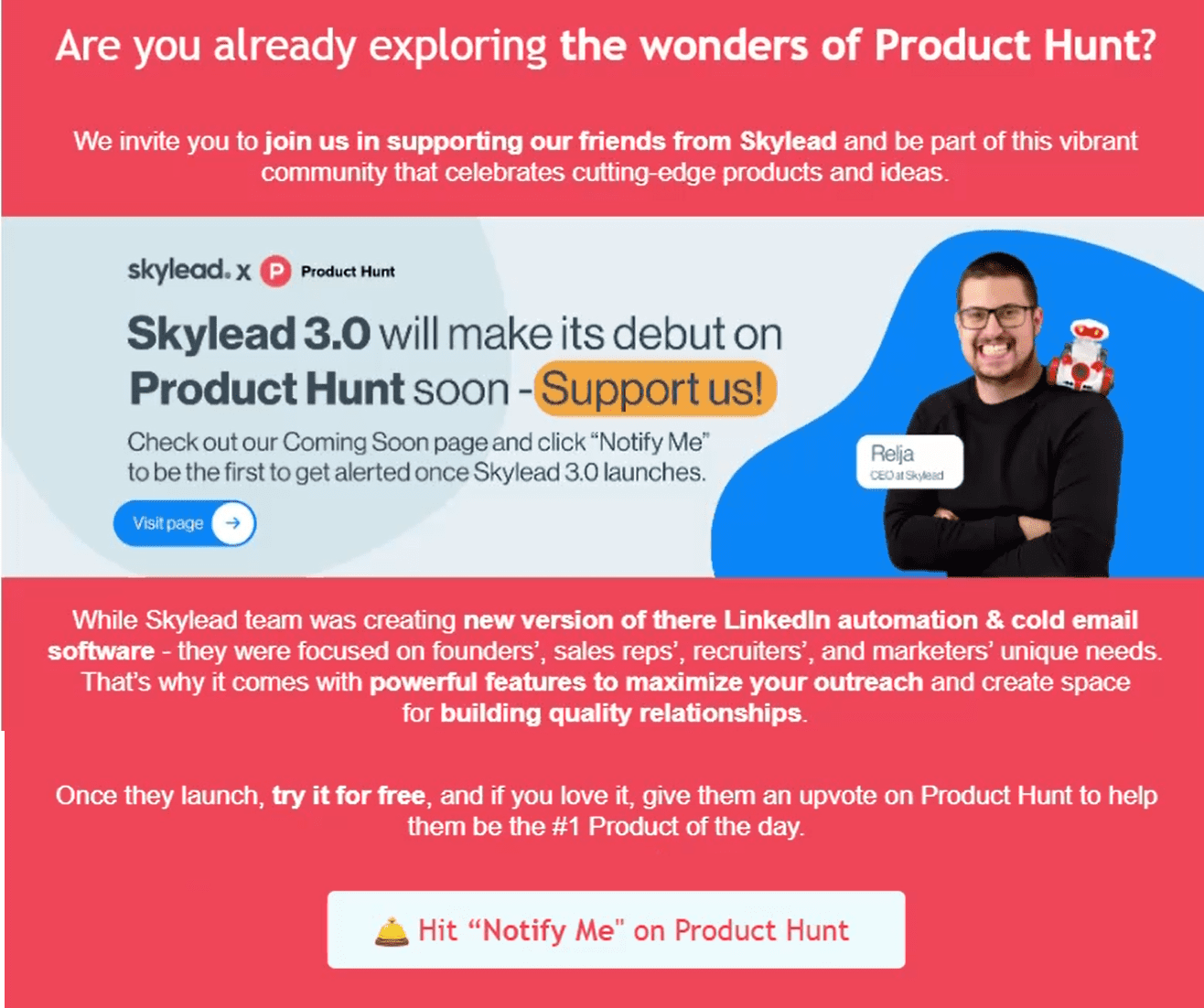
This also works for sharing gated content and referrals through mutual B2B marketing strategies.
15. Find leads via job listings
When a company is hiring, it usually means one of these 3 things:
- They have a bigger budget for the department
- Something is not right in the current process
- Or a person from the team is leaving for a certain reason.
Job postings mean a department change, and you should seize that opportunity. This is where recruiters usually spill the beans, so keep an eye on the department and industry of interest.
For example, let’s say you are selling team management software for remote teams. You can go to any job search website like Indeed and filter the jobs by industry, job type, and remote work.
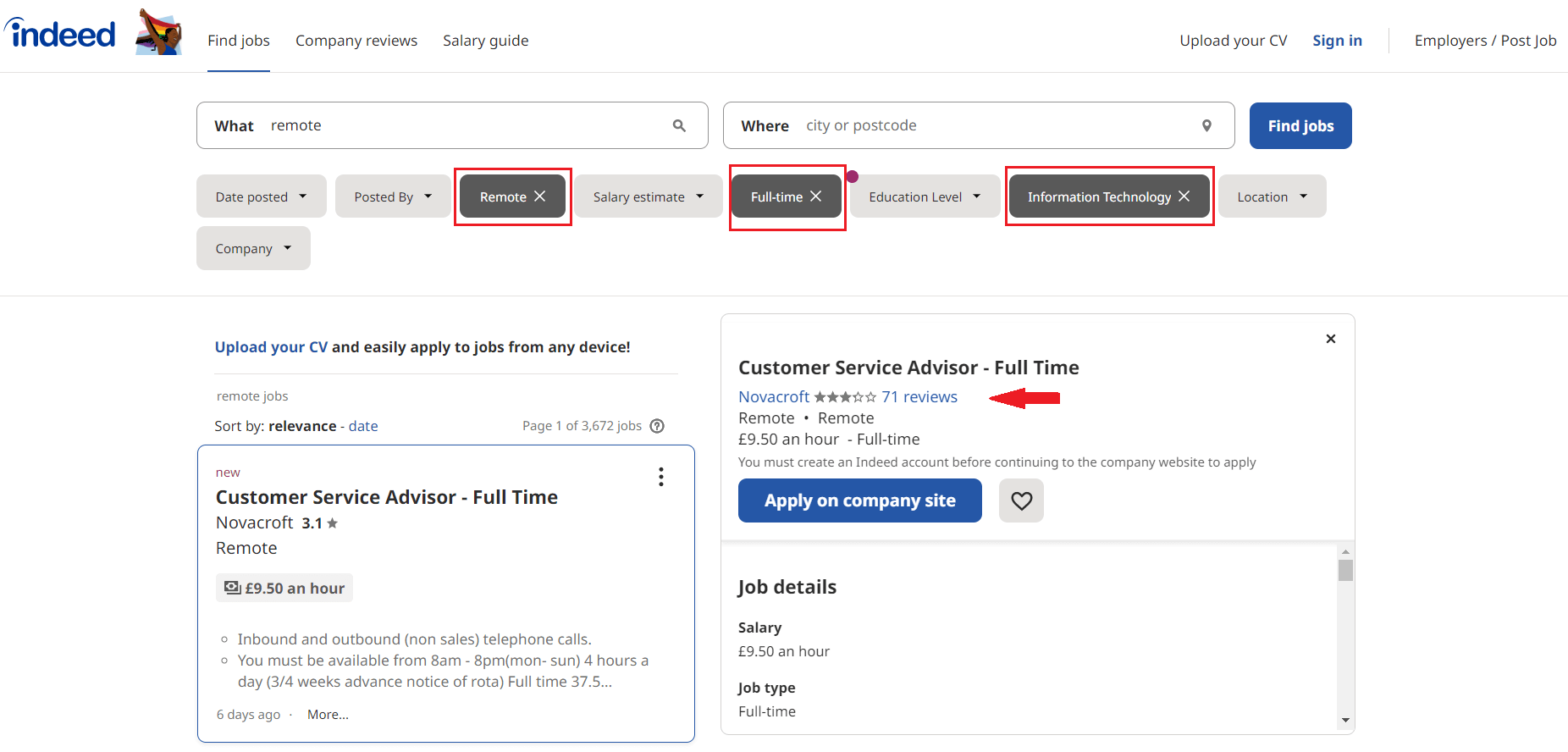
This is a great place to find your ICP and go from there. In addition, if you have a LinkedIn Premium account, you can check out the company’s growth insight on LinkedIn and move on to find your decision-maker.
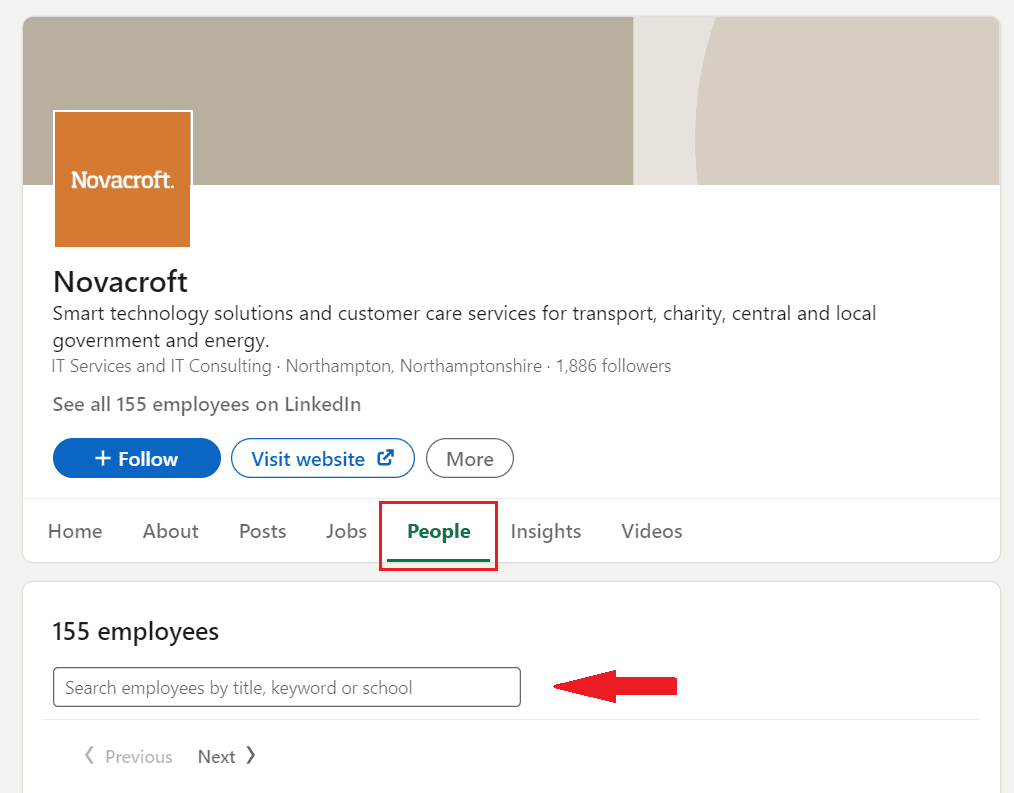
You can do this process on LinkedIn, as well. However, keep in mind that if your ICP is a small company, you might not be able to see their job posts unless you are their 1st-degree connection or they promote these posts on LinkedIn.
16. Find leads using LinkedIn topics
Another place to look for leads on LinkedIn is LinkedIn topics. You get to go through industry related questions, discover key contributors and find your Buyer Persona. You can also filter topics by industry and narrow down your lead search.
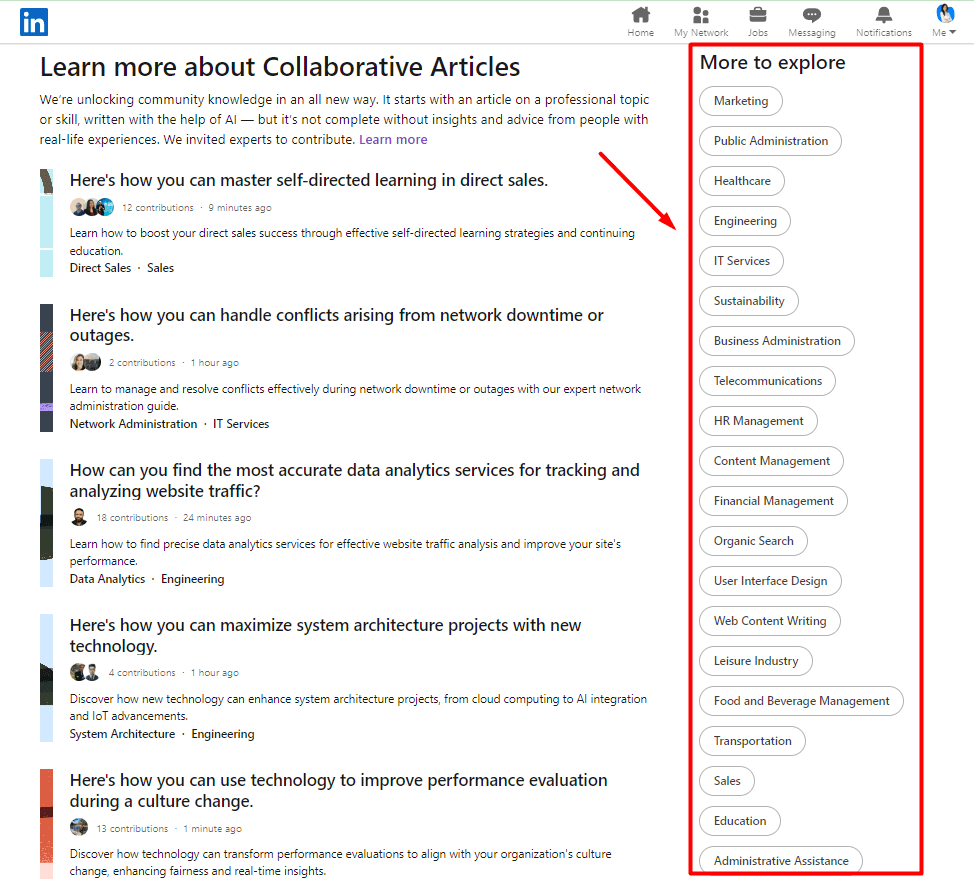
Once you click on a topic, you’ll see different sections and related subtopics you can access. You can go through the contributors listed on the right. Then, you can find the ones you’ll reach out to easily since you’re already on LinkedIn. Our advice is to reference their contribution to a certain topic as an opener. It’s that easy.
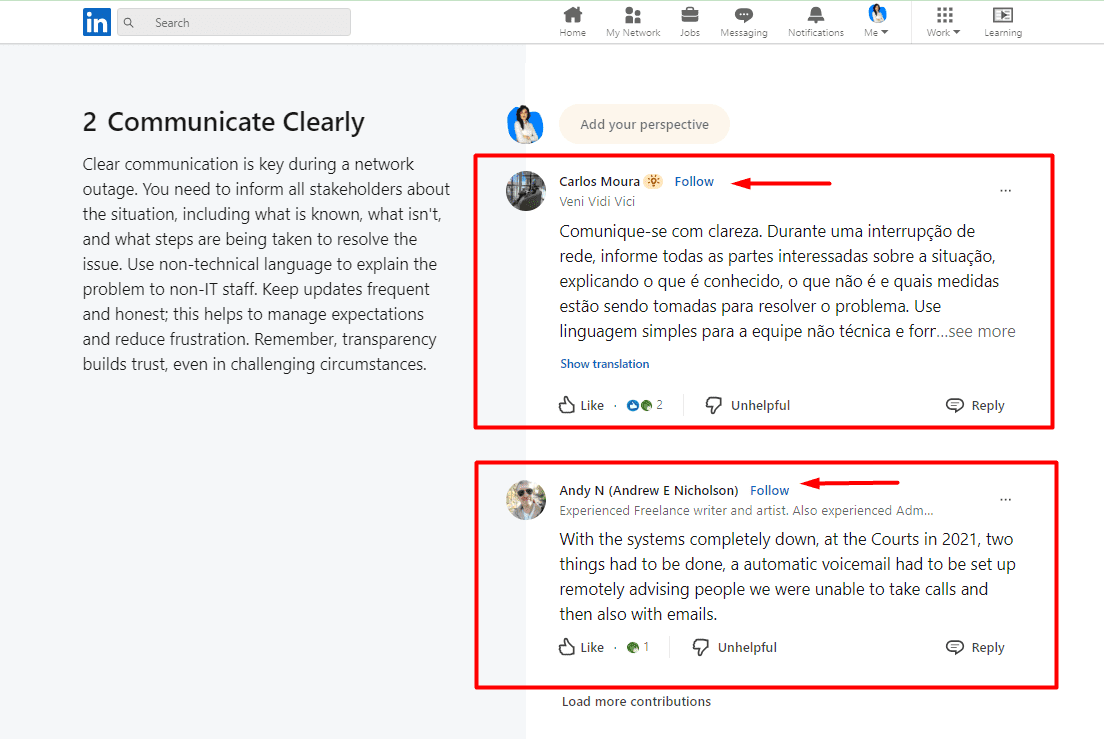
17. Find leads through recently funded companies
Another great way to find your ICP is to research what companies recently got funded. Since we know they’ve got money to invest, make sure their priority is growth.
So, to find these companies, you can choose one of two ways. First, you can use company data websites, such as Fundz, TechCrunch, or Crunchbase. Crunchbase makes it easier to find information as you can filter the companies using the free Funding Rounds feature.

Secondly, you can Google search for companies using Boolean search operators.
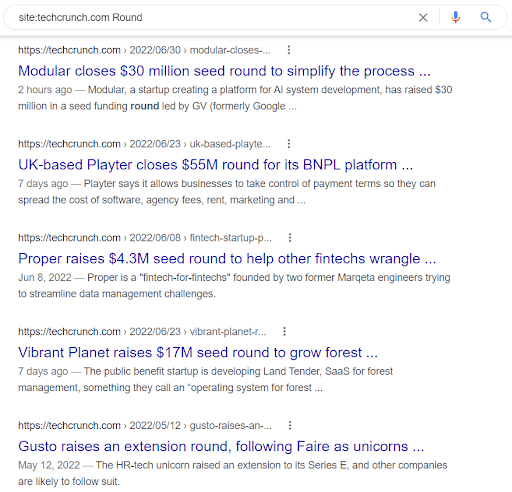
Whatever approach you pick, making the connection with the person from the company that just got the funding and building the relationship can result in a long-lasting partnership.
18. Find leads through Slack communities
Slack channels offer many possibilities, from finding leads to learning something new. The best part is that you can contact each member privately via chat.
There are different communities all over Slack, and you can explore and find the ones your Buyer persona joined. For example, a B2B content director must be following the content trends, so you will most likely find them in the Superpath Slack community under the content-b2b channel.
What’s best is that Slack channels like RevGenius or The Trenches are very educational, supportive, and welcoming. So, apart from finding sales leads and reaching out to people who face a problem your product can resolve, you can enjoy your stay and learn about the changes in the market.

19. Find leads through YouTube comments
To find leads in YouTube comments, all you need to do is find the videos your sales leads might be watching and look in the comment section. Our advice is to find someone with a legit profile, meaning with their full name and picture. You can use this information to find these individuals on LinkedIn.
Let’s say your sales leads are SaaS founders. Consequently, you would find a video related to SaaS, such as this one. 👇
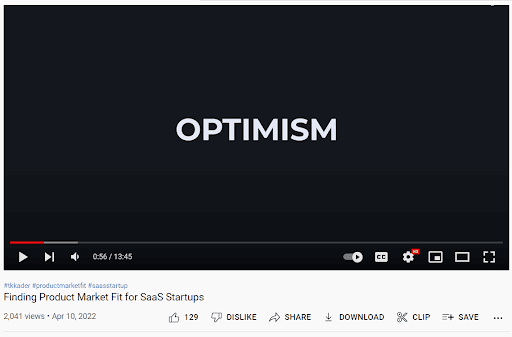
Now, scroll down to find a comment such as this one:

Now go to LinkedIn and search for the person. You can contact them there directly or save their profile in a CSV file with remarks for a perfect conversation starter.
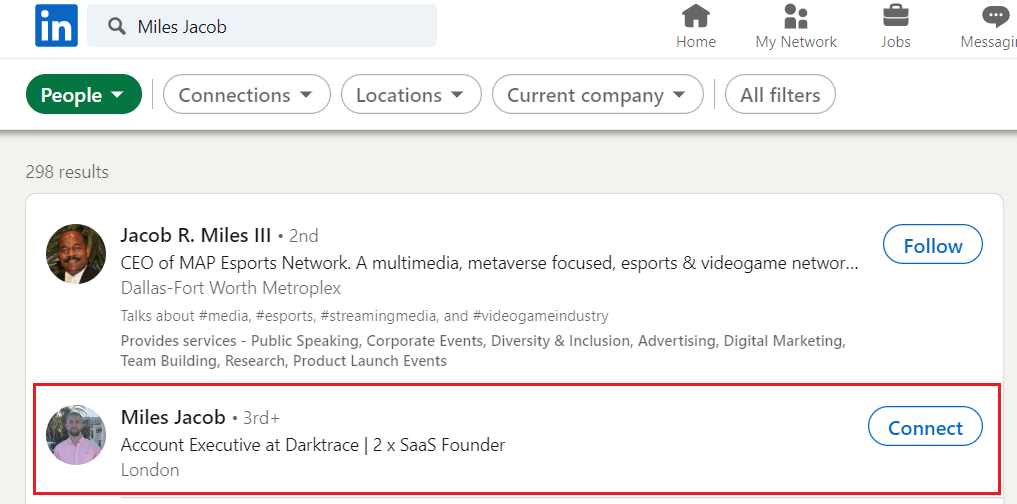
20. Find leads via LinkedIn events
Using LinkedIn events for lead generation is a great strategy for connecting with potential leads and clients. Go to LinkedIn’s search bar, type in a keyword of choice, and select “Events” as your main category.
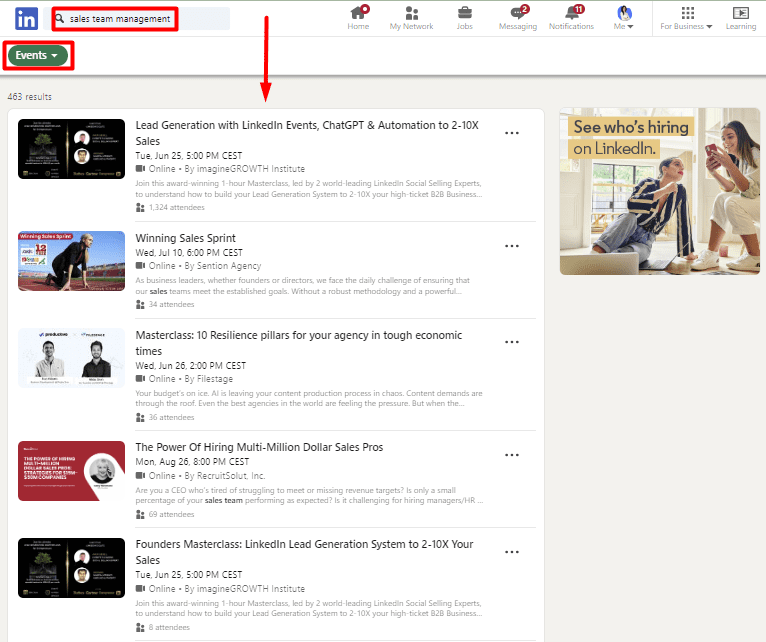
To access the attendees' list and find those leads, you have to click on “Register.”

After that, you should click here 👇
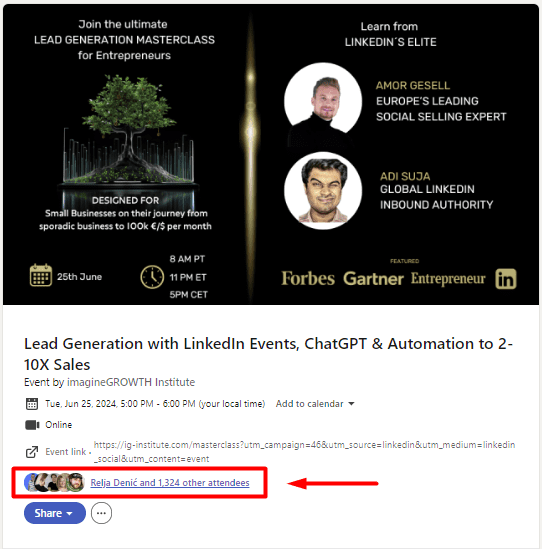
Use filters to narrow down your search to match your Buyer Persona as closely as possible. The only thing left to do is attend the event and use some of the topics and information mentioned in the event to break the ice with your leads.
21. Find leads via Product hunt
Your journey on Product Hunt begins with discovering new and trending products in your industry. There are two ways to find leads here. Firstly, you can go to relevant discussions, watch out for questions from your target audience, and find them on LinkedIn.
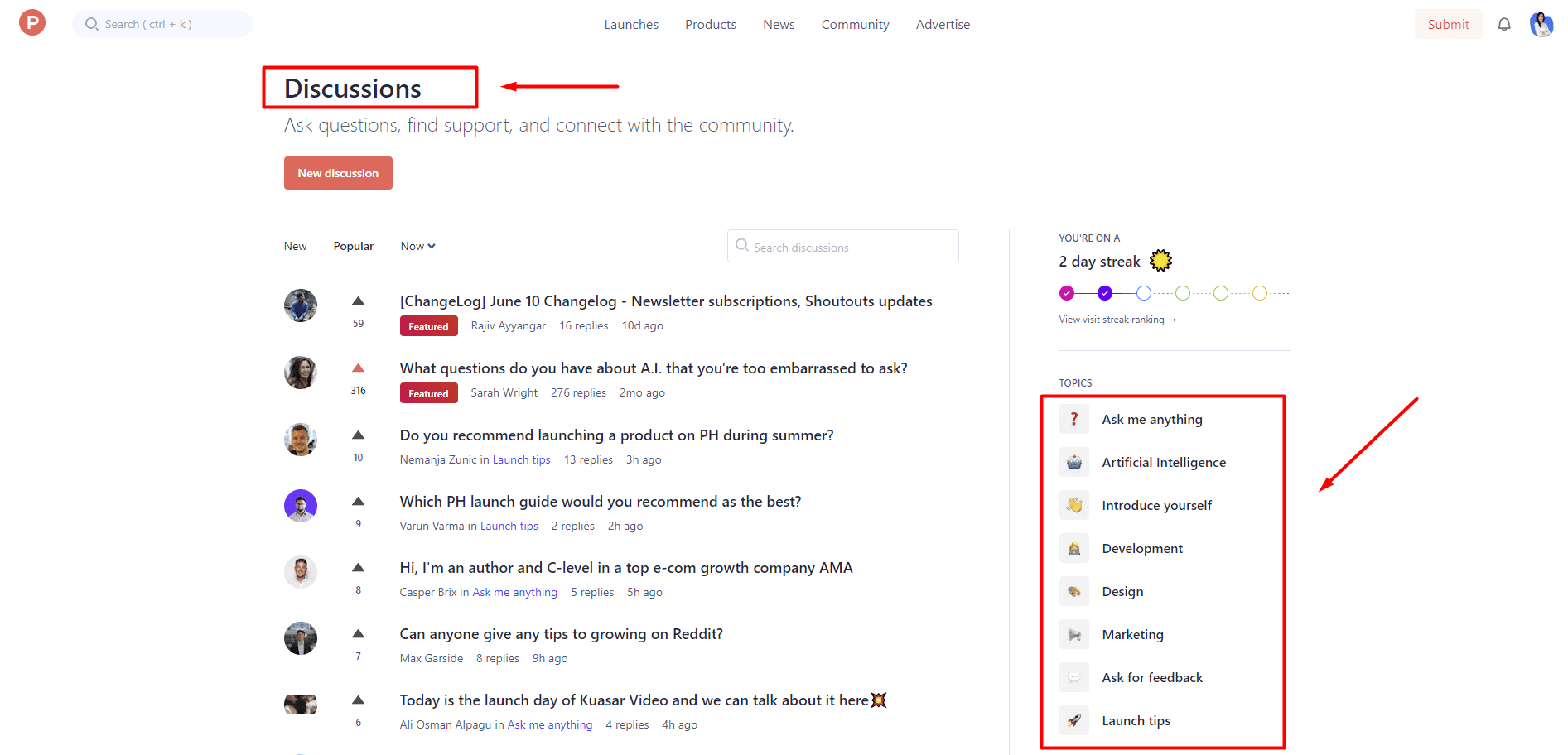
Secondly, if SaaS is your industry of choice, you can watch for new software or releases and find makers.
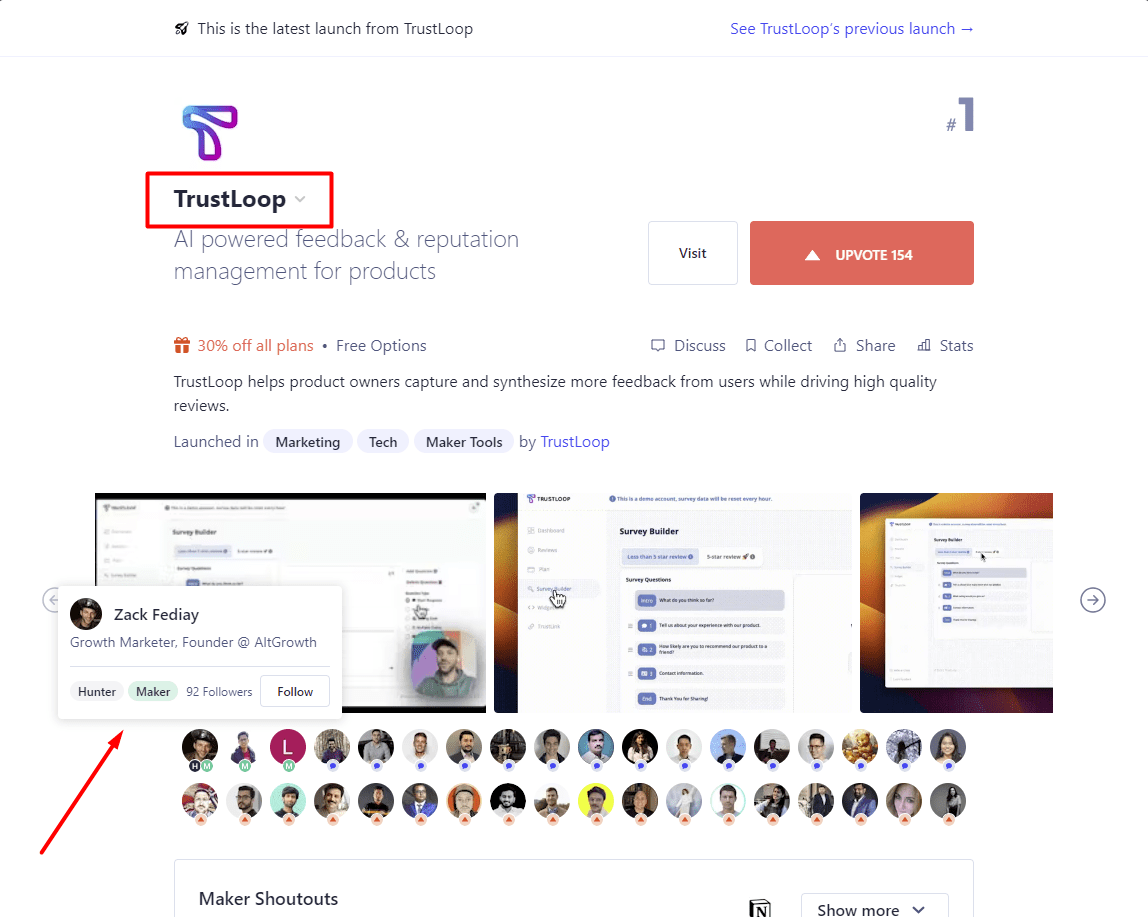
Then, the only thing left to do is to find them on LinkedIn and put the data and personal reference to your CSV file for outreach later on.

22. Find leads on Medium
Many people of all occupations share their stories and thoughts on Medium, and your sales leads could be one of them. Medium is a blogging platform with over 100 million active monthly readers and 175,000 authors who are thought leaders, journalists, and experts, so you have a deep pool of sales leads to search from.
Also, Medium is pretty easy to use. You just need to type the topic of interest in the search bar and comb through articles.
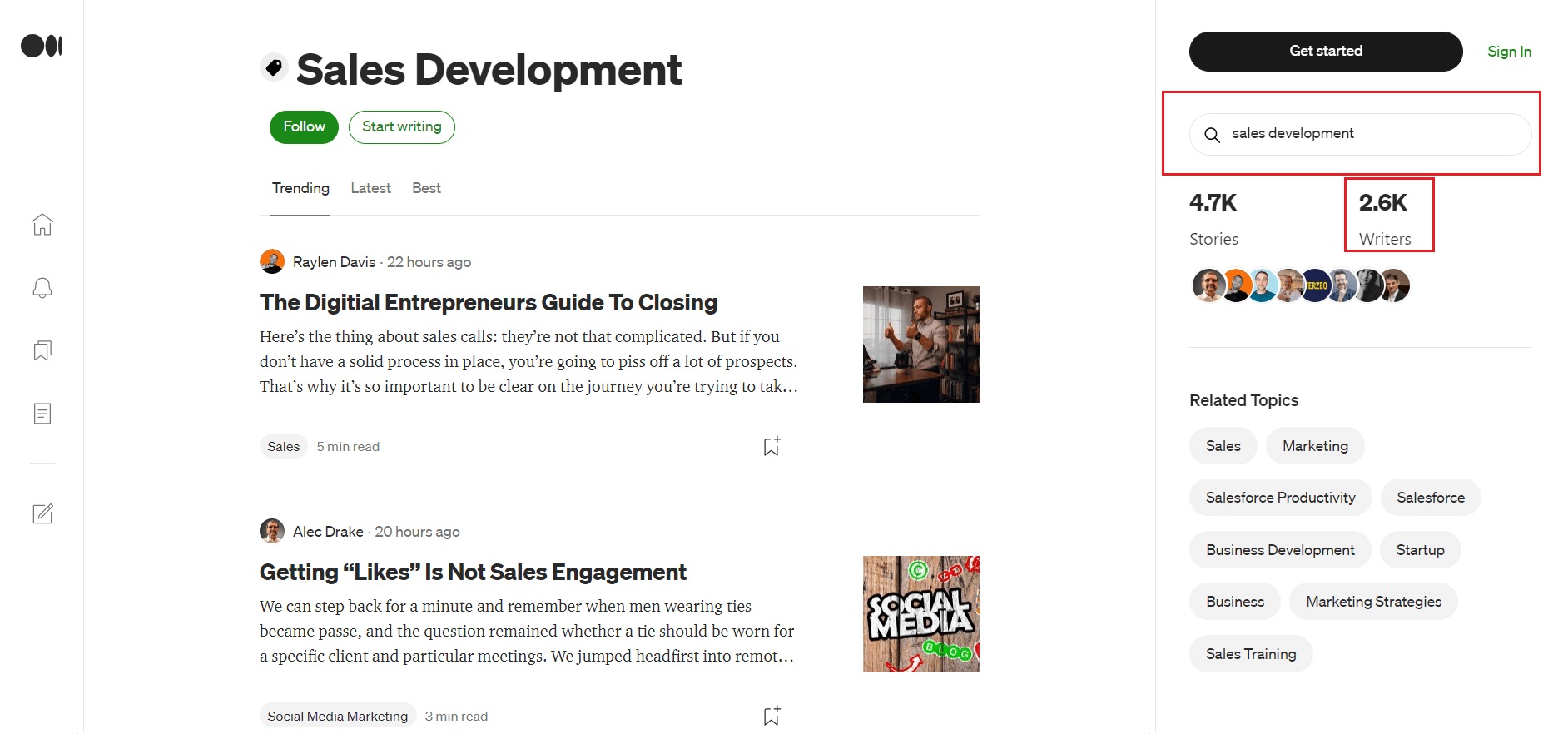
Once you find an interesting post, go to the author's profile. You will usually see their LinkedIn profile or other Social Media URLs in the About section, so it is easy to find leads right away.
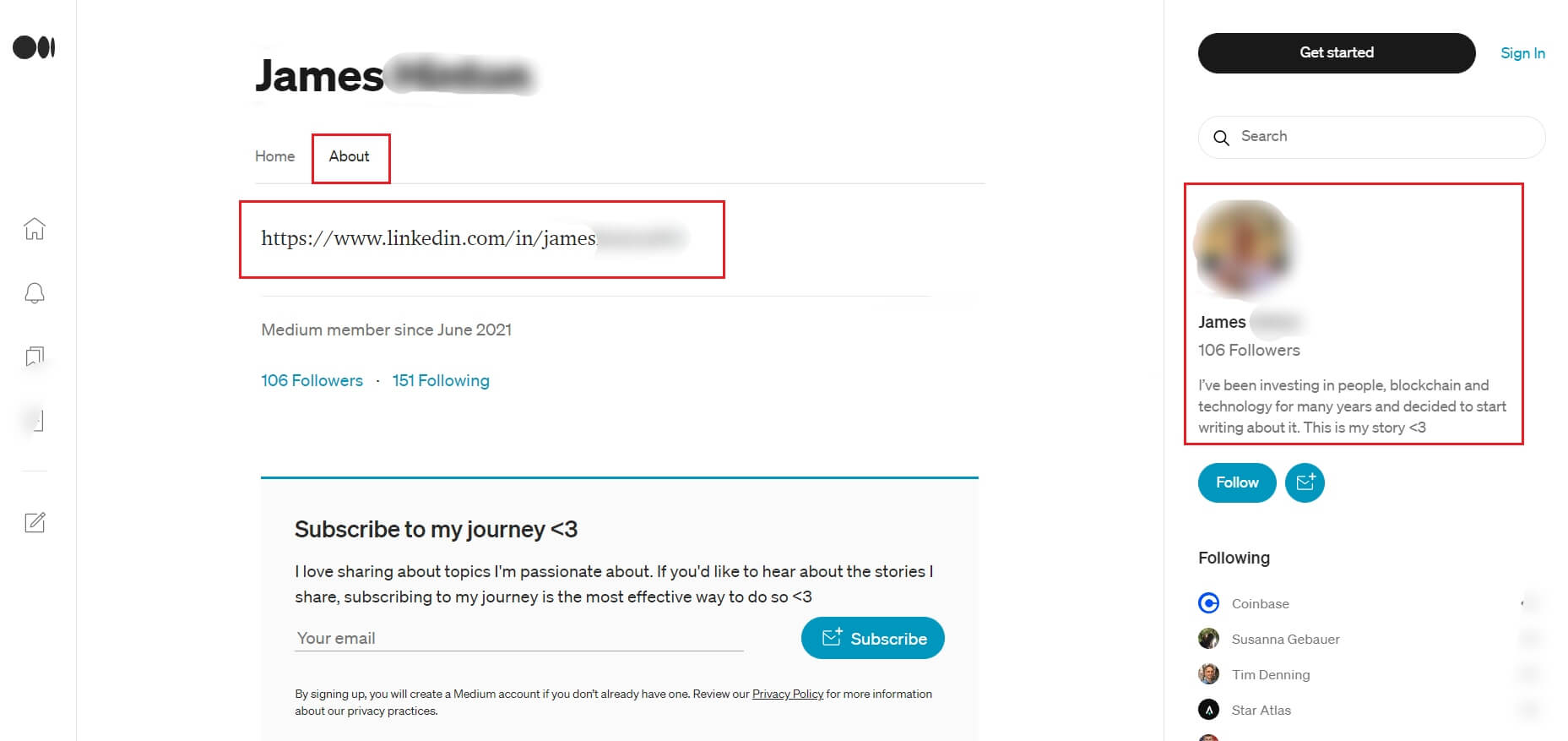
Additionally, you can see the comments and the profile of the person who posted that comment. Your sales leads could be one of them, so you can find them on LinkedIn and put them in your personalized document for further outreach.
23. Find leads on podcast guest lists
Use a simple Google search to find podcasts relevant to your industry or target market. Then, examine video titles and write down the speakers so you can find them on LinkedIn. Once you're ready to reach out to them, use personalized messages where you reference their podcast appearance and explain how your services can benefit them.
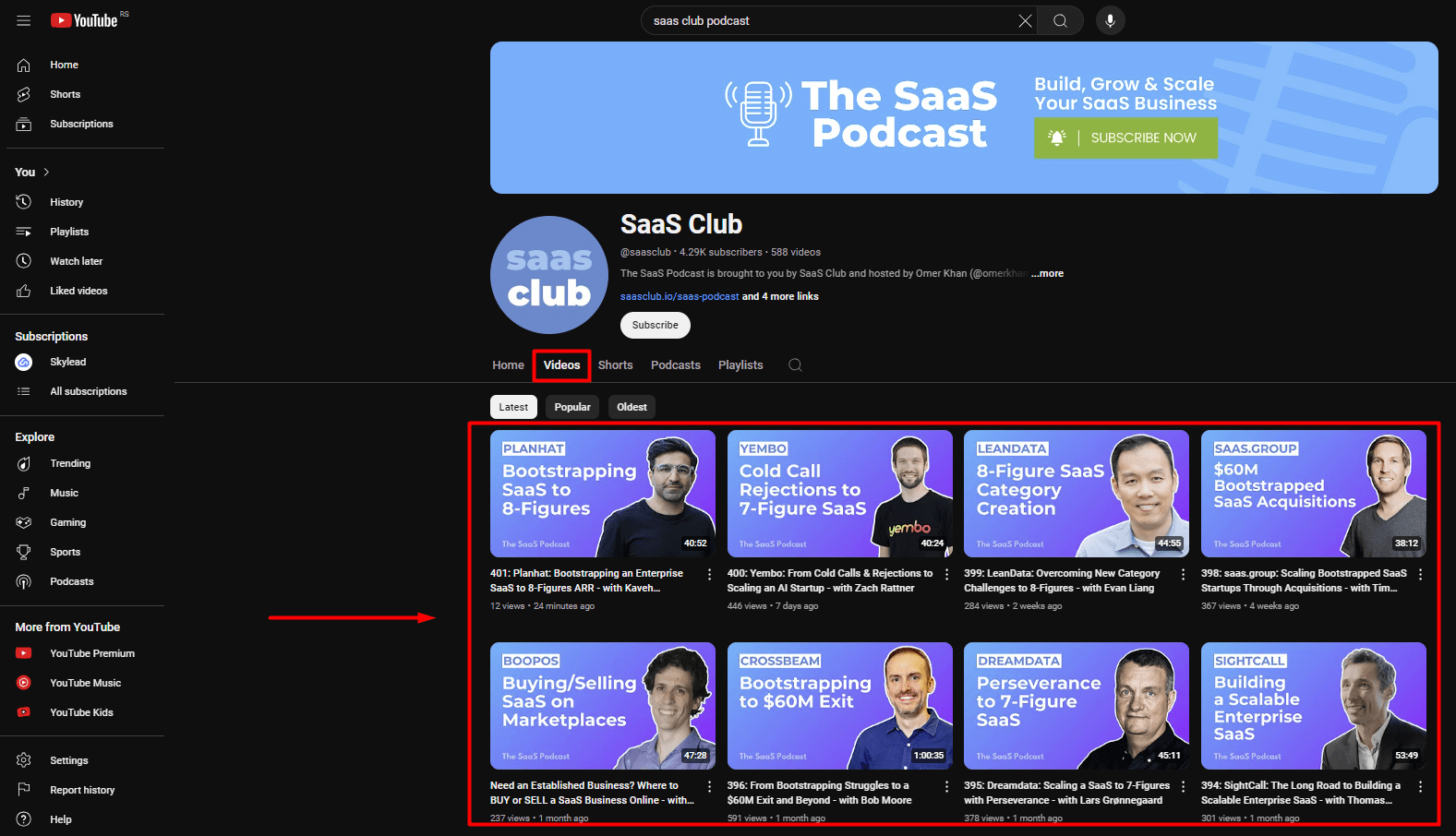
24. Find leads on Discord
Discord is a place where people can communicate with each other via either text or voice chat. Unlike Slack, Discord was initially created as an informal place to hang out with your friends or even play massive multiplayer online games.
However, Discord grew to be more. Now, it is a new hotspot where people all around the world gather to share their experiences and thoughts on all kinds of topics. Thus, many so-called servers, aka groups, have emerged, and you will be able to find the ones of your target audience.
For example, here is what the Salesforce discord channel looks like.
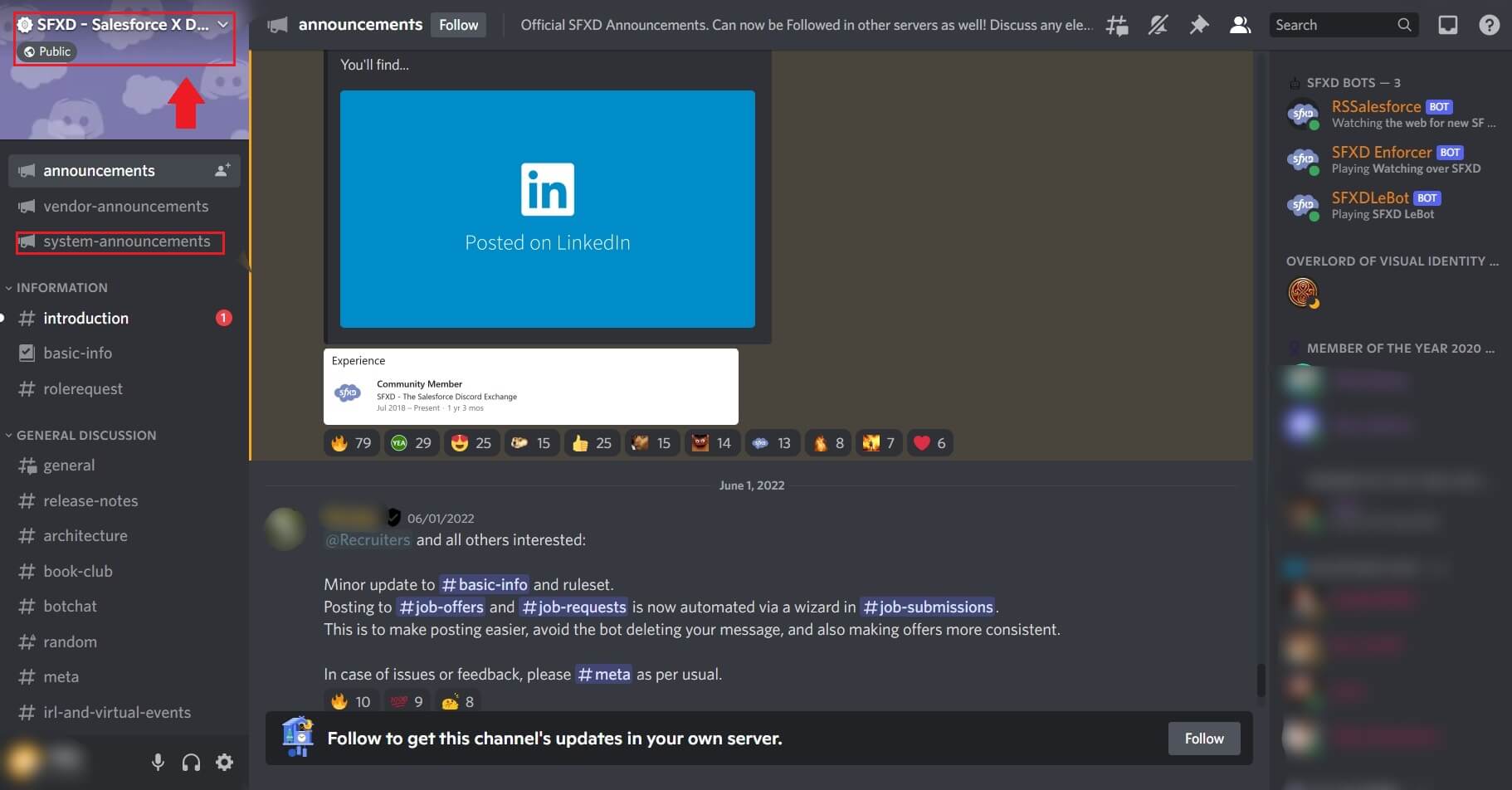
Once you find your niche, join that server, and you’ll get to see a list of all members you can message privately or ask to connect on LinkedIn and take it from there.
25. Find leads on forums and online communities
Online communities such as GrowthHackers or SalesHackers are another place where you can find sales leads. With plenty of topics to search from, you will be shocked by how many discussions and users you will find.
For example, the nice thing about the GrowthHackers community is that you can find the user, see their publications and topics they follow, and choose to follow them or contact them directly. You can also always find them on LinkedIn and reach out from there.
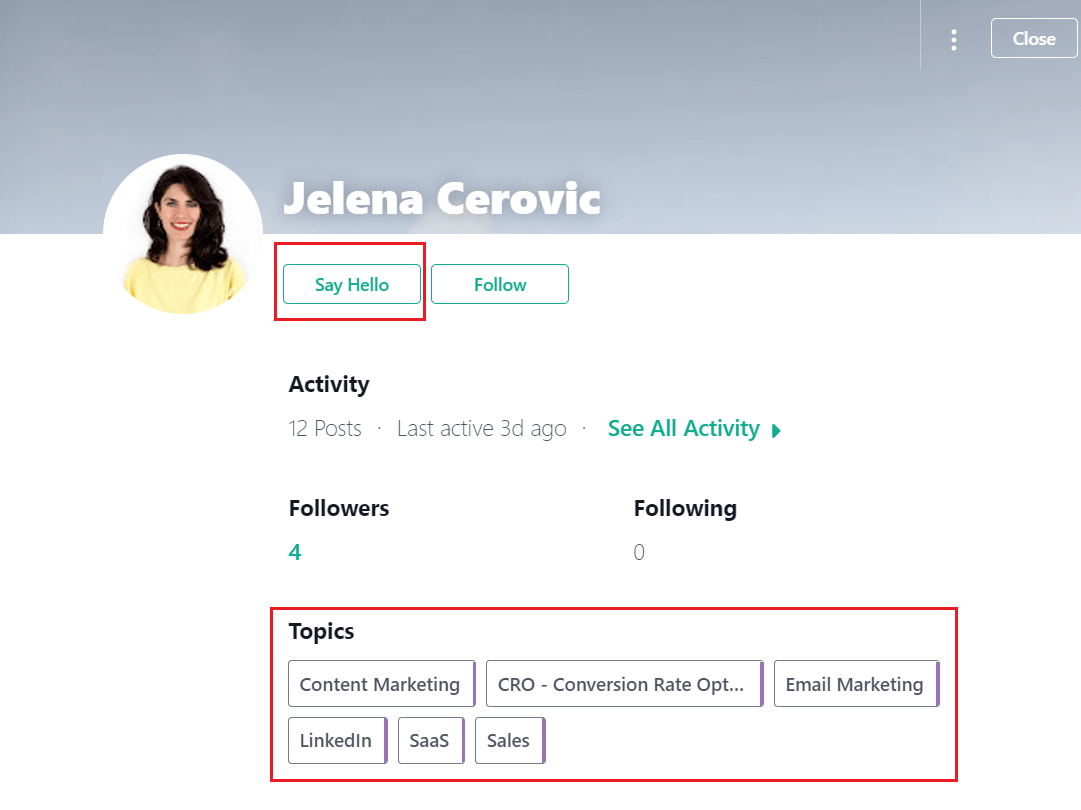
26. Find leads in LinkedIn groups
Despite the common belief, LinkedIn groups can still be useful for something - lead generation. To find leads in LinkedIn groups, you should look for relevant ones from your industry and join.
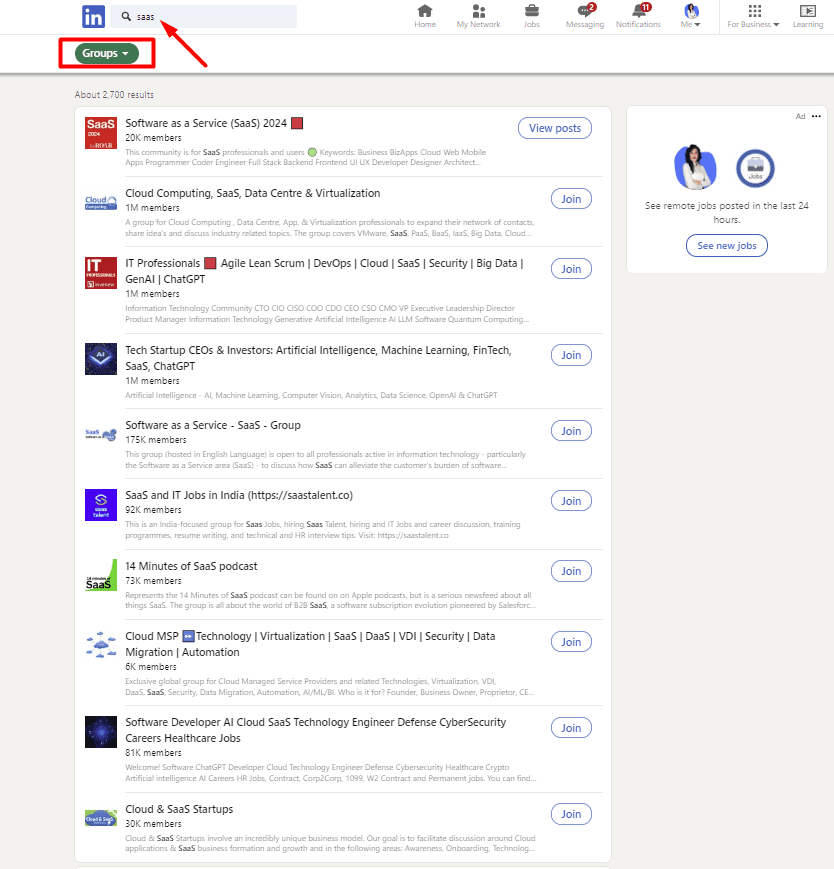
Once you join, you’ll get access to a members list. Click on “Show all.”
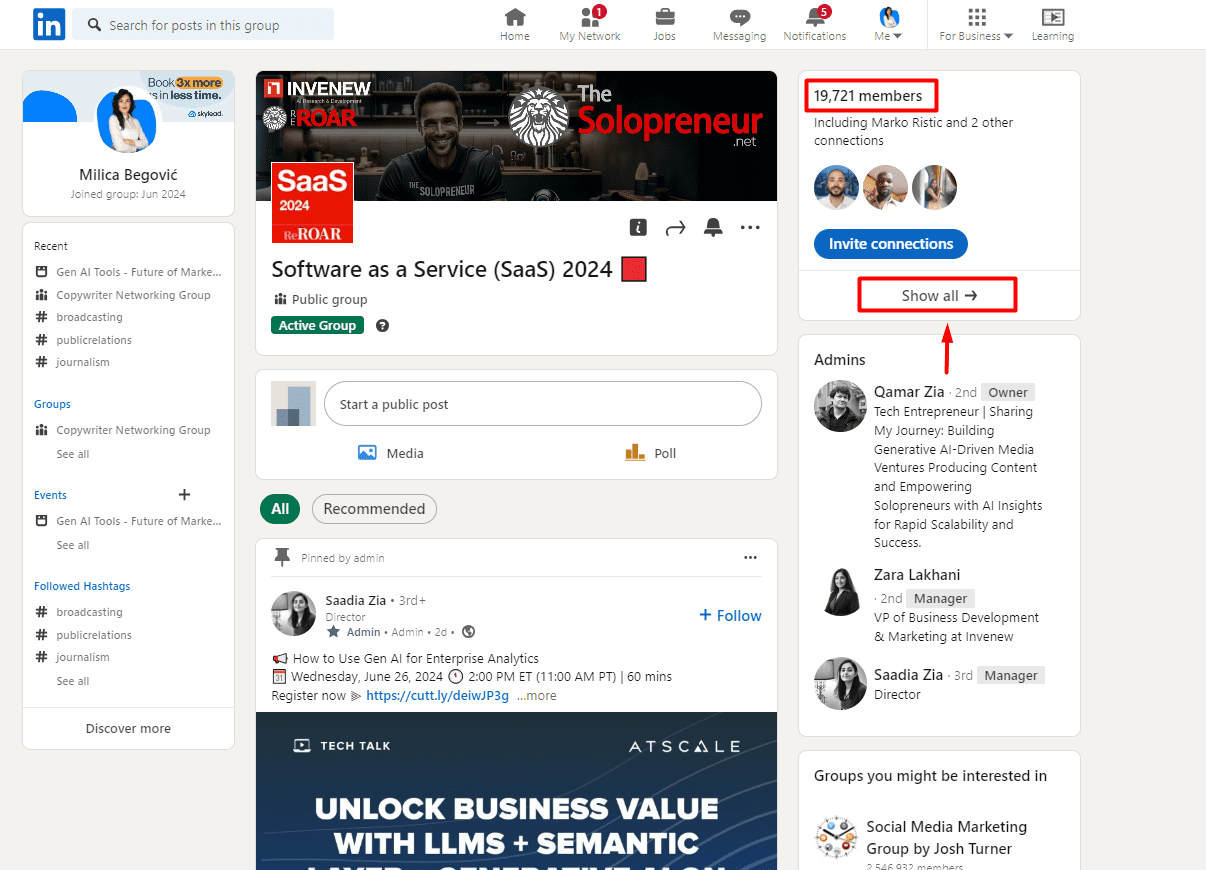
Then, extract the leads from the People section by copying the URL from your browser.
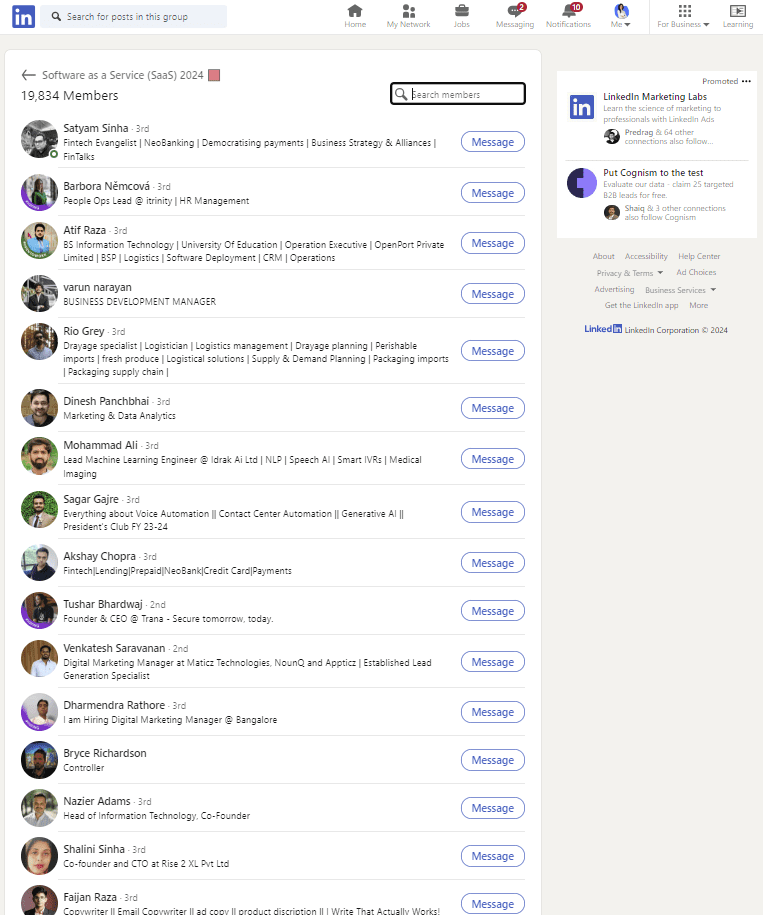
Now, this only works if you use Skylead to help reach out to these particular group members. Just paste the link and create a dedicated campaign for these group members only.
27. Find leads via LinkedIn posts
Lastly, you can also find leads via LinkedIn posts. For example, find a viral post on LinkedIn and go through the comment section and likes. Comb through them, find decision-makers, and put them in your personalization document. Here’s what that looks like 👇

Once you click, this is what you’ll see:

The next step is to use automation tools like Skylead to create an automated outreach campaign, and target leads from that specific post. Isn’t that amazing? Yes, we think so too. 😎 Here’s a connection request message example you can use in this case:
Hey,
I’ve noticed you liked this post on how volume creates abundance.
Just wanted to check what your thoughts are on the subject.
28. Find leads with LinkedIn polls
You can also use LinkedIn polls to attract and find leads. Just create a poll that has a relevant industry pain point, and once you get your replies, go through those people and reach out to them. It’s that simple. Here’s an example:
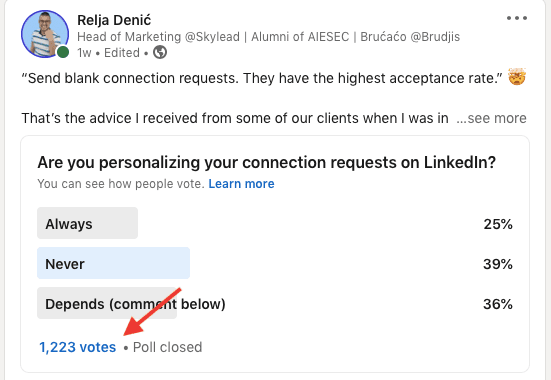
In this case, since users opted for one of three answers, we have three groups of leads: the ones who said "always," "never," and "it depends." You can adapt your outreach efforts to each answer group.
29. Find leads by discovering startups
If your ICP consists mostly of startups, you should visit websites such as ProductHunt, BetaList, AngelList, or Crunchbase. BetaList is the place for recently launched internet startups. It cleverly segments startups by industries, so you’ll find the one you need easily.
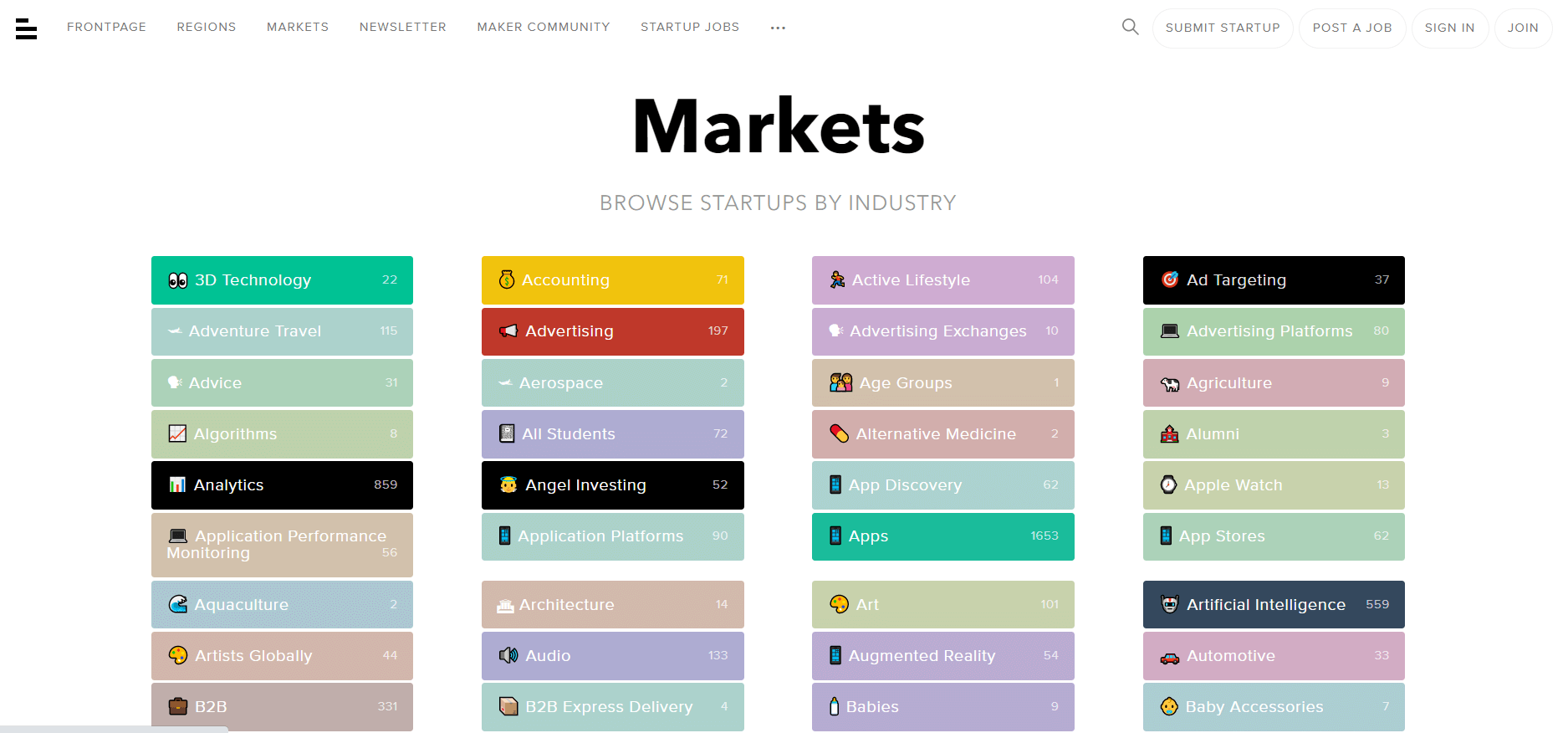
Another advantage is that you can contact the founder directly by finding their social media account on the profile listed beneath the company description or manually on LinkedIn.
30. Find leads by researching niche platforms
Not all companies are alike, and many niche businesses have buyer personas with unique jobs. So, it’s important to research and visit platforms where the target audience has a profile.
For example, if your target group is videographers or graphic designers, you would most likely visit Behance or Vimeo. On the other hand, if your sales leads are music artists, then SoundCloud is the place for you. Looking for developers? Give Github a try.
If, for example, you are selling an invoice management tool and need to reach out to freelancers, go to Upwork. The more information you have on your sales leads, the easier it will be to start the conversation. Here’s an example:
Hey,
I have seen the ratings on your Upwork profile, they are amazing.
I bet you get a lot of work as a freelancer. I was just wondering what tool you use for the invoice.
The possibilities are pretty much endless here.
Leads found, now what? Streamline your outreach to optimize time
Your leads are found, so now it’s time for outreach. Using an automation tool can help save time, track your outreach results better, and give you more time to focus on building relationships with prospects. So, what’s your choice of tool? Skylead, of course - a LinkedIn automation and email outreach platform that streamlines your outreach process.
Now, remember when we said there’s a good use for the personalization document with actionable data? Well, this is where we teach you how to use it.
To streamline the process and reach out to the sales leads you’ve found and researched, you should create a CSV file out of the gathered data. The only condition is also to paste the lead’s LinkedIn profile and/or email address.
Skylead already offers the following native variables for message personalization based on the sales leads’ LinkedIn profiles:
- First name
- Last name
- Current company
- Years in current company
- Total career positions count
- Total years of experience
- College name
- Occupation
Nonetheless, you can insert personalized information into columns, such as a reference to a certain post, comment, or any other place you’ve found them, and create your own custom variable for more personalization. For example, let’s take a customized intro that references how you’ve found them as a custom variable. Now, here’s what your CSV file should look like.
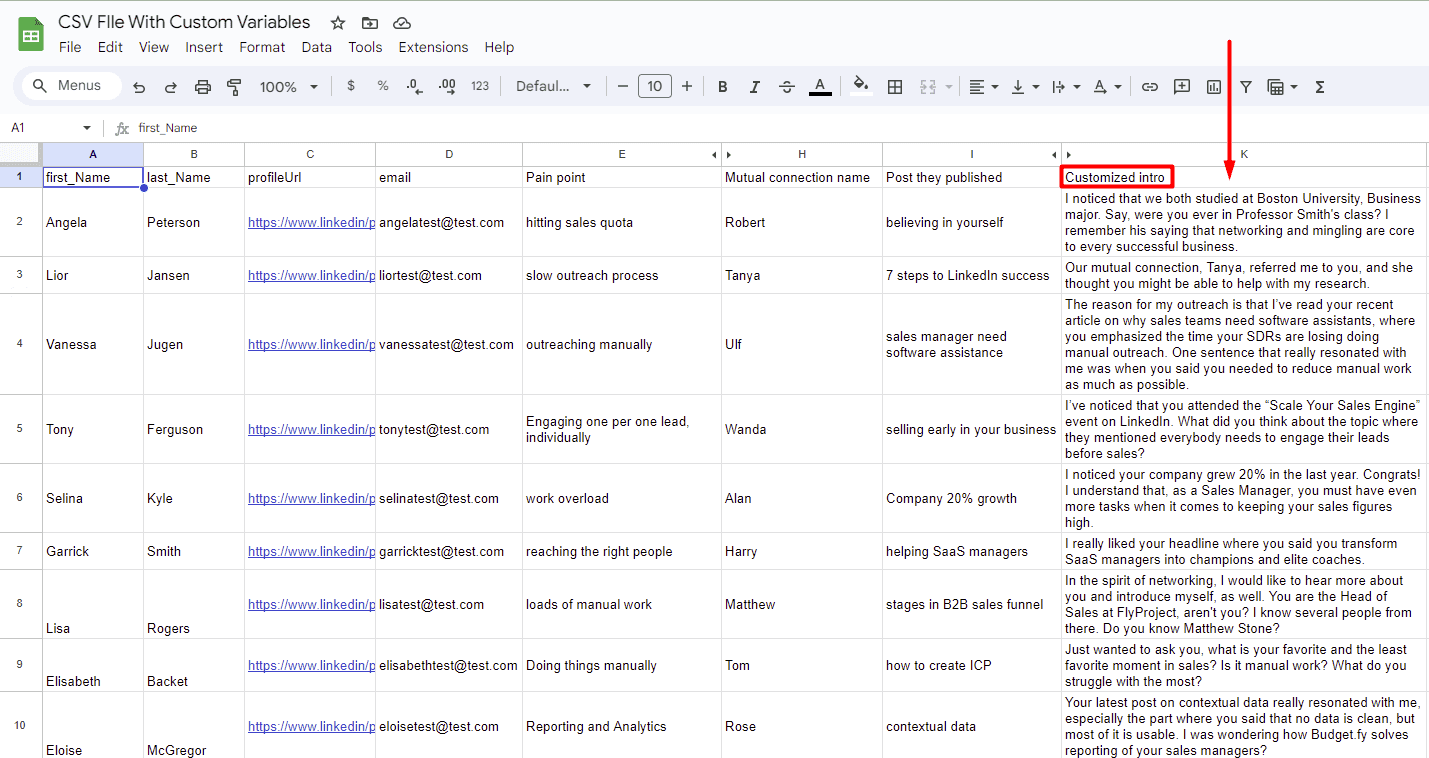
From here, you proceed with automating the outreach process. Here’s how 👇
Create a campaign in Skylead
It’s time to launch our first Skylead campaign, and we’ll go over it step-by-step.
First, go to your Skylead dashboard and click the Create new campaign button.
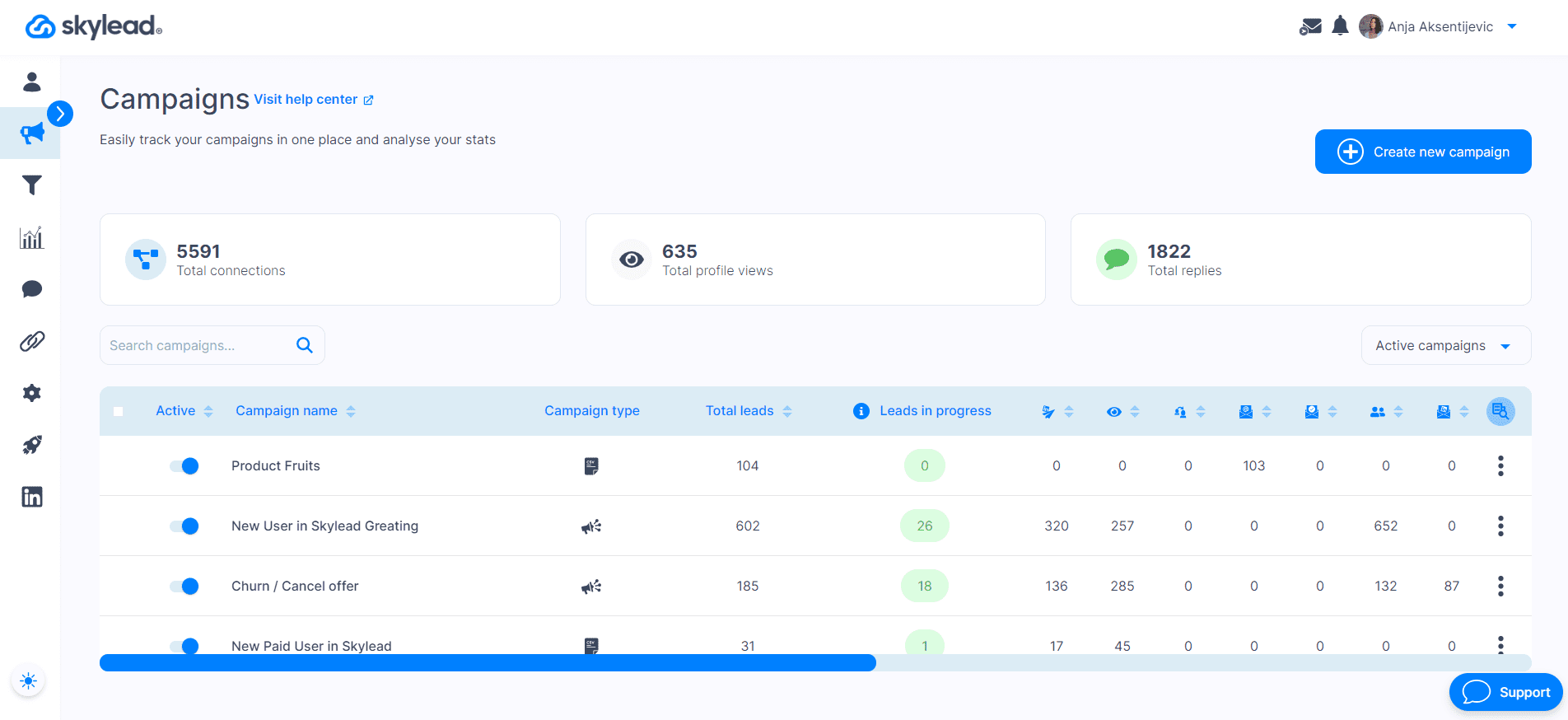
The second step is to choose your campaign type - Import.
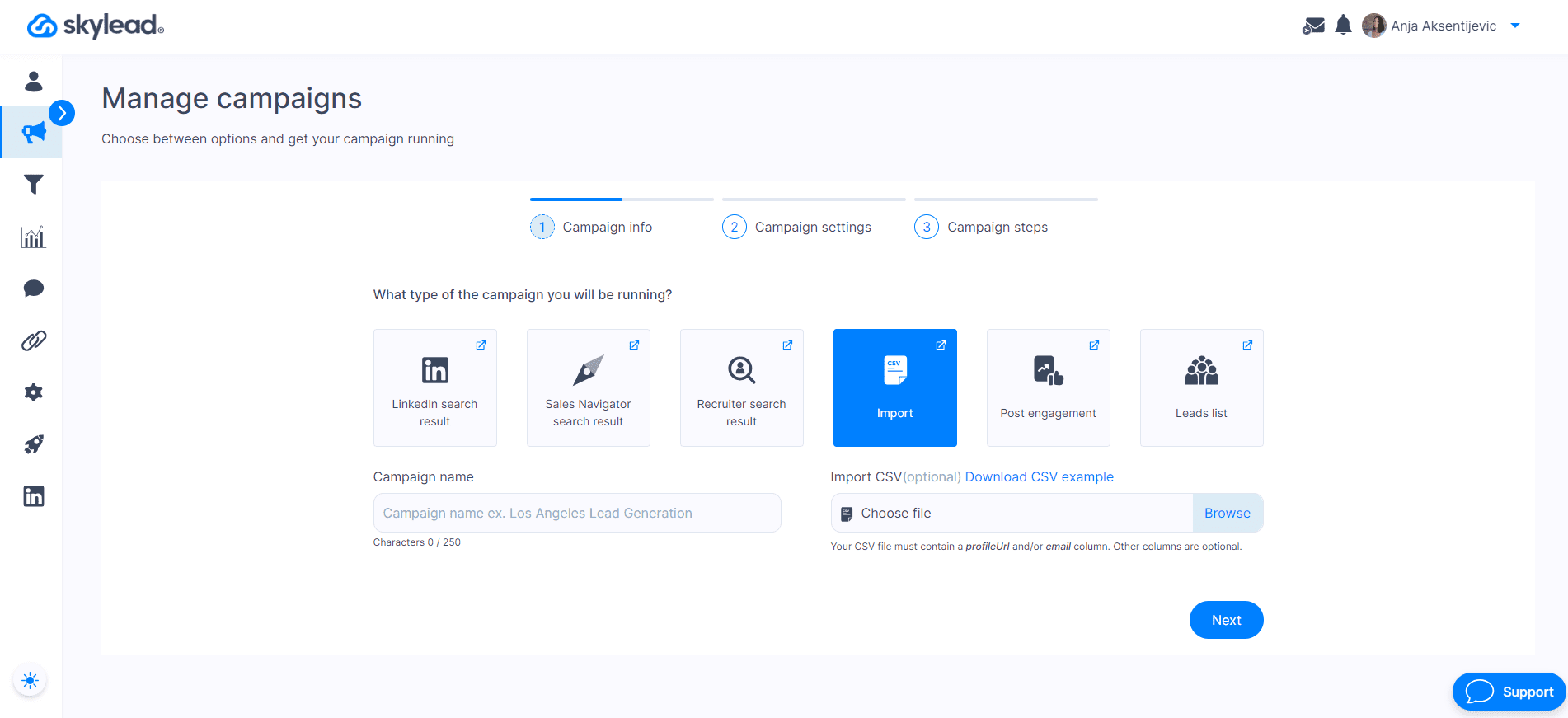
The next step is to set up additional settings, like date, email tracking metrics, etc. In this section, you can add an unlimited number of email addresses at no extra cost. Skylead will auto-rotate them for extra safety. Once you’ve made your changes, you can proceed.

Now, all you need to do is create an action path for your outreach that Skylead will follow automatically. This is where we introduce our first-to-market Smart sequences. With them, you can combine LinkedIn and email action with if/else conditions. This will help you reach your leads while maximizing touchpoints with them.
This is what a Smart sequence looks like in the tool:
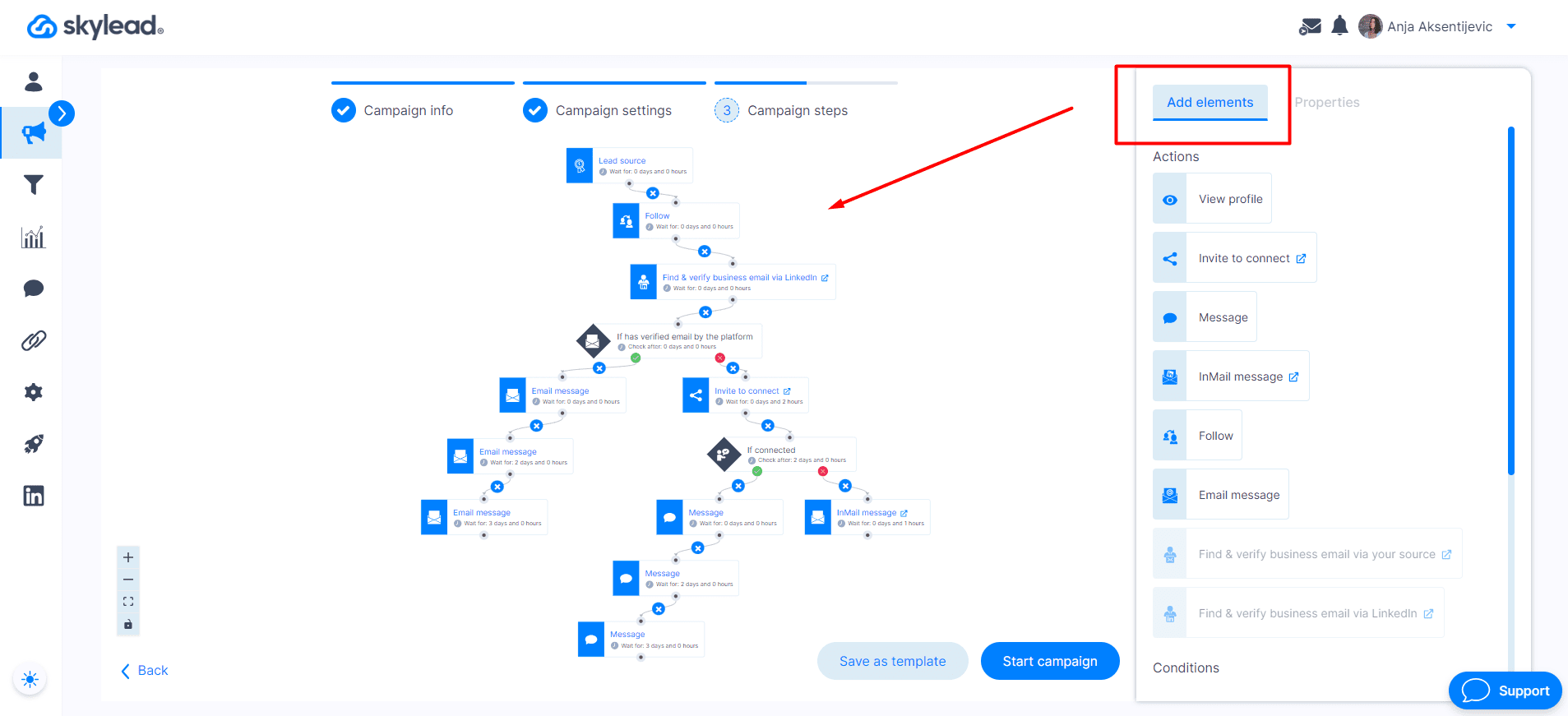
Lastly, don’t forget to create personalized messages for the actions, such as an invite to connect, LinkedIn InMail, LinkedIn message, or email message. From our experience, adding personalized image to your outreach flow increases the response rate to 63%.
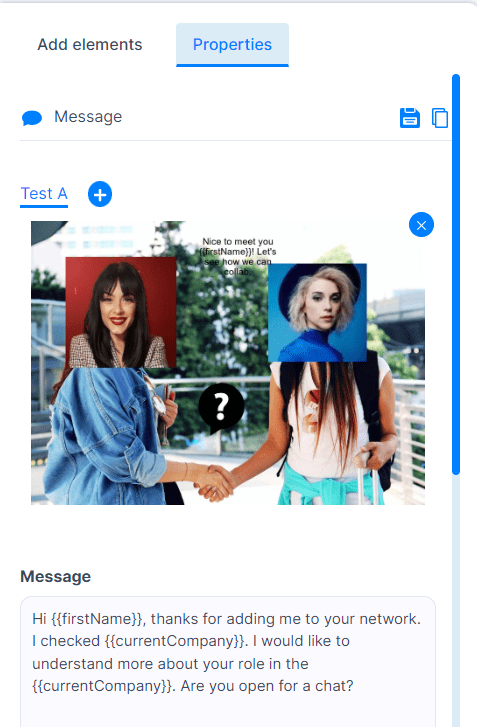
FAQs
How to find leads?
Identify potential customers through content marketing, social media engagement, and networking. Create valuable content, participate in discussions, and connect with prospects at industry events to generate interest and build relationships.
How to find B2B leads?
Use LinkedIn, industry associations, trade publications, and networking events. Leverage content marketing, email campaigns, and partnerships to attract and engage business clients.
How do I measure the effectiveness of each lead generation strategy?
To measure the effectiveness of each lead generation strategy, you need to track and analyze key metrics. Start by setting clear objectives for each strategy, such as the number of leads generated, conversion rates, and the quality of leads.
Tools like Google Analytics, CRM software, and marketing automation platforms are used to monitor these metrics. Look at the engagement levels, such as open rates and click-through rates for email campaigns or the level of interaction on social media posts. By comparing these metrics against your goals, you can determine which strategies are most effective and adjust your approach accordingly.
Can you provide examples of successful lead generation campaigns using these strategies?
Yes! A SaaS company used content marketing by creating a series of whitepapers and e-books targeting specific pain points in their industry. They promoted these resources through blog posts and social media, capturing leads through gated content forms. Another example is a B2B firm that utilized webinars and online events. They hosted industry-specific webinars, offering valuable insights and networking opportunities, which helped them gather high-quality leads.
A third example is a small business that leveraged email marketing and CRM automation. They segmented their email list based on customer behavior and engagement, sending personalized follow-ups and nurturing leads effectively, resulting in a significant increase in conversions. These examples highlight the importance of targeted content, engaging events, and personalized outreach in successful lead generation campaigns.
Ready to get those leads?
Now that you’ve seen 30 ways to find leads, it’s time for you to put your newly found knowledge to the test. Pick a couple of sources that hit close to home, and begin expanding your lead generation strategy.
While you’re at it, remember to incorporate an automation tool into your sales strategy. After you’ve found your leads, you can check out Skylead, schedule a demo, and get a 7-day free trial to explore all the outreach possibilities we offer. Saving time on manual outreach doesn’t seem so bad, does it? Outreach away!
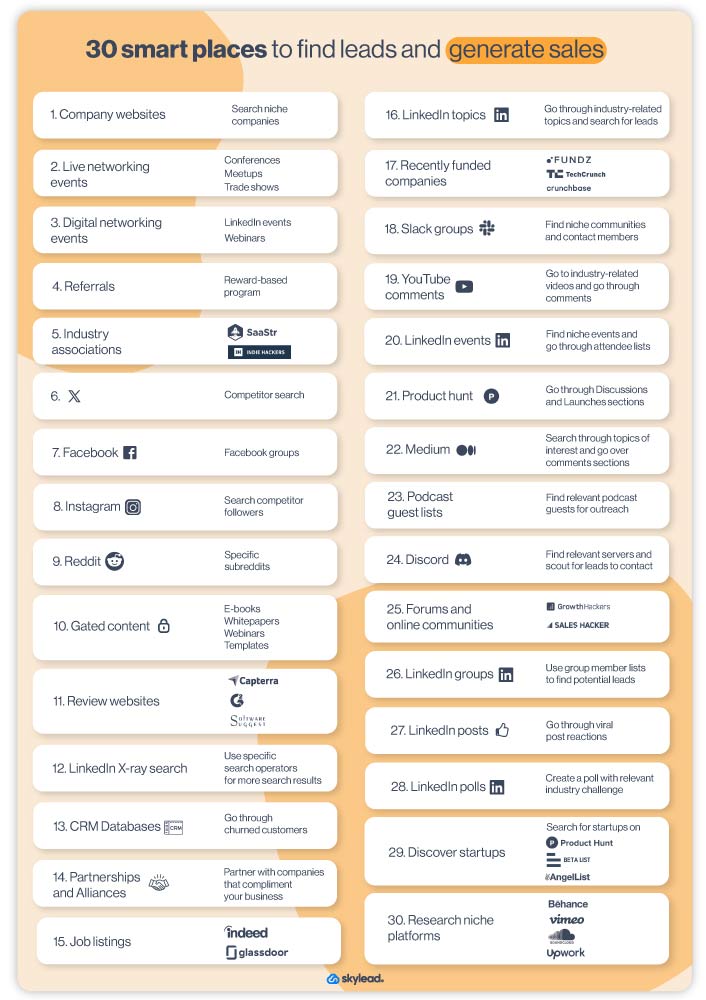
LinkedIn is a social media for professionals, and it’s classified as the number #1 choice for lead generation. This is because it now counts more than 900 million LinkedIn users. Moreover, according to the official LinkedIn stats, 4 out of 5 drive some business decisions. So no wonder that marketing, recruiting and sales teams make LinkedIn outreach part of their daily work routine.
LinkedIn outreach is a vast topic, and there are many misconceptions and good tips on how to do it. That is why we decided to create a detailed LinkedIn outreach guide that uncovers the following:
- Benefits of LinkedIn outreach;
- What medium is better to use for the outreach - LinkedIn or email;
- Strategies, rules, and methods that work best and those that do not;
- How to use LinkedIn for outreach in 6 easy steps and build positive relationships;
- Some of the best outreach message templates you can use;
- Answers to most burning questions about LinkedIn outreach.

What is LinkedIn outreach?
LinkedIn outreach is a process of sending connection requests and messages to your potential clients via LinkedIn. It’s the best way to expand your network, get in touch, warm up, and build positive relationships with your leads.
The 5 main benefits of Linkedin outreach
It’s not just about the ability to send LinkedIn connection requests, InMails, or other LinkedIn messages, but what you will accomplish with them. Here are the benefits you can expect if you use LinkedIn and every aspect of it in the outreach process.
1. Reach high-quality B2B leads with ease.
LinkedIn has over 900 million professionals from every industry in the world. So it's no wonder this audience has twice the buying power of the average web audience (LinkedIn). Therefore, sales teams can rest assured that with the right filters and top LinkedIn lead generation strategies, they can find the most qualified business-to-business leads for their business.
2. Increased reply rate.
LinkedIn is, first and foremost, a social media platform where you can find various information about your leads. That said, the secret to LinkedIn outreach is personalization and genuine conversation. That said, by looking at your lead's profile, you can search for any information to personalize your message. Whatever you find, be it a mutual connection or a post they shared, you can reference that in your outreach message and thus increase your acceptance and reply rate.
3. Target B2B leads with more precision.
Marketers no longer need to struggle to find professionals on Instagram or Facebook. Instead, they can find and reach out to their potential leads easier with targeting and retargeting options via LinkedIn ads. Moreover, they can generate greater awareness for their product or service. LinkedIn marketer can also easily contact their target audience via sponsored InMail ads and experience 2x more conversions.
4. Find ideal employees.
One of the best perks of LinkedIn is that recruiters can publish job posts for free. However, they can also find the best employee for their business by tapping into a larger pool of talent and headhunting the ideal candidates directly.
5. Break the wall and reach out to recruiters.
By using job posting websites, you can’t get a hold of recruiters. However, LinkedIn allows you to find, send a connection request and reach out to the hiring managers in your ideal company. This way, you can explain why you are perfect for the job or get feedback on your application, all of which you cannot do on other platforms.
LinkedIn vs email outreach - Which one is better?
Both LinkedIn and email channels are used extensively for outreach. However, there is a "slight" advantage to LinkedIn.
The thing is, the social media nature of LinkedIn allows more genuine communication between its users. On the other hand, cold email outreach is distant and often perceived as spammy since, among other things, you cannot always see and find out more about the person behind the cold message.
And the end result can be measured shown in numbers.
For example, according to the official LinkedIn learning courses, InMails have an average response rate of 18 to 25%. On the contrary, cold emails have only a 3% average response rate, and this happens for a couple of reasons.
Firstly, LinkedIn outreach is more transparent since potential leads can see your LinkedIn profile, work history, bio, or posts. In other words, what they are all about.
Secondly, LinkedIn sends a couple of alerts and reminders when the prospect receives a message. In addition, if the leads have a LinkedIn app installed, they will also receive a notification on their phone. What's more, if you send a follow-up message, LinkedIn will send the same amount of alerts, making it harder for your prospect to forget to reply or ignore.
Lastly, if you use LinkedIn, you can find your ICP and people who work in it in the blink of an eye. This way, you can easily reach out to your potential customers without navigating multiple platforms.
However, with LinkedIn's power, we must recognize email as the outreach channel simply because some users prefer email communication or are inactive on LinkedIn.
That said, it's best to use both LinkedIn and email outreach for optimal results. So, we will discuss it in the LinkedIn outreach rules section below.
LinkedIn outreach methods
LinkedIn offers multiple ways you can use to reach out to your potential customers.
Connection requests
The first outreach action in line is a LinkedIn connection request. You can send a connection request to your 2nd and 3rd-degree connections along with your first message.
This cold message comes with a restriction of 300 characters, so try to keep your personalized message short and sweet. For example, you can reference a mutual connection or that you’d like to discuss the event they attended and wish to connect.
Direct messages
Once the lead accepts your invite, they become your 1st-degree connection, and you can send them a direct message. This message acts as both chat and email since it’s delivered straight to your lead’s inbox along with the notification. In addition, direct messages can be 8,000 characters long or somewhere between 1142 and 2000 words.
InMail messages
If your lead ignores your connection or leaves it pending for a long time, you can always send LinkedIn InMail. These InMail messages are structured as emails and can have up to 200 characters of the subject line and a body of up to 1900 characters. However, keep in mind that shorter InMails get a better response rate.
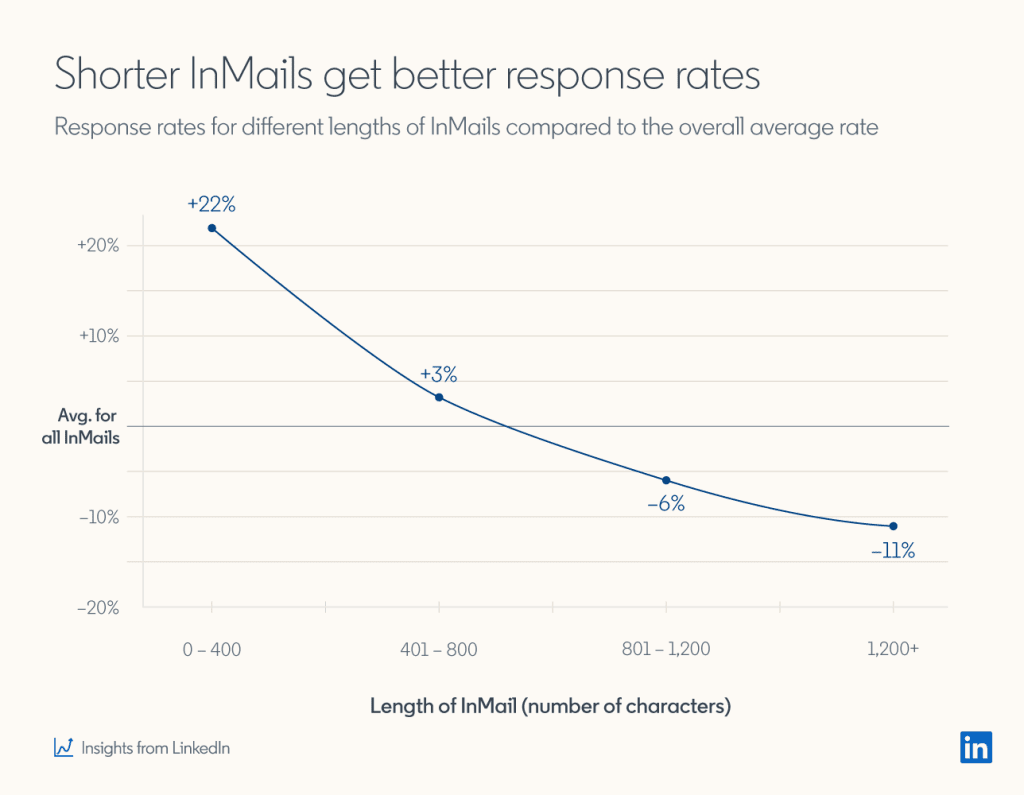
As mentioned before, LinkedIn InMail gets far better results than emails. Especially if you write a message that will generate a high response rate. If you are not sure how to write such messages, here are a couple of LinkedIn InMail examples with a 25% reply rate formula to get inspired.
You can send InMails to your 2nd and 3rd degree connections. However, depending on your subscription plan, you will have different amounts of Inmail credits per month. For example, a LinkedIn premium subscription grants you 15 paid InMail credits. On the other hand, the Sales Navigator account offers 50 paid InMails per month. If you pay a Recruiter Lite subscription, you will have 30 paid InMail credits a month. Recruiter subscribers are also the only LinkedIn members who can purchase additional paid InMail credits.
Apart from paid ones, you can also send 800 free InMails per month. The trick is to find people with their LinkedIn profile set to Open. The easiest way to find people with an open profile is by going to your 2nd or 3rd-degree connection’s premium profile. Then click the Message button. If you see the text Free message at the bottom, that person has an open profile.
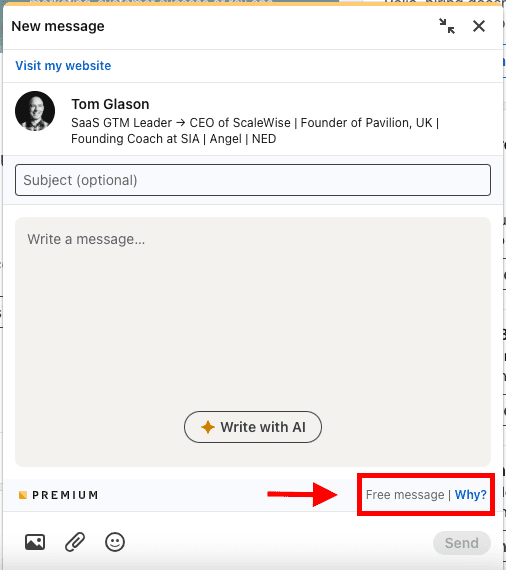
View profile and follow features
And if your outreach falls behind, you can always stop by your lead’s LinkedIn profile to view or follow them. The leads will receive a notification of whichever action you perform. In other words, it will almost always remind them of your message and give them a nudge to respond to you.
LinkedIn outreach in 6 easy steps
1. Define ICP and buyer persona
The first step to finding qualified prospects & leads is creating an Ideal Customer Profile and Buyer Persona.
These documents represent the aspects of your perfect leads and the company they work in. They are the basis for quality lead generation and usually contain specifications such as:
- Job titles;
- The industry they work in;
- Company size;
- Pain points, etc.
ICP and Buyer Persona are best created based on your current customer data, such as who:
- Has the shortest buying cycle;
- Keeps high retention rate;
- And refers your product elsewhere.
In addition, try to keep these documents actionable. In other words, create the specifications so you can use them either for:
- Your prospecting via LinkedIn, Recruiter, or Sales Navigator advanced search filters;
- Or for LinkedIn outreach messaging.
2. Find leads using LinkedIn search & creating lists
The next step is finding prospects that match your ICP and Buyer Persona.
If you use LinkedIn Sales Navigator or Recruiter for lead generation, you are probably familiar with various advanced search filters. Simply use LinkedIn Sales Navigator filters and import all specifications from your ICP or Buyer Persona documents. Then, save the search URL, or create a list of prospects for the next step.
If you don’t have a LinkedIn Sales Navigator account, no worries. You can still use basic filters to find your ideal leads. Or you can use some of these top LinkedIn lead generation strategies.
3. LinkedIn outreach automation: Setup your campaign
In today’s day and age, we use various tools to help us in our mundane tasks. Therefore, it’s natural for sales, marketing, and recruiting specialists to do the same.
One of those solutions is the LinkedIn automation tool. These tools help you streamline time-consuming outreach tasks, so no wonder they become a must-have for many experts.
To set up your LinkedIn outreach campaign, let’s take our outreach automation tool, Skylead, as an example.
First, go to your Skylead account dashboard and click Create a new campaign.

Next, choose the source of your leads. Then, paste LinkedIn Sales Navigator, Recruiter, or basic search URL. Or you can import your CSV file.
Lastly, choose the connection degree you wish to reach out to and click Next.
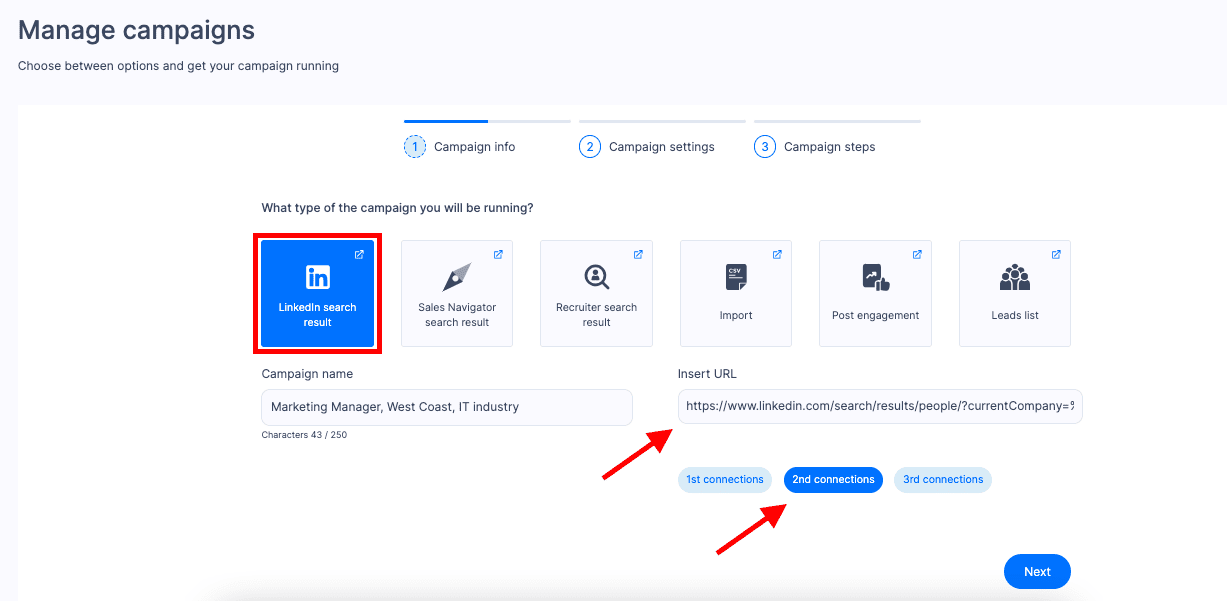
Now here is where you define the operative part of your campaign. Choose which options you want and set up the start and end date of your campaign.
Among other outreach campaign settings, know that Skylead has the auto-refresh option. Essentially, if new leads appear within the same URL source, they will be pulled into active campaigns if you turn this option on within the tool.

4. Create an outreach sequence
Moving on. We’ve come to the Smart Sequence builder.
By creating the Smart Sequence, you actually create an action path that Skylead will follow to outreach your leads. In addition, what makes the sequence unique is the if/else condition, such as If connected. Thanks to these conditions, you can create countless scenarios, and Skylead will perform the scenario corresponding to the lead’s behavior.
That said, to create your coherent outreach sequence, simply drag and drop different actions and conditions. Here is an example.
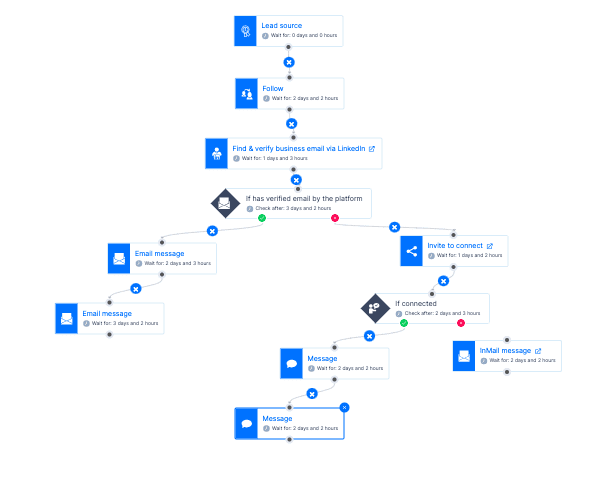
5. Craft your LinkedIn outreach message
LinkedIn outreach is all about how you craft your messages. So, here is a nifty hack for you. In general, every message, be it a connection request, InMail, or email, should contain one of the following:
- Your background;
- The purpose of your outreach;
- Personalized points;
- The hook;
- A solution to the pain point.
And aim for the following structure:
- Personalized intro;
- Context;
- Added value;
- CTA.
6. Nurture & engage
Once the lead responds, it’s your job to engage and nurture them to conversion. People skills play a significant role here, so here are a couple of pro tips that will help you:
- Be empathetic so you can understand their problem and how they feel about it.
- Don’t pitch first. Instead, ask them about their specific problem and customize your pitch.
- Be confident.
- Listen actively.
- Read between the lines.
- Understand body language and voice tones when you jump on a meeting.
- Be an expert at what your company does.
Top 9 LinkedIn outreach strategies
Less is more
When you write your outreach messages, it’s crucial to understand that people’s attention span is, on average, 8.25 seconds (The Treetop Therapy). That said, longer sentences and texts that cause TLDR are a no-go. So our first LinkedIn outreach strategy is approaching your leads with fewer words.
Try being straightforward with your LinkedIn messages and avoid fillers such as:
- Hope you are well;
- I was just wondering;
- Have you had the chance to;
- Just touching base;
- I’m following up on;
And so on.
Personalize
This is the essential LinkedIn outreach strategy. By writing personalized messages, we connect on a deeper level with the people and remove any generic communication. This is a perfect base for social selling and securing the path for better response and acceptance rates.
You can personalize your LinkedIn outreach messages with their first name or job title. However, there are more detailed ways to do it, and we will mention them below.
Send free resource
Avoid pitching in your first message. Instead, start your conversation by asking about the lead’s workflow and pain points. Then send them a free resource that helps them solve the problem they mentioned.
If you start your sales outreach this way, you will have more significant success, as you do not appear intrusive. In return, you get the necessary information to tailor your pitch accordingly.
Leverage your connections
The more you have in common with your target audience, the more honest and reliable you appear. That said, how you seem to be can make or break your LinkedIn outreach.
One of the ways to bring similarity to your LinkedIn messages is by leveraging your mutual connections. For example, people are more open to accepting your invitation if you refer someone they know. Here is an example:
Hey {{firstName}}, {{mutualConnectionName}} sent me your profile as they think you are the right person to help me out in my research about {{Topic}}. So let’s connect and talk if you’re up for it.
Leverage LinkedIn Groups
Another way to discover leads for LinkedIn outreach is by leveraging groups. Even though they are not that active anymore, you can still use them to find and reach out to people who are still in these LinkedIn groups.
Find the LinkedIn group your leads are most likely a part of, and click Show all to see all members.

In addition, you can reference a LinkedIn group post in your outreach and ask them about their opinion about it.
Turn events attendees into your leads
LinkedIn lead generation lets you get creative with finding your most qualified leads. One of those creative ways is reaching out to event attendees.
You can find LinkedIn events that focus on the exact problem your company solves with a product or a service. This way, you can target people who are already warmed up for your outreach message.
To get to event attendees, search for the events and click the Attend button.
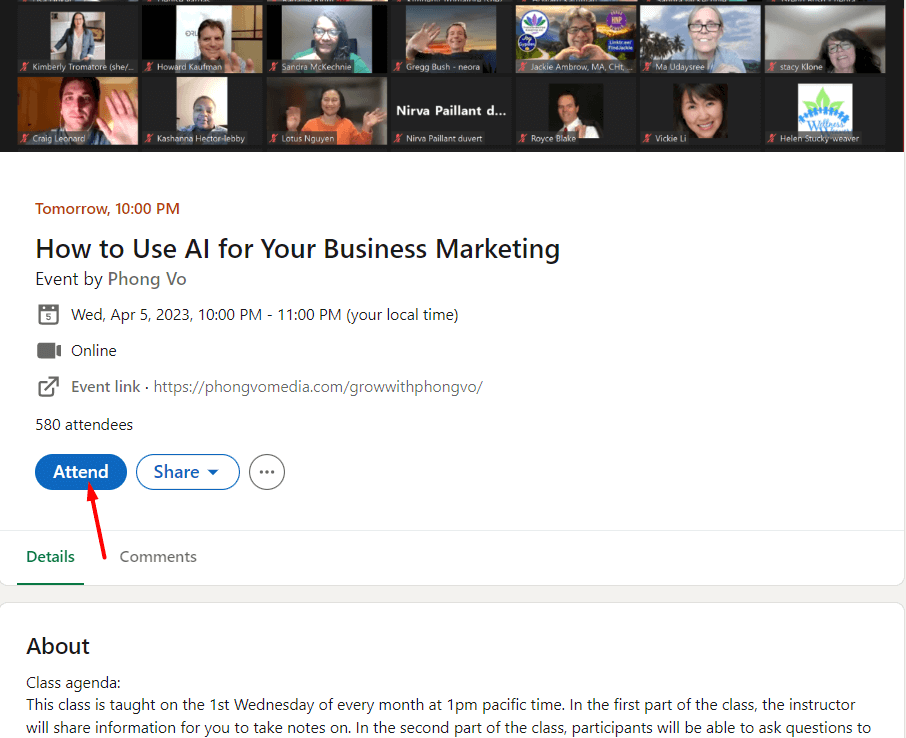
After you've attended, you can check for the list of LinkedIn users who attend this event by clicking Attendees.
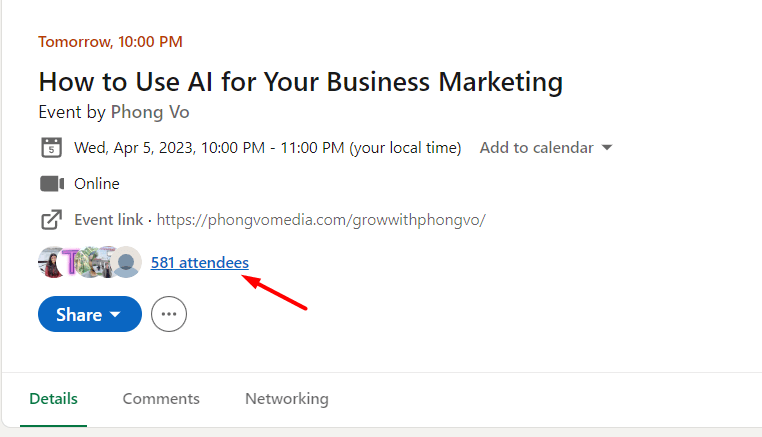
You can then go through the list and create leads in your CRM. Or, you can grab this LinkedIn search, paste it into Skylead and prepare a LinkedIn outreach campaign.
A true hack for LinkedIn outreach here is that you can write personalized messages such as this one:
Hey {{firstName}},
I’ve noticed that you attended {{eventName}}. What did you think about {{eventTakeaway}}? Let’s connect on this.
Contact companies that are hiring
Companies currently hiring or experiencing some change are more likely to be willing to test new products. In other words, these companies emit some buying signals.
Here’s how to find them for the LinkedIn outreach.
If you have a Sales Navigator, finding these companies is a piece of cake. Simply go to Account filters, and under Spotlights, select Job Opportunities.

LinkedIn Sales Navigator will then list company names. You can also narrow your search by selecting other filters, such as Company headcount or Technologies used.. This advanced search will help you find your ICP with the buying signal.
If you are a free or Premium LinkedIn user, you can find these companies by navigating to the LinkedIn search field. Type in the job title, select Jobs and use other filters to narrow your search. Then, go through company names and mark them down in your CRM to find key decision-makers later on.
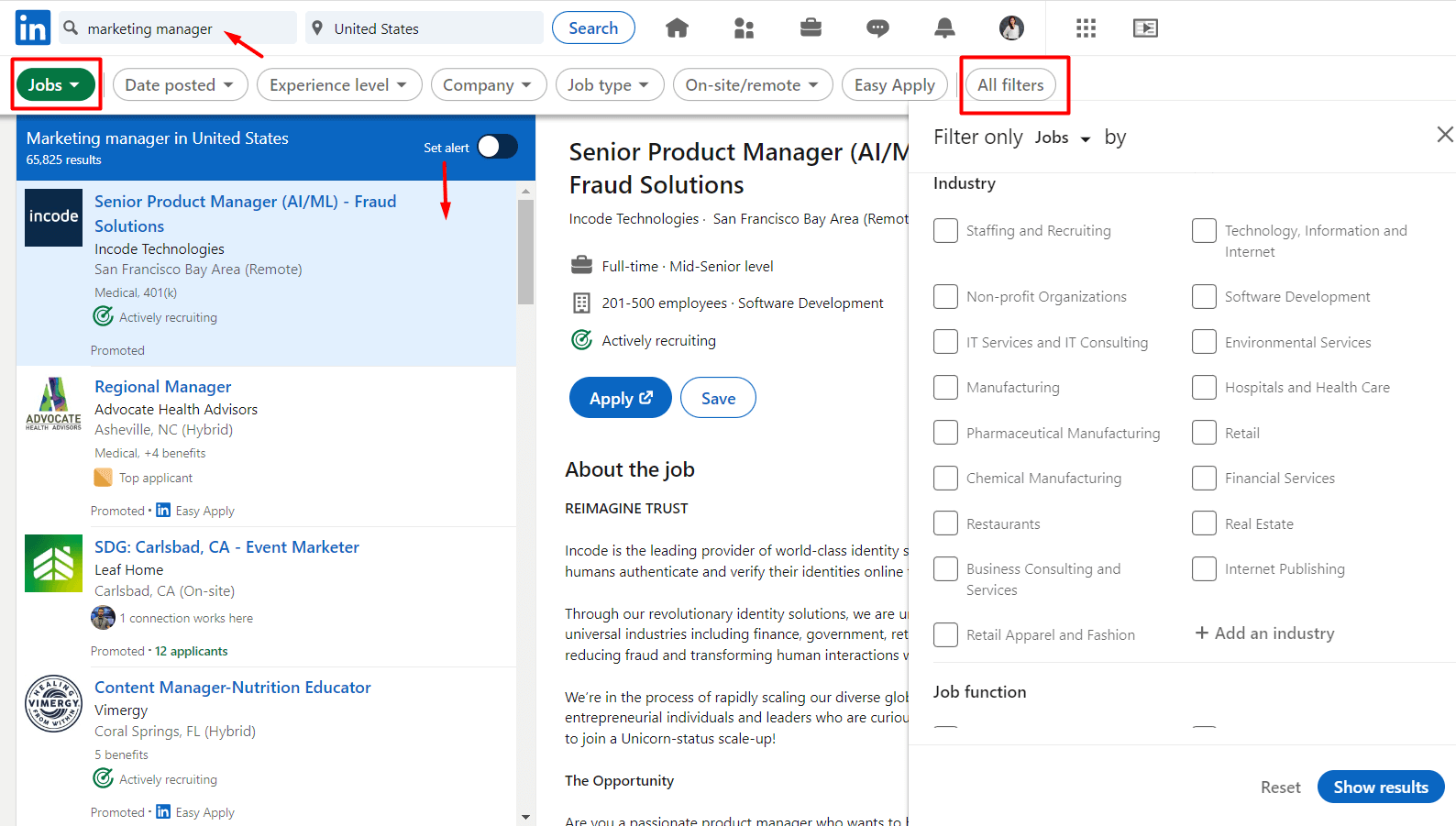
You can then reach out to the decision-makers in these companies by sending them a connection request such as this one:
Hey {{firstName}},
I noticed you are looking for a new {{Occupation}} in your company. Do you plan to change the workflow as well? If so, I have an idea that can help you improve your team's productivity and would like to connect with you.
Engage with people who reacted to a post
You don’t have to reach out only to the leads you found via LinkedIn search. If you find time, scroll through your feed or notifications and check reactions to posts. Then, whenever you see your potential lead engaging, take that opportunity to start the conversation. After all, this is one of the most natural ways to start building relationships with your network and leads.
Use AI to speed up your outreach processes
In just over a year, the integration of AI into our daily lives has transitioned from a futuristic concept to an integral part of our personal and professional routines.
When it comes to the LinkedIn outreach process, there are a few areas where you can use ChatGPT and AI-assisted tools to speed up processes. However, it is important to underline the importance of human intervention to make the AI-generated text sound as natural as possible and to adapt it to different leads and situations.
AI-assisted LinkedIn InMails
Due to their indisputable success rates, LinkedIn recognizes the importance of InMails and now offers AI-assisted InMail writing to its paying members.
All you need to do is open the InMail message window, click on the Write with AI button, and choose among the offered outreach scenarios.
You can ask AI to rewrite the message from scratch, or you can manually adjust some parts for greater impact.
Craft any message with AI-powered tools
In our recent blog post on how to use ChatGPT for sales we provided detailed information on how to create prompts and inputs for ChatGPT to create any type of LinkedIn outreach message. In addition to ChatGPT, other AI-powered writing tools such as Grammarly, ProWritingAid, and Clearscope, for example, are also gaining popularity for increasing writing quality, improving grammar and style, and optimizing content for SEO. These AI tools offer valuable assistance in proofreading, editing, and optimizing written content for various purposes.
Use AI-driven content to post on LinkedIn
By consistently sharing valuable and informative content, you can establish yourself as a thought leader in your field, foster meaningful connections, and attract potential leads who resonate with your expertise and insights.
However, as we all know, writing compelling social posts takes time. On top of that, if you want to give value to your audience, every now and then you must additionally research certain topics. This is where ChatGPT and other tools for AI-driven can help you significantly speed up these processes and help you drive engagement on the platform.
7 LinkedIn outreach rules you need to consider
1. Have an optimized profile before you start
Before using your LinkedIn account for cold outreach, you need to sort out your LinkedIn profile and optimize it. In other words, setting up your profile includes:
- Picking the best profile picture and cover photo;
- Creating a catchy LinkedIn headline;
- Write your detailed summary;
- Fill in the experience section.
If you do it thoroughly, people will be more prone to accept your connection request or respond to your InMail message.
2. Use safe automation tools
If you use some kind of LinkedIn automation tool, you should know that there are 3 different kinds:
- Chrome extension;
- Desktop apps and web browsers;
- And cloud-based solutions.
Chrome extensions are the least safe tool to use since they inject the code into the LinkedIn platform. This action sends LinkedIn an instant alert, and you risk getting your LinkedIn account restricted.
Desktop apps and web browsers are a bit safer. However, they don’t have a dedicated IP or the option to mimic human-like behavior. Moreover, you must have your PC turned on to keep your campaigns running.
Unlike other solutions, cloud-based LinkedIn automation tools are safer, as they do not inject the code into the LinkedIn platform. Moreover, you get a dedicated IP address that shields your activity, and they mimic human-like behavior making it impossible for LinkedIn to detect.
That said, choose carefully which LinkedIn automation tool you will use. For example, to keep your account safe and secure, we at Skylead have 3-layered protection for your LinkedIn account:
- Human-like behavior;
- Account warm-up;
- And action limits;
3. Think multichannel
Did you know that companies with omnichannel engagement strategies retain 89% of customers (invesp)? Then, don’t just stop at LinkedIn outreach; for the best results, include email outreach as well since it’s still an essential means of correspondence.
This way, you are showing your target audience that you care and that you are expanding your reach. What’s more, you increase the chances of getting a hold of your leads who are not active on LinkedIn. Or in case your lead leaves your invite pending for a long time.
4. Don’t be too salesy
Nowadays, LinkedIn prospecting and cold outreach can’t do anything if your approach is too salesly or spammy. In other words, don’t talk only about your company or a product. Instead, take a legitimate interest in your target audience, build the relationship first, and connect on a human level. It’s the only way without sounding too salesy and a part of the tremendous social selling. So always choose a more genuine approach to nurturing leads.
5. Provide value
Consistently provide value in the form of educational content or throughout the meeting. The pro tip here is to do it after you’ve asked your leads about their pain points. This way, you’re ensuring you are tailoring your value according to what they precisely need and want.
6. Follow up consistently
Leads often do not respond to your message, and it’s not always because they are not interested. Maybe they forgot or were busy at that time.
Suppose your prospect doesn’t respond to your LinkedIn outreach message or email. Send them a follow-up one. After all, if you do, you will increase your chances of receiving a response by 25% (invesp). So why waste it?
To help put your follow–up message together, check out our templates to send follow up emails after no response and get inspired.
7. Revoke old requests
One of the main rules people doing LinkedIn outreach stick by is canceling their LinkedIn invites.
There is a common fear that LinkedIn won’t allow you to send new requests if you accumulate unanswered ones. Unfortunately, the fear is legitimate, as quite a few people have experienced this restriction.
If the lead doesn’t answer the LinkedIn connection request or follow-ups in months, chances are they are not interested anyways. So be sure to lean up your LinkedIn invites regularly.
7 Best LinkedIn outreach templates [Our best picks]
Linkedin outreach message templates for sales
Sales outreach is about the initial impressions, so your first message should contain at least two of the points we mentioned in the last step of LinkedIn outreach. That said, here are a couple of templates that demonstrate those exact points.
Acceptance rate: 34%
Reply rate: 17%
Template
Hey {{firstName}},
I came across your LinkedIn profile and was so inspired by your background in {{industry}} and your passion for {{workAreaOfInterest}}. I’d like to connect and exchange ideas in both areas.
LinkedIn connection request example
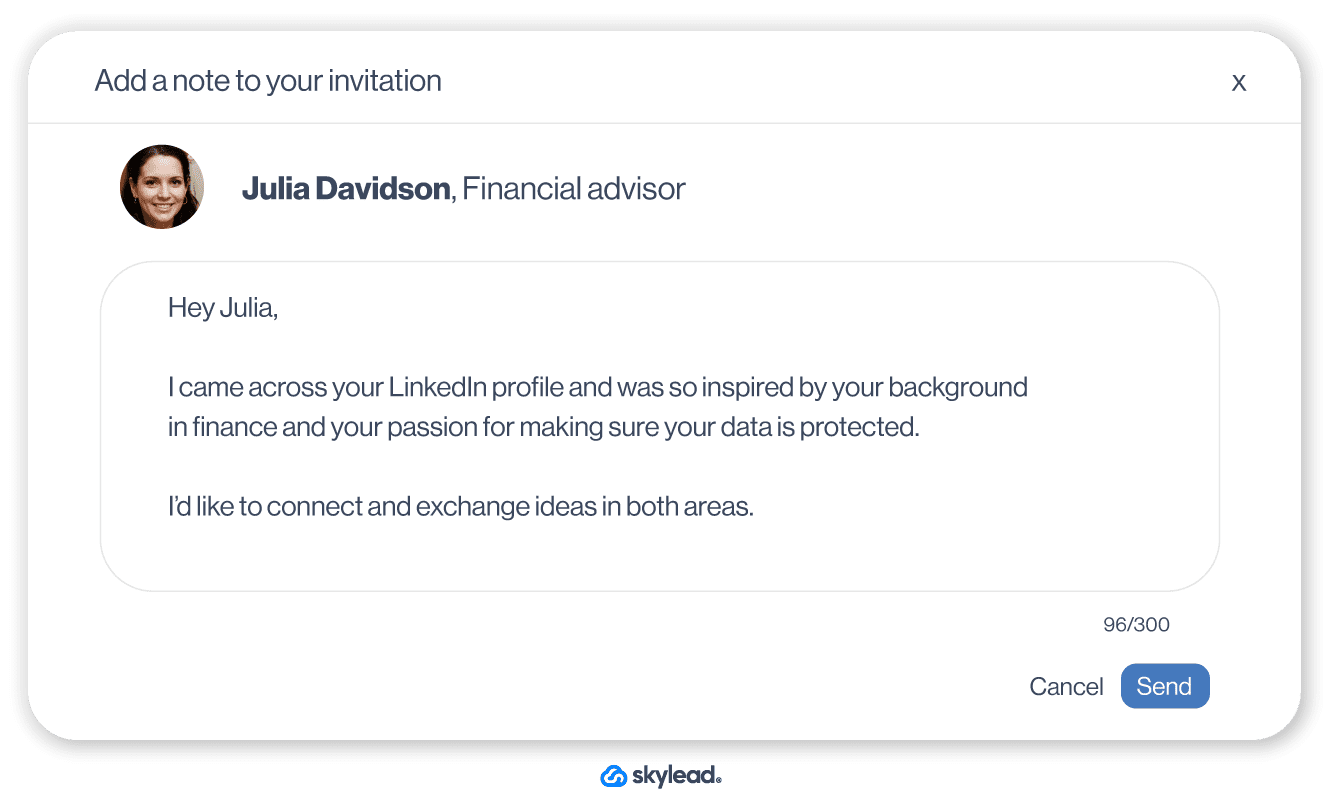
Bonus points if you can reference mutual connection. And if you feel like being humorous, you can spice up your invite with an industry-related joke, such as this one.
Acceptance rate: 53%
Reply rate 27%
Template
How many {{leadPositionTitle}} does it take to screw in a light bulb? None – they’ve automated it. 🙂 Just kidding, {{firstName}}.
But if you really wish to automate almost every part of your {{leadSectorName}} workflow, let’s chat. I’d like to show you something that would make your life easier. Let’s connect.
LinkedIn connection request example
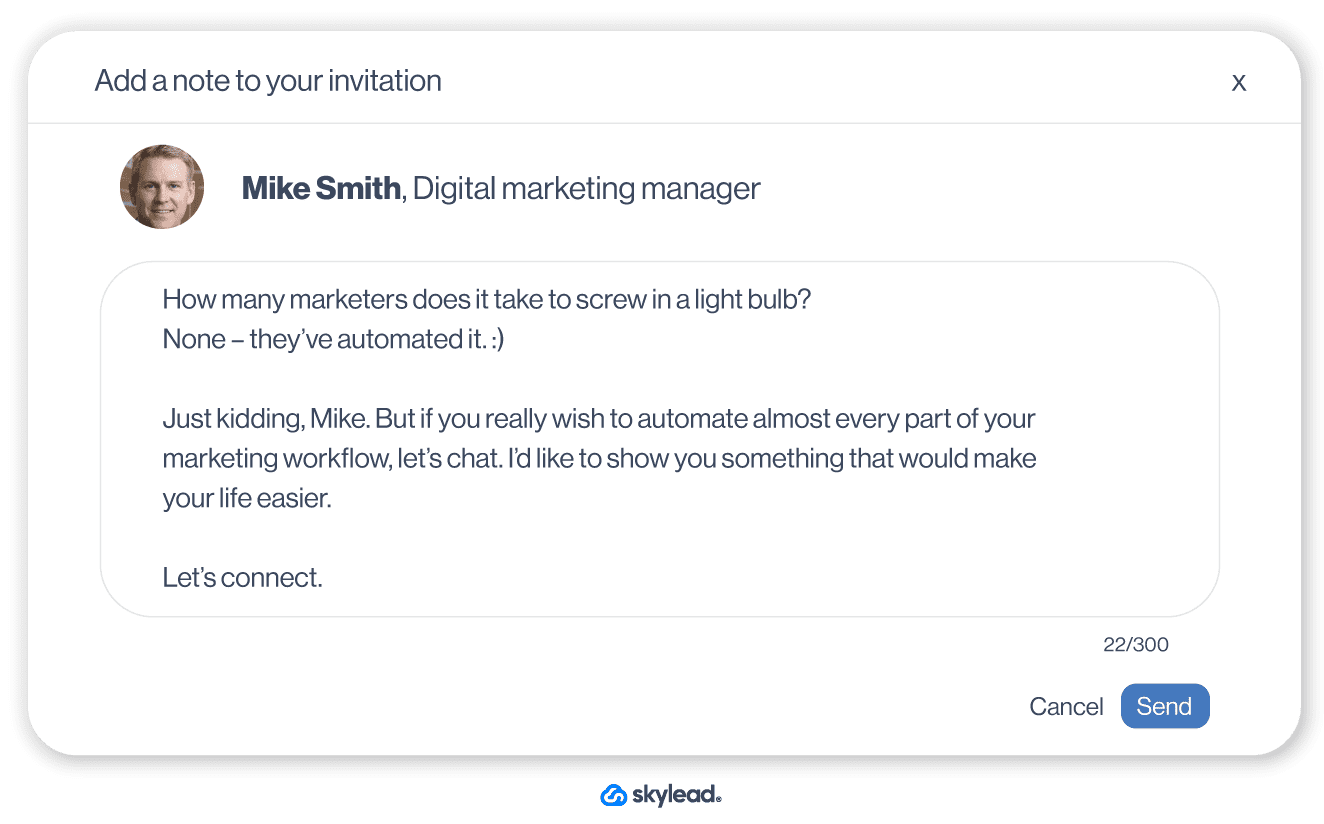
However, if all fall short and your lead doesn’t accept your invite, you can always send a LinkedIn InMail such as this one:
Acceptance rate: 43%
Reply rate: 23%
Template
Subject line: There is a key to solving {{painPoint}}
InMail message:
Hey {{firstName}},
My name is {{yourName}}, and I tried reaching out and connecting via LinkedIn invite. It appears that we didn’t get the chance to connect.
I was very much impressed with your LinkedIn profile. So, I believe your experience and dedication to {{workAreaOfInterest}} make you the perfect person to introduce you to our groundbreaking {{toolSpecification}} tool {{yourSoftwareName}}.
Our tool is created by {{leadPositionTitle}} for {{leadPositionTitle}} and it helps you:
1# {{Benefit }}
2# {{Benefit}}
3# {{Benefit}}
4# {{Benefit}}
I'd love to offer a personalized demo, so you can see hands-on how it works. Let me know if you're up for it, and we'll schedule a 15-minute call asap.
Best, {{yourName}}
InMail example
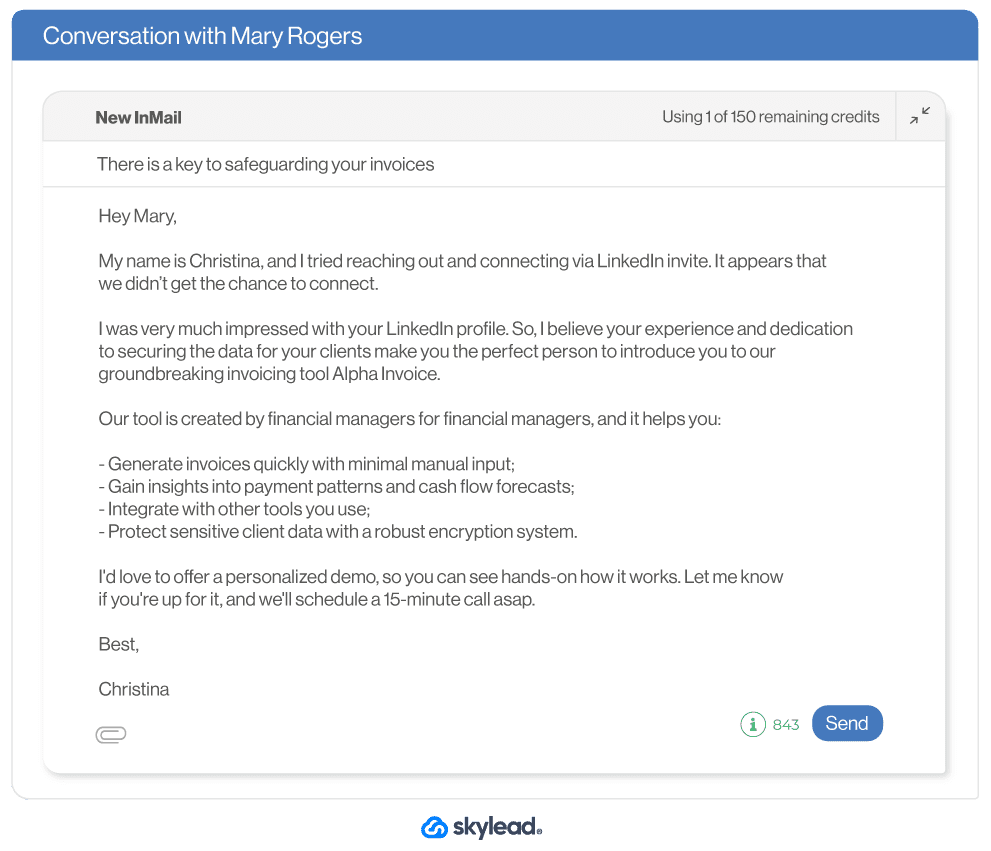
LinkedIn outreach message templates for recruiters
For example, let’s say you wish to reach out to your perfect candidate for the job in your company. Your LinkedIn connection request can sound like this:
Template
Hey {{firstName}},
My name is {{yourName}}, and we’re currently seeking a {{Occupation}}, and I truly believe that this role offers you a platform to leverage your skills and make a significant impact at our company. I’d be happy to share more details about the role and benefits we offer.
LinkedIn connection request example
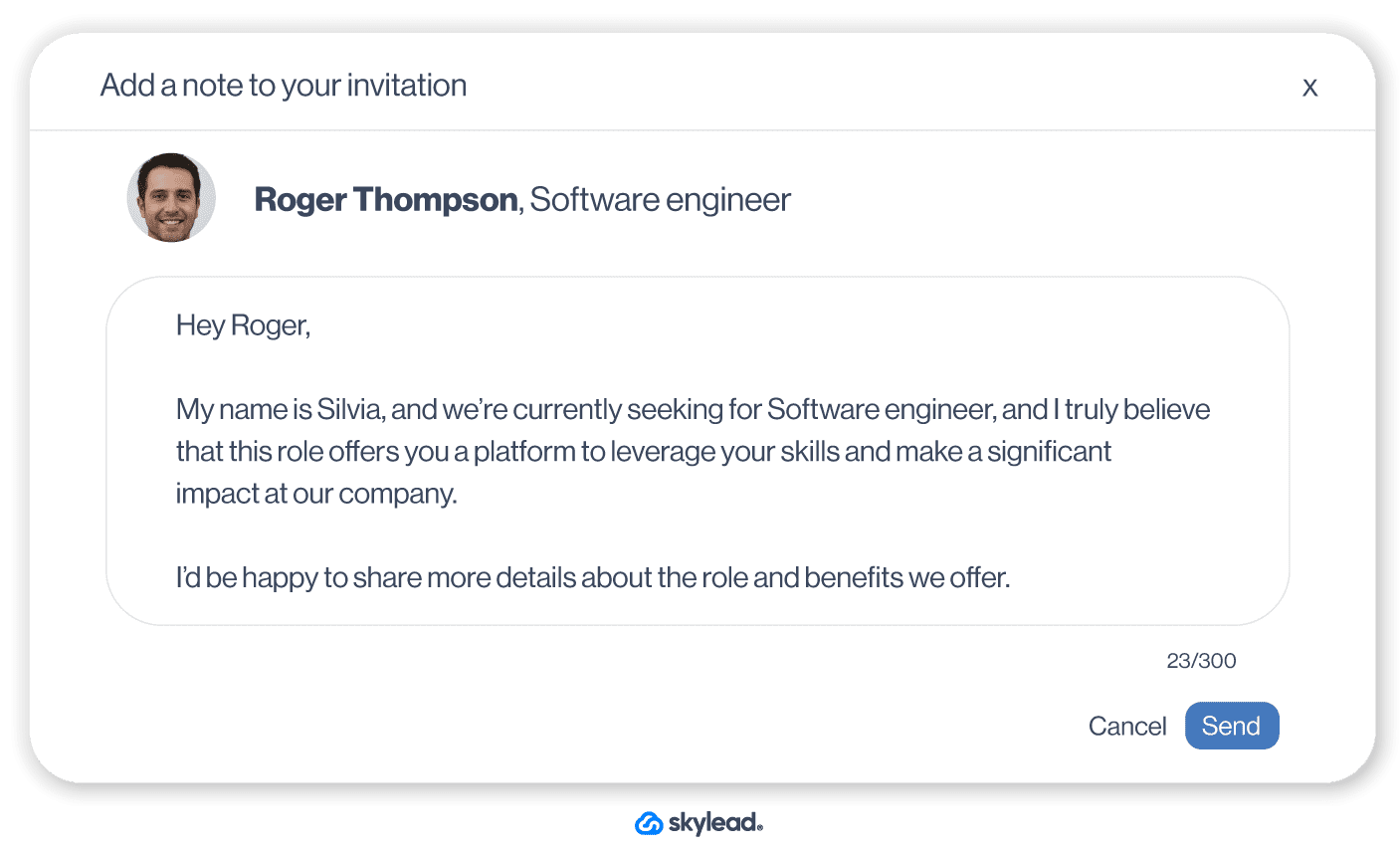
If, however, your ideal candidate doesn’t reply, use InMail format to land straight in their inbox.
Template
Acceptance rate 79%
Reply rate 46%
Subject line: Exciting job opportunity at {{yourCompanyName}}
InMail message:
Hey {{firstName}},
I understand that you may not be actively seeking new opportunities at this time. Still, I truly believe that this role provides you with a platform to leverage your {{Occupation}} skills and make a significant impact at {{yourCompanyName}}.
{{yourCompanyName}} is a {{shortDescription}}, where we take care of our employees and offer the very best, including:
1# {{Benefit 1}}
2# {{Benefit 2}}
3#{{Benefit 3}}
If this opportunity piques your interest, I would be happy to share more details about the role over the call. So let me know, and we can schedule an initial meeting at your earliest convenience.
I hope to hear from you soon.
Warm regards, {{yourName}}
InMail example
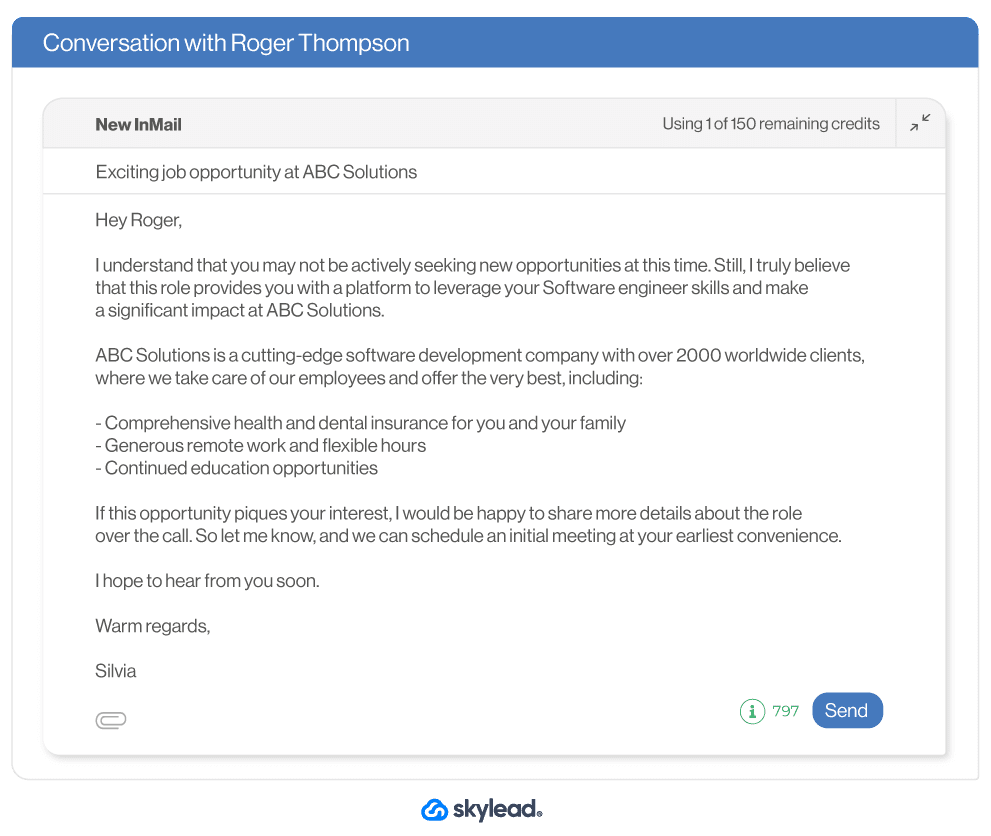
LinkedIn outreach message template for job search
We’ve all been there at one point - reaching out to companies and trying to get ahold of recruiters. Thankfully, you don’t need to search for their email addresses, as LinkedIn allows you to contact a recruiter from your ideal company directly. However, if you really wish to catch their attention, use this connection message template.
Acceptance rate: 67%
Reply rate: 32%
Template
Hello {{firstName}},
I have been following {{companyName}} and I’m impressed by your values, and dedication to innovation. As a skilled {{Occupation}} and enthusiast for {{companyIndustry}} I believe your company could benefit from my background. Let’s meet each other and talk about it.
LinkedIn connection request example
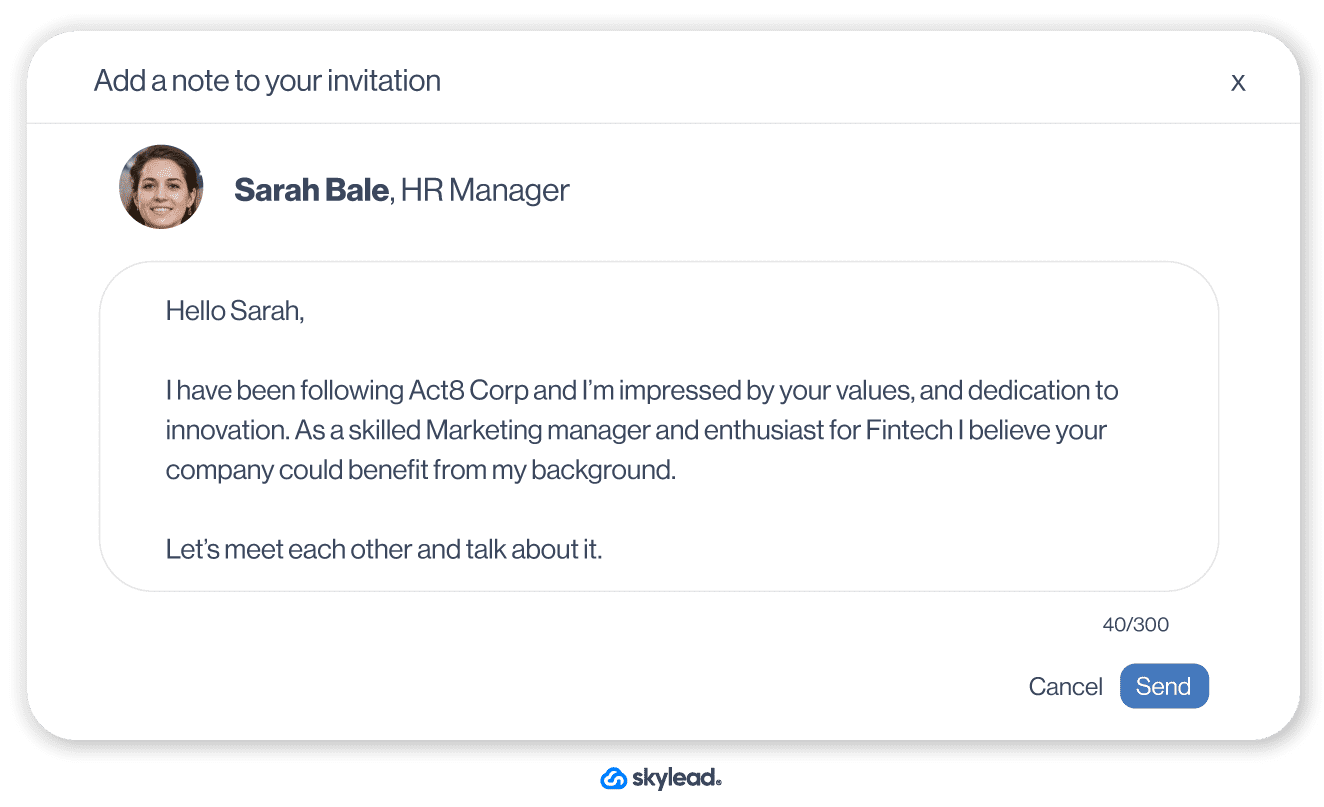
Moreover, if you have a LinkedIn Premium account, even better. You could send them an InMail that looks like this:
Template
Subject line: Proactive and passionate {{Occupation}} ready to make a difference at {{companyName}}
InMail message:
Hey {{firstName}},
My name is {{yourName}}, and I am a skilled {{Occupation}} with extensive experience in {{companyIndustry}}. I have been following {{companyName}} for some time now, and I am incredibly impressed by your {{Achievement}}, values, and dedication to innovation.
As someone really passionate about {{companyIndustry}}, I believe my background and skill set make me an ideal candidate to contribute to your team’s ongoing success.
I have achieved {{specificAccomplishmentOrResult}}, which has led me to {{quantifiable outcome}}. In addition, my expertise in {{specificSkill}} has allowed me to make a significant impact on my team’s performance and overall business growth.
I am excited about the prospect of bringing my skills and enthusiasm to {{companyName}}. I have attached my resume for your review and would be grateful for the opportunity to speak with you about how I could contribute to your team.
If there are any open positions or upcoming opportunities that align with my background, I would appreciate your consideration.
Thank you for taking the time to read my message, and I look forward to hearing from you.
Best, {{yourName}}
InMail example

LinkedIn outreach stats
1. Users who have 70+ SSI have 45% more opportunities and are 51% more likely to hit sales targets. Moreover, it will grant you 20% more reach. (Tribal impact)
2. LinkedIn is 277% more effective for lead generation, far more than platforms like Facebook and Twitter. (HubSpot)
3. 92% of potential clients are willing to engage with an industry thought leader, making the thought leadership LinkedIn lead generation strategy very effective (CH Consulting Group).
4. Marketing managers experience up to 2 times higher conversion rates on LinkedIn. (LinkedIn)
5. Sending a personalized InMail will increase your response rate by up to 30%. (LinkedIn)
6. Lead conversion rates on LinkedIn are 3x higher than other ad platforms. (LinkedIn)
7. Audiences exposed to brand and acquisition messages on LinkedIn are 6x more likely to convert. (LinkedIn)
Frequently asked questions about Linkedin outreach
Those were some fascinating stats, ha? 🙂 Before we conclude this blog, let’s answer some frequently asked questions about the topics we didn’t get the chance to mention above.
Is prospecting on LinkedIn worth it?
Yes. LinkedIn prospecting helps you find your ICP and Buyer Persona with filtering options such as company size or industry. Moreover, the lead’s LinkedIn profile usually contains publicly available contact information, such as phone numbers or email addresses, that you can use to contact your leads outside LinkedIn.
What is the success rate of LinkedIn outreach?
LinkedIn outreach success rate depends on your goal and personalization level, but it’s usually high overall. For example, one of our sales team’s campaigns has the following result: out of 2782 connections sent, they experienced a 33% acceptance rate and 17% response. In some cases, the results go even higher.
What is a respectable number of LinkedIn connections?
You can have up to 30,000 connections, but the respected number depends on what you want to achieve. For example, for salespeople and recruiters, it’s essential to connect with as many people as possible to expand their network, thus reaching people outside of it and getting more leads.
Is it better to have followers or connections on LinkedIn?
Followers and connections are equally important, so it depends on your goals. For example, if you are a LinkedIn marketer and wish to focus on sharing content, gaining followers might be better for you. However, salespeople benefit better from the connections, as building relationships is the basis for successful selling.
Ready for LinkedIn outreach?
That’s a wrap-up for LinkedIn lead generation! This has been a wild ride.
Naturally, you can’t memorize everything from this article. Therefore, make sure to bookmark it, so you can return to it and remind yourself about best practices for LinkedIn lead generation.
And if you’re looking for a way to turn time-consuming LinkedIn outreach aspects into simple, straightforward tasks, try Skylead for 7 days for free, and experience firsthand how fast you can scale your business!

Getting accepted on LinkedIn sometimes seems like a mission impossible, but what about starting a sales-oriented conversation with a complete stranger? What kind of a LinkedIn Message Template should be used so you don’t come off as too mild, too aggressive, but, the way Goldilocks likes it - just right.
We’ve been there and know how hard it can be to scale up your business. That’s why we’ve decided to speak about what happens after your LinkedIn Connection Message goes through. That is, how to approach your lead in a way to get more sales.
Of course, no recipe works for everyone and on everyone, but there are some common ground rules that you can follow when sending cold messages on LinkedIn to get more sales.
In this blog, we’ll cover:
- What to do before starting your cold LinkedIn outreach;
- Dos and don’ts for LinkedIn Messages if you wish to get more sales;
- 10 sets of LinkedIn Message Templates for 10 different LinkedIn scenarios;
- A breakdown of each set of LinkedIn Message Templates in case you want/need to adjust them to your business needs.
Cold LinkedIn messages won’t get you sales unless . . .
You fully optimize your LinkedIn profile.
We cannot stress enough the importance of an optimized LinkedIn profile. Whether going for a LinkedIn outreach, a cold emailing, or a multichannel approach, nowadays, the first thing anyone does is check your and your company’s profile on LinkedIn.
Your LinkedIn profile is your online business card, available to anyone at any moment. Make sure it looks neat and professional.
As the bare minimum, you must:
- Write a catchy LinkedIn headline that describes exactly what your job consists of. Imagine how you would describe what you do for a living, in one sentence, to someone who knows nothing about it. That’s your headline.
- Put a professional profile picture. Long story short, put a photo that you wouldn't be ashamed to show to your boss or your biggest client.
- Upload a cover photo that portrays what you do or what your business is all about.
- A LinkedIn summary is all about your professional highlights and keywords you would want to be associated with.
- List relevant professional experience.
- Tell us what you studied.
You define your ICP.
Not defining your ICP equals gambling with your money, resources, and time.
And just like with casinos, the statistical probability is against you.
The house always wins, so don’t put it all on red. You’ll end up being in the red.
Catastrophic predictions apart, for getting more sales you need to define the companies that match your Ideal Customer Profile.
Now, how do you define your ICP?
- Take into consideration both your target industry and sub-industry.
- Understand the location of your ICPs.
- Take into consideration the revenue that your best customers bring to your business.
- Highlight your top 5 current customers that you’d like to replicate if you could and outline their positives and negatives.
If you need more details on how to define your ICPs, the difference between ICP and Buyer Persona, and downloadable ready-to-use templates for defining both check out 4 Easy Steps To Create ICP For Lead Generation and 6 Key Steps To Create Buyer Persona For Lead Generation.
You target what you’ve defined.
Since you’ve spent your time defining the ICP and the Buyer Persona within, and your money on Sales Navigator, you better use them to their full potential.
With 29 Sales Navigator Lead Filters and 15 Sales Navigator Account Filters, the possibilities for quality targeting are endless.
Whether a LinkedIn lead generation expert or a newbie to this process, having a deep knowledge of the tools at your disposal is the first step toward successful prospecting on LinkedIn. And, if you “have the moves” and know how to:
- Use the Spotlights filter;
- Apply Boolean search;
- Exclude leads from your search;
- Create a Leads List;
- Use Alerts;
- Take advantage of the View Similar option;
- Filter leads through Account Lists/Lead Lists filters
... the sky is your limit!
For detailed instructions (and more) check out:
- Complete guide to Sales Navigator Lead Filters;
- Top hacks to Find Leads on LinkedIn .
How long should a LinkedIn message be?
LinkedIn gives you up to 300 characters for your LinkedIn Connection Request Message.
On the other hand, the LinkedIn InMail character limit is:
- Subject line: 200 characters
- InMail body: 2000 characters
- Signature: 150 characters
A regular LinkedIn Message that you can send only to your 1st-degree connections and to members of the same LinkedIn Group, only in case you are a member too, has an 8000-character limit.
However, there is no need to use them all. When writing any of these, keep in mind that you have only few seconds to catch your prospect’s attention. Furthermore, no one wants to read a novel in their Inbox.
In your LinkedIn Message make sure that you:
- Hook them in the Intro to read more;
- Keep them interested throughout the message to continue reading;
- Make them wish to ask questions and want to hear more.
LinkedIn claims that messages up to 600 characters are 50% more likely to get a response. Also, remember to fit the catchy information at the beginning as this is what recipients see in their Inbox preview.
How to cold message on LinkedIn: Dos & don’ts
DOS
- Find something that you have in common with the lead that you are talking to. Your conversation-starter LinkedIn Message should have a solid personalized hook or a good joke (‘cause, why not? Everyone likes to laugh), so you can justify further conversation, in case you didn’t put one in your Connection Request Message.
- Ask questions - but gradually. No one will tell you the main problem of their company straight out the gate, but once they feel that you genuinely care and that you might have a solution to their problem, they will open up.
- Be prospect-oriented. Everything you say must serve the prospect and their business. No one cares what worked for you.
DON’TS
- Don’t sell in your Connection Request Message or the first LinkedIn Message.
- Don’t use the same pitch on everyone. It might seem a bit time-consuming to come up with a different LinkedIn Message copy for each lead (or group of leads), but trust us, it’s worth your time. Plus, you’ll have LinkedIn Message Templates for getting more sales down below that you can use right away or adjust to your needs if necessary.
- Don’t talk about yourself right away. Your lead will for sure check the LinkedIn profile of you and your company, so make sure it sells for you. It is fine to include a brief explanation of who you are and what your company does, but don’t use all the available characters of the LinkedIn Message for it.
10 LinkedIn message templates for 10 LinkedIn scenarios
We’ve listed for you 10 ideas of how to approach your leads and get more sales based on different business goals and LinkedIn scenarios.
Scenario #1: Express interest in your lead’s work to form a partnership
Connection request template
Hello {{firstName}},
I saw on your profile that you’re associated with the {{industry}} industry.
I work in {{yourIndustry}} and would love to connect with you!

LinkedIn message template #1
Thanks for connecting!
I don’t know if you’ve heard the news, but {{yourCompany}} has {{customizedSellingPoint}}/{{uniqueSellingPoint}}.
You can check it out in more detail on our website {{link}}.
I believe that {{currentCompany}} could benefit from it!
Let me know what you think!
{{personalizedGIF}}
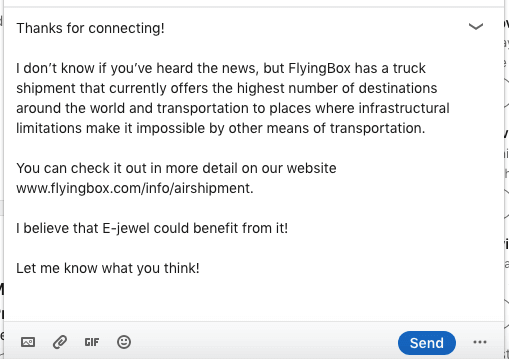
Personalized GIF
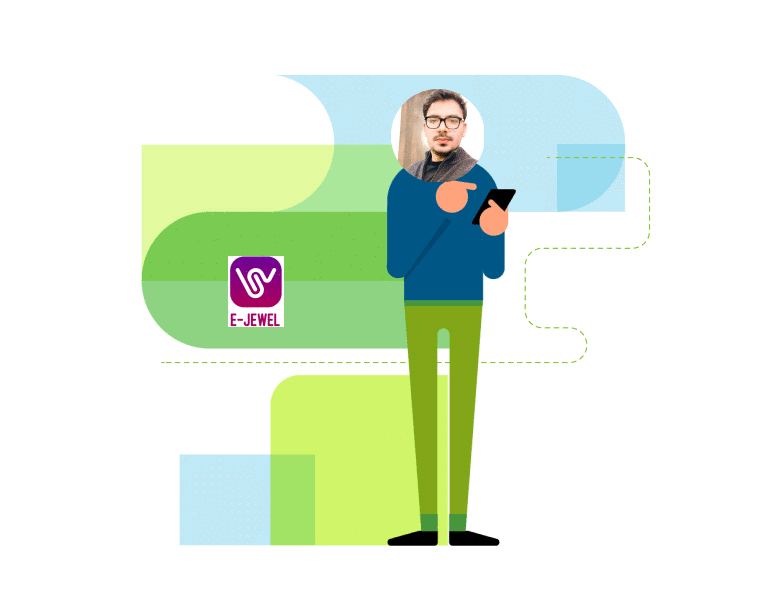
These templates work because you’ve:
- Inserted a hyper-personalized GIF referencing the lead you are talking to and their company;
- Shown that you’ve done your research by referencing to the lead’s occupation/company/industry;
- Offered a solution to their problem or some kind of service that their industry can majorly benefit from.
Scenario #2: Investigate your lead’s current solution to pitch your product/service
Connection request template
Hi {{firstName}},
What is the hardest part of being a product manager?
Explaining what you do to your parents and friends.
Jokes apart, I would love to connect!
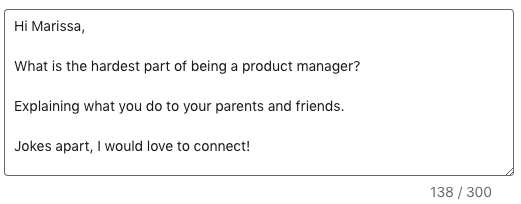
LinkedIn message template #1
Hey {{firstName}},
Thank you for accepting my Connection Request.
I saw that you are {{occupation}} at {{currentCompany}}, so I decided to reach out.
I was curious to know if you and your team are using any customer survey tools? If yes, which one, if you wouldn’t mind sharing that info?
Thanks,
John
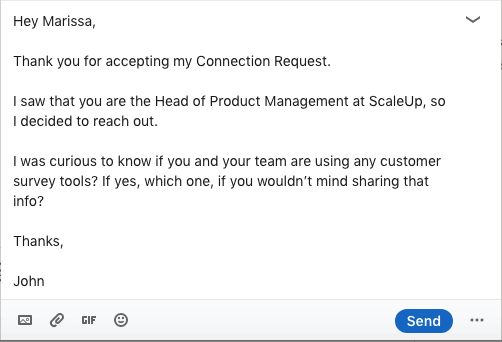
LinkedIn message template #2
The reason for my outreach was to introduce {{descriptionOfSolution}}.
Briefly, {{uniqueSellingPoints}}.
How does that sound?
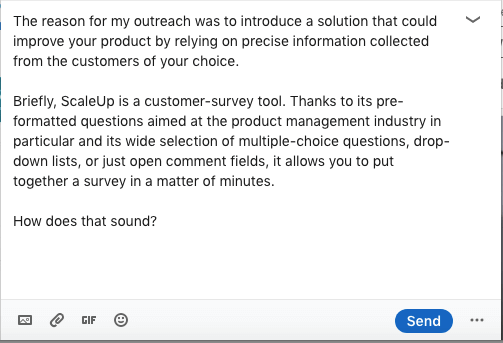
These templates work because you’ve:
- Used humor in your outreach, which is always a good choice;
- Shown that you’ve done your research by referring to the lead’s occupation and/or company that they work at;
- Asked questions to get to know their current solutions/problems/needs/rooms for improvement;
- Given a brief explanation of what you offer to hook them and make them want to hear more about it.
Scenario #3: Content distribution and promotion
Connection request template
Hey {{FirstName}},
I came across your profile and was really interested in your background as a {{occupation}} at {{currentCompany}}. I share a lot of content about the {{industry}} industry that could be useful to you.
Looking forward to connecting with you!
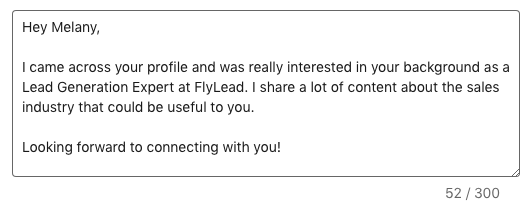
LinkedIn message template #1
Thank you for adding me to your network.
I thought that this blog {{nameOfblog}} might be particularly useful for you {{link}}.
Check it out and let me know if you have some comments and suggestions!
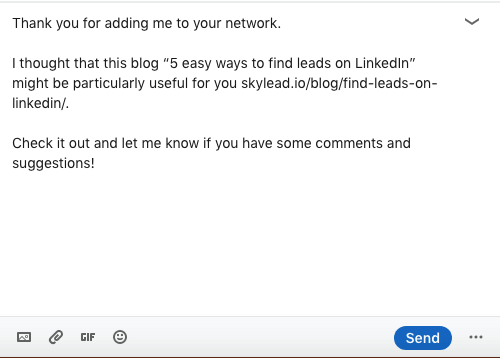
These templates work because you’ve:
- Shown that you’ve done your research by referring to the lead’s occupation/company/industry;
- Offered a resource that the lead’s industry/company can benefit from.
Scenario #4: Reach out to people who attended your event
Connection request template
Hey {{firstName}},
Thank you for attending my webinar {{webinar’sName}}!
I would like to keep in touch.
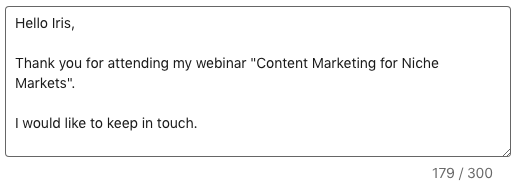
LinkedIn message template #1
Thank you for adding me to your network!
Quick question - {{question}}.
{{personalizedImage}}
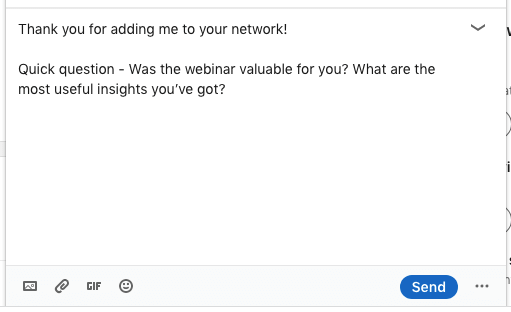
Personalized image
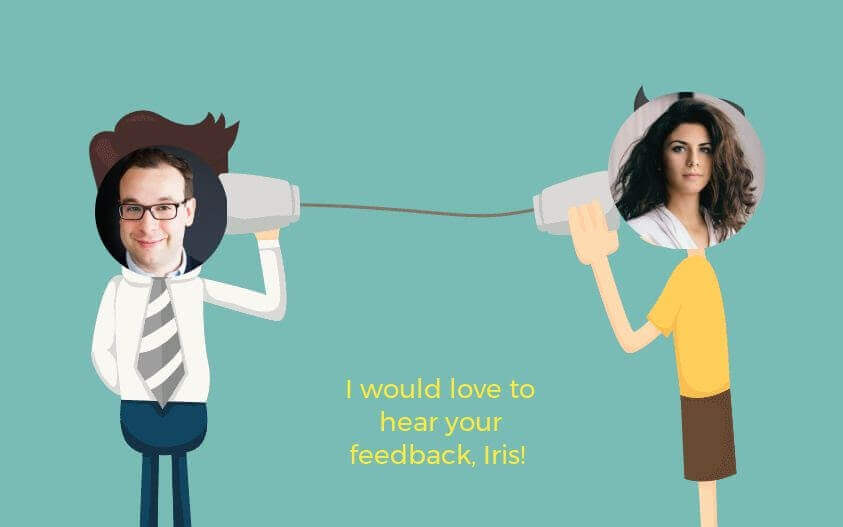
LinkedIn message template #2
Thank you so much for sharing your feedback!
I also took some time to research your company {{currentCompany}} and wanted to share with you some resources that might help you with {{problem}}/{{roomForImprovement}}.
Here’s a link to it - {{link}}
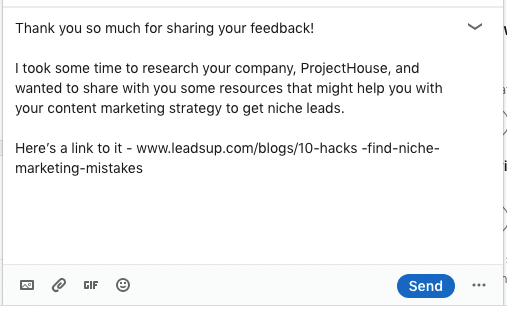
LinkedIn message template #3
Hey {{firstName}},
I hope that you liked the blog I’ve sent.
If you would like to know more about it and you found that resource valuable, there’s plenty where that came from!
Let me know if you would be interested in {{service/product}}, I would be glad to help!
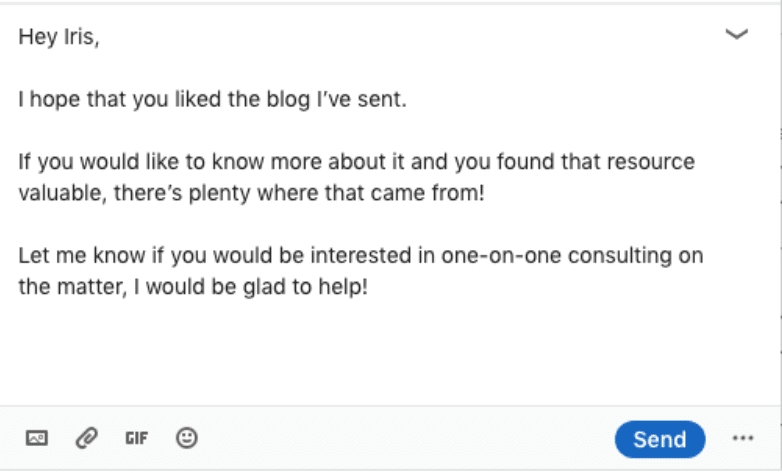
These templates work because you’ve:
- Taken some time to find the lead that attended your event and thank them for it;
- Asked for genuine feedback to connect with your lead and create trust between the two;
- Put in extra effort to make a hyper-personalized Image to ask for feedback;
- Offered to give more resources to help the lead with a particular matter;
- Shared a free gift.
Scenario #5: Invite relevant leads to join your community
Connection request template
Hello {{firstName}},
I saw the post that you shared about {{topic}} and I really like the part where {{thePartYouLiked}} / {{postParagraph}}.
Would love to connect!

LinkedIn message template #1
Thank you for accepting my Connection Request.
I saw that you are {{occupation}} at {{currentCompany}}. That’s so interesting! I actually have this community dedicated to the {{industry}} industry and I wanted to invite you to join!
We discuss {{mainTopics}}
Here’s the link - {{link}}
Wе would love to have you!
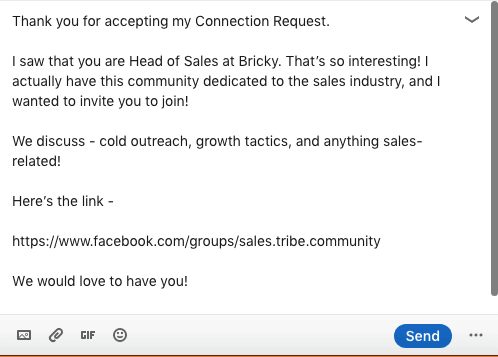
These templates work because you’ve:
- Referred to a post that a lead shared on LinkedIn and highlighted a part that particularly resonated with you;
- Shown that you’ve done your research by referring to the lead’s occupation/company/industry;
- Invited the lead in a non-intrusive way to join by sharing a link (no spamming);
- Told the lead what to expect from the community and showed that they have value from joining.
Scenario #6: Invite a speaker/lecturer to your event
Connection request template
Hello {{firstName}},
I loved your article {{title}} on {{website}}.
Anyways, I am truly an admirer of your work and would love to connect!
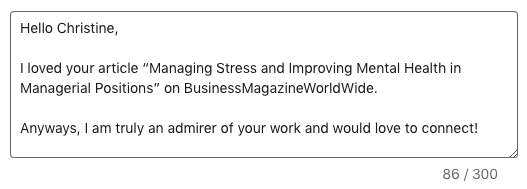
LinkedIn message template #1
Thank you for adding me to your network!
As mentioned before, your article really meant a lot to me {{reason}}.
Actually, I am organizing a seminar on an adjacent topic {{topic}} aimed at {{occupation}}. I would love to have you as a guest speaker.
Let’s hop on a call and discuss it further one day this week. What do you think?

These templates work because you’ve:
- Shown that you’ve done your research and that you know their work by referencing something specific;
- Shown admiration for their work. Everyone likes compliments;
- Shared how their work helped you. Everyone likes to know that what they do is helpful to others.
Scenario #7: Connect over a mutual friend to pitch a product/service
Connection request template
Hello {{firstName}},
I noticed that we’re both connected with {{mutualConnection}}. I worked with {{MutualConnection’sName}} at {{company}}/{{project}}, so I thought it would be nice to get in touch with you!
How do you know {{MutualConnection’sName}}?

LinkedIn message template #1
Hey {{firstName}},
Glad to connect!
Anyways, I saw that you work as a {{title}} at {{company}}. I have a question if you don’t mind me asking. {{question}}
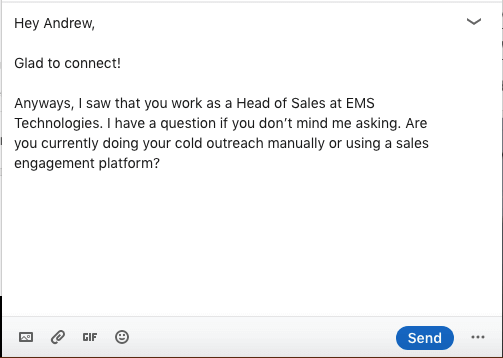
LinkedIn message template #2
The reason I asked is that we have a new tool that {{benefit}}.
If this is something that your business needs, I would be glad to hop on a quick call and give you some details.
No strings attached. Let me know!
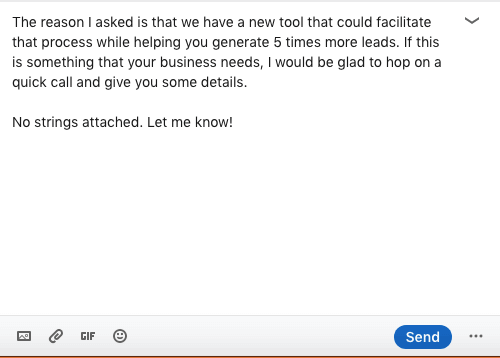
LinkedIn message template #3
Hi {{firstName}},
You are probably very busy, so I just wanted to check in with you one last time and see if you saw my last message.
I would like to tell you how to {{uniqueSellingPoint}}:
{{sellingPoints}}
You can see more details here - {{websiteLink}}
Can you take a call {{time}} to discuss it further?
No pushy sales manipulation, I promise.
I hope to hear back from you!
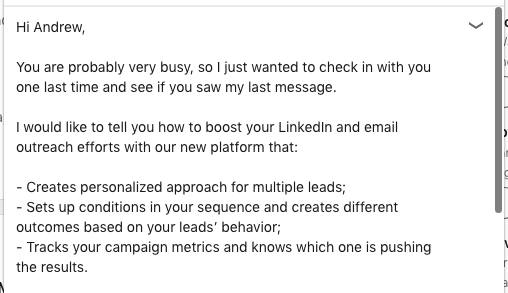
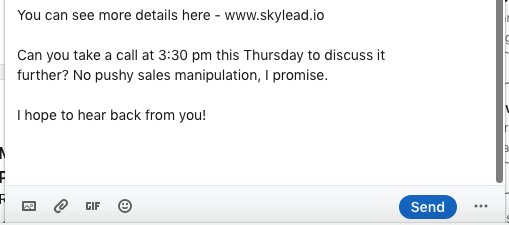
These templates work because you’ve:
- Shown that you have a mutual connection. People like to work with someone who is reliable;
- Researched who they are and what they do in particular;
- Asked questions to create a deeper bond and to understand your lead’s needs/problems/rooms for improvement;
- Tried to create a hook once more by listing the unique selling points of your product/service.
Scenario #8: Recruit the perfect candidate for your business
Connection request template
Hello {{firstName}},
I am a recruiter at {{company}} and I came across your profile.
I would like to talk about a newly-opened position at {{company}} for which I found you to be a perfect fit.
Let’s connect!
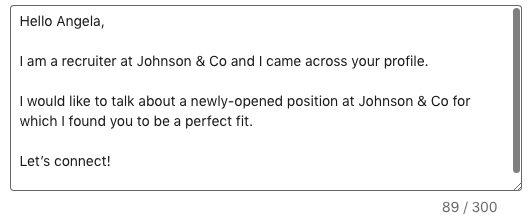
LinkedIn message template #1
Thank you for accepting my Connection Request.
As I was saying, I came across your profile and you seem to be exactly the person that we seek - {{background}}/{{skills}}.
{{yourCompany}} is currently seeking a {{position}} with your skillset to carry out a series of tasks I would like to further discuss with you, in case this sounds interesting.
What do you say?

These templates work because you’ve:
- Shown that you’ve done your research and know your lead’s professional experience;
- Highlighted a particular skill set that your lead has and that is relevant to the position that you’re offering.
Scenario #9: Target leads who attended the same LinkedIn event as you did
Connection request template
Hello {{firstName}},
I saw that you too attended the {{eventName}} event!
I found {{topic}} particularly useful! How about you?
Let’s connect!
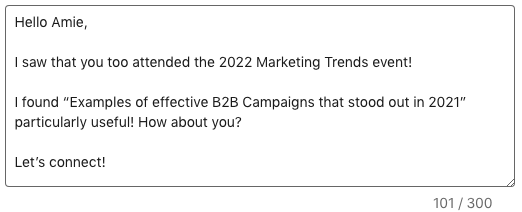
LinkedIn message template #1
Thank you for adding me to your network!
I saw that you are {{title}} at {{company}}. I help {{niche}} companies generate more leads through deep personalization on LinkedIn.
Let’s jump on a Zoom call sometime this week?
{{personalizedImage}}
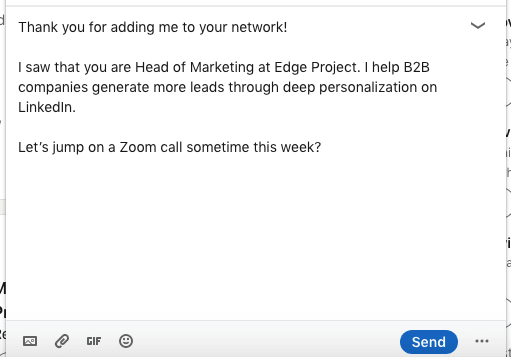
Personalized image
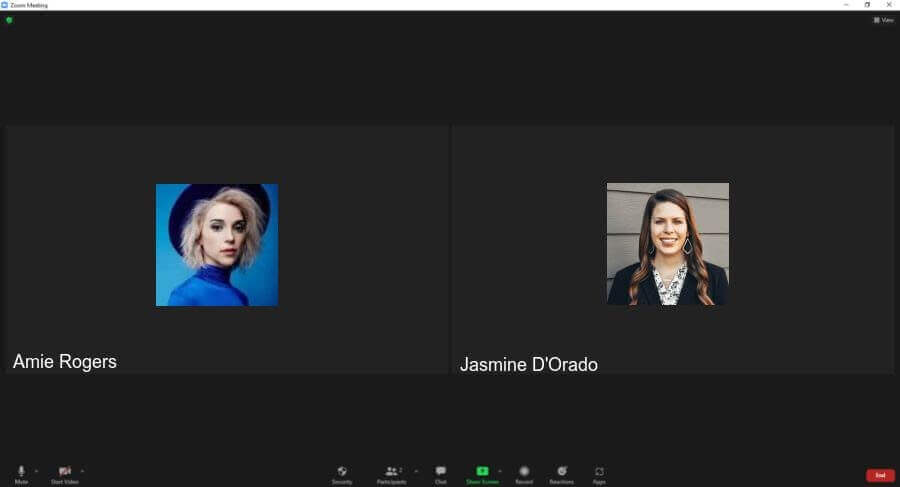
These templates work because you’ve:
- Referred to an event that both you and the lead attended;
- Referenced something specific from the event;
- Done your research and referenced your lead’s title/company/industry;
- Done extra work to hyper-personalize an Image by making a direct reference to your lead, yourself, and a call-to-action (zoom call).
Scenario #10: Reach out to a lead who asked a question in a post comment
Connection request template
Hey {{firstName}},
I found the question that you asked in {{author’sName}} post on LinkedIn very interesting!
I would love to suggest several resources that could help you solve that issue.
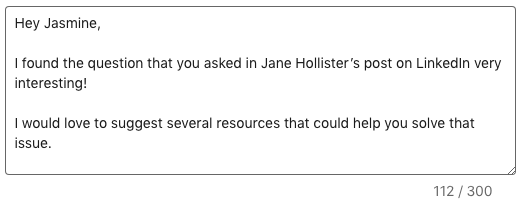
LinkedIn message template #1
Thank you for accepting my Connection Request.
You asked {{question}}. Have you ever heard of {{product}}/{{service}}?
I would love to hop on a call with you and explain why I find it to be a good solution to what you need right now.
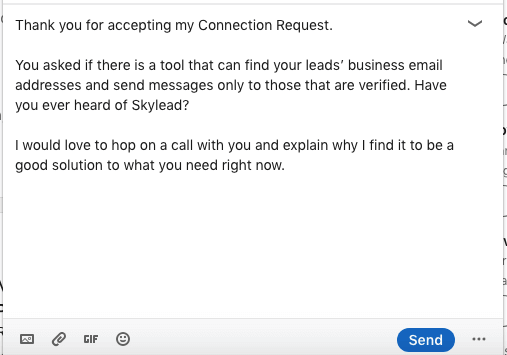
These templates work because you’ve:
- Reference a specific question that a lead asked in a comment to someone’s post;
- Offered a potential solution/resource to solve their problem.
Frequently asked questions
How do response rates for these templates vary by industry or job role, and are there adaptations recommended for specific sectors?
Response rates to LinkedIn sales message templates can vary significantly by industry and job role. It's beneficial to customize these templates and their follow-ups to align with the specific language, challenges, and goals of your target sector to increase their effectiveness and engagement.
What follow-up strategies should be employed if there is no response to the initial LinkedIn sales message, and how soon should one follow up?
If there's no response to an initial LinkedIn sales message, a best practice is to wait for a week or two before following up. The follow-up after no response should add value proposition, perhaps by sharing relevant content or insights, and express genuine interest in helping the recipient.
Are there any data or case studies on the long-term effectiveness of these strategies in building lasting business relationships or closing sales?
While we didn’t mention case studies on the long-term effectiveness of LinkedIn sales strategies, we used these messages in our outreach templates library, so you can check them out and see the measurable results for each sequence. Generally, consistency, personalization, and providing value are critical factors in building lasting business relationships and achieving sales success.
To sum up
The hardest part on LinkedIn is getting your lead’s attention. Despite the fact that having your Connection Request accepted represents a small victory, bigger “battles” are about to happen. LinkedIn members are being bombarded with so many messages and sales offers, that the majority of them don’t even bother reading them, let alone answering.
That’s why we’ve listed 10 LinkedIn Message Templates for different business scenarios that can help you attract that “ideal” lead’s attention.
- Express interest in your lead’s work to form a partnership;
- Investigate your lead’s current solution to pitch your product/service;
- Content distribution and promotion;
- Reach out to people who attended your event;
- Invite relevant leads to join your community;
- Invite a speaker/lecturer to your event;
- Connect over a mutual friend to pitch a product/service;
- Recruit the perfect candidate for your business;
- Target leads who attended the same LinkedIn event as you did;
- Reach out to a lead who asked a question in a post comment.
Whether you’re using them for networking on LinkedIn, getting new clients, partners, or doing any kind of outreach, these strategic templates could grow your chances for success.
Use them, tweak them, get inspired by them.
And when you feel ready to scale up your business, we’ll be right here waiting for you.
Chat GPT infiltrated many aspects of our lives, whether we like it or not.
While some are panicking about Chat GPT taking over their jobs, others found ways to use it to be more effective in their everyday tasks.
You’ve probably already heard that Chat GPT, among other fields, proved itself to be very useful for lead generation, sales, and cold outreach overall.
Basically, as a language model based on artificial intelligence, Chat GPT can be a powerful tool for writing highly personalized sales templates that get replies and help you book meetings.
But, pretty much like with people, it only works if you know how to “converse” with it, that is, to give precise and correct prompts.
In this blog, we will show you how to use Chat GPT for sales, or, more precisely:
- Converse with Chat GPT to get the most effective cold templates for sales;
- Give feedback to Chat GPT for sales to adjust the answers to be more effective;
- Create hyper-personalized sales messages by uploading your leads’ LinkedIn profiles;
- Put together messages to use in sales automation tools;
- And will give you ideas on when (and how) to use Chat GPT for sales to save time and create messages that get replies.
Basics of using Chat GPT for sales
Not everyone knows how to communicate with Chat GPT, which is the key factor in successfully using this very advanced chatbot.
Basically, the better prompts you give, the more satisfying results Chat GPT will bring back.
However, bear in mind that the prompt you give doesn’t need to be final.
Once you give the initial prompt to Chat GPT, you can always adjust its answers in 3 ways:
- by giving another prompt(s) a try;
- by feedbacking the answer and giving additional prompts to make Chat GPT adjust the answer;
- by editing the answer manually to fit your need, especially if it needs a small tweak.
Additionally, you can use Chat GPT for sales in combination with a LinkedIn automation tool and cold email software, such as Skylead, to create sales messages for emails, InMails, regular LinkedIn messages, any follow-ups, or even create entire outreach branches in Smart sequences in case your lead doesn’t answer [see the image below].
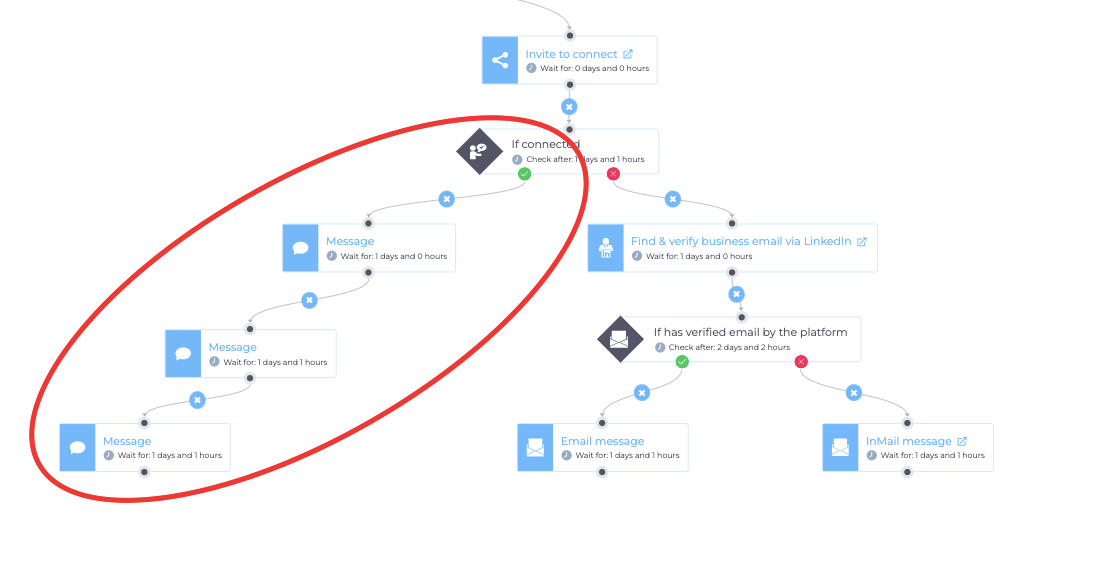
Furthermore, Skylead allows you to A/B test LinkedIn connection requests, subject lines for emails and InMails, and any message body copy, so you can consider more than one input when using Chat GPT for sales.
Skylead’s advanced reporting system allows you, aside from other analytics, to review A/B testing step by step and make data-driven decisions on what sales message worked best for your target leads.
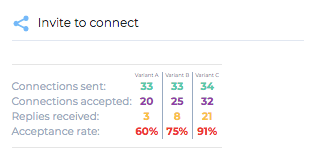
Now, let’s go ahead and show you a practical example of how to use Chat GPT for sales.
How to give prompts to Chat GPT for sales messages
In this chapter, we will show you how to use Chat GPT to write a cold email.
For the best results, we always advise our users to give precise instructions on the types of sales messages they want Chat GPT to write.
Also, sometimes you need to emphasize that you need Chat GPT to generate both a cold email and a corresponding subject line, and sometimes by simply asking it to write an email, it will suggest the subject line as well.
Chat GPT is not perfect, and it cannot read your thoughts (thank God!), so always strive to be as precise as possible when giving prompts.
The more detail you provide, the more satisfying the result will be.
So, let’s go ahead and see different ways to converse with Chat GPT for sales.
Way #1 Copy & paste information and give a prompt.
So, to start, assemble the following on a sheet of paper:
- The characteristics of your ICP and Buyer Persona(s) within;
- Pain points of your Buyer Persona and how your problem solves those pain points;
- Unique selling proposition of your product or service.
Then, you can copy and paste the relevant information, such as the desired length of your email, your Buyer's Personas goals and pain points, how your product solves them, and/or your product's USP.
So, this was my initial prompt.
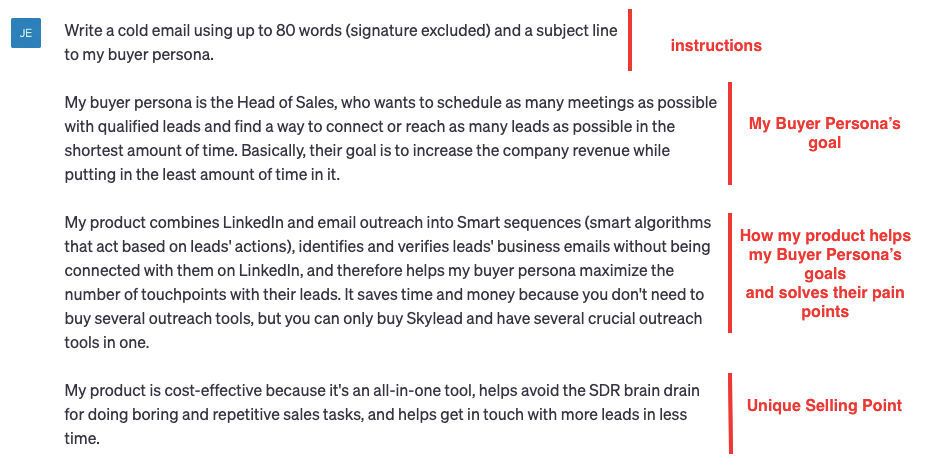
This is what I got.
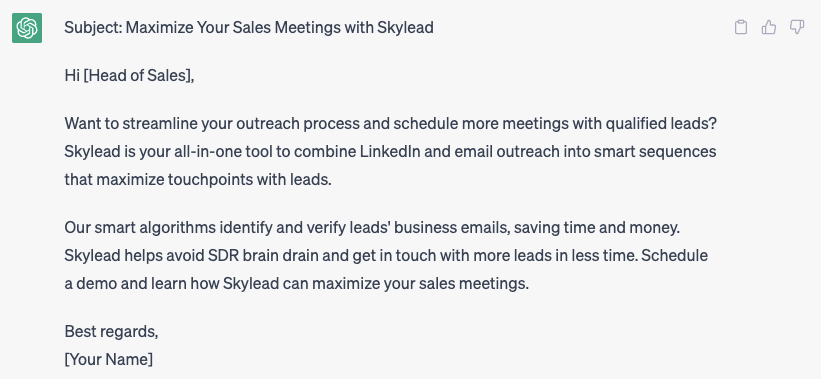
I personally found this email to be a bit too salesy and kind of “dry”. And this is exactly what I mentioned as a feedback.
So, there’s no need to write an entirely new prompt. You can give honest feedback to Chat GPT.

Here’s what I’ve got.
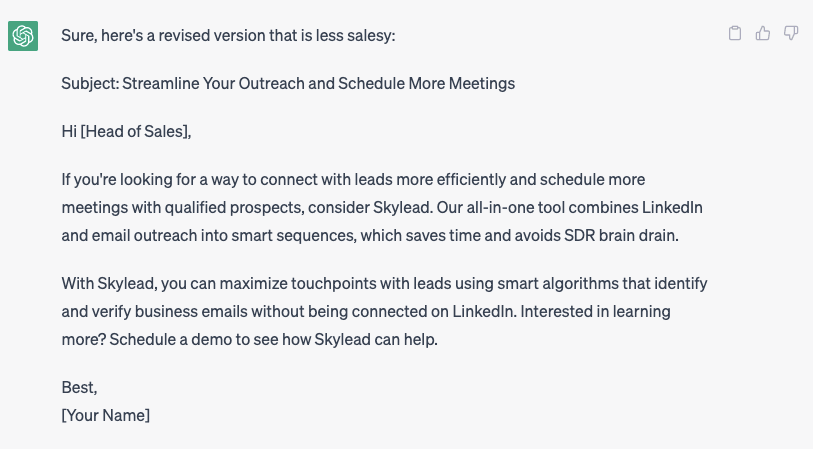
As you may see, you can go on and on like this.
You can give feedback to Chat GPT on any part of the sales message you get or even edit the initial prompt until you find the most satisfying results.
Here’s where you can edit your prompt.

I will again remind you that, sometimes, it’s easier and better to edit the email manually or even mix and match different parts of different sales messages generated by Chat GPT.
Way #2 Copy & paste information and give a prompt to use messages in a sales automation tool.
You can apply the same principle (or any other below) to prepare sales messages to use in sales automation software.
Just make sure you tell chat GPT which variables (placeholders) you would like it to use so that the sales automation tool you’re using can personalize your outreach at scale.
I used the same prompt as above, just changed the instructions part.
Here’s the prompt.
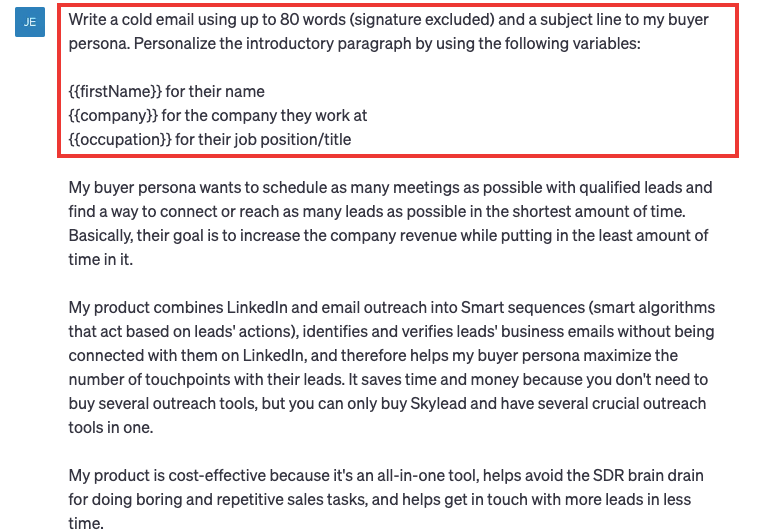
This is what I got.

I liked the answer, but I noticed it was above 80 words. (again, always check cause Chat GPT is not perfect!)
So, I gave feedback and got another result.
(Also, by clicking the “Regenerate response” button, you can probably go on and get new solutions for on and on.)
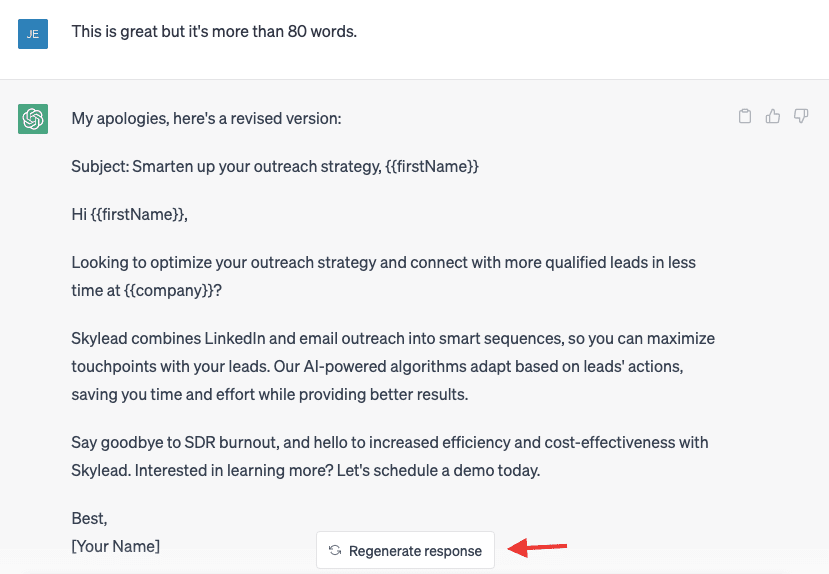
Way #3 Upload your lead's LinkedIn profile and give a prompt.
You can upload your lead’s LinkedIn profile and give the same instructions as above to write a more personalized message.
#1 Go to your lead’s LinkedIn profile and download it in PDF format.
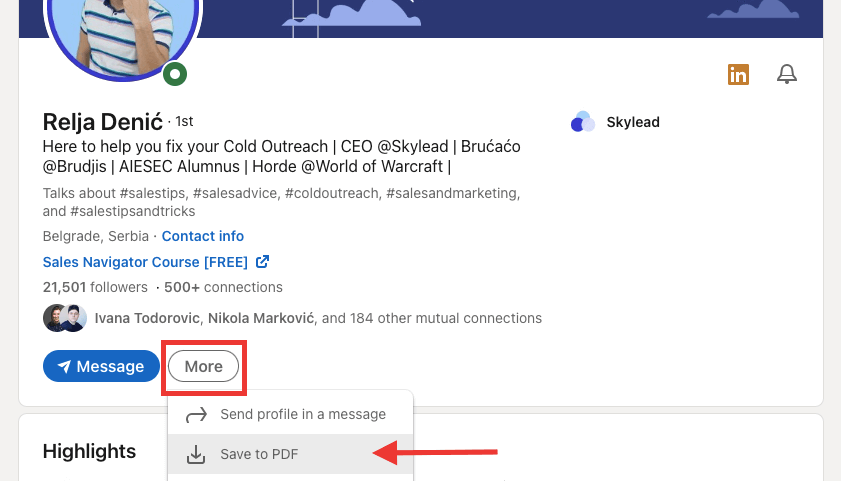
Upload it to your drive, then open the document, and click Share > Anyone with the link.
You cannot just copy & paste someone's LinkedIn URL because Chat GPT is not "on LinkedIn", and what's on social media is not considered publicly available information for Chat GPT.
Copy and paste the link into Chat GPT, and give instructions.
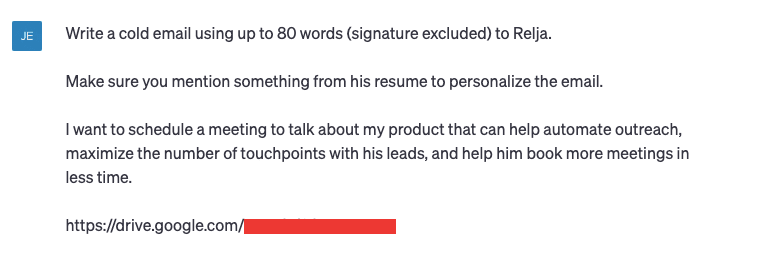
This is what I’ve got.
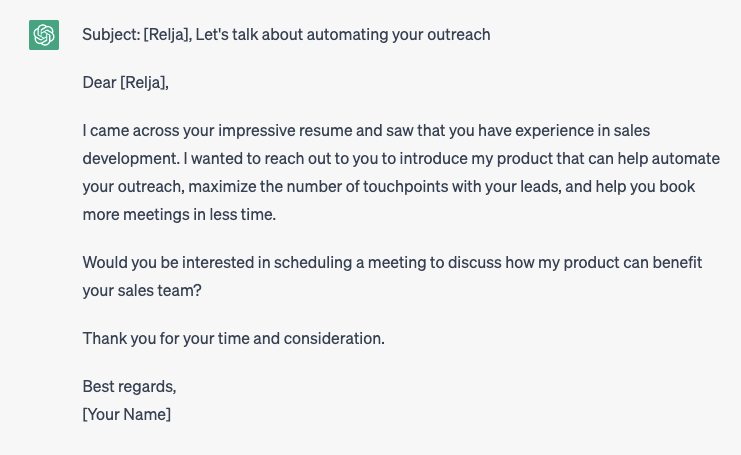
I wasn’t very happy with the result, so I asked Chat GPT to give me a few other solutions.
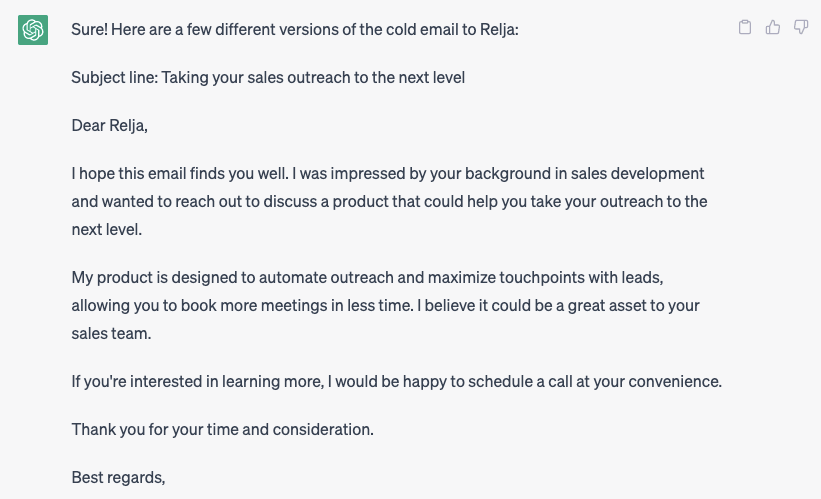
And another one.
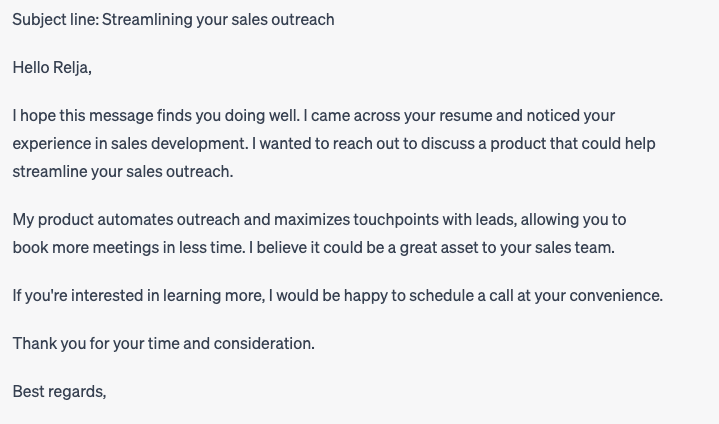
And another solution.
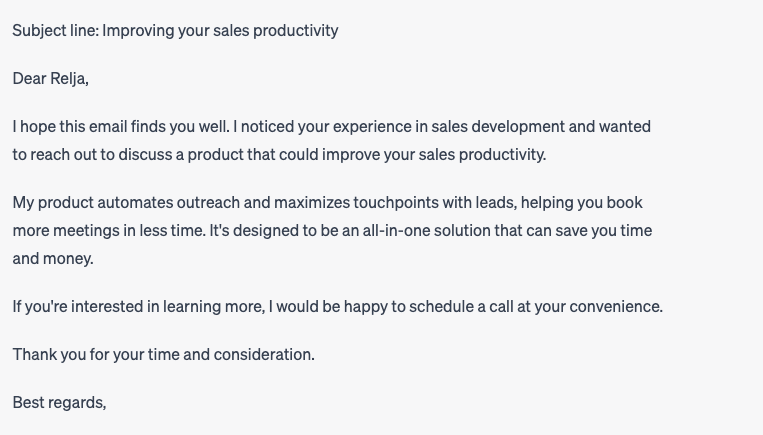
Remember that you can also combine the 1st, 2nd, and 3rd ways to give prompts for more precise instructions.
That is, upload your lead’s CV and then write their pain points, goals, and your product's unique selling points in the prompt.
Way #4 Use LinkedIn posts to personalize icebreakers in your cold emails.
A great way to instantly connect with your leads and increase your response rates is to make a reference to their LinkedIn post that resonated with you and that (ideally) you can tie to your product or service.
Just copy and paste the post to Chat GPT and give a prompt to use it in the introduction of your cold email.
The reason why you cannot just copy and paste the link to the blog to Chat GPT is that the Chat GPT can only use publicly available information, and therefore it cannot access LinkedIn and other people’s profiles.
Here’s what my prompt looked like.
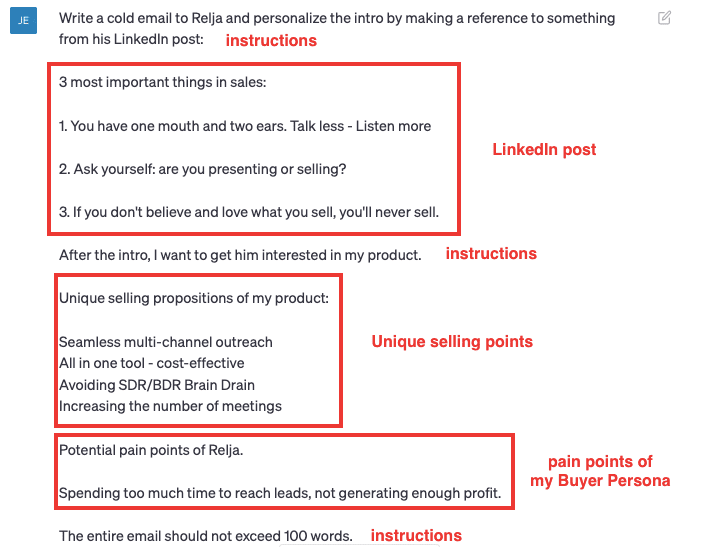
This is what I’ve got.
I have to be honest; I was pretty happy with it right away.
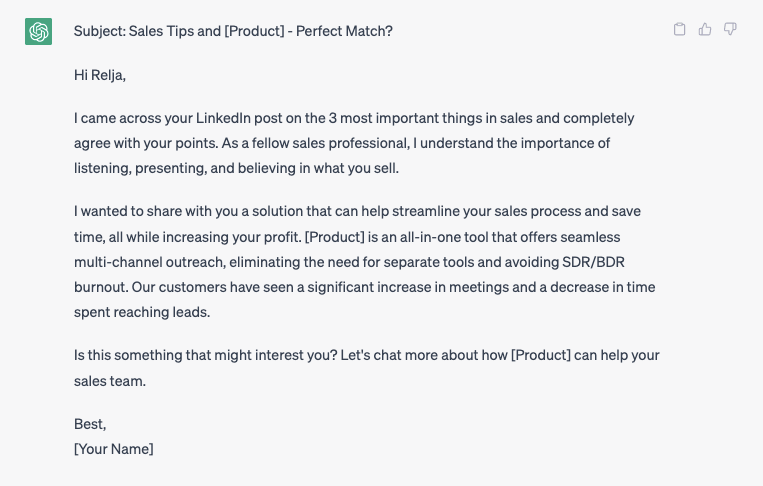
Way #5 Use Chat GPT to fight the most common objections.
The simplest way to use Chat GPT to fight the most common objections handling situations to cold emails is to upload the email you’ve sent, your lead’s objection, and give instructions to Chat GPT to answer it.
You can copy/paste the majority of the information.
Here’s what my prompt looked like.
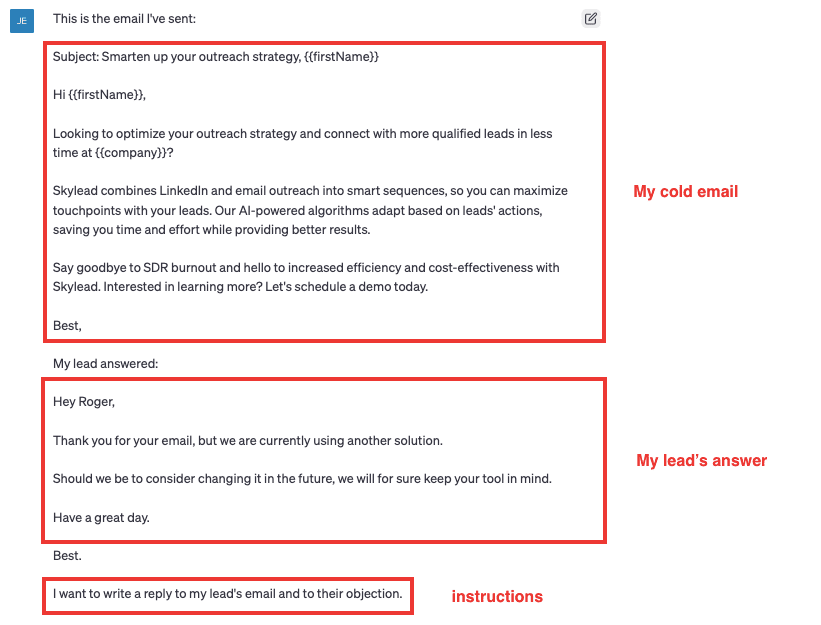
This is what I got from Chat GPT.
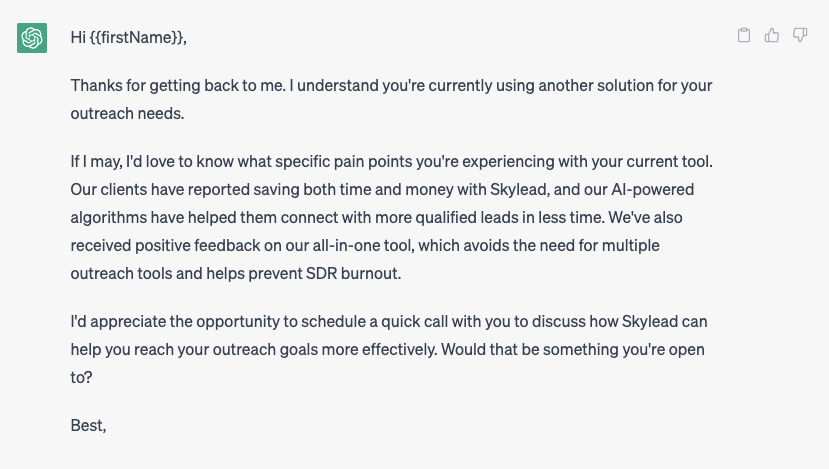
I felt as if it was selling right off the bat a bit, so I gave another prompt.
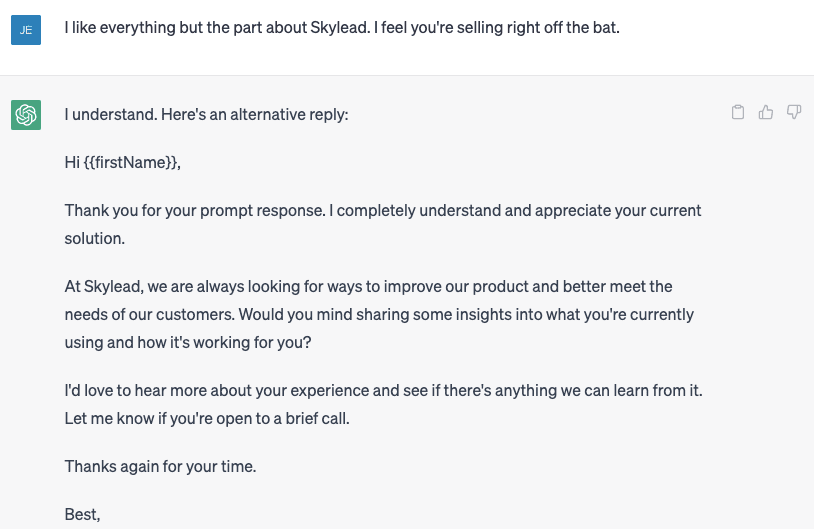
Way #6 Use Chat GPT to write follow-ups after no response.
Following the previous example, you can also ask Chat GPT to write a follow-up email after no response.
The easiest way to give a prompt to Chat GPT is to copy/paste the email and give instructions.
Of course, if you need something more specific, make sure you include details too.
My prompt was very simple this time.
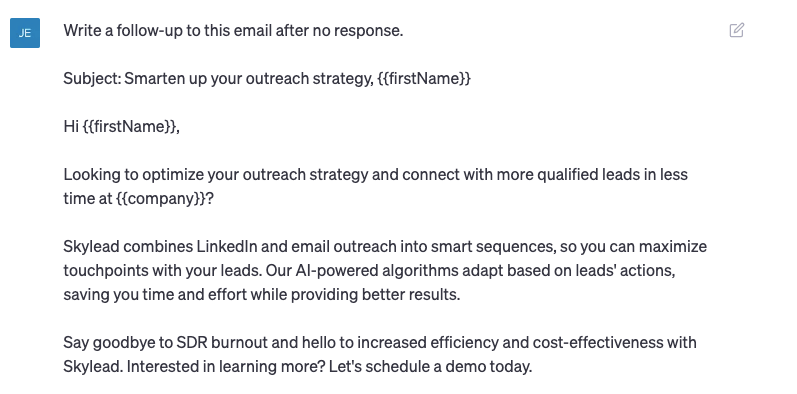
This is what I got.

I didn’t like the answer because I wanted my lead to answer or start a conversation with me instead of pushing for a sales pitch.
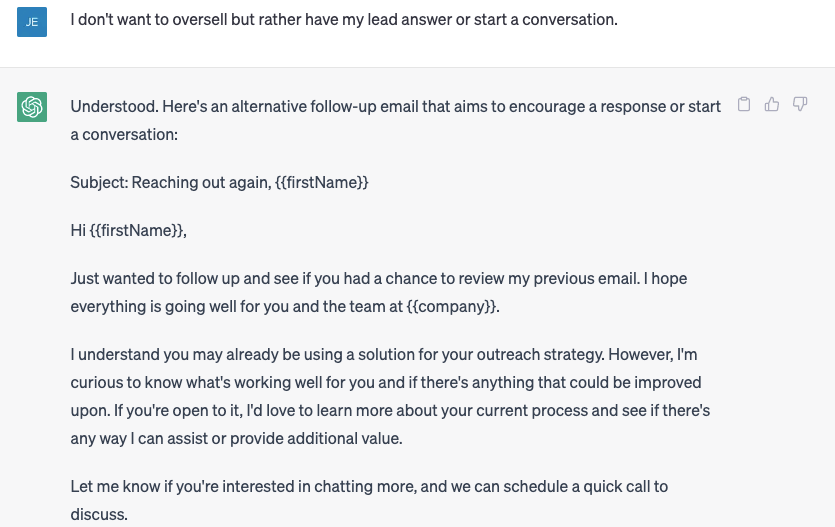
How to give prompts to Chat GPT for sales subject lines
Whether writing an email or InMail, subject lines are the key factor to a higher open rate.
In this blog, we will show you 3 ways how to use Chat GPT for sales subject lines.
Way #1 Copy & paste your cold email and give a prompt.
Copy and paste the email to Chat GPT and ask it to suggest subject lines.
Here’s what my prompt looked like.

This is what I’ve got.
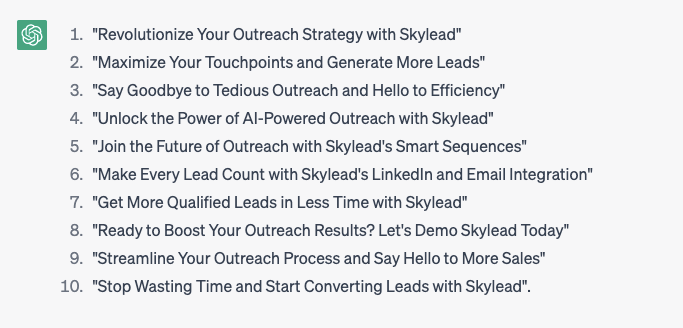
You can go ahead and play with it just like we did in the previous examples.
I asked Chat GPT to make the subject lines shorter, for example.

Way #2 Insert keywords and important information and give a prompt.
Describe your product (you can also copy and paste information regarding your ICP and Buyer Persona that you think should be included in your subject line) and give a prompt to Chat GPT.
Here’s my prompt.
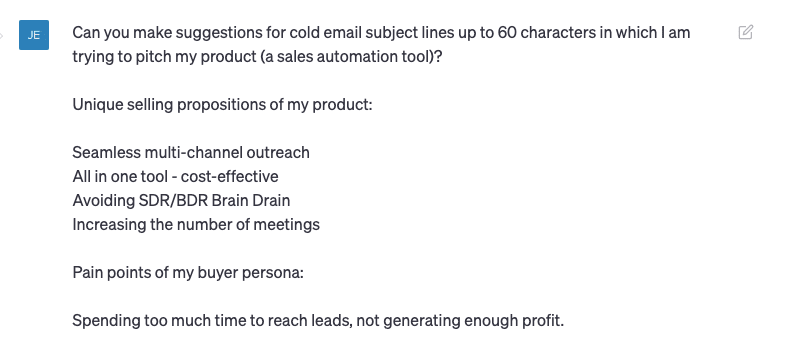
Here’s what I’ve got.

Frequently asked questions
How can one integrate Chat GPT with CRM software to streamline the sales process further?
Integrating Chat GPT with CRM software can be achieved through APIs or webhook integrations. This allows automated data exchange, enabling Chat GPT to personalize communications based on CRM data, improving the sales process by offering tailored interactions and insights.
What are the limitations of Chat GPT in understanding and responding to complex sales scenarios or objections?
Chat GPT's limitations include difficulty in understanding nuances, emotional cues, and highly complex scenarios specific to certain industries. Its responses might lack the depth that comes from human experience and intuition, potentially misinterpreting intricate customer objections or specialized queries.
Can Chat GPT be used to generate not just initial outreach messages but also to automate ongoing communication based on recipient responses?
Yes, Chat GPT can be used for more than initial outreach; it can automate ongoing communication by analyzing recipient responses and generating follow-up messages. However, this requires sophisticated setup to interpret responses accurately and respond appropriately, maintaining a balance between automation and personal touch.
Summary
As you may see, your options for using Chat GPT for sales are infinite.
Our only advice is not to be afraid to experiment and to give new prompts and feedback until you are completely satisfied with the result.
Also, keep in mind that you can always manually adjust any solution Chat GPT suggests.
And if you wish to test out 7 days for free how to combine Chat GPT with Skylead, a LinkedIn automation tool and cold email software, check out this link.
Are you a sales rep who got your LinkedIn account restricted? Maybe you’re thinking it got into the infamous LinkedIn jail. Don’t worry. Together, we’ll get it back. Have a seat and relax as we go through:
- What is the difference between having your LinkedIn account restricted and ending up in so-called jail;
- 8 reasons why your LinkedIn account got restricted;
- 4 proven steps to regain access to your LinkedIn account;
- How to keep your LinkedIn account safe in the future.
What does it mean when your LinkedIn account is restricted?
Getting your LinkedIn account restricted means that you knowingly or unknowingly acted against their Professional Community Policies. This caused LinkedIn to limit your ability to perform further actions using your account. You know your LinkedIn account is restricted since this notification will appear when you log in.

In some cases, the restriction/suspension is temporary or will have the note with the restriction end date. Under more serious circumstances, you will have to contact LinkedIn support.
Fear not - at this point, you can still get your LinkedIn account back.
What is the difference between getting a LinkedIn account restricted and LinkedIn jail?
Unlike restriction, where you get your LinkedIn account back after a 4-step process, LinkedIn jail is a permanent account ban or an endless loop of review process. It usually happens after you get your LinkedIn account restricted multiple times.
There are 2 ways that indicate you ended up in LinkedIn jail:
- If you receive feedback from LinkedIn support saying that your account restriction is final due to repeated Terms of Service violation. (Permanent)
- Or if you don’t hear from them for weeks-on-end after you got restriction multiple times. (Not permanent but the process takes a long time)
Ending up in permanent LinkedIn jail happens in extreme situations only. So, if you are a sales representative, you don’t need to worry. However, you need to be cautious and aware of your LinkedIn lead generation activity.
Why is my LinkedIn account restricted?
Let’s go through all 8 reasons LinkedIn may restrict your account and identify the root cause.
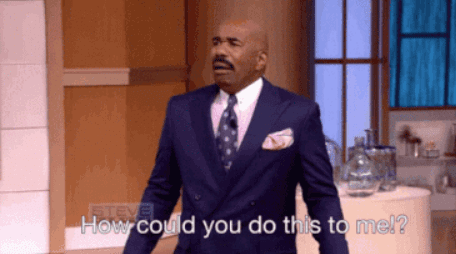
1. You created an account with a name that isn’t yours or violates User Agreement.
People sometimes create their profile using the name of a company, some other business or entity, which is against the LinkedIn Terms and Conditions. In case you use the platform to represent your company, the better decision would be to create a company page for it.
In addition, creating an account with a false name, and if detected, can be a subject of immediate restriction or a ban, according to LinkedIn User Agreement.
2. You created multiple profiles from the same device.
LinkedIn’s User Agreement states that you cannot have more than one real profile created from a single device or a proxy, especially if one of the accounts is restricted. In case you intend to create multiple profiles, be prepared for getting all those LinkedIn accounts restricted.
3. You might have violated LinkedIn’s content policy.
When users post content that goes against LinkedIn's community guidelines or professional standards, it generates violation tickets. Content violations can include;
- Posting spammy content.
- Engaging in harassment or bullying.
- Sharing inappropriate or offensive material.
- Promoting illegal activities.
That said, LinkedIn will definitely ban your account if you publish content that violates their Professional Community Policies. Depending on the level of violation, they can temporarily or permanently restrict your account. When users violate these guidelines, LinkedIn may restrict their accounts to maintain the platform's integrity and professionalism.
Therefore, you must review LinkedIn's guidelines and ensure your content complies. This prevents violations and potential account restrictions.
Additionally, users should refrain from posting controversial or sensitive material that may offend or disrupt the LinkedIn community. You can read our detailed guide on how to post on LinkedIn here.
4. You sent too many connection requests.
If you send a lot of connection requests weekly, you can get your LinkedIn account restricted. Consequently, if you overstep your boundaries many times your account will be partially restricted with the following message:
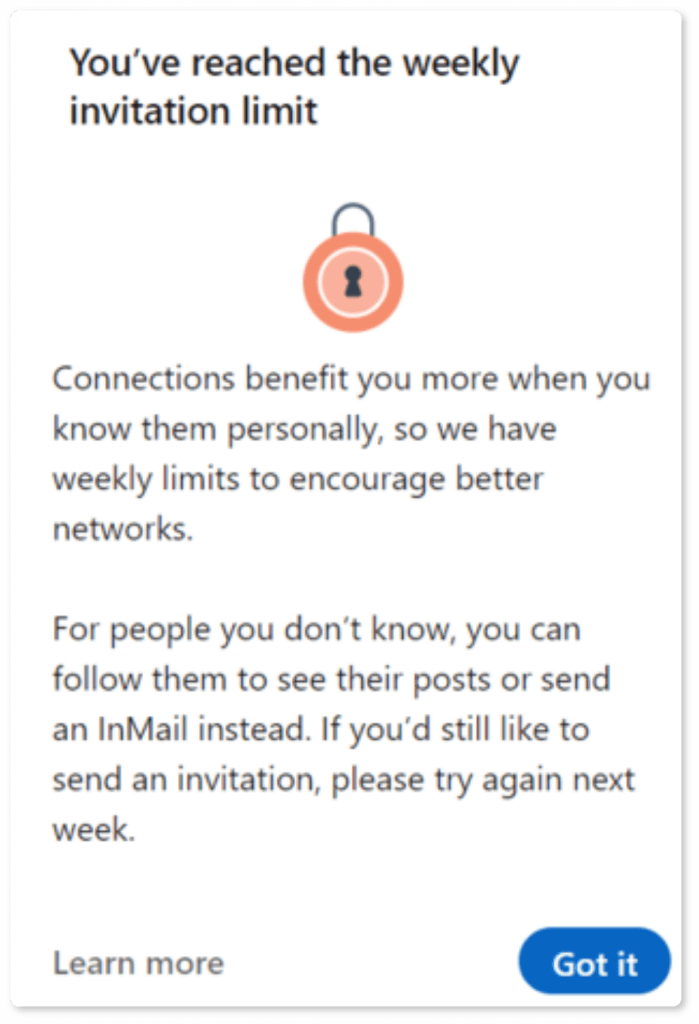
If you exceed the limit and get restricted, you won’t be able to send other connection requests. However, you can access other LinkedIn features.
In general, the number of invitations you can send is between 100 and 200 per week. The catch-22 here is that the LinkedIn limit algorithm often changes. That said, the limit itself is not final and depends on many factors. In other words, it can vary based on:
- whether you are just starting out,
- your account health,
- the number of current connections you have,
- or the connection acceptance rate.
To avoid this issue, you should be mindful of the number of connection requests you send out each day. Moreover, the connection requests must be well-targeted and personalized. Additionally, you should avoid sending connection requests in bulk or during odd hours.
5. Your acceptance rate is too low.
If you send a lot of blank or not personalized requests to 3rd-degree connections, your acceptance rate will be low. In other words, LinkedIn registers this as a suspicious activity and you can get your LinkedIn account restricted.
6. Your invitations have been left pending, ignored or marked with “I don’t know this person”.
LinkedIn considers suspicious behavior when most of your connection requests have been left pending for a long time or have been ignored. So it's best to clear them regularly.
In addition, blank and non-personalized connection requests can make some users click the "I don't know this person" button. If this number of people is high, you can have a restriction on your hands. Also, LinkedIn may ask you to provide a person's email to connect with them from that point forward. Needless to say, they will start to monitor your account as well.
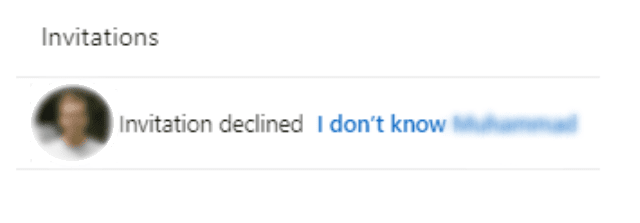
The good news is that LinkedIn lifts most of these restrictions automatically within one week.
However, to avoid this to begin with, focus on building meaningful connections with individuals within your industry or network. Personalize your connection requests and include a brief message explaining why you'd like to connect.
Furthermore, engage with their content or participate in relevant discussions to establish rapport before sending a connection request.
7. You might've used unsafe LinkedIn automation tools.
It’s no secret that LinkedIn doesn’t like the automation of its platform. Some tools meet their guidelines, while some of them do not. So, one of the common reasons people experience restrictions is that they use the wrong LinkedIn tools that reveal bot-like behavior.
Yes, LinkedIn automation tools can help you scale your business if you are a sales professional, founder, agency owner, marketer, or recruiter. And yes, you can do so while keeping the restriction off your hands, having your LinkedIn account healthy, and respecting why LinkedIn was created - because of the authentic interaction. That said, we’ll help you choose the right tool. So keep on reading.
8. You failed to provide proof of your identity.
Identity violations typically occur when users fail to provide accurate information about themselves or misrepresent their identity.
To avoid any potential violations, the information provided on your LinkedIn profile should accurately reflect your professional identity. It should contain,
- Usage of your real name,
- A professional profile picture,
- The accurate details of your work experience and qualifications.
9. LinkedIn thinks your account is fake.
If LinkedIn suspects your account to be fake, it can immediately restrict your account. This often occurs when your profile information appears incomplete or inconsistent, or when your activity seems unnatural or automated.
LinkedIn takes measures to ensure the authenticity of its user base. It also restricts accounts that raise red flags in terms of genuineness.
To avoid being mistaken for a fake account, make sure your profile is complete and accurately represents your professional identity. Additionally, engage in meaningful interactions on the platform to demonstrate your real presence and value to the LinkedIn community.
10. LinkedIn detected too many “Views” from your account.
When your account views profiles excessively within a short period, LinkedIn's security considers it spam. It ultimately leads to account restrictions.
LinkedIn sees aggressive networking or rapid profile viewing as suspicious behavior. Thus, it results in restrictions to prevent further misuse of the platform.
Therefore, moderate your profile viewing activity and adopt a more organic approach to networking. Instead of mass viewing profiles, focus on connecting with relevant individuals and engaging with their content genuinely.
11. LinkedIn might've detected your activity from different countries.
The impact of accessing LinkedIn from multiple countries within short time frames can be huge in terms of account suspension. When your account shows inconsistent location patterns, it can send an alert to LinkedIn security.
To avoid this, align your LinkedIn location with your actual physical location. It reduces risks from international activity on the platform. If you frequently travel, updating your location accordingly can help maintain account integrity. Assign proxies matching the account's country if managing multiple accounts or accessing from different locations for security and compliance. It helps avoid the detection of simultaneous access from different regions.
4 proven steps to regain access to your LinkedIn account
#1 Step - Understand why it happened.
When you get your LinkedIn account restricted, you won’t be able to log into your account for several days. Furthermore, it often happens that LinkedIn doesn’t provide any explanation as to why they restricted your LinkedIn account.
So, to understand the reason for getting a LinkedIn account restricted, read the reasons above, or LinkedIn Terms and Conditions and the User Agreement.
#2 Step - Follow the instructions on your account.
Sometimes, when your LinkedIn account is restricted, you will see a notification when you log in. Then LinkedIn will ask you to verify your identity by uploading images of your ID, front and back.
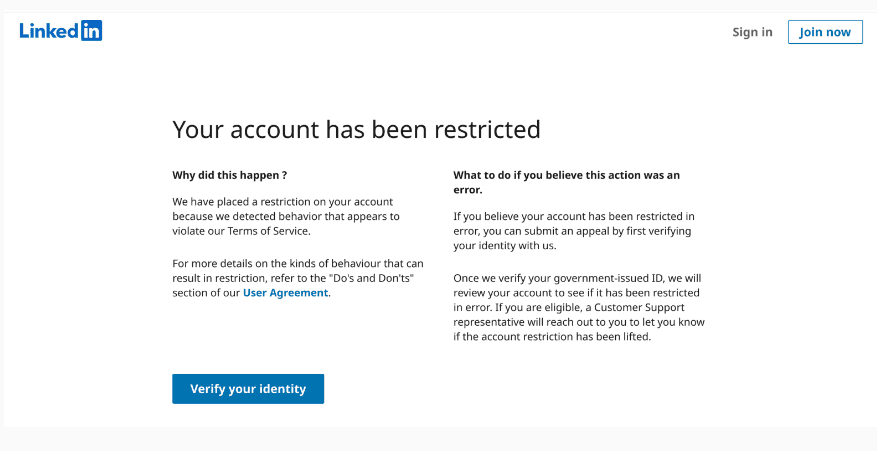
After you do it, someone will review your account. The process is sometimes quick and can last up to 48 hours. However, often, it can take up to 7 days for LinkedIn to respond. You’ll also get an email when LinkedIn lifts the restriction from your account. So, be patient.
#3 Step - Contact LinkedIn customer support.
If you get your LinkedIn account restricted, it is usually temporary, and restrictions are lifted quickly when you verify your identity. However, if there’s no option for you to verify identity, or your appeal has been pending for a long time the next step would be to reach out to the LinkedIn Support directly. You’ll probably need some identification documents to confirm your identity as well.
Here is how to contact LinkedIn customer support:
- Writing them on X
- Contacting them here, through the contact form,
- Or use other ways to contact LinkedIn support.
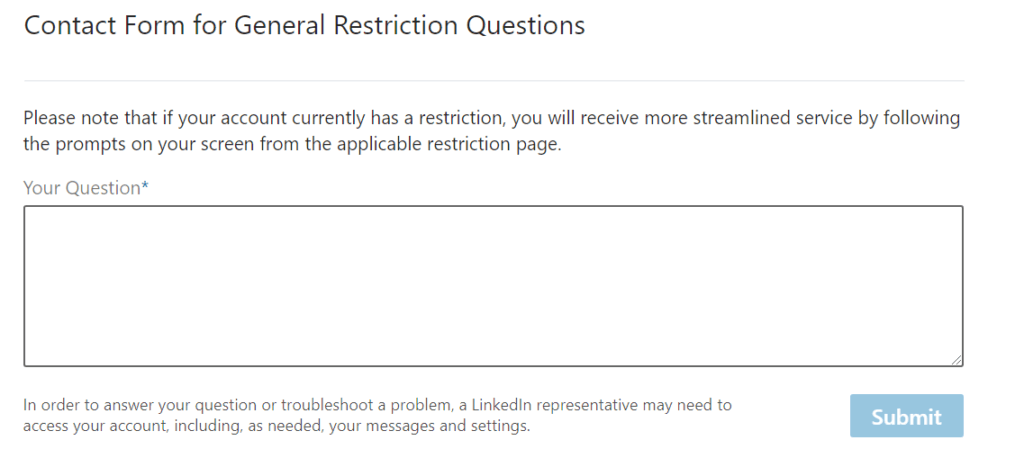
In addition, here is what you should include in the appeal:
- Reasons why you need to get your account back;
- Acknowledgment of the violation - it’s best to be honest (if you made a mistake);
- Point out mistake on their part (if LinkedIn wrongly banned your account);
- Assure LinkedIn support that it won’t happen again.
#4 Step - Ask for help
You can also ask around for help in your network. If your connections raise a query and show support for your account, it will help you gain access to your LinkedIn account faster.
Show the real power of your network! 💪
You managed to get your LinkedIn account recovered? Follow these 6 dos & don’ts to avoid being banned again.
1. Know your limits on LinkedIn.
Even though LinkedIn wants you to use their platform, they want you to do it cleverly, as well. There are 5 types of direct interactions with users (if we exclude post likes and comments), and those are:
- Profile visits
- Following
- Connection requests
- Messages
- InMails
Each of these actions has a daily limit you need to follow if you don’t want to risk your profile’s safety. Also, these limits are higher for the premium account users and the old ones with a larger network.
Here are the limits that turned out to be the safest if you’ve been using LinkedIn for some time:
- Profile visits: 80-120 per day
- Follows: 80-120 per day
- Connection requests: 40-60 per day
- Sending messages: 60-100 per day
If you haven’t, keep these limits even lower.
2. Withdraw your pending requests.
Keep your pending invitation request around 400 or 500 and remove those that are 4 weeks old. A higher number will get you on LinkedIn radar. Only, keep in mind that you won’t be able to send an invitation to that person in the next 3 weeks.
In order to cancel a LinkedIn invite, you can use a manual method. However, what makes your life easier in situations like these is using a sales engagement tool. For example, Skylead will send out invitations for you, and to keep it clean and safe. It will also automatically withdraw older ones, so you wouldn’t have to do it manually on your own.
3. Warm up your LinkedIn account.
Let's say your LinkedIn account is relatively new, or you've already got the restriction. The best approach would be to start with a few actions and build your way to the maximum limit.
The thing is that if your LinkedIn account is new, and you start sending a large number of invites right away, LinkedIn will consider it suspicious activity.
Here is what you can do to prevent this:
- Send out as little as 10 connection invites or send 30 messages a day;
- Slowly increase the activity numbers by 5-10 weekly;
- Avoid sending invites on weekends;
- Take a bit more time between performing actions;
- Don't connect with the 3rd-degree connection in the beginning;
- Remove all the pending connection requests if they are not accepted within a few days.
4. Always send friendly and personalized messages.
When connecting with the people you know, always be genuine and include a personal message. For instance, send a personalized invitation including the reason why that person might wish to connect with you. This way, you’ll avoid the label of an unknown person.
If you need inspiration for connecting with new users, we have a lot of LinkedIn connection message templates that might help you. You can also throw in some delicious images or GIF personalization.
5. Don’t sell right away.
Don't try to sell immediately after connecting with the new users. It can only push them away and make them ignore you. Building a relationship and providing value with updates, articles, and messages is important before you try to close a deal.
6. Use the right LinkedIn automation tool.
To understand which LinkedIn automation tool to choose and keep you safe, let's first go over all types.
Extensions
Browser-based LinkedIn tools are extensions in your browser that rely on browser caching, making it much easier to detect. Other downsides of these tools are:
- They do not offer dedicated IP,
- Your PC has to be on to be able to run,
- It automatically injects the code into LinkedIn, placing a big "I am using automation tool" target on your back.
Desktop apps
The second type of LinkedIn automation tools are desktop apps that don’t offer dedicated IP addresses. They don’t have the possibility of running Multiple Accounts, nor do they work in the background. Since it works through the web, it doesn’t inject code into LinkedIn, making it a bit safer than browser-based ones/extensions.
Cloud-based tools
Cloud-based software is the best of them all because:
- it is managed and processed thanks to a dedicated IP address that shields your activity on the internet (proxy);
- All your data is on the internet;
- They do not inject any code into LinkedIn;
- Advanced personalization;
- The software can run even when your computer is off;
- Only cloud-based software can have Multiple Accounts and integrated inboxes.
Due to the above-mentioned, we advise using cloud-based tools because they work online, are much safer than extension-based tools, and are better than desktop apps.
For example, the excellent thing about Skylead, as one of the cloud-based tools, is that it’s entirely safe for use because of its location-based IP addresses. Skylead also has a human-like behavior (for example, clicking and scrolling as a human would do), making it undetectable and reliable.
That makes Skylead a FIVE STARS tool! Plus, it has a lot more features to offer.
The moral of the story: Some of the tools are riskier than others, and it’s not hard for LinkedIn to spot this kind of manipulation and get your LinkedIn account restricted, so choose wisely.
How to use LinkedIn automation tool carefree?
Considering your account's safety and features, we previously stated why Skylead is a perfect choice to outreach on autopilot. So, if you wish to connect with more people every week, here’s how Skylead can help you with that as well.
The thing is you can use free and paid LinkedIn InMails and emails to multichannel your outreach and connect with more people this way. What's best about these methods is that you don't risk getting your LinkedIn account restricted. Moreover, LinkedIn will love you for it as you will use their paid InMails.
How to create outreach campaign with Skylead
First, go to your campaign manager and choose the campaign type. Also, enter the lead URL source or import the CSV file.
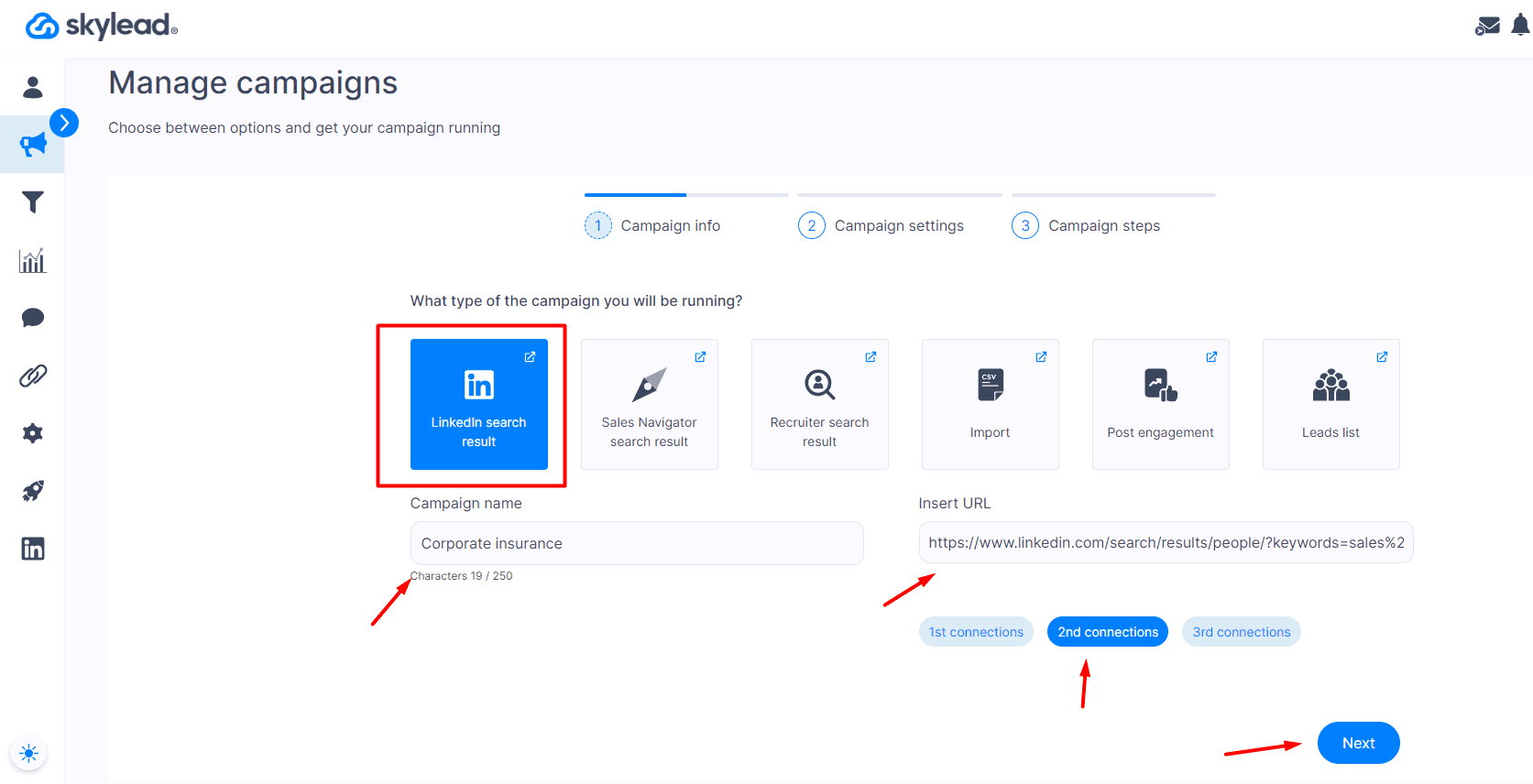
Then, fill in the details regarding your campaign setting and move on to the Smart sequence.
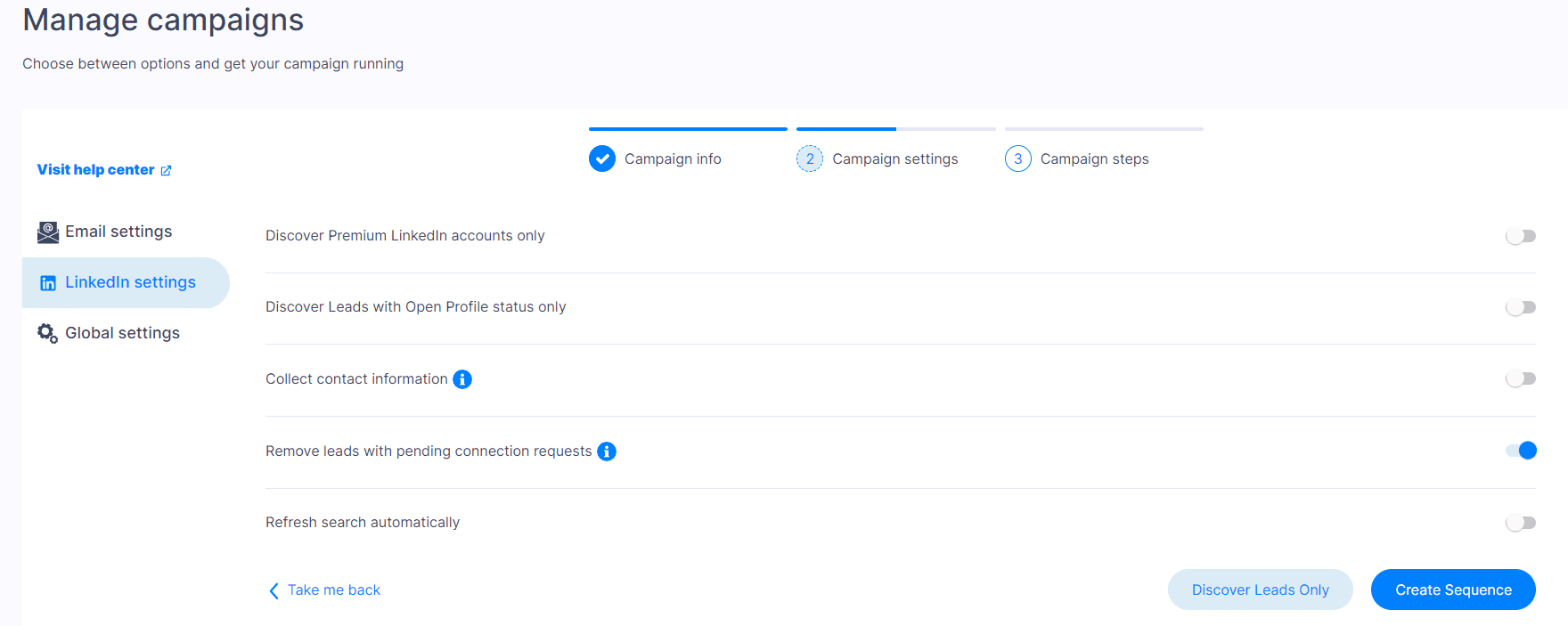
From here, you can personalize messages and combine LinkedIn and email actions with if/else conditions to create a coherent outreach flow that Skylead will follow to reach your leads.
To demonstrate an example, we've started with the Follow and Find & verify email steps. Next, we added the Invite to Connect step and the condition to check if Skylead manages to do so. If yes, Skylead can proceed to send a regular LinkedIn message and the follow-up.
However, if it doesn't manage to connect with leads, you can check if Skylead found the publicly available leads' business emails. If yes, Skylead can send them an email. If not, it can send them paid or free InMail.
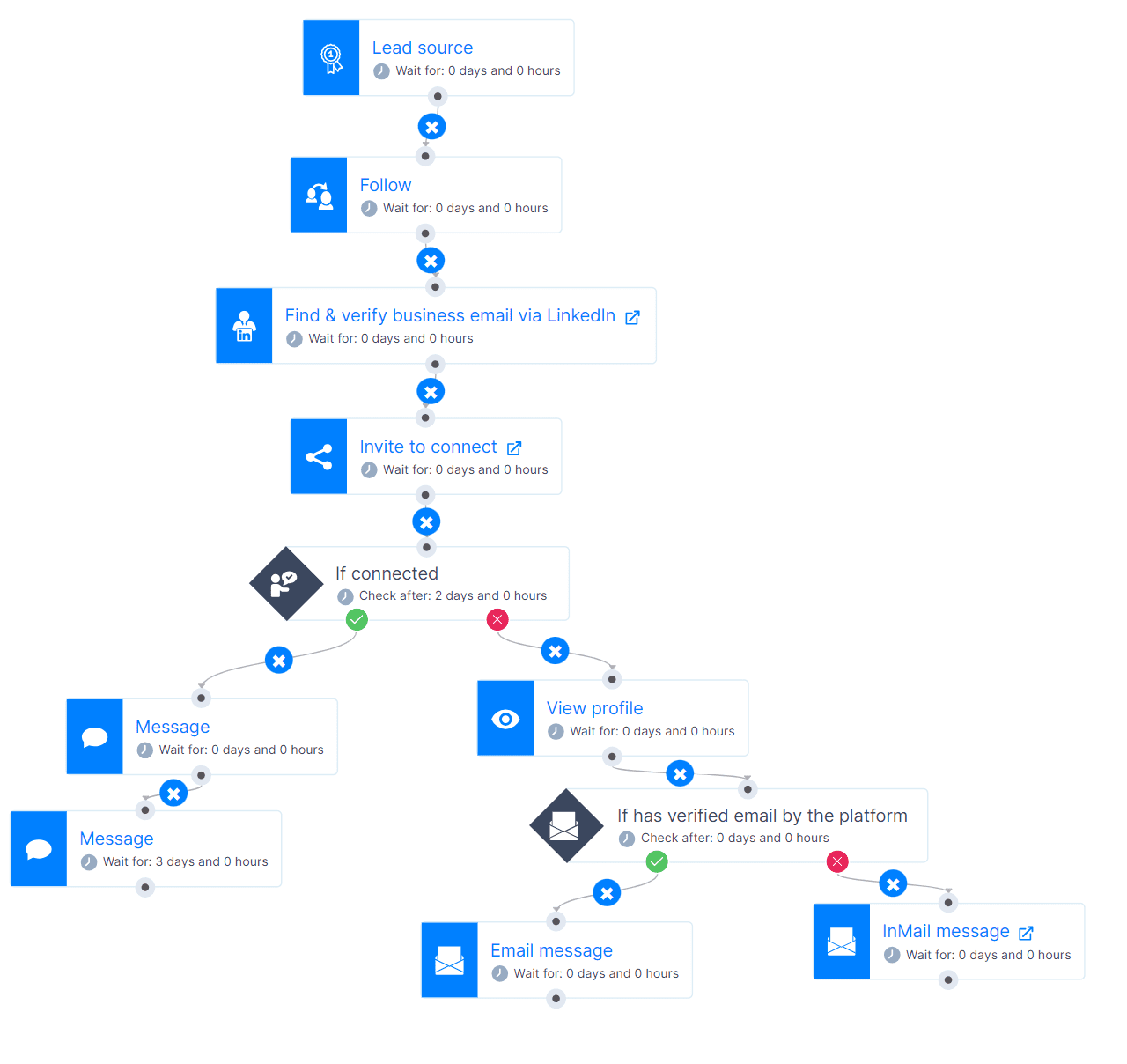
When you finish creating a coherent outreach flow, hit Start Campaign, sit back and relax.
Frequently asked questions
What happens when your LinkedIn account is restricted?
When your LinkedIn account is restricted, you lose access to certain features or the entire account, depending on the severity of the issue. This can happen for violations of LinkedIn's policies or unusual activity. You'll typically receive a notification explaining the restriction and steps to resolve or appeal it.
Why was my LinkedIn account restricted from sending connection requests?
LinkedIn considers every excessive action, even sending connection requests, a cause for the restriction. If you got your LinkedIn account restricted because of this, wait a few hours, then try again. Also, make sure not to send a lot of connection requests without a note or with the same note.
What to do when LinkedIn account is restricted permanently?
If your LinkedIn account is permanently restricted, review LinkedIn's User Agreement and Community Policies to understand the violation. Next, appeal the decision by contacting LinkedIn support with an explanation to support your case. If the restriction wasn't lifted, create another account with the new email and carefully follow the rules.
Why is my LinkedIn asking for ID when my LinkedIn account is restricted?
LinkedIn may restrict your account and ask for ID due to unusual activity detected by LinkedIn's security systems. The ID requirement helps ensure the safety and integrity of its network by asking you to verify your identity so LinkedIn can prevent unauthorized access or fraudulent activities.
Why does LinkedIn restrict accounts?
LinkedIn restricts accounts for two reasons. Firstly, to keep the platform safe. Secondly, to create an organic and beneficial space for all its users. To achieve this, LinkedIn sets rules to show what is acceptable, what actions are suspicious, and what content is inappropriate.
What to do if you get your LinkedIn account restricted for no reason?
If your account is mistakenly restricted, log into your LinkedIn account, follow the instructions from the notification, and submit your ID. After you do, support will review your account in 24-48 hours and lift the restriction. You’ll also get an email when LinkedIn lifts the restriction from your account.
You’ve got this!
Every social media platform, including LinkedIn, uses policies and rules when monitoring suspicious behavior to protect its users. So, getting your LinkedIn account restricted or ending up in LinkedIn jail due to these restrictions is serious business - especially for sales folks who use LinkedIn as their main LinkedIn prospecting and outreach tool.
But don’t stress; even if you get restricted, it’s not the end, and you can recover from it. Your LinkedIn account will be fine as long as you stick to the advice listed above.
Lastly, LinkedIn automation tools and cold email software can be very helpful with your business. Trust us, we’ve been using it since 2019. However, be careful of which one you use. Many tools are on the market, but the safest bet is to choose cloud-based solutions like our Skylead. If you wish to give it a go, start your 7-day free trial and schedule your onboarding call with one of our customer support representatives.
If you've ever wondered if there is a way to speed up lead-generation activities, we have a proposition - try automated lead generation.
Yes, that's right. Automation has been around for a while, especially for lead generation and management. And no wonder it's so effective since this way, you can find the most qualified leads and scale up your business. But, more importantly, you can generate your leads daily.
That said if you wish to use lead generation automation properly but need to figure out how - fear not. We will guide you on how to automate every sales and marketing lead generation task.
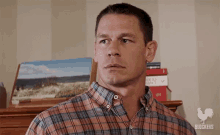
What is automated lead generation?
Automated lead generation is a process of using technology to perform time-consuming sales and marketing lead generation tasks on your behalf. To do this, you have different kinds of automation tools at your disposal. For example, you can use software to automate sending emails or LinkedIn connection requests.
Automated lead generation offers benefits such as:
- Reducing human error and thus improving your workflow;
- Saving time by performing manual tasks and decreasing workload;
- Providing insights into the performance of lead generation activities so you can use optimization and improve;
- Consistency in the workflow so you can generate leads daily;
- Leaving room so you can focus on building relationships and lead nurturing.
That said, there are plenty of automation tools on the market to choose from. However, let’s first distinguish the types of sales and marketing lead generation activities to discover what tool you should use accordingly.
Types of automatic lead generation
There are 2 types of automatic lead generation, but they best work when used in synergy.
Inbound lead generation automation
Inbound lead generation is a marketing strategy for attracting leads to your company. For example, a marketing team can create content valuable to the best leads for your business. The purpose of the content is to compel a lead to first take specific actions that will eventually lead to sales.
In addition, since leads nowadays focus on researching independently, inbound lead gen focuses on helping rather than selling. In other words, it shows the way toward your brand content pieces such as blogs, ebooks, and guides.
That said, inbound lead gen automation means streamlining the said tasks using automation tools. For example, you can use the following types of tools to automate your inbound tasks:
- Chatbot - to provide answers to questions;
Pop-ups & forms - to offer personalized content, lead magnet or surveys on the website.
Outbound lead generation automation
Outbound lead generation is about finding and reaching out to your ideal leads directly without waiting for them to reach out to you. To clarify, rather than waiting for leads to find your website and reach out like inbound lead gen, you are the one who makes the first move.
That said, to automate your outbound lead generation tasks, you can use the following types of tools:
- Email marketing and outreach tools - for outbound marketing and sales to automate sending emails, newsletters, or themed email sequences;
- Prospecting tools - for marketing and sales to find outbound leads and contact information;
- Social media automation tools - for sales to automate outreach on social media;
- Advertising tools - for marketers to automate buying digital advertising space.
B2B lead generation automation VS B2C lead generation automation
Business-to-Business (B2B) lead generation automation is a process of using software to generate potential leads who work in a company to offer them your services.
On the other hand, Business-to-Consumer (B2C) lead generation automation uses software to streamline and generate leads who are individual customers.
Even though they have different potential customers, both B2B and B2C companies use the same lead generation automation for a similar purpose. Here is how different companies use types of automation tools for their purpose.
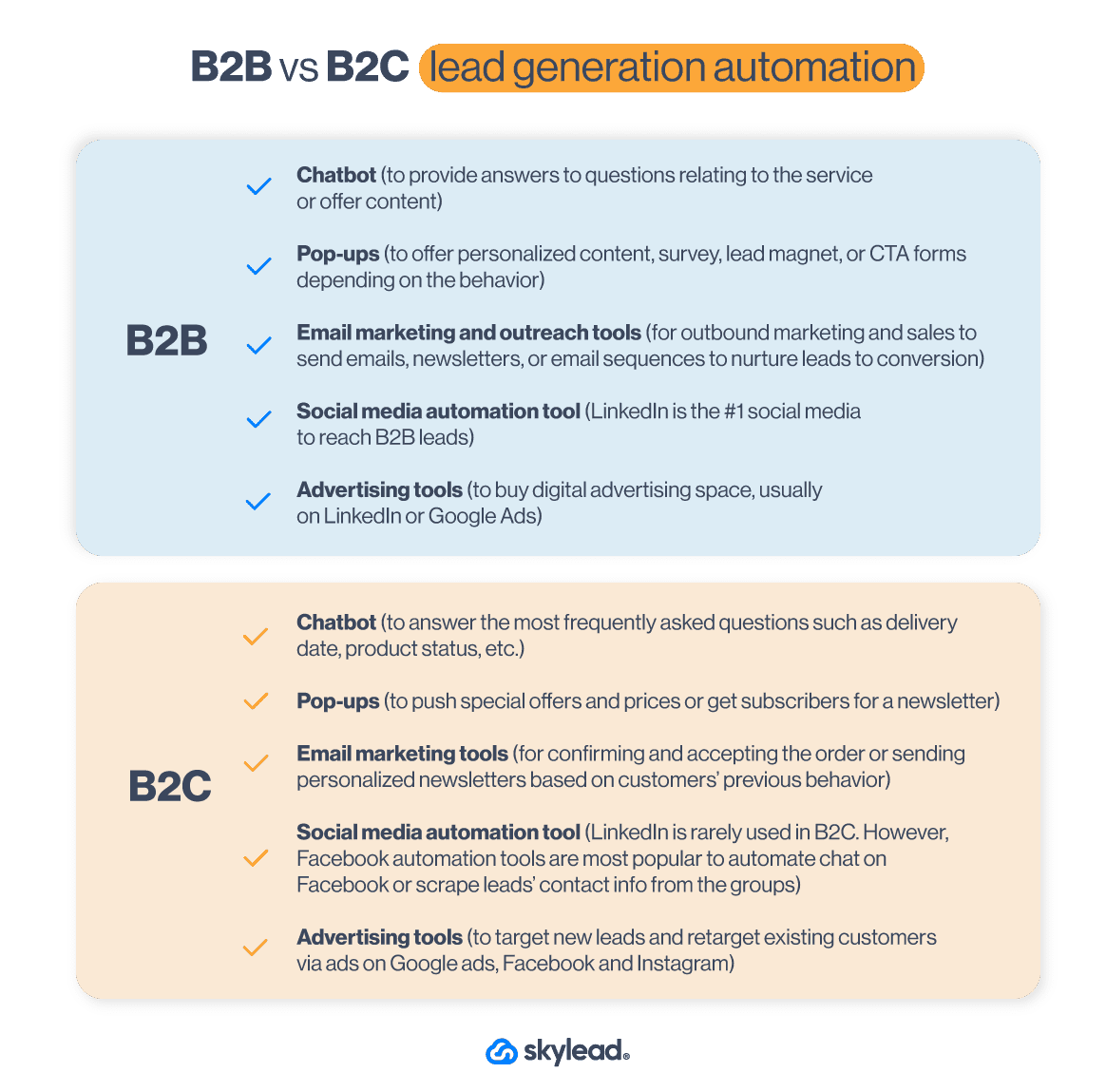
How to automate lead generation [Step-by-step guides]
Automated outbound lead generation guide
1. Define your ICP and buyer persona
Your outbound lead generation needs a good basis to get quality leads that convert. That’s why sales teams start off their lead generation process by creating Ideal Customer Profile and Buyer Persona. This way, you can generate the best leads and guide them through the sales funnel. Not to mention, these documents will help you with the lead scoring.
The best practice for the creation of both of these documents is to analyze your current customer data and gather users who:
- Have the shortest buying cycle;
- Have a high retention rate;
- And who would advocate for your product or service.
2. Find contact data
Once you establish your ICP and Buyer Persona, it’s time for prospecting.
Almost all sales teams use LinkedIn prospecting to find the best leads for their sales funnel. Moreover, there are a lot of proven LinkedIn lead generation strategies out there to find quality leads. However, when it comes to gathering the leads’ contact information, it’s best to automate the process and find tools that will help you do just that.
3. Craft a compelling message
Whether you wish to use LinkedIn outreach or any other medium, consider your messaging carefully. Cold outreach is hard when you know nothing about the person. That said, it’s important to include research into the lead generation process and figure out what your leads are all about.
In other words, comb through their LinkedIn profile, and find the About section, posts they published, or what they shared. This way, you can personalize your communication and be more genuine in showing an interest in solving their problems.
Another tip for successful messaging is to mention your unique selling point tailored to their exact pain point.
That said, if you need help crafting such a message, you can always use Chat GPT for sales messages.
4. Send cold emails
It’s easy to let the cold email mistakes slither into your outreach. However, you reduce the chances of some of these mistakes by using automated lead generation tools to send cold emails.
Only keep in mind that 70% of salespeople stop at one cold email. However, incorporating follow-up messages into your sequence increases your chances of hearing back by 25%. So be sure to send follow up emails as well.
5. Automated LinkedIn lead generation
LinkedIn and email outreach have been part of the sales funnels for years. And with hundreds of leads we reach every week via LinkedIn, it’s time-consuming and nearly impossible to get desired results - unless you use different automated lead generation tools.
That’s why various LinkedIn automation tools are there to help you streamline different outreach actions on LinkedIn. For example, our very own Skylead can automate sending connection requests, messages, and free & paid InMails. In addition, you can combine these actions and create scenarios based on your leads’ behavior; but we’ll talk more about that later on.
6. Lead automation: Nurture the leads
Once you start conversing with your leads, you need to keep track of them. This is where CRM, like Hubspot or Pipedrive, comes into play. To clarify, Customer Relationship Management is a software that helps you automate gathering all the information about your sales leads in one place, such as:
- Notes about the sales leads,
- Lead scoring,
- Information about the company,
- Deal value,
- Position in the sales funnel,
- Next task to perform,
- Conversation link, and so on.
This way, you can check where your leads are in the funnel and what level of nurturing they need.
Automated inbound lead generation guide
1. Set up your lead generation website
The first step towards automated lead generation is creating a website to connect all your automated lead generation tools. We can write an entire blog on creating a website, but we’ll mention 3 most important things.
Firstly, good practice here is to create a website that will provide the best user experience with UX/UI design that converts.
Secondly, your content marketing team must prepare visuals and texts for the website. The text needs to provide information about your product or service but in a way that describes how it solves the problem and removes pain points your high-quality leads have.
Lastly, it would be best to create an SEO plan to rank your website better.
2. Create a lead magnet
The second step is for your content marketing team to create a lead magnet.
A lead magnet is a guide, eBook, or mini-course you publish on your website for leads to download. In exchange, you ask your leads to leave their information, such as name, surname, and email address.
This is one of the lead generation strategies, so you can gather the emails and send your leads newsletters. Or you can let your sales team reach them out.
However, keep in mind that you cannot ask for leads' emails just for anything. The lead magnet you create needs to offer valuable information and practical knowledge tailored to your leads' needs.
Once you create a lead magnet, you can automate the process by connecting your forms to Hubspot or Monday CRM. This way, you can automatically create a deal. Moreover, if your CRM and outreach tool are connected, you can push the leads to your campaign.
3. Set up your landing page
To generate high-quality leads organically or via ads, you need a landing page that provides the best user experience. In other words, it needs to contain concise information tailored to your high-quality leads. So the best practice here is to have dedicated feature pages and what problems they solve.
The information you provide needs to have a converting design and info so your visitors wish to take action. In addition, your landing pages need to be as SEO prepared as possible.
Lastly, speaking of action, your landing page should contain a contact form or any lead magnet you wish to promote to gather quality leads.
4. Capture leads with a chatbot
Another way to generate leads via your website is to use a chatbot. It allows you to turn your website visitors into leads and qualify them for future sales or marketing activities.
For example, you can set your chatbot to pose a list of questions before leads can contact the support team. This is a perfect automation system for lead scoring and qualifying.
For example, with some chatbots, you can set up to automatically gather information, such as email addresses, company sizes, or other information relevant to collecting qualified leads. Once it does, like with lead magnets, you can automate creating a deal in your CRM and pushing the leads to your outreach campaign.
5. Get traffic to your page
Once you’ve done everything we’ve mentioned above, you need to get leads to your website to generate them. There are two ways you can get traffic:
- Paid - you can launch paid campaigns via Google ads, Bing ads, or social media such as Facebook or LinkedIn. You can target new leads or retarget your previous visitors.
- Organic - Creating blogs or videos that follow SEO standards so they can rank better organically and get you as many visitors as possible.
6. Lead management automation: Nurture the leads
When you start getting leads to your website, you need to nurture them to some sort of conversion. Therefore, look no further than using pop-up forms or chatbot conversations personalized to their web behavior.
You can personalize your automated messages and offer relevant content by, for example:
- Pages they are visiting,
- If they are returning customers, or
- Exit intent.
7. Use marketing automation for lead generation
Once you gather your leads’ emails, it’s time to use marketing automation and outreach them. You can create email campaigns to offer personalized content on a mass scale based on your leads’ behavior.
For example, you can send certain messages depending on whether they opened an email. In other words, you can create an entire sequence with different scenarios to offer tailored content that will lead to conversion.
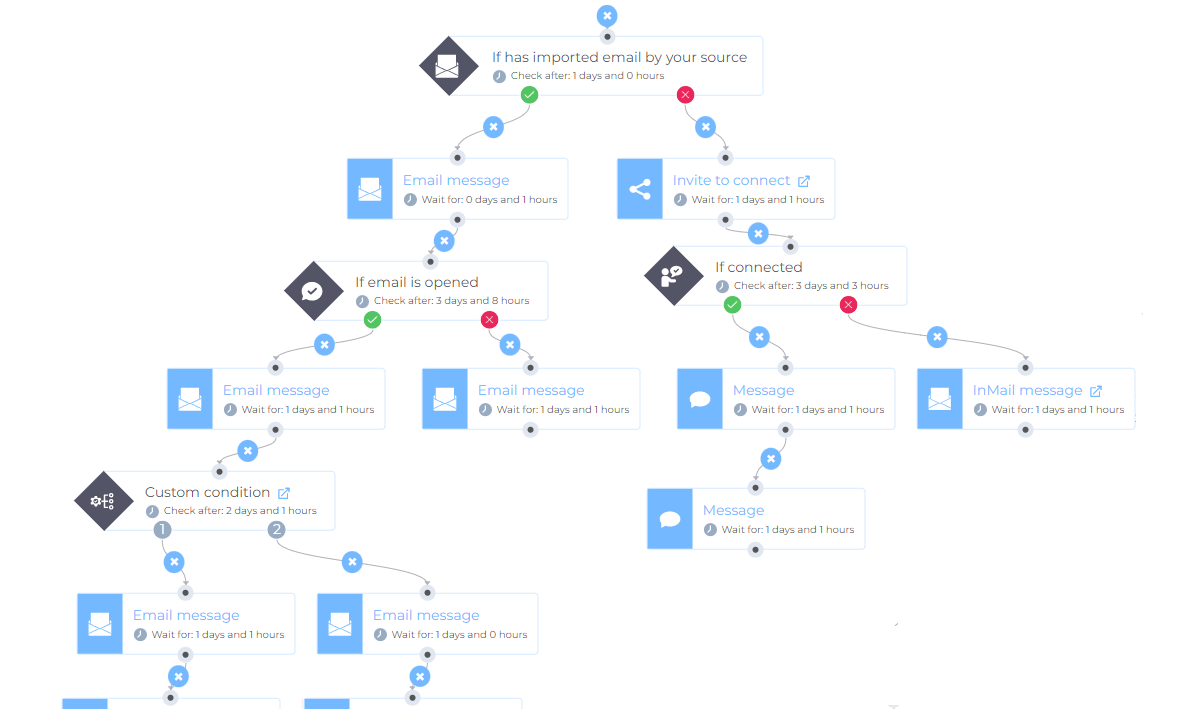
The good practice here is to start with valuable educational content, then offer a solution to the particular problem, and then present your product or service. In other words, never start the first message with your pitch.
Best lead generation automation tools
We will name a few best lead generation automation software and their Capterra scores. However, feel free to research other tools and check review websites should you feel the need to do so.
1. Skylead
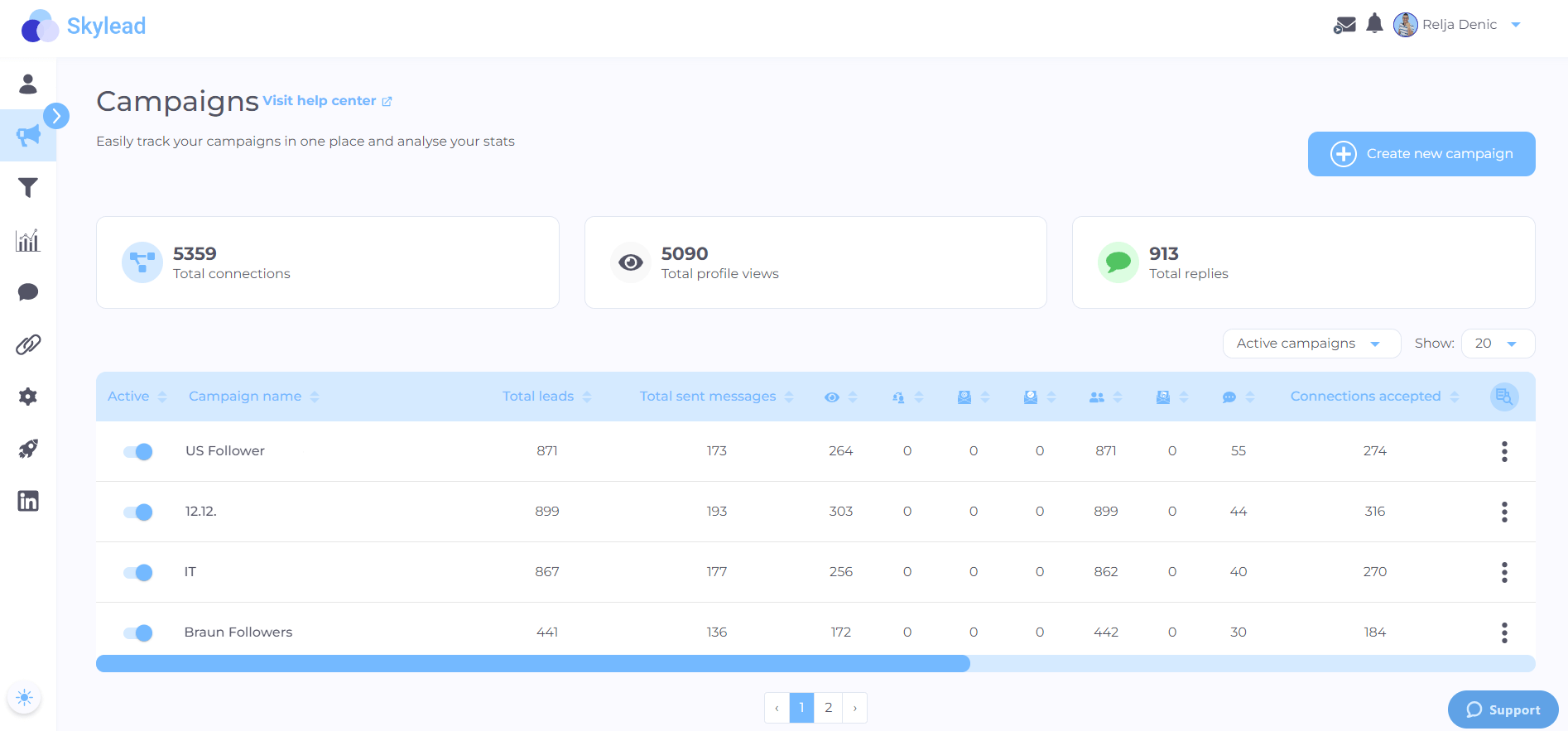
Yup. As we previously mentioned, that's us. 🙂
Skylead is a LinkedIn automation and cold email software that streamlines the most time-consuming marketing, recruiting and sales outreach tasks. In other words, these tasks include sending:
- LinkedIn connection requests
- Messages,
- InMails,
- And emails
to all your leads you imported into Skylead via LinkedIn, Sales Navigator, Recruiter, your CRM (using API) or CSV file.
Moreover, this software as a service allows you to also:
- Find and verify your leads’ email addresses,
- And use text, Image and GIF personalization in your communication.
What makes Skylead special are Smart Sequences and their if/else conditions. To clarify, Smart Sequences are action paths you create using the activities mentioned above and combining them with if/else conditions. This way, you can create countless scenarios that Skylead uses to outreach your leads according to their situational behavior.
That said, here is an example of one Smart Sequence.
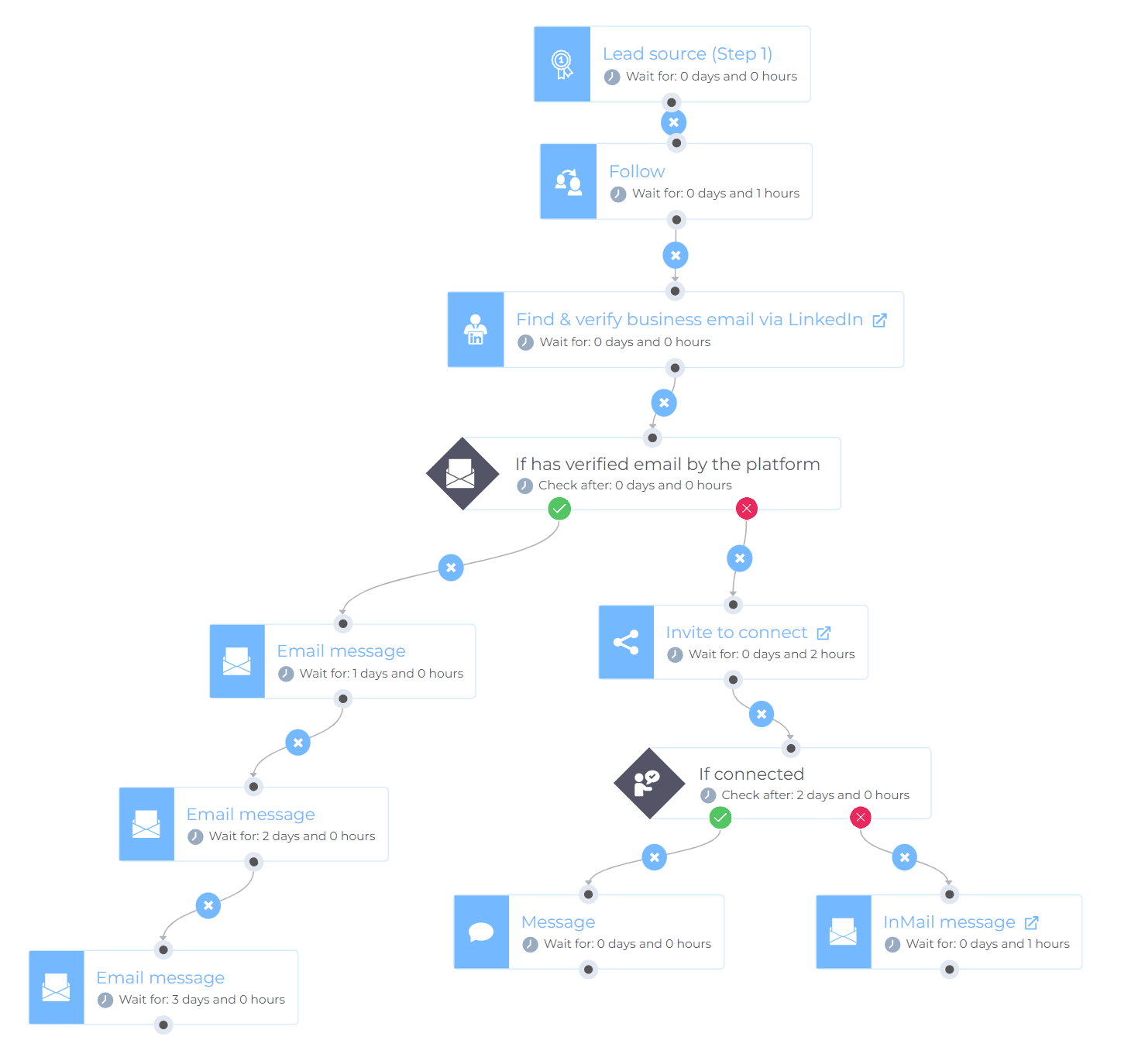
Moreover, you can connect Skylead with any tool, such as CRM using webhooks or API and push or send data.
Use cases
You can use Skylead for various reasons. However, we will mention a few depending on the team you might belong to.
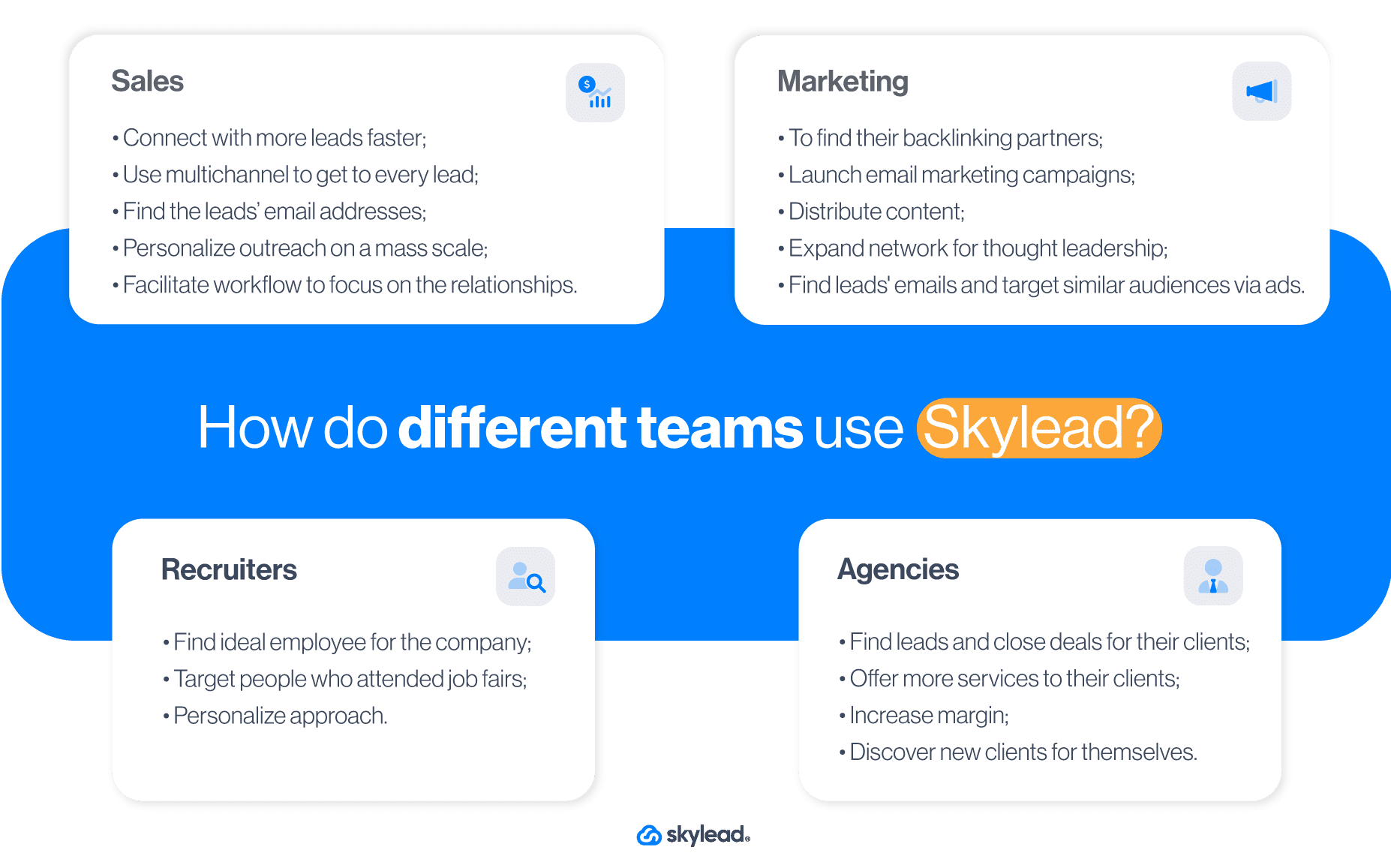
Pricing
Skylead has an all-in-one pricing plan of $100 per user/month.
Capterra score: ⭐ 4,8 / 5
2. OptinMonster

br]
This is another lead generation tool considered one of the best marketing strategies you can use on your website. Marketing teams use it for ecommerce lead capture. However, B2B marketers frequently use it for their lead generation efforts as well.
OptinMonster is a software that offers automated lead generation forms presented as pop-ups, slide-in windows, and gamified spin-to-win wheels. Moreover, you can place these pop-ups or forms on any landing page.
That said, these automated forms help you gather contact information to build an email list for your email campaigns, display personalized content, and nurture your visitors through their customer journey.
Features
OptinMonster’s main advantage is that it turns your website visitors into paying customers, webinar attendees, or newsletter subscribers. That said, many B2B marketing teams use these forms to increase any conversion rate, thanks to:
Page-level targeting
You can display pop-ups, forms, and notifications based on the user’s interaction with different landing pages.
Exit-intent technology
OptinMonster monitors visitors’ movements and detects when they plan to exit from the page without leaving their contact information or purchase. This way, you can increase conversion rates. Or, as a part of your content marketing strategy, gain additional newsletter subscribers, webinar attendees for future email campaigns.
Lightbox pop-up
This pop-up or notification appears thanks to triggers, and once it does, your visitors need to make a decision. What’s best is that there are no distractions, as your other website content can be faded in the background.
Onsite retargeting
You can show returning visitors something new every time they return to your website. Simply create pop-ups to show new promotions or offers based on their previous interactions on your website.
List segmentation
You can reduce website abandonment and churn by providing personalized content for your leads from the email list and website. What’s more, you can integrate OptinMonster with any CRM app, such as Hubspot or email automation software, to further adjust your messaging.
Pro tip: Create a synergy between your marketing and sales teams. Once you generate leads through OptinMonster, you can push them automatically to your Skylead sales or marketing campaign through API.
Pricing
OptinMonster has 4 pricing plans:
- Basic - $16 per month
- Plus - $32 per month
- Pro - $49 per month
- Growth - $82 per month
In addition, they offer around 40% off per month if you opt-in for an annual subscription.
Capterra score: ⭐ 4,3 / 5
3. Moosend.com
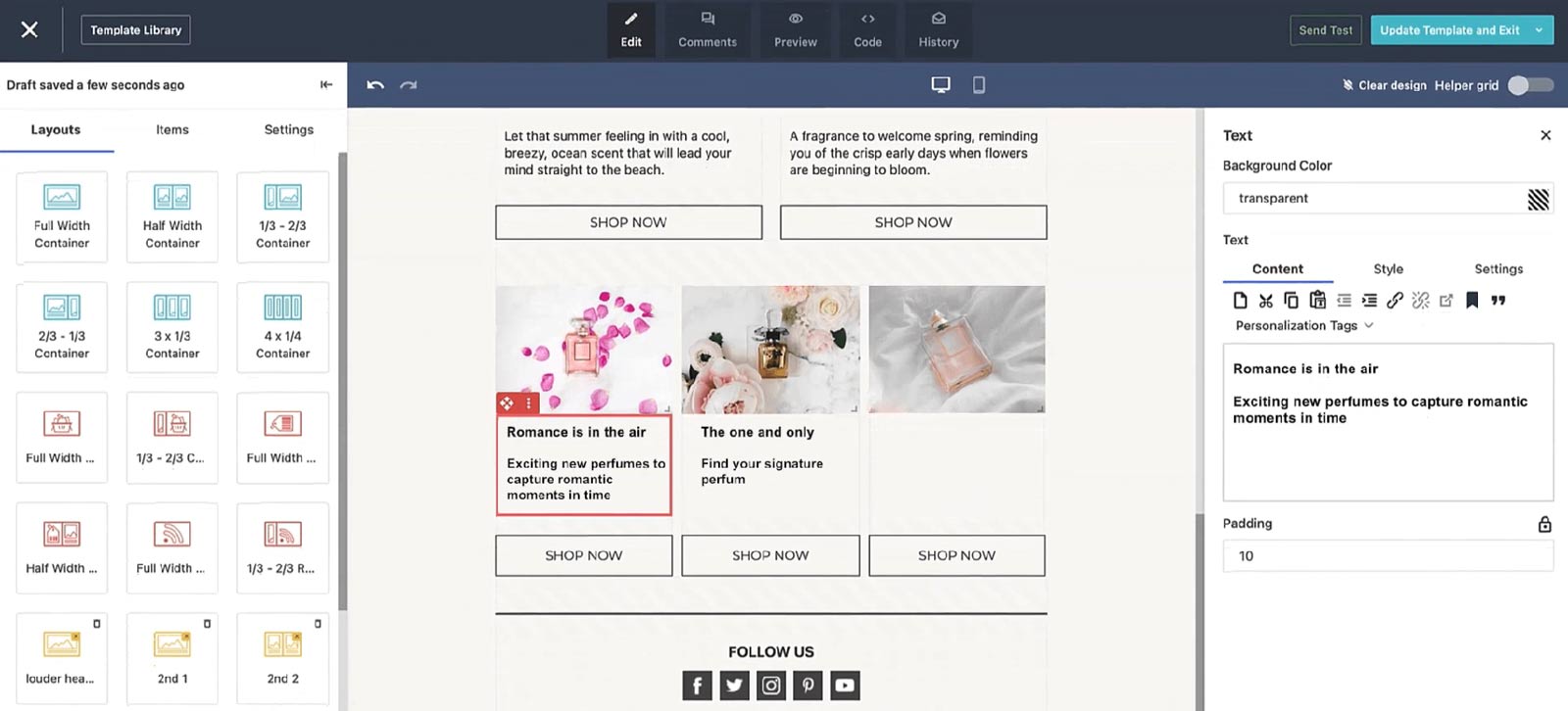
In general, Moosend is an email automation tool that helps you create and send personalized newsletters to your leads. It’s most suitable for small businesses specializing in e-commerce. However, this automation tool can be used for B2B email campaigns as well.
Features
One of the best things about Moosend is that you can create newsletters or pop-up banners with a simple drag-and-drop.
In addition, they leverage AI to analyze the data from your website, such as your subscriber behavior. This way, you can send more personalized messages or email notifications and maximize customer experience and retention.
That said, similar to Skylead, you can use this marketing automation tool to create a sequence with if/else conditions such as “if the purchase was made” and so on. This way, you can check for your subscriber’s actions and send suitable follow-up messages.
Moosend offers a vast library of templates to create newsletters or landing pages for email marketing campaigns. Whichever you choose, you’d be glad to hear that every template comes with device optimization functionalities.
Next, you can group leads from your email list and send separate messages. You can divide the leads based on keywords, if they clicked on the link in the previous email, etc.
Like OptinMonster, Moosend can help you gather new leads and increase your lead generation efforts. In other words, it offers customizable forms like pop-ups to promote your lead magnets, like webinars, and create email lists.
Lastly, you can integrate Moosend with your CRM, such as Hubspot, or other apps to streamline your related tasks.
Pricing
Moosend has 2 pricing systems:
- Pro - This plan is suitable for small businesses because it goes from as low as $9 per month for up to 500 subscribers. On the other hand, this plan goes as high as $5840 a month for up to 1M subscribers.
- Enterprise - The second plan is for agencies, and you need to contact Moosend directly to get a custom quote.
Capterra score: ⭐ 4,6 / 5
4. Mailchimp
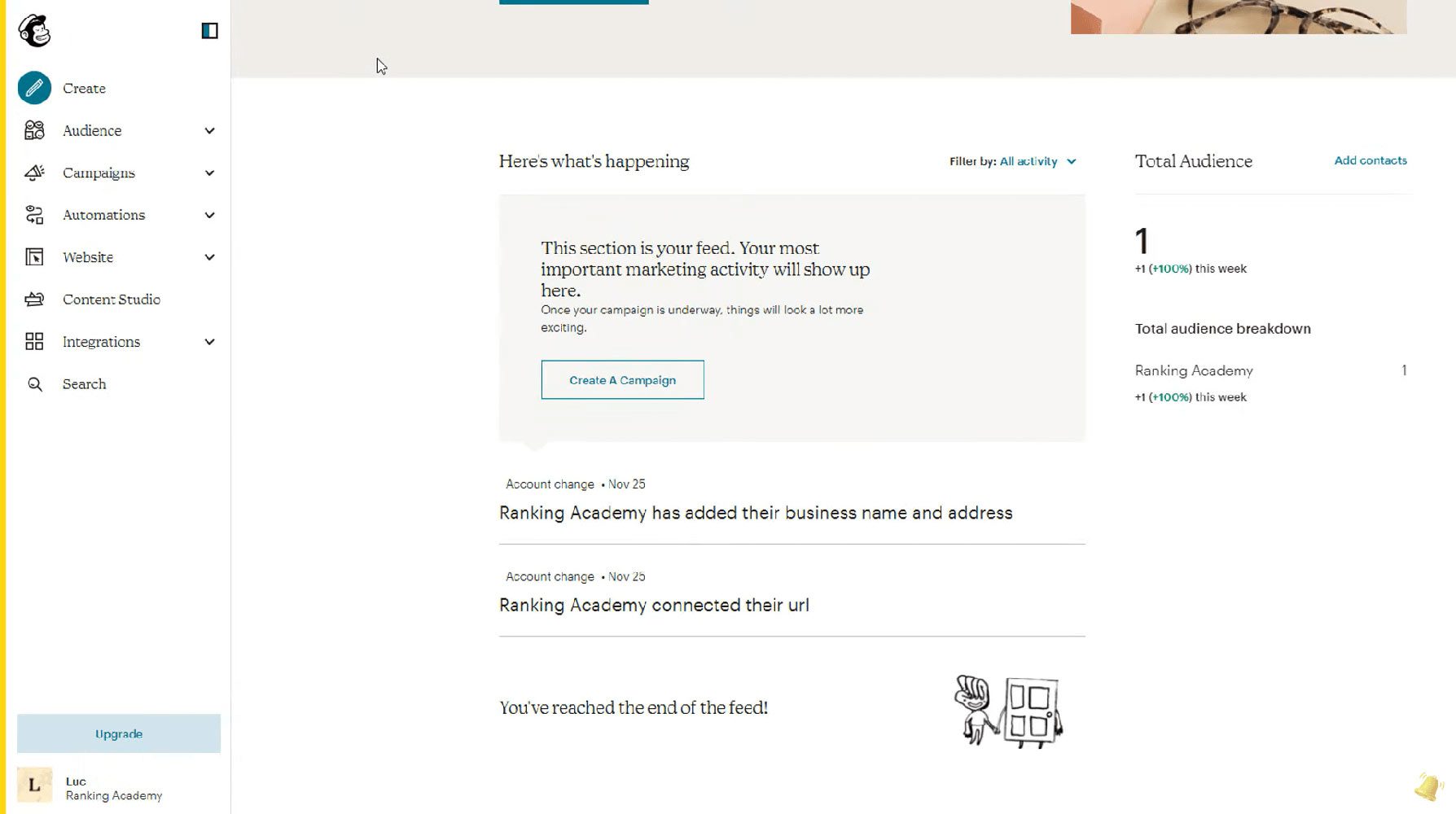
Another email automation software on our list is Mailchimp. This marketing automation tool started off as software for marketers to help them create newsletters in the e-commerce environment. However, it developed to be much more - a well-rounded automated lead generation tool.
Features
Email marketing
Firstly, Mailchimp offers an email automation tool for sending newsletters or other messaging material to your subscribers. You can create your own message design or use the template.
Regarding targeting, you can segment your leads based on their behavior, such as:
- Campaign activity,
- Location,
- If the last email opened,
- App activity, etc.
Lead gen
Mailchimp offers a couple of features that are perfect for B2B lead generation.
Firstly, they have their own website builder to create beautifully-designed landing pages for your new leads. In addition, you can make it from scratch or from the numerous templates they offer.
Secondly, they offer sign-up and pop-up forms for your website to generate potential customers. Moreover, you can also integrate their free appointment scheduling tool so potential leads can book calls with your sales team.
Lastly, Mailchimp offers a campaign manager that combines social media platforms, Facebook, Instagram, and Google Ads, into one dashboard. This way, you can target potential leads with similar interests as your current contacts. Or you can retarget visitors while they are browsing through the web or their social media.
Automated customer journeys
Last but not least, Mailchimp has a function to enhance user experience with Customer Journey Builder. In other words, you can automate activities, such as emails and follow-ups, according to your leads’ behavior and nurture them to conversion.
Moreover, you can integrate Mailchimp with any app, including your CRM of choice or LinkedIn outreach solution for omnichannel presence.
Pricing
Mailchimp offers 4 plans with the following highlighted features:
- A free plan is for up to 1K emails sent. It includes forms, landing pages, and pre-built email templates.
- The Essentials plan starts at $13 a month. This plan includes up to 5K emails sent, 3 audiences, and simple automated customer journeys.
- The Standard plan starts at $20 a month. It includes up to 6K emails sent, 5 audiences, enhanced customer journeys, newsletter templates, predictive analytics tool, and campaign manager.
- The Premium plan costs $350 per month. It includes everything from other plans plus 150K emails sent, and advanced segmentation and targeting.
Capterra score: ⭐ 4,5 / 5
5. Tidio
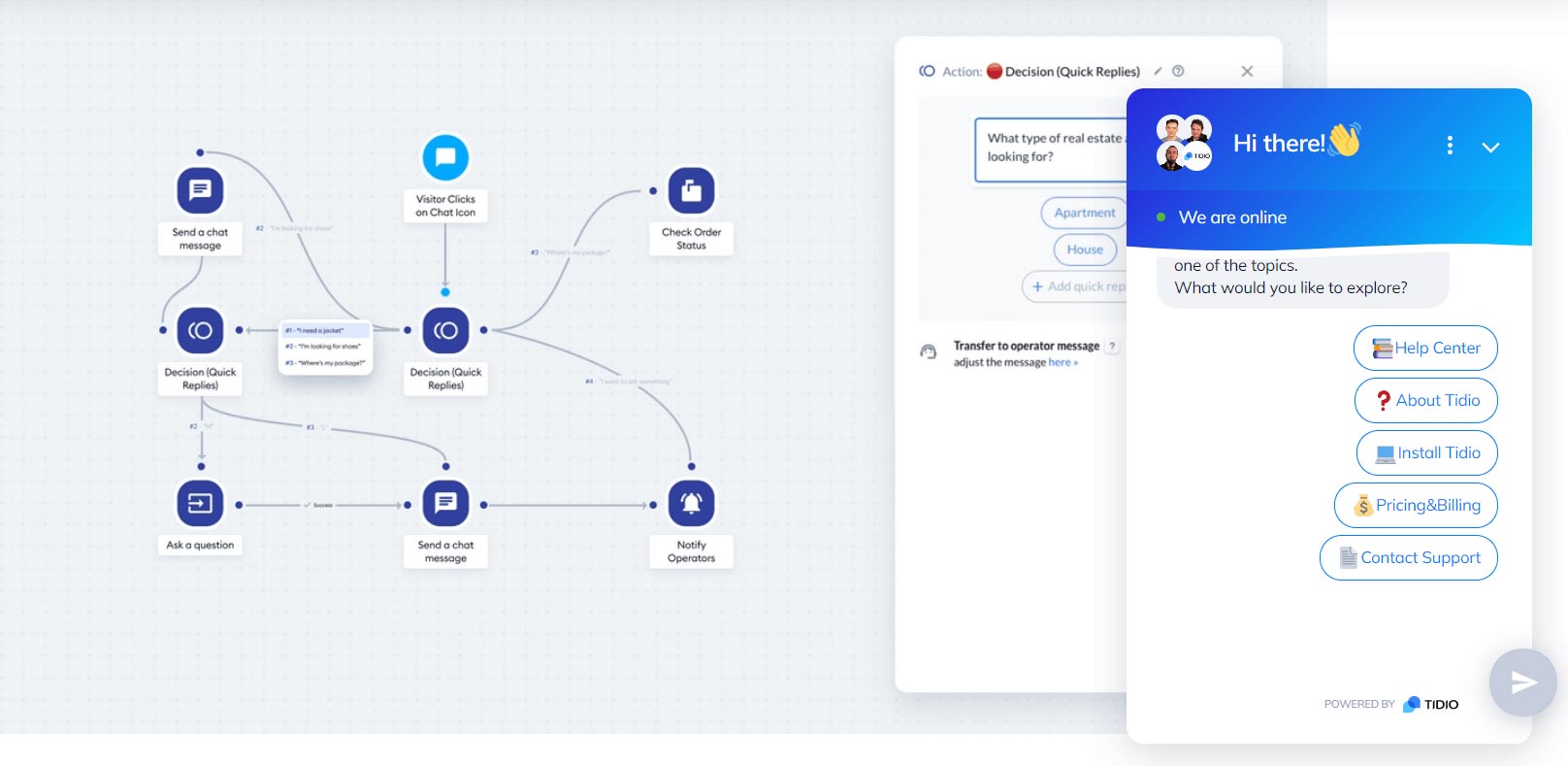
As mentioned before, one of the best lead capturing ways is using a live chat or chatbot. And Tidio is one of many on the market.
In other words, it can automatically collect and qualify leads based on their website behavior. For example, they can visit a pricing page, and if you offer a custom quote, a chatbot can ask if a person is interested in it, and they can leave the information.
Moreover, you can set Tidio to answer FaQs, offer news, or upsell your users. This way, you’re leaving time for your support team to focus on burning problems while improving your customer experience.
Pricing
Tidio offers a couple of pricing plans, respectively:
- Free
- Communicator: $19 per user/month (Includes live chat with an unlimited number of conversations and up to 5 operators);
- Chatbots: $19 per user/month (Includes from 1K to 40K triggers);
- Tidio+: $329 a month (Including both live chat and chatbot).
Capterra score: ⭐ 4,8 / 5
Automated lead generation examples
Here are examples of lead generation automation you can apply in your business right away.
1. Lead capture framework
a. Create a lead magnet
Craft valuable content like ebooks, masterclasses, templates, and webinars. In addition, remember that the content you create needs to resonate with your leads so they are willing to leave you their contact information. For example, you can offer a sales book with templates and cold outreach strategies.
Once you create your work, you can gather the info with automated lead generation forms. Moreover, you can link the forms to CRM for the sales to take over, or an email outreach tool so your leads can go straight to your email outreach list.
Lastly, to promote your lead magnet, you can publish ads to generate a large pool of leads. Or use pop-ups to promote the content throughout the website depending on users’ behavior.
b. Set up chatbots
Use chatbots to automate qualifying leads and gather their contact information.
You can set chatbot scenarios to offer the lead magnets or some free service depending on users’ website behavior. Or, if a person wants to contact your customer support, develop a list of qualifying questions. This way, the chatbot can send them to a database such as your email list or CRM. Moreover, your support team will get context about the leads.
2. Framework for finding leads
You can automate finding outbound leads by using prospecting tools such as:
- LinkedIn Premium or Sales Navigator to scrape publicly available info and profile URLs;
- Tools to identify your website visitors, such as Lead Forensics;
- Scraping tools for Facebook group members;
This way, you can build your lead list, send them to your CRM and prepare for email or LinkedIn outreach.
3. Outreach framework
a. Inbound outreach
Once you’ve got your inbound leads’ info, reach out. You can prepare a special cold outreach campaign using Skylead. In other words, create your sequence and craft your messages so they slowly turn the leads into paying customers.
For example, you can use Skylead to reach out to your leads via email. In other words, import your leads via CSV file or using LinkedIn, Sales Navigator, or Recruiter. Moreover, once you start your campaign, you can push leads from your email list or CRM using API.
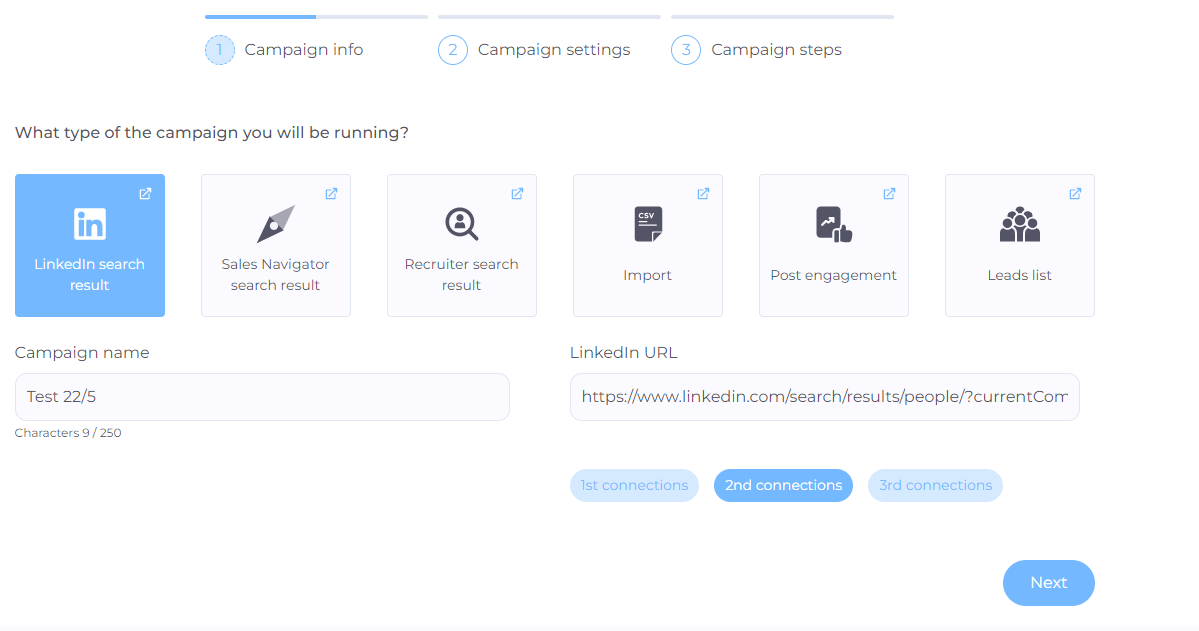
If you found your leads using LinkedIn but wish to send them emails, you can use Email Discovery & Verification feature as a step. This way, Skylead finds and verifies leads’ email addresses. So, you don’t have to use a separate tool to scrape email addresses. Instead, you have it all here in Skylead.
Then, create your Smart Sequence depending on their behavior (e.g., whether they opened an email or clicked the link). For example, your Smart Sequence can look something like this:
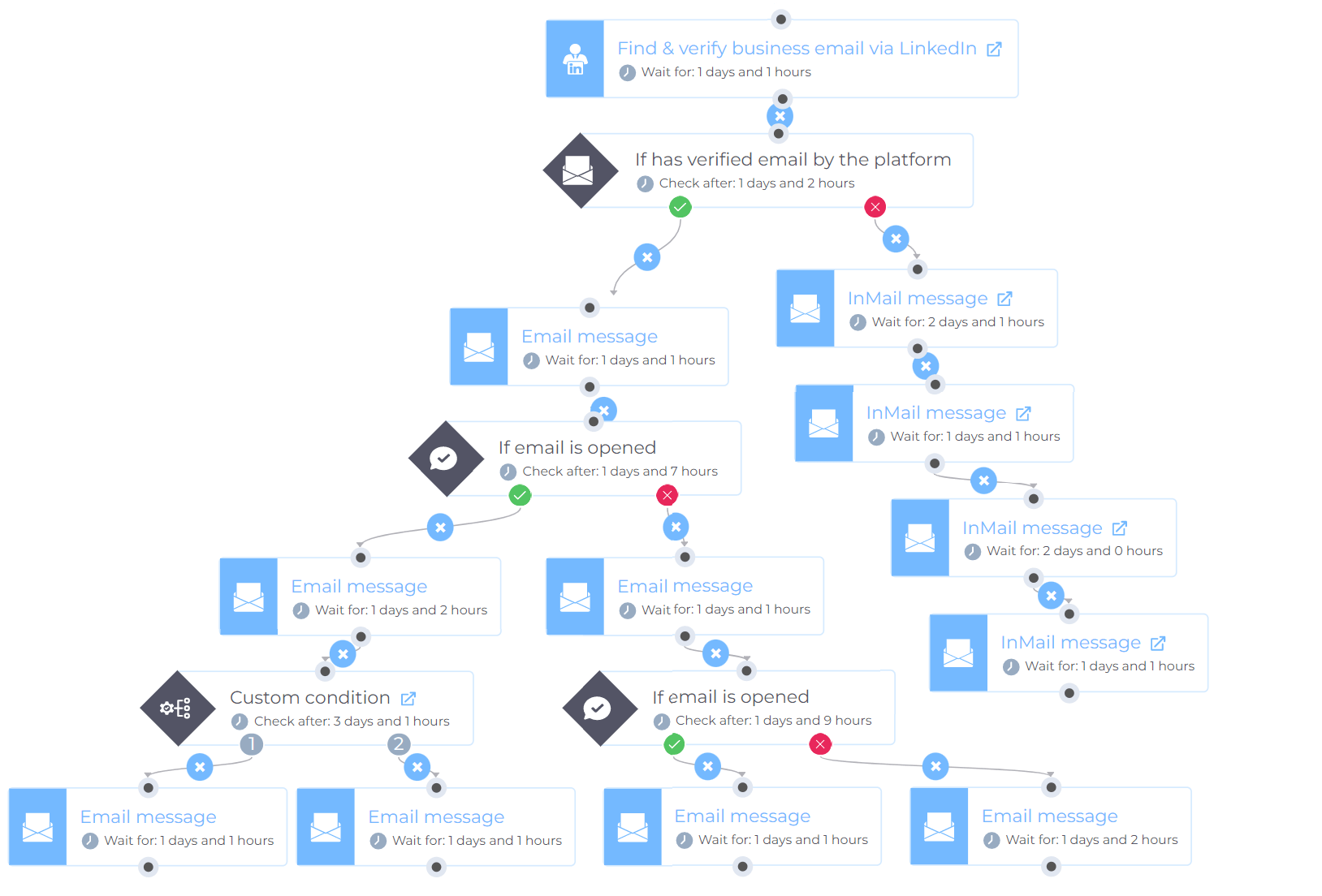
Lastly, write your sequence messages, and personalize them. Moreover, you can write up to 5 subject lines and the body variants to test and see what messaging drives the most results.
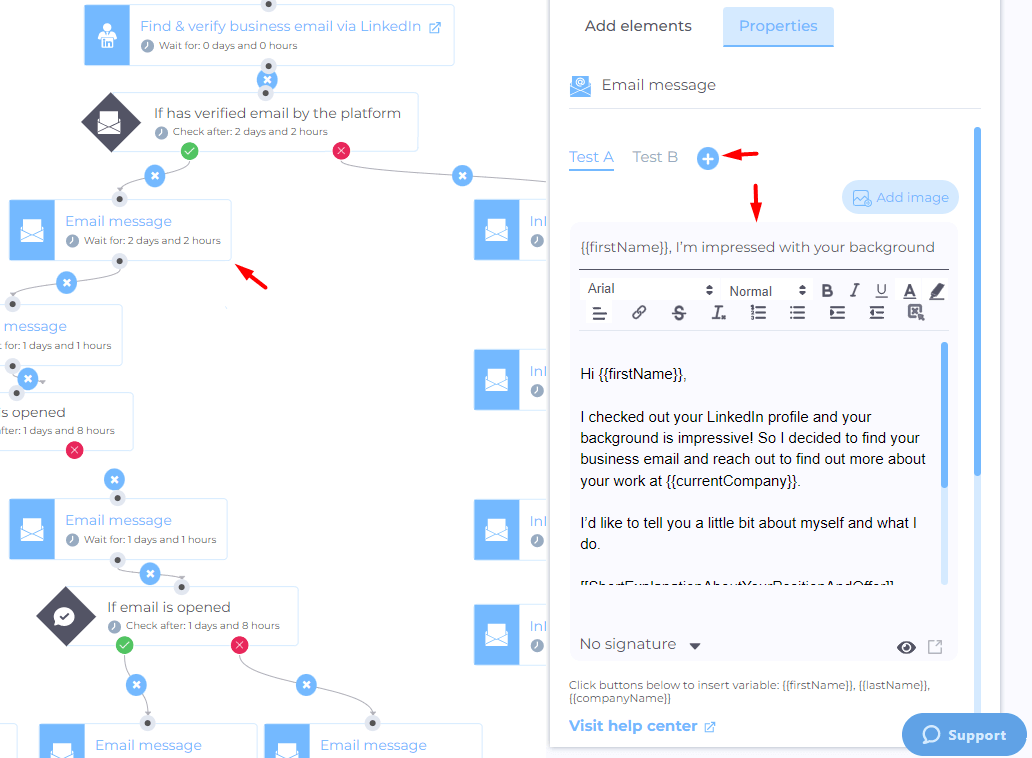
b. Outbound outreach
You can use Skylead to reach your outbound leads as well. To do this, repeat the steps above:
- Import leads;
- Create a Smart sequence;
- Personalize your Emails, LinkedIn connection requests, messages, and InMails.
However, remember that you will get the best results if you opt-in for multichannel outreach. That said, feel free to use LinkedIn steps such as Invite to connect, Follow, View, Message and InMail.
4. Customer and lead nurturing framework
You can automate lead nurturing by integrating your CRM with the outreach tool and exchanging the data between the two. This way, you can label leads, or send them to outreach campaigns.
In addition, you can use Skylead for your customer-nurturing program. That said, you can send automated outreach campaigns for:
- Churn customers if you have any special upgrade or to offer a discount;
- Current customers to send them personalize content, upsell, or offer help as their dedicated account manager;
Frequently asked questions
What are the ethical considerations when automating lead generation on LinkedIn?
When automating lead generation on LinkedIn, it's vital to maintain transparency and respect user privacy. Avoid spamming and ensure all automated interactions provide value to potential leads. Ethical automation respects LinkedIn's terms of service, focusing on building genuine connections rather than exploiting the platform.
How can businesses ensure the quality of leads when using automation tools?
To ensure the quality of leads when using automation tools, you should define clear target parameters and continuously refine your ideal customer profile. Utilizing advanced filtering options and personalized outreach messages can significantly increase the relevance and quality of automated lead generation efforts.
Can automation tools integrate with other CRM platforms, and how does this affect lead management?
Many automation tools like Skylead are designed to integrate seamlessly with CRM platforms, enhancing lead management processes. This integration allows for the automatic update of lead information and activities, providing a unified view of the sales funnel and enabling more efficient tracking, nurturing, and conversion of leads.
Skyrocket your leads and conversions with automation
80% of marketing automation users experience an increase in the number of leads, and even 77% an increase in conversion. That is no small number to ignore.
That said, we hope this article helped you understand how you can automate your lead generation activities.
However, before you do, create a good-quality basis for the automation, such as your website, content strategy, and LinkedIn profile. Only then will you be able to pave your way for successful lead generation automation.
After all, once you go automation, you will start looking at your other tasks and ask yourself:

Automate your outreach! Sign up for Skylead’s 7-day free trial.
It’s 2024, and LinkedIn is still the most essential and fastest-growing professional network globally. As such, it is full of potential clients, connections, and different growth opportunities.
It takes only one wrong step to lose the deal of a lifetime or make a wrong impression that could cost you money and your business image. That’s why proper professional etiquette is important for building and maintaining your brand.
To ensure this doesn’t happen to you, we decided to share how to network on LinkedIn and some dos and don’ts from our own experience.
How to network on LinkedIn
Networking on LinkedIn is a powerful tool for building professional relationships, expanding your career opportunities, and staying updated in your industry. And we, as a company, can vouch for that.
We’ve been in the industry for 5 years, and LinkedIn is our second nature. For example, our CEO, Relja Denic, first started networking on LinkedIn in 2019. Since then, he managed to gain about 25K connections and 22K followers. Not to mention our other crew members.
That said, here are the actions that will help you understand how to network on LinkedIn.
#1 Connect with people from your area of expertise
To expand your network on LinkedIn, the first choice would be to find people whose occupation is the same or similar to yours. You can exchange tips, tricks, and valuable resources.
That said, your connection request message can sound something like this:
Hey {{firstName}},
I saw that you are also {{Occupation}} and wanted to connect with you and exchange our experience, tips, and tricks. 😊
#2 Connect with your target audience
One of the best ways to network on LinkedIn and research your market is to ask your target leads yourself. Don’t be afraid of how to network on LinkedIn with them. Simply say you’re exploring their position and current challenges. Like this:
Hey {{firstName}},
I noticed you work as {{Occupation}}. I am currently researching {{Occupation}}’s challenges and pain points, so I was wondering if you’d like to connect and chat about it. 😊
#3 Attend LinkedIn events and mingle
Another way to network on LinkedIn is to attend LinkedIn events and chat with other attendees. To find a list of attendees, apply for the event yourself by clicking the Attend button.
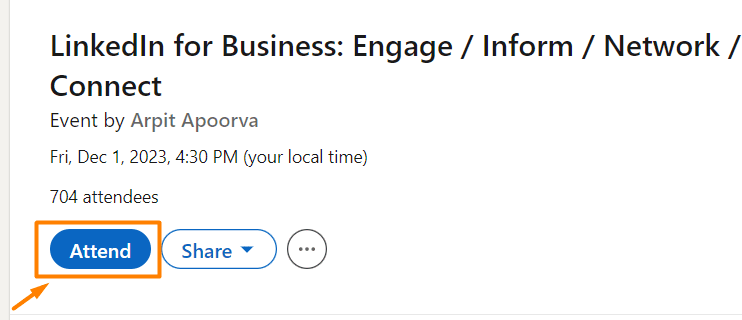
Then, hit Attendees to get a list of all the people who are attending the event.
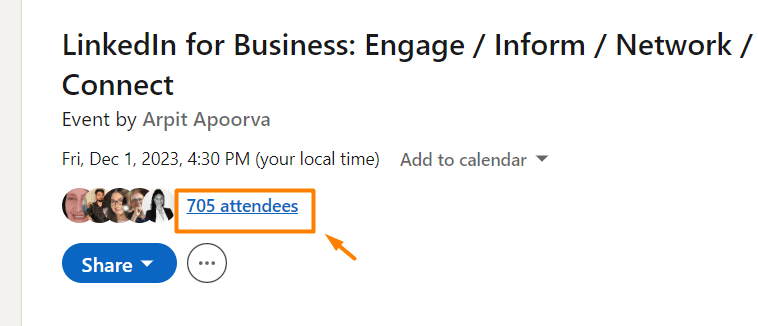
You can then send them a connection request such as this one:
Hey {{firstName}},
I noticed you’re also attending {{eventName}}. I’d love to connect and chat about our experience and the value we get from there!
Or you can simply send them a message from the Networking tab.

#4 Join LinkedIn groups
LinkedIn groups are considered to have no engagement whatsoever. However, that doesn’t stop you from approaching each member individually and genuinely connecting. That said, join the LinkedIn group that aligns with your and your potential client’s interests and industry.
Being part of a LinkedIn group whose members are from the same industry as you gives you a chance to learn from other people’s experiences, know what your competitors are up to, and connect with your colleagues.
On the other hand, being part of a LinkedIn group whose members are your potential clients helps you understand their needs, concerns, and what they expect from certain products or services (that might be the ones you are offering).
In any case, it’s a win-win situation!
Extra tip: You can also target members of a specific LinkedIn group if you upgrade your LinkedIn plan to Sales Navigator.
That said, to get to the members’ list, hit Show All in the upper right corner.
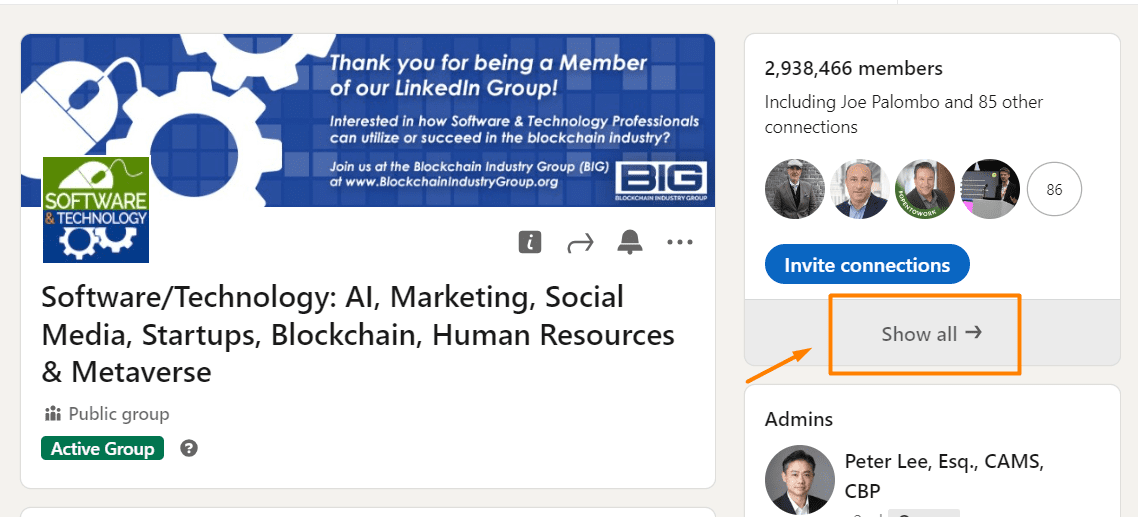
Then, send them a message explaining why you wish to connect with them. If, for example you joined a group with people from your industry, give this message a go:
Hello {{firstName}},
I noticed you are also a member of {{groupName}}. I would love to connect with you since I can see we're both in the {{industry}}.
#5 Create content and engage with people who comment
If you’re passionate about creating and posting content on LinkedIn, you should know that this can be another form of networking on LinkedIn. For example, a 1st-degree connection can comment on your post. In return, you can like their comment, respond, or message them and continue the conversation.
In addition, if your post reaches your 2nd or 3rd-degree connections and they comment or like a post, send them a connection request. However, be sure that your connection message is not out of context.
6 dos for networking on LinkedIn
Personalize invites to connect
LinkedIn is a place to network, but that doesn’t imply randomly adding anyone you run into.
It is rather a platform for meaningful business connections and as such it is highly recommended to reach out to people you either know or are interrelated with due to the nature of your industry.
Either way, it is always a good practice to send a personalized Invite to Connect.
Firstly, if you are reaching out to someone you don’t know, why risk being banned on LinkedIn in case they click on the I don’t know this person option? A certain number of these will get you restricted, you know?
Secondly, many people on LinkedIn appreciate Invites to Connect with an explanation of why they should connect with you. It doesn’t need to be a full-on sales pitch, but rather an interest or a reference in common. This is why a well-planned LinkedIn prospecting and targeting people attending the same event or those who are members of the same LinkedIn group can work so well to your advantage.
If you follow one simple tip such as this one, you will significantly increase your success on LinkedIn and stand out from numerous people who don’t consider it at all.
Complete your LinkedIn profile
Most people will not reply if your LinkedIn profile is incomplete. Or if they’re nice, they will do it reluctantly. This is because without a profile picture, experience, and LinkedIn summary, nobody can get an entire picture of who you are and what you’re about, and they would think the profile is fake. That said, to keep your integrity, finish up your entire LinkedIn profile.
Respond promptly
Just like with Emails, responding promptly to your Messages, Invites to Connect, and LinkedIn InMails is a sign of professionalism.
Good etiquette implies replying within 24 h.
Of course, the timeframe within which you answer is equally important to the content and tone of your message.
Any of the people you are responding to might be your future client, collaborator, or colleague. Make informed decisions and give confirmed information.
This way you will build the image of a trustworthy, knowledgeable professional with integrity.
And that’s what we all want, don’t we?
Introduce people
Introducing connections to each other creates positive social capital for you.
It shows that you genuinely care about people making meaningful connections that could benefit the industry.
Furthermore, a highly appreciated gesture of this kind will invoke the law of reciprocity.
Namely, your connections will most likely return the favor by introducing you to other professionals that are, in their opinion, good for you.
There is no better way of growing your business network than through positive word of mouth. Remember that the best advertising for business is free. But it takes time to build trusted and loyal connections.
So, stick to our dos over here.
Stay top of mind
Your lone presence on LinkedIn is not enough for staying top of mind of your connections.
- Post quality content.
- Respond promptly to Messages, Invites to Connect, and InMails.
- Congratulate people on promotions and new jobs in a professional manner, while still showing that you genuinely care.
- Respond to comments and reactions to your posts and tag people you are replying to.
- Post authentic responses to the most interesting discussions.
- Join LinkedIn groups.
Check your SSI
If you run out of networking ideas, check your LinkedIn Social Selling Index Score. It will show you your overall networking status and what networking area you can improve.
5 don’ts for networking on LinkedIn
LinkedIn is NOT Tinder
Avoid adding people just because you like their looks.
Avoid adding people just because.
Don’t start messages with “Hello Dear”, give compliments that are not business-related or argued, or send any type of messages with a strong personal note.
Not only will you be ignored, but you will be marked as a spammer, and most likely earn a reputation as a weirdo.
News travels fast.
People will not be eager to connect with you, let alone do any business with you.
Don’t spam people
Sending irrelevant, long, impersonal messages that don’t bring anything to any of the sides involved cannot earn you a good reputation.
It’s like a story of a girl who cried wolf.
If you keep sending messages that are only spamming other users, once you send something meaningful, nobody will be interested in reading it or answering back.
Save your Messages and InMails for significant business outreach and communication.
Your contacts will appreciate hearing from you less but leading insightful conversations regarding your industries or any other business-related topic.
Don’t post self-serving content
Whether sharing content or replying to messages or a discussion, make sure to provide value first and foremost.
The biggest mistake on LinkedIn is the misconception that people care about what you have to say. They only care about finding solutions to their problems or gaining valuable insights into the industry trends and demands. That’s all.
There is always a way of giving something to your readers while managing to promote your product or services.
Don’t ignore job proposal & invitations
Even if you are satisfied with your current job, you never know what the future holds.
Don’t burn bridges.
Answer to any job or business proposal you might receive. Be polite and professional.
Firstly, you don’t know if life will take you in that direction. The offered position might not even be in line with your future aspirations. However, have in mind that that company has other departments as well.
Secondly, the world is small. The Human Resources Manager that contacted you for that particular job might be the Human Resources Manager for another company in no time. And they will remember if you ignored or were impolite when they reached out.
The same applies to LinkedIn users who write to you regarding business opportunities and collaboration. Maybe you are not interested at the moment, but that’s for sure not the reason not to keep the door open for future contact.
Don’t talk negative about competitors
Social media can be such a negative space.
People have had it enough already.
Not only does everyone want to belong to a positive, proactive, and like-minded community, but posting negatively about your competition is a sign of bad sportsmanship.
Did you know that when you are talking badly about someone, people who are listening are subconsciously attributing all the negative features to you?
Treat others with respect just as you would like to be treated.
Also, have in mind that even when you are commenting on behalf of yourself, people might ascribe your opinion to the general attitude of the company you are currently working for. Be careful about it, especially on LinkedIn which is, as we said before, a professional network.
You are representing your brand, your company, and the industry at the same time.
Frequently asked questions
How can one measure the effectiveness of their LinkedIn networking efforts beyond the Social Selling Index Score mentioned in the article?
Measuring the effectiveness of LinkedIn networking extends beyond the Social Selling Index Score through the analysis of connection growth rate, the relevance of new connections in your industry, engagement (likes, comments, shares) on your content, and direct feedback from your network, reflecting the value and impact of your networking efforts.
What specific strategies can be used to recover from a negative impression or mistake made while networking on LinkedIn?
Recovering from a negative impression on LinkedIn involves acknowledging the mistake directly if it affected specific individuals, demonstrating professionalism in your response, and consistently sharing valuable content to rebuild your reputation. Engaging positively with the community and offering genuine contributions can gradually restore trust and credibility.
Are there any tools or features within LinkedIn that can help automate or facilitate networking activities without violating LinkedIn's policies on automation and spam?
LinkedIn offers several tools to streamline networking without breaching its policies, such as LinkedIn Sales Navigator for targeted connections and insights, and LinkedIn Learning for improving your skills and offering value to your network. However, you can use LinkedIn automation tools to build your network while respecting LinkedIn’s policies.
Now you know how to network on LinkedIn. Are you ready for it?
Networking, brand engagement, and generating leads on LinkedIn are the activities that are strongest than they have ever been.
Therefore, LinkedIn is not just your online resume.
It reflects your entire way of doing business and communicating with your leads and customers.
Everything that happens on LinkedIn has consequences, positive or negative, that you have to be ready to take responsibility for.
Since it’s better to be safe than sorry, stick to our tips and you will be just fine.
According to the ManpowerGroup survey from Q3 2021, 69% of companies and talent acquisition specialists around the globe reported talent shortage. Moreover, according to Officevibe*, some top candidates have a 10-day window before landing a job.
Now, with the short time frame and a small pool to pick highly-qualified candidates from, talent acquisition specialists are in a difficult position. If they wish to hire the best employees, that is. This is more than enough reason to roll your sleeves and research talent acquisition and how to ace it.
So, if you wish to help your company, and find the best talent out there, then get ready for the jolly ride. We will uncover everything there is to know about talent acquisition and reveal tips to help you hire the best talent out there.
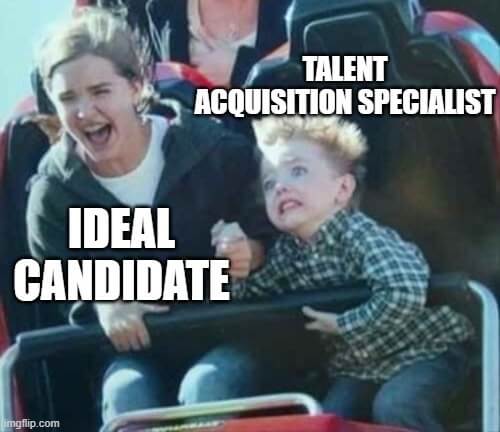
What is talent acquisition?
Talent acquisition is a process of recognizing and gathering the top employees for the company. In other words, talent acquisition means finding and nurturing the right employees according to the company’s needs.
The importance of talent acquisition has become evident to companies all over the globe, regardless the size. The reason is that talent acquisition specialists:
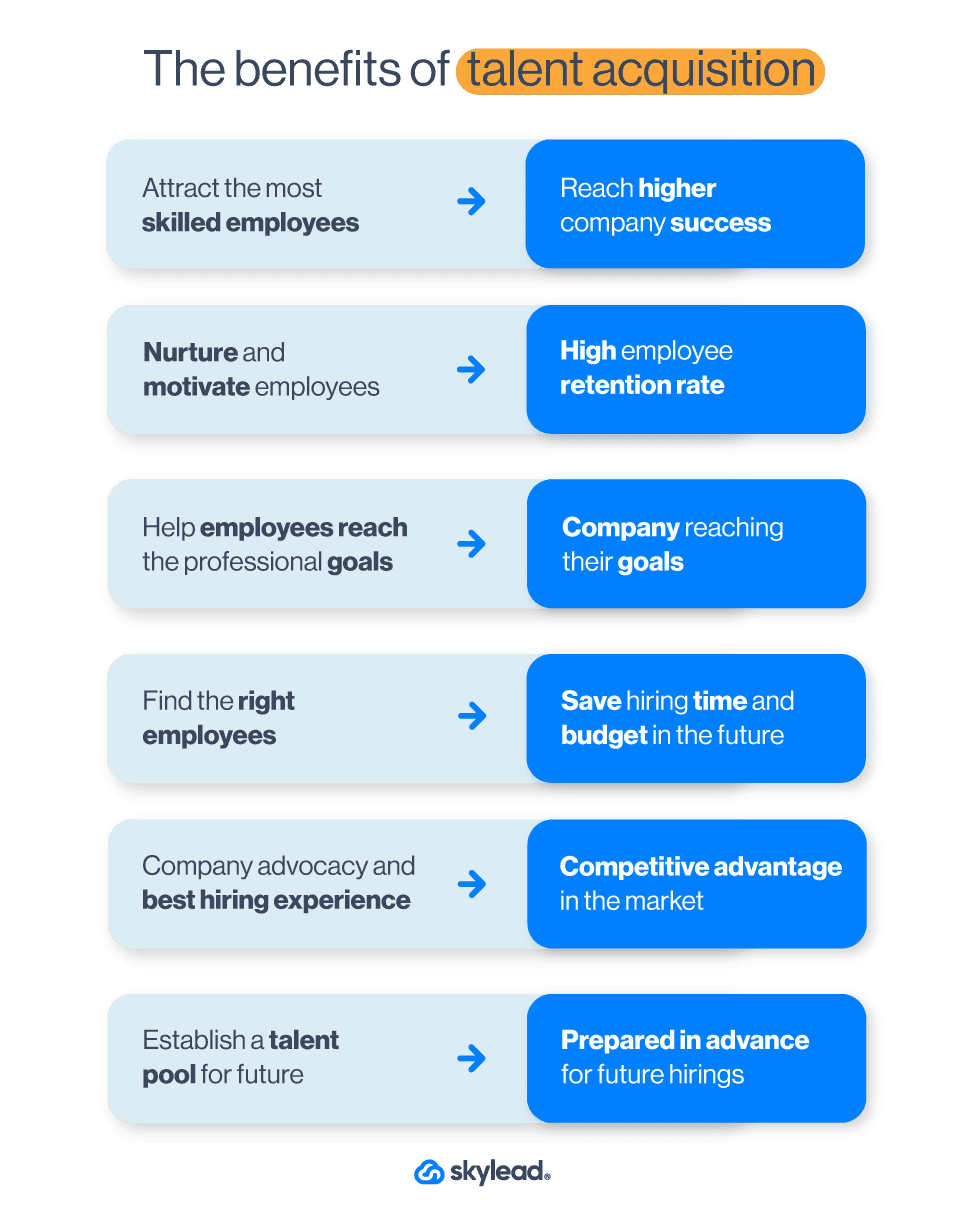
- Attract the most skilled employees on the market to fill the key roles according to company culture and strategy. This ultimately leads to the company’s improvement and reaching the desired results;
- Nurture and keep employees motivated, which leads to high retention rates and company advocacy;
- Develop and provide education to help employees reach their professional goals;
- Find the right employees and therefore save hiring time and money in the long run;
- Are advocates for the company and provide the best hiring experience, thus creating a competitive advantage in the labor market;
- Establish a talent pool for future hires, thus being prepared in advance.
And we just named a few 🙂
Recruiting and talent acquisition are often mistaken for one another. Yet, these two are the different sides of the same coin. Moreover, talent acquisition and recruiting may or may not be a part of the same sector. However, they are closely tied and cannot work without one another, which will cover in a second.
Talent acquisition VS recruitment
What is the Difference Between Recruitment and Talent Acquisition?
Talent acquisition is much more than just recruiting. It is a strategy on how a company should present itself in the labor market and become an ideal place to work in. Furthermore, the talent acquisition team is responsible for everything talent-related, including but not limited to:
- how to source the talent;
- supervise hiring;
- hire themselves in some cases;
- identify future leaders for the organization;
- lastly, they are responsible for screening candidates for leadership positions and the ones who need diversified training.
As opposed to the strategy, recruiting is the sole action of filling job vacancies and short-term company hiring requirements. In other words, recruiters:
- Find candidates or screen job applications;
- Interview candidates;
- Evaluate and select;
- Hire candidates.
What is a talent acquisition specialist and what do they need for a job well done?
So what does the talent acquisition specialist need to have for the job? First, they need to have a psychology background and to know their way around people. Secondly, they also need to know how to nourish relationships inside and outside the company. Thirdly, they need to keep employer branding at the highest level.
Another thing someone needs to have is strategic thinking and the ability to know what the company needs or will need in the future.
As their job is to find top talents, talent acquisition specialists need to know how to do their research. Moreover, they need to know how to track job search impulses, set candidate alerts, and find perfect candidates for the job at the right time.
Lastly, it is always handy to have a set of sales skills for interviewing top-tier candidates. To clarify, the sales skills will help you get the employee that does not necessarily wish to change their job but would be just perfect for the role.
Process of talent acquisition
Talent acquisition includes the following stages:
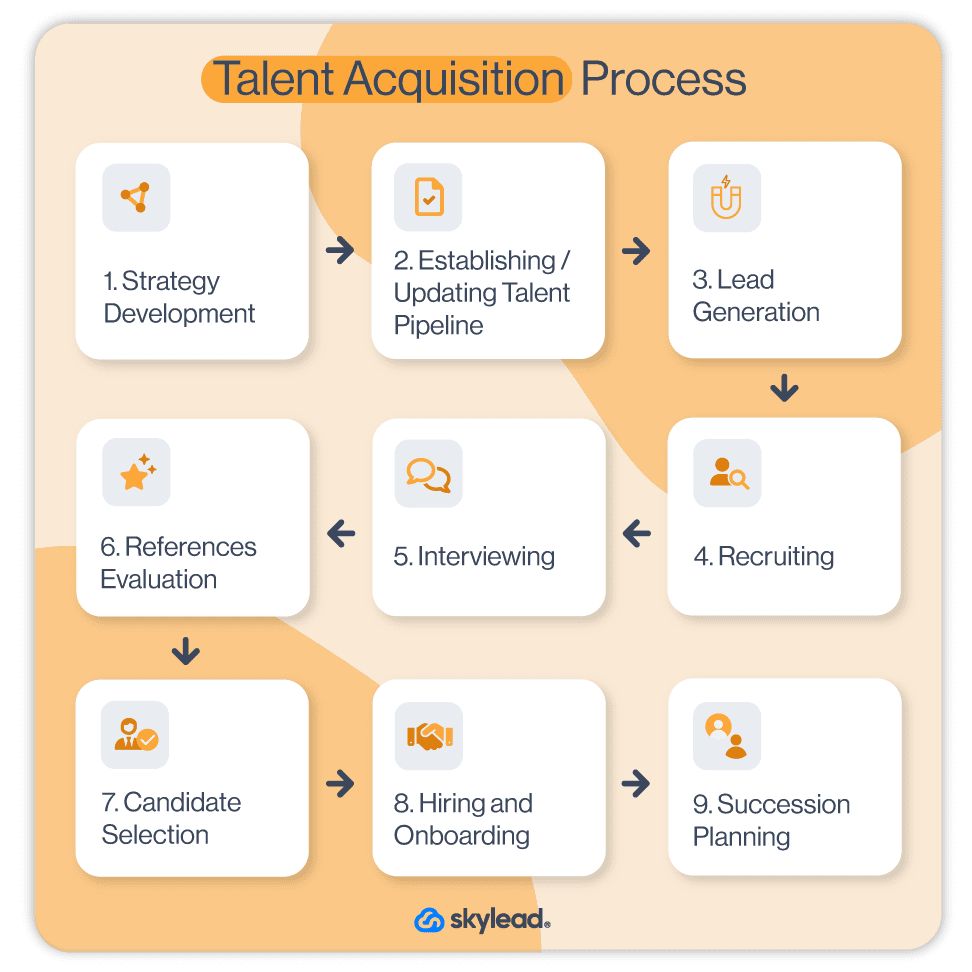
- Strategy Development
- Establishing/Updating Talent Pipeline
- Lead Generation
- Recruiting
- Interviewing
- References Evaluation
- Candidate Selection
- Hiring ( and Onboarding)
- Succession Planning
Let’s get into the details with every one of these activities.
1. Talent acquisition strategy development
Before developing any talent acquisition strategy, one must first define:
- The company’s position in the market;
- Budget available for talent acquisition activities;
- Who the competitors are;
- Competitors’ labor market behavior and their funding (if available).
Once you establish the previously mentioned, you can use that information to plan your strategy carefully.
There are two types of strategies that go hand in hand:
- Employer branding strategy
- Talent finding and acquiring strategy
The strategies can be any combination of activities. Participate in job fairs and universities, boost your employer's brand awareness and gather early talents, or referral programs, sponsor job fairs, and even outsource some parts of the process to RPO companies, for example. Only, whatever you decide your strategies are, be detailed, organized and mindful of your company’s industry, needs, and the budget.
2. Establishing talent acquisition pipeline
As talent acquisition strategy depends on talent pipelines, you need to create a mechanism to keep them full at all times. If your talent flow for every position in your company is continuous, you will always have someone to pick and choose from, should the need arise.
Otherwise, you need to discover what makes your pipeline “leaky” so you do not waste additional resources to fix the damage every time.
3. Lead generation
Once you have your strategies and talent pool in place, you need to define the online (and offline) channels you will use to find and generate your leads, aka candidates. Next, you need to write an alluring job post and an application form to start filtering out and identifying the best candidates. Lastly, distribute them across defined channels and according to your strategy.
4. Recruiting
If your company doesn’t have a separate recruiting sector, get ready to roll your sleeves. Recruiting is much more than just interviewing the candidates and choosing the right talent. Remember, they are also choosing you.
So apart from standard recruiting and evaluating the applications that landed in your inbox, you need to do something extra. Firstly, establish ways to create a positive experience for your candidates. Secondly, nurture them throughout the process. Lastly, keep the relationship with those who are not currently your ideal match but someday they might be.
5. Interviewing
This is where your psychological background and sales skills really shine. When interviewing the candidates, talent acquisition specialist should ask a series of questions related to:
- the candidate's specialty;
- problem-solving skills;
- resourcefulness.
And not to forget, they need to figure out if the candidate has skills for any current or future positions.
Interviewing is usually held between 2 to 4 instances, depending on position seniority. However, talent acquisition specialists are trying to shorten the number of instances to provide as pleasurable an experience as possible.
6. References evaluation
Talent acquisition specialists often forget to cross-reference the information their candidates provide during the interview. Reference evaluating can provide another perspective on your candidate, confirm your thoughts and opinions, or provide additional information you wouldn’t find anywhere else.
7. Candidate selection
Talent acquisition specialists and recruiters lean on many metrics and systems to make data-driven decisions and select the top candidate for the job. Some of them include candidate scoring, internal evaluating systems, and even software that can do that for them. So be sure to research these systems and choose one which works best for both you and your company.
8. Hiring and onboarding
In some companies, talent acquisition teams also onboard new employees. Thus, apart from showing them around the office, or workflow, talent acquisition specialists are responsible for establishing new relationships. That said, incorporating efficient Applicant Tracking Systems (ATS) can greatly facilitate talent acquisition specialists in streamlining the onboarding process, ensuring new hires are integrated smoothly into the company's ecosystem.
9. Succession planning
The last activity that talent acquisition specialists need to do is succession planning. a process of identifying and finding substitute candidates for the leadership roles within the company in case something unexpected should happen or in case of retirement.
Succession planning is beneficial due to several reasons. Firstly, the company is always ready for any unexpected events. Secondly, it encourages employee development within the organization. Lastly, succession planning allows filling the roles quickly without losing much of the workflow.
15 Tips and best-case practices to improve talent acquisition activities
1. Minimum requirements
When creating a job description, it’s best to define the minimum and the maximum requirements someone needs to have to be qualified for the initial interview. To clarify, the reason for the minimum requirements is that you might meet someone who doesn’t have the highest experience you need, but they might have it in the future.
This means you can put them straight into your talent pool and contact them at a later stage. Or perhaps the person with less experience is a perfect match according to other company parameters (e.g. cultural, behavioral), as opposed to the one with the maximum requirements.
2. Collaborate with other sectors
Every sector and job position within the company has its specialties and expressions different from what the talent acquisition team uses. It’s okay not to know them all, as long as you keep collaborating with the rest of the company during the previously mentioned process for individual positions.
3. Write job post that is alluring
With each vacancy comes a special job description. So, be aware of what kind of talent you wish to draw to your company and write job posts to appeal to them. Spice it up with some benefits, perks, and employer branding testimonies, and you’ll be good to go for initial lead generation.
4. Remote or hybrid workspace
To stay competitive in the labor market, you must keep up with the trends. And one of the most popular trends now is precisely Remote or Hybrid workspace. Be mindful of this, and if your company doesn’t offer a fully remote position, at least offer a hybrid position, so you don’t lose top talents over this.
5. Where to build a pipeline?
Different talent acquisition teams use different platforms to help them build their talent pipeline and keep track of the candidates. That said, the most widely used is LinkedIn Recruiter or Recruiter Lite, which allows you to get candidates inside the pipeline with just one click and to the appropriate pipeline stage.
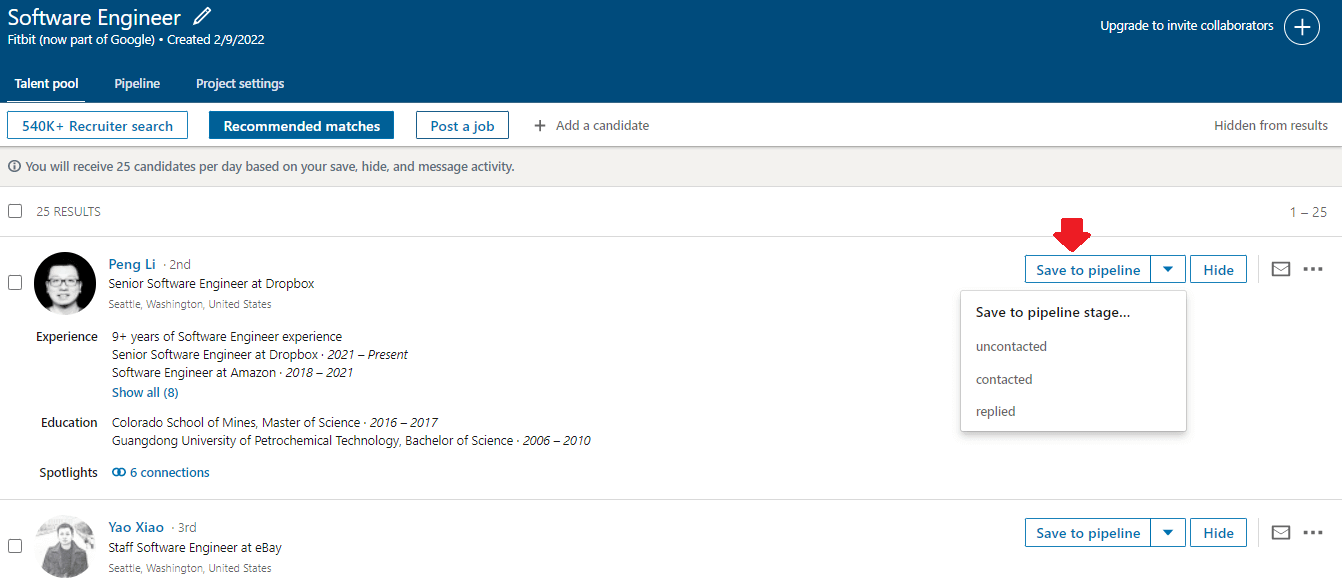
6. Include your co-workers in the process
It’s nifty to discover alternative ways to find and generate your candidates. However, remember that you, as a talent acquisition specialist, are not alone in your company. Thus, think about creating a referral program for your employees.
Your co-workers are the next best thing to know what kind of personnel your company needs, and if you set proper awards, you are more likely to find the right candidates quicker. After all, there is a “Six degrees of separation*” theory stating that any person can be connected to any other person in the world through six intermediaries at most.
7. Don’t rush
Finding the right employee is not an easy task, especially if we talk about C-suite positions. Thus, take your time and do not rush any activity. If you are thorough and dedicate time to each part of the talent acquisition process, you will save resources in the future.
For example, most talent acquisition specialists use LinkedIn Recruiter, and the one thing they never rush is filtering the right candidates for the job. Thus, take advantage of every LinkedIn Recruiter filter and take your time zeroing in on the candidates you will reach out to.
8. Research your candidates
If, for example, you use LinkedIn to find candidates, you should consider the following advice.
Firstly, to laser-target your candidates, be sure to specify your search as much as possible. In other words, use filters to import the most relevant skills needed for the role.
Secondly, when looking at LinkedIn profiles, observe the diversity of interests a person has. The information you find will contribute to your company and imply what you need to do to achieve employee satisfaction.
Thirdly, if you are searching for the people to fill in higher-up roles, be sure to analyze the skills they possess that served them in the previous positions that can be usable for the one you are reaching out to.
Lastly, if, for example, you're searching for a team leader for your programming team, you might consider how the team could contribute to the team leader’s development.
9. Streamline a part of your talent acquisition process
If you headhunt using LinkedIn Recruiter, then you must’ve experienced how tiresome it is to reach out to every person on the list manually. Luckily, you don’t have to. You can streamline your outreach process by getting a solution to do it for you and thus save so much time.
Take Skylead, for example. You can create an outreach campaign quickly and easily. Firstly, take your LinkedIn Recruiter pipeline or talent pool URL with all the candidates you found by prospecting on LinkedIn.

Then, go to Skylead and paste it into the respective field. Be sure to name your campaign, and select the type of campaign.
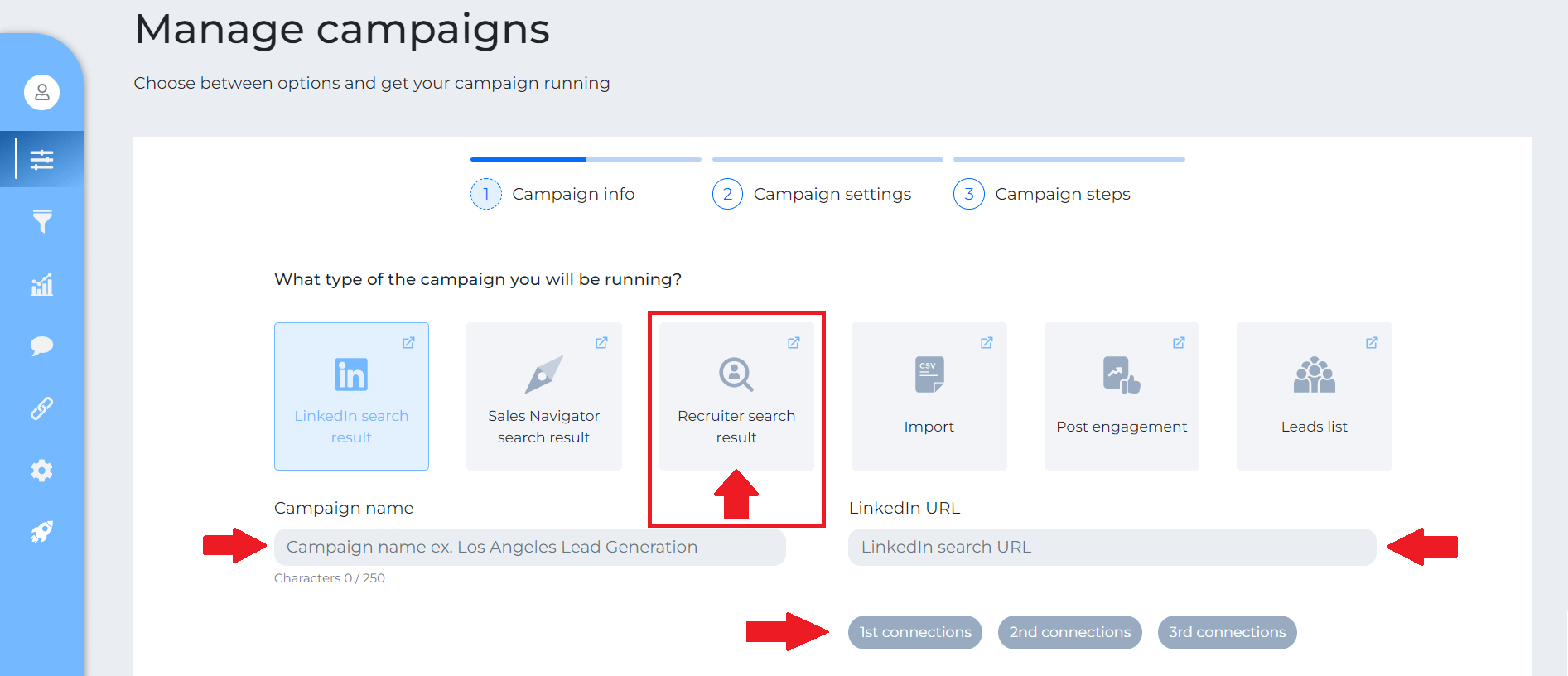
Next, create your Smart Sequence steps and your messages. To clarify, Smart Sequences are Skylead’s groundbreaking algorithms. They allow you to use multichannel outreach and personalization at scale.
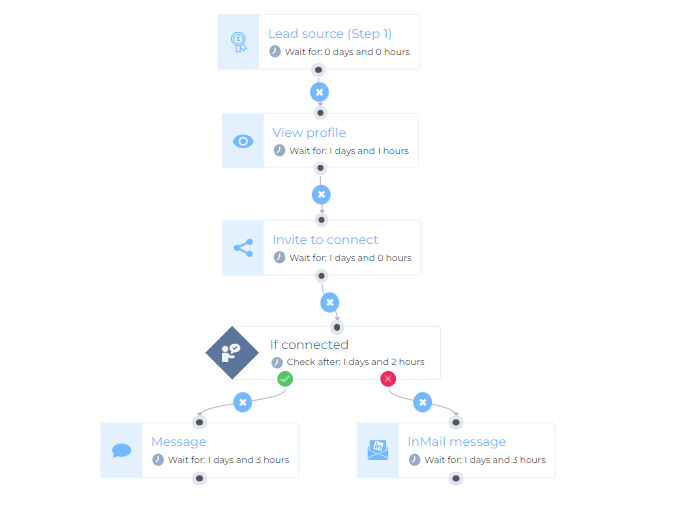
And you are done!It is that simple.
Skylead can also help you schedule your interviews from the Smart Inbox, so there is no need to navigate between the platforms.
10. Personalize your messages
Nobody likes getting generic emails, nor will your ideal candidates for the top-level job. Thus, to provide the best experience for your candidates, make sure to personalize your outreach according to their resume or LinkedIn profile. For example, include their name, position, or the skills that stood out to you the most.
11. Don’t forget to proofread
Typos, wrong names, and grammatical errors in your email can come across as unprofessional and can put your company in a bad light. So, to avoid this, edit, proofread your messages, and double-check contact information for any mistakes before sending.
12. Timing is everything
Good timing is a desired virtue for talent acquisition specialists to have. Timing to recognize and outreach candidates at just the right time according to their job search impulses.
However, there is one other timing equally if not more important than that - responding to your candidates on time. If you wait too long, especially if you hire management roles, you risk losing your candidate’s interest and someone else taking them over.
13. Choose your questions carefully
Sometimes the candidates won’t be as direct as you would like them to be. So, to get the information, you need to get creative during the conversation. The best-case approach here is to ask so-called probing questions to specify their response. In other words, you can ask them a series of questions like:
- Tell me, how did you manage a group of people to achieve the best productivity throughout the day?
- What objectives did you set for the group?
- How did you motivate them?
- What was the most difficult part of this task?
In addition, take note of what the candidate asks you in return, how they prioritize their interest for the role, and what they are curious about the company (benefits, conditions, market share, organization culture, etc.).
14. How should talent acquisition team choose the best candidate?
Selecting the right candidate for the job can be a hard decision for a talent acquisition specialist. If you are lucky, you can pinpoint the person you wish for your organization. However, what to do if you have two or more top talents in your hand?
Hire them all 🙂
Jokes aside, here is what you can do to ease your decision.
The first thing you need to pay attention to is authenticity and synchronicity between the candidate's personal preferences and the information you get from the interview. In other words, analyze verbal and non-verbal communication, and the thought process and write your observation down.
The other thing you can also do is to walk the candidates through questions about personal preferences of informal, trivial topics and get to the main questions later. Using this method, the candidate could reveal themselves through potential incoherence.
Once you have all data in place, choose the candidate with the smallest amount of discrepancy and highest compatibility.
15. Honesty is the best talent acquisition strategy
Somehow in the business world, we always come back to honesty, and talent acquisition is no exception. I mean, have you heard about Microsoft’s promise to disclose salary ranges in January 2023?
Many talent acquisition specialists are true advocates for honesty, and there are major reasons for that. Firstly, it adds to the authenticity. Talent acquisition specialists often share why they work in a particular company, their motives, and what motivates them the most to be where they are. This way, candidates can see the true passion in the conversation and wish to work in that company, as well.
Talent acquisition specialists and recruiters thus act as a live banner of the company. If the candidates do not resonate with the passion, it’s best to reveal it from the start - it will save you so much time in the future.
So, keep in mind that being honest and believing in your company is one of the best things you need to show to your candidates. Not only will you filter and acquire the best candidates, but you will also contribute to the Employer branding strategy.
Lastly, your honesty and passion will be such a strong argument that negotiations and whether someone wishes to work for the company won’t even be a question anymore.
Summary
Talent acquisition and the labor market are one of the most changed segments due to technological development in the last couple of years. Apart from company Goodwill, talent acquisition sectors are the ones that represent a company directly to the outside world.
Speaking from the company’s point of view, it pretty much became a standard to have talent acquisition specialists simply because of all the benefits it comes along: from resource savings to reaching higher goals by finding a perfect match and employee satisfaction.
However, none of it comes without the talent acquisition team’s hard work and activities that involve:
- Strategy Development
- Establishing/Updating Talent Pipeline
- Lead Generation
- Recruiting
- Interviewing
- References Evaluation
- Candidate Selection
- Hiring ( and Onboarding)
- Succession Planning
And let’s not forget that our trusted talent acquisition specialists are go-to guys for everyone in the company. They are somewhat of our genie in the bottle for professional development.
Nonetheless, talent acquisition specialists can perfect their craft by following the tips and best-case practices mentioned above. Lastly, people are dynamic, so if you, as a talent acquisition specialist, help others develop their talents, don’t forget about yourself.
Wish to discover how to streamline your talent acquisition process? Check out Skylead and schedule a Demo!
What would you say is the first thing that catches your prospects' attention in their inbox? That is right, email subject lines. They are undoubtedly the most integral part of your cold email outreach. In just seconds, the faith of your outreach success is determined.
How? Well, if you do not create catchy email subject lines, you risk getting your email deleted, your open rate becomes much lower, and you will be disregarded as Spam. Consequently, this ultimately leads to a lower number of warmed-up leads and closed deals. Furthermore, effort and time spent will go to waste.
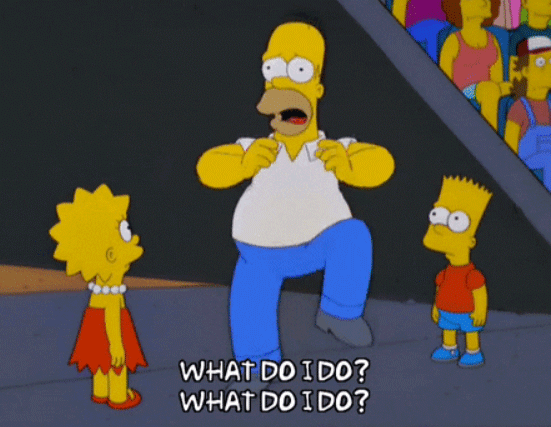
Don’t panic. We’ve got your back.
In this article, we are explaining what the subject line is and why it is important for your email outreach. Furthermore, we are digging deep into catchy email subject examples, why they work, and help you create your golden subject line that catches your prospects’ attention immediately.
What is an email subject line and why is it important?
Let’s start with the basics. When you open up email inbox, you can notice the 3 following components of the email message:
- Senders’ name,
- Subject Line,
- And Preview text.
Email subject line is a text line next to the sender’s name, describing the title of the email message. In other words, it is an indication of what the message is about and why you should read it.

Email subject line communicates value, sets expectations, and entices recipients to discover more about the topic by reading the email message.
Getting your email subject line just right will make you stand out in the sea of other emails and increase the open rate. In sales terms, this means increasing the chances of getting your message across and warming up leads so you can close more deals.
Another thing worth mentioning is the importance of the Preview Text.

A preview text, aka preheader text, is a line next to the subject line that shows the beginning of your email message. In some cases, preview text can be custom-made if you use newsletter software or similar tools, but in most cases, it shows a preview of your message. That is why it is important to perceive them in synergy rather than separate components to make your outreach as effective as you can (but we will talk more about this below).
How to write catchy email subject lines: Tips to get started
Email subject lines’ first and foremost purpose is to get your prospects to open up your email. In other words, you need to catch their attention and entice them towards this action.
Therefore, make email subject lines mean something. Let’s go through a couple of steps to get started.
1. Determine the type of subject lines
As a salesperson, especially when doing a cold outreach, your job is to set the tone of the email subject lines. There are many ways to do it - making bold, sweet, or commanding statements - but first, you need to figure out the email content. After that, write down the email core meaning, and choose the type of tone which best fits your outreach message, personality, and prospects’ preferences.
The usual subject line types for sales are:
| Email Subject Lines Types | Email Subject Lines Examples |
| Controversial | LinkedIn is not for outreach if… |
| Lack | Poor quality data costs you. Here’s why… |
| Personalized | Amy, this tip will improve your business |
| FOMO (Fear Of Missing Out) | Catch limited time offer |
| Guide | How to close deals in 3 days |
| Questioning | What is your top priority? |
| Sneak peek | A discount gift for you |
| Making an offer | 10% off lifetime offer |
| Statistics | 92% of salespeople swear by this strategy |
| Directive | Use this fantastic tip to improve sales |
| Pain point | If you struggle with wasting time, use this hack |
2. Straight to the point
Be clear and concise about your email subject lines whenever you can. The reason is that often prospects prioritize the emails by their subject line and order of reading/replying. For this reason, the email subject line should communicate what the message is all about and its importance.
Avoid vague subject lines, such as “While I wait for your response”, that doesn't show anything about the email content as it will end up at the bottom of the priority list, and prospects will eventually forget it.
However, this doesn’t mean you can’t get crafty with it. You can create wordplay such as “Let’s Taco ‘bout your performance”, create a theme as “Let’s schedule a coffee chat”, or even use the power words to enhance your catchy email subject lines.
3. Power words in email subject lines
Specific words can trigger an emotion in us on a conscious or subconscious level. Let's take the word “happy” for instance. After reading it, you suddenly felt a slight uplift in your mood, didn’t you? What happens with the word “Sad”? You felt slightly down there, correct?
Words are indeed powerful. So using specific words in subject lines can do the same for your prospect. To be more precise, using Power words can really catch your prospects’ attention and activate an emotion. Furthermore, if you put the Power word at the subject line beginning, it will draw even more attention.
Here are power words example list to catch your prospects’ attention and get them to open up your email:
| Providing value: - Inspire - Learn - Guide - Enjoy - Proven - Lifetime - Discount - Valuable - Nifty - Secret | Pain point focus: - Ready - Change - Save - Stop - Avoid - Easier - Faster - Improve - Skyrocket - Reach |
Note: The important thing is to set expectations with power words, but be careful not to overpromise, as this will only annoy your prospects. And do not go overboard with them.
4. How long should email subject lines be
On average, email subject lines should ideally be 4 to 7 words. If you need more words, aim for a subject line no longer than 9 words, which is the upper limit. Furthermore, contemporary inboxes can reveal up to 60 characters on average, depending on the email provider.
Also, keep in mind that some people check their emails on mobile devices, which show only 41 to 50 characters. This roughly translates to 7 to 8 words. Therefore, to lower the number of characters, you need to remove any filler words, such as just, hi, thanks, going to, etc.
Note: If you plan to reach out to your prospects using LinkedIn InMail, you should know that the subject line character limit is 200 characters. Check out our complete guide on how LinkedIn InMail works and 13 InMail templates for a better response rate.
5. Use subject lines and preview texts in synergy
As we mentioned earlier, the preview text is a line of text found next to the subject line. It shows the first couple of words of your email message. In addition, it can show custom text if you use a newsletter software tool.
Preview text is just as important as the subject line - it is your chance to deepen the message and make it more effective to get your prospects to open up an email.
Preview text is usually 35 to 90 characters long, depending on the email provider. To make a subject line and preview text work together, it is best to perceive a preview text as a collection of details that didn’t fit the subject line. Here is an example:
Subject line: 🎁 A discount gift for you
Preview text: Happy Women’s Day! Up until the end of March, you get a discount of […]
Note: To convince a prospect to keep on reading the email and perform the desired action, make sure you get your opening paragraph and a Call To Action right.
Email subject lines best practices [and some worst ones to keep away]
Now that we’ve set the email subject lines basic steps, let’s go through the best practices and what you need to avoid.
Subject lines best practices
1. Personalization
Did you know that personalizing subject lines can increase the open rate by 22.2%? The increase in open rate happens because personalization creates a sense of familiarity in leads. Especially if you found those leads by prospecting on LinkedIn. Furthermore, it comes across as genuine and that you care for them.
Personalize your email subject lines using the following demographic, psychographic, and firmographic data:
- Interaction with your brand
- Their location
- Years in the company
- Current company
- Interests and values
To gain a full understanding of how powerful personalization in outreach can be, check out our blogs on how to increase the level of personalization in outreach and how to personalize image and GIF to improve response rate.
2. Use emojis In email subject line
In modern days times, emojis can be a nifty tool to spice up your subject line. They are a friend in need to get your point across, make your email stand out in the inbox, and they cost only one character (speaking of saving the space in the subject line :).
To back this up, take a look at the following statistics:
Emojis in subject lines had an open rate of 56% higher than those without them.
Not bad, ha 🧐?
3. Include numbers
Catchy email subject lines that include numbers achieve 45% higher open rates. This way, prospects will perceive your subject line as more precise and attract their attention. Use numbers to state how many tips you send them, time stamps, or statistics to increase the value.
4. Email subject lines specifying time
Providing your prospects with the right information that is in correlation with time will attract their attention as it represents information that is a “current trend”. Nicely timed subject line will increase an open rate, as well as response rate depending on the email body.
Example:
Here is how to boost your April’s website performance
5. Hint the valuable content
One of the perfect ways to increase the open rate is to give your prospects a sneak peek into the body of the email. This catchy email subject lines’ teaser can be in the form of content that prospects will value, such as images, infographics, and guides with top 5 tips.
Example:
Why Sales Needs To Get Out There And Use Social Selling More (Webinar)
6. Subject line testing
You need to test your email subject lines to be sure you got them just right, and there are a couple of ways you can do it.
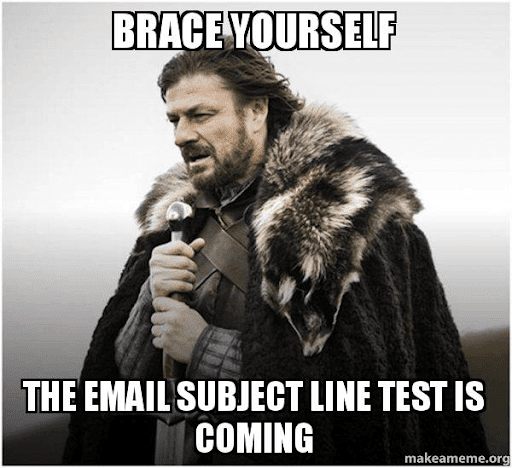
A/B testing
Every audience is different, and in some cases, one subject line that worked previously won’t be that effective anymore. And then, there is the following fact:
A/B testing can increase email open rates by 49%.
That is why you need A/B tests as much as possible. In order to do this, take 3 to 5 subject lines and send out those cold outreach emails to check which one has the highest open rate.
For example, in Skylead, you can test different subject lines for your outreach campaigns on autopilot and see which one works best for you.
Online email subject line testers
Online email subject line testers are nifty tools to have at hand if you are not sure about the effectiveness of your subject lines. Whether you wish to test the emotional tone of voice or the overall effectiveness of your subject lines, you can use tools such as Send Check It, EMV Headline Analyzer, or GradeMyEmail.
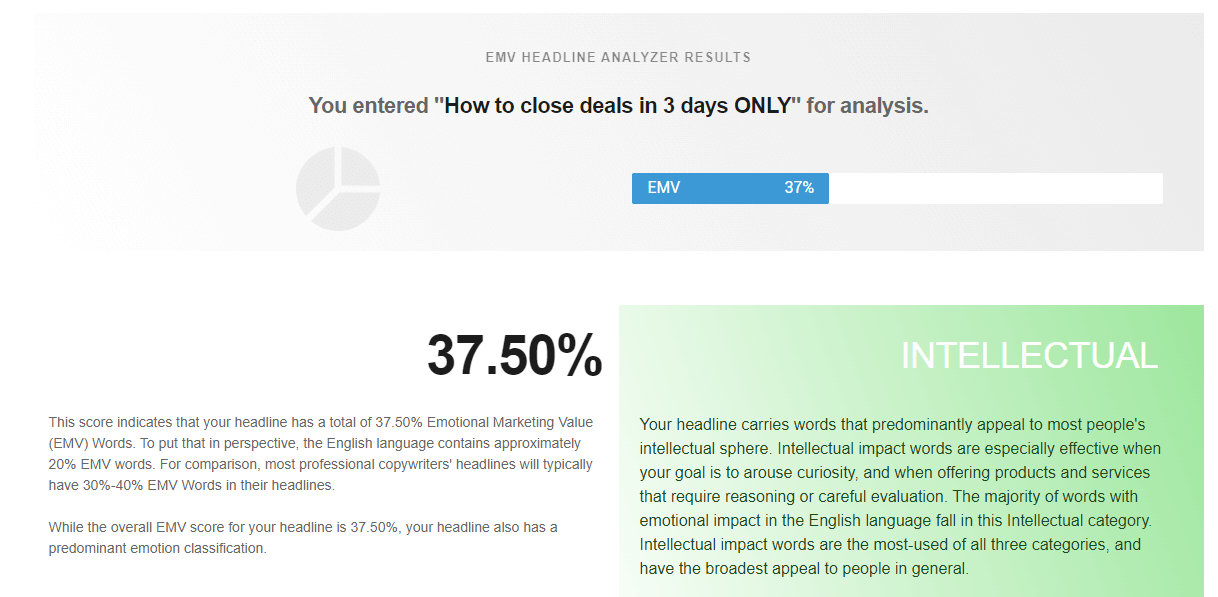
Email subject lines DON’Ts
1. Hi there
Avoid phrases such as Hi there, Greetings George, or Hello. The reason is they aren’t specific enough and do not show any hint of what the email message is all about. Instead, draw your prospect’s attention by clearly stating the purpose.
2. Misleading prospects
Being deceptive and promising your prospect one thing in the subject line and showing them another will annoy them. Consequently, you will lose trust and respect instantly. Not to mention, you will fail to close the deal with the prospect forever. Therefore, avoid click baits, or RE: and FWD: entirely just to get them to open up an email.
3. DO NOT USE ALL CAPS OR BUNCH OF EXCLAMATION POINTS!!!
See how that was unnerving and frenzy-like? Using letters in Caps Lock or with multiple exclamation points is a synonym for spammers these days. It also looks aggressive and distasteful, and you do not wish that for your brand, trust us. Furthermore, if you use this kind of email subject line, you risk getting your emails in the Spam folder. However, Caps Lock and exclamation points are not prohibited - you can always use one from time to time to emphasize your statement, but please do not go overboard.
4. Avoid spammy words
Similar to all-caps-lock words and multiple exclamation points, spam words can also ruin your outreach efforts. These words have been all over the internet for many, many years (not to mention billiards in the 80s) and are now considered repulsive and plain out pushy.
Here are a couple of examples to watch out for:
- Act Now
- Cash
- Cheap
- Credit
- Double your ROI
- Earn Extra cash
- Millionaires
- Free
- Fast money
- Get it today
Catchy email subject lines examples and templates
Follow up email subject lines
- Had a {{Topic}} idea for you since we last spoke
Example:
Had a social selling idea for you since we last spoke
- Been thinking about what you said
- Should I give up on you and close the file?
- I forgot to mention in our meeting that…
- The final and easy step…
- Tuesday meeting at 10PM
- Sending info I promised 👉
- I spoke with {{ReferredName}} and they said…
Example:
I spoke with Mark, and he said…
- Down to business - How we can help
- Need any help?
- {{firstName}} I need your advice
- Have 5 minutes for a quick call?
- I don't expect you to open this email but…
General cold outreach email subject lines
- ❤️ how you contribute to {{DesiredResult}}
Example:
❤️ how you contribute to closing the deals faster
- {{firstName}} let’s connect
- Are you completely happy with {{CompetitorName}}?
- Get lifetime access to {{SoftwareName}}
- What are your insights from {{Event}}?
- The most exciting opportunity for {{Industry}} companies in 2024
Example:
The most exciting opportunity for insurance companies in 2024
- Saw your amazing post - Interested in creating shared content?
- Exclusive for {{CompanyName}}: 3 tips to get conversion faster
- Congrats on {{Achievement}} 🥳
Example:
Congrats on becoming CEO 🥳
- Join forces? 👊
Urgent email subject lines
- Do you have these numbers and analytics yet?
- Hot conversion data insight for {{CurrentMonth}}, 2024
- Resource on {{Topic}} that’d go great in your {{Topic}} post
Example:
Resource on Email Statistics that’d go great in your Outreach post
- Omg {{firstName}}...
- It doesn’t look good
- 10 must-know trends to keep up on the market
- Your Free Trial is ending!
- Save 30% before the New Year
Email subject lines that entice curiosity
- Everyone’s favorite {{Occupation}} trick is…
Example:
Everyone’s favorite Sales trick is…
- 🤫 Real secret to {{Task}} or {{Benefit}} is…
Example:
🤫 Real secret to outperform outreach is…
- About your approach…
- I have a question about how {{DoingRelevantTask}}
Example:
I have a question about how you handle budgeting
- Does Thursday work for you?
- New year, a new strategy to {{Goal}}
Example:
New year, a new strategy to achieve 50+ conversions a month
- Are you taking advantage of your detailed reporting?
- How we accomplished {{DesiredResult}} in 2 months
Example:
How we accomplished 6x more sales in 2 month
- {{RelevantTopic}} trends that are the talk of the town
Example:
Sales strategy trends that are the talk of the town
- Save 5 hours a week with {{Task}} on autopilot
Example:
Save 5 hours a week with outreach on autopilot
- 56% of {{JobPosition}} use this trick to improve conversion
- A cheat-sheet for better conversion — Interested?
- {{Topic}} resources that can help you at this time
Example:
Cold outreach resources that can help you at this time
- 4 tips to help increase sales during hard times 💪
- It’s that simple 😃
- Few in the {{IndustryType}} know about these hacks
- Pick one out of these 2 strategies
Email subject lines that address pain points
- How to survive {{PainPoint}}
Example:
How to survive working 10 hours a day
- 5 easy steps to beat {{PainPoint}}
- How to deal with {{PainPoint}}
Example:
How to deal with LinkedIn algorithm
- 5 Ideas for {{PainPoint}}
- A resource to help you with {{PainPoint}}
- How happy are you with {{Department}} performance?
Example:
How happy are you with Sales performance?
- Steal this strategy from us - It will work for {{PainPoint}} 😁
- 7 tips for turning {{PainPoint}} around
- Proven solution to {{PainPoint}}
- Tired of {{PainPoint}}? Let’s have a chat
Subject lines that relieve pain and offer solution
- The fastest way to reach your Q2 target 💹
- Here is the shortcut to {{Benefit}} 🙌
Example:
Here is the shortcut to tracking performance easier 🙌
- Help is on the way - best strategies for LinkedIn lead generation
- Problem with closing the deals? Here is how to fix it easily
- Save up 5 hours of work per week
- {{ProductOrSolution}} empowers companies such as {{CompanyName}}
- Ready to implement {{Tool}} to eliminate {{PainPoint}}?
Example:
Ready to implement Skylead to eliminate wasting time on manual outreach?
Personalized email subject lines
- {{firstName}}, I was researching {{CompanyName}} and…
- {{ReferredName}} said to reach out to you…
Example:
Your colleague Steve said to reach out to you…
- {{ReferredName}} think you’ll love us too
- {{firstName}} I loved your post on LinkedIn about {{Topic}}
Example:
Sandy, I loved your post on LinkedIn about how to modernize sales
- Does this work for you {{firstName}}?
- {{firstName}}, a quick question regarding your performance
- {{firstName}}, I notice you try to achieve a 50% increase in sales
- Opportunity for {{CompanyName}}
- Partner up with {{CompanyName}}
- {{firstName}}, I have a story for you
- {{TheirCompetitorName}} VS {{CompanyName}}
- {{firstName}} perform {{Task}} better from Now on 💪
Example:
Andy perform outreach better from Now on 💪
- New managing employees strategy for {{CompanyName}}
- Loved the blog you wrote for {{CompanyName}}🔥
- {{firstName}} I missed you at {{Event}}
- What is your expert opinion on {{Topic}}, {{firstName}}?
Example:
What is your expert opinion on social selling, {{firstName}}?
- {{firstName}} is there a lot on your plate r/n?
Humorous email subject lines
- 🌮 Can we Taco ‘bout your growth?
- ⚽ I wondered why the ball was in my court, then it hit me
- I tried an elevator pitch - it was great on so many levels 🆙
- 🐝 You are likely an indecisive bee. Might I call you maybee?
- 🤝 Connect with you in present or future? It’s kinda tense
- 🪐 Should I organize a space for our meeting and planet?
- ⛵ Need a {{Topic}} strategy arc? I Noah guy.
Example:
⛵ Need a Sales strategy arc? I Noah guy.
- My coffee is mugged and waiting for your call 😅
- I'm gonna make him an offer you can't refuse…
- May the Force be with you, and {{YourCompanyName}}🌌
- {{ReferredName}} said to say hello to his little friend 🙋
- “You can’t handle the truth!” Or can you?
- Shaken, not stirred. 🍹 A {{Resource}} you asked for.
Example:
Shaken, not stirred. 🍹 A Guide To Outreach you asked for.
- I like {{ProductOrAService}} as my wine - sweet and victorious. Do you? 🍷
Frequently asked questions
How can one effectively A/B test different subject lines to find the most effective one for their audience?
A/B testing for email subject lines involves sending two variants to a small segment of your audience to see which performs better, then using the more successful one for the broader audience. Monitoring open rates for each variant provides actionable insights. You can automate A/B testing by using the LinkedIn automation tool and cold email software with such a feature, like Skylead.
Are there specific strategies for crafting subject lines that improve click-through rates, not just open rates?
To improve click-through rates, subject lines should create curiosity or offer value that compels the recipient to discover more inside the email. Personalization and urgency can also encourage clicks by making the email feel more relevant and time-sensitive to the reader.
How do the recommended subject lines perform across different industries, such as tech versus creative fields?
The performance of subject lines can vary by industry due to different audience expectations and content relevance. Customizing subject lines to reflect the specific interests and language of your target industry is crucial for maximizing engagement.
Summary
Strong and catchy email subject lines are mesmerizing and alluring to your prospects. They are links between your leads and your message. For this reason, it is important to make it as perfect as you can so you can increase the open rate, nurture the prospect and ultimately close the deal. And when you pass through the importance of it all, creating email subject lines and testing them can be fun indeed.
Here is a quick throwback of what you should and shouldn’t do when writing the email subject lines.
| Email Subject Lines DOs: | Email Subject Lines DON’Ts: |
| Use personalization | Avoid words such as Hi and Greetings |
| Make emojis your best friend | Do not mislead the prospects |
| Include numbers | Avoid words in Caps Lock |
| Make timely email subject lines | Remove excessive exclamation points |
| Hint the valuable content inside the email | Avoid symbols such as $$$ |
| Test your email subject lines | Forget about spammy words |
Now it’s your turn. Go and rock out those subject lines!
Wish to use Skylead for your outreach campaigns and A/B test your emails? We would be glad to hear from you and chat. Say hi by scheduling a Demo with us.
If you are asking yourself "How can I use Buyer Persona to boost sales?" or "What is a B2B Buyer Persona, at all?" then you are in the right place.
Buyer persona became a popular term that got tossed around in marketing teams, but then it landed in the sales lap and made them question their entire existence. Well, it wasn’t that dramatic, but it did make the sales teams think twice about who they should target when doing outreach.
Did you know that 56% of the companies that used buyer personas generated higher-quality leads?
Yes, Buyer Persona is that useful. Therefore, if showing you how to make an ideal customer profile was like taking your blindfold off while playing darts, going through how to create a B2B buyer persona for sales will be like placing the laser on your dart to make sure you hit the bull’s eye.
What is a B2B buyer persona?
Let’s start with the definition. A Buyer Persona is a description of a person who is your ideal customer with all behavioral, demographic, firmographic, and psychographic characteristics. In other words, a buyer persona mirrors who your perfect buyers are, from age, location, their likes and dislikes, goals, and wishes to challenges and motivations.
Buyer Persona is based on existing customer research and other data that might help you define your ideal buyer persona in detail.
There is a common misconception that Buyer Persona and Ideal Customer Profile are the same. However, there is a big difference between them. In short, ICP represents the company profile, and Buyer Persona focuses on the particular type of person’s profile only. Similar to Ideal Customer Profile, Buyer Persona is a perfect representation of the customer who has the shortest buying cycle, highest LTV and is a preacher for your product.
Did you know that 3 to 4 Buyer Personas usually represent 90% of the company’s sales?
If various customers use your product for different aspects of their business, or they simply differ in their position, you might want to think about creating multiple personas. Whatsmore, it is pretty common to have a couple of buyer personas for the sales team.
Example:
Let’s say you have project management software. Your software could be used both by programmers, sales, marketing managers, and alike. Each of these managers presents an individual buyer persona with different wishes, goals, and challenges.
Benefits of having buyer persona for sales
Do not think that Buyer Persona is the document you are going to create, look at it a couple of times and never use it again. Buyer Persona is a powerful document, and it is of great help when you are doing outreach. Why? Because of all the benefits listed below.
Provides details for prospecting and outreach
Buyer Persona provides context for your sales team to zero in on who exactly they should outreach to while outreaching. It will provide you with information such as age, position, industry, education, and consumer patterns to use for prospecting to your fullest.
Personalized approach
Once you have identified Buyer Persona, you will have access to information such as their pain points, challenges, and what type of person they are, so you will know exactly how to personalize your approach and present your product or service in the most alluring way to the prospect. Maybe you can throw in additional personalized images or GIFs according to their liking to improve the response rate.
Improves productivity
Having a Buyer Persona means that the sales team will ultimately ease up their process, improve productivity, results, and lower the time spent on their efforts. In addition, they will attract high-quality leads with more ease, who will ultimately have a higher retention rate.
Addressing customer’s problems
We all know that the core outreach rule is focusing on customers and addressing their problems instead of your own. B2B Buyer Persona will keep you on the right path to doing just that. Whenever you create your outreach message, ask yourself if it addresses the challenges or emphasizes how to reach goals listed in Buyer Persona documents. If it does not, get back to the drawing board.
How to create a B2B buyer persona?
Buyer Persona isn’t hard to create. However, it does take a little bit of time to get it right with all the information you need for the outreach. Luckily, we are here to explain six easy steps to create this useful piece of documentation.
1. Customers breakdown
Before jumping into the details of your B2B Buyer Persona, you need to break down your current customer database into groups. To do this, you need to decide on the broader criteria by which you will break them down and then move on to more narrow criteria.
Example (part 1):
Let's say your broader criteria is the length of the buying cycle. We can agree that some buying cycles are longer than others. Since you are looking for a shorter cycle for your future customers, this is a nifty point to start at.
The following step is to define your second and third criteria to deepen the breakdown.
Example (part 2):
Let’s say from this short-buying-cycle group you have different industries. Naturally, your following criteria would be to break the customers down by industry and then by decision-making role.
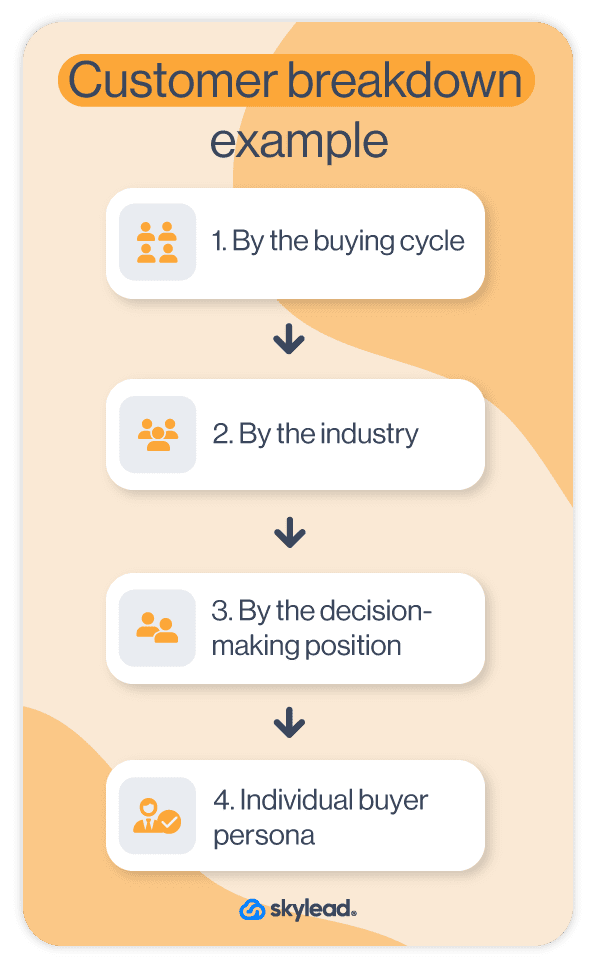
If, however, you do not have current customers, you can start with an industry breakdown and proceed to the decision-maker division.
2. Demographic parameters
Now you have a rough draft of B2B Buyer Persona. So, it is time to assign them demographic attributes. The key is to notice the pattern these customers have - their age range, interests, or location. If you are unable to pinpoint these patterns, here is the list that will help you out:
- Age
- Location
- Company type
- Function
- Seniority Level
- Job position
- Industry
- Years of experience
- Education
- Role in Buying process
- Recent life event
In case you do not have your current customers or customer insight, fear not. You can use the combination of Google Analytics and LinkedIn to gather this kind of information. If you are using Google Analytics, simply jump to your existing Audience Insights section (or ask your marketing team to do it for you :).
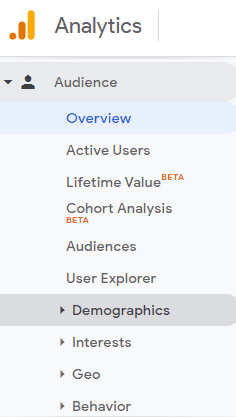
For LinkedIn, simple filter options will do the trick.
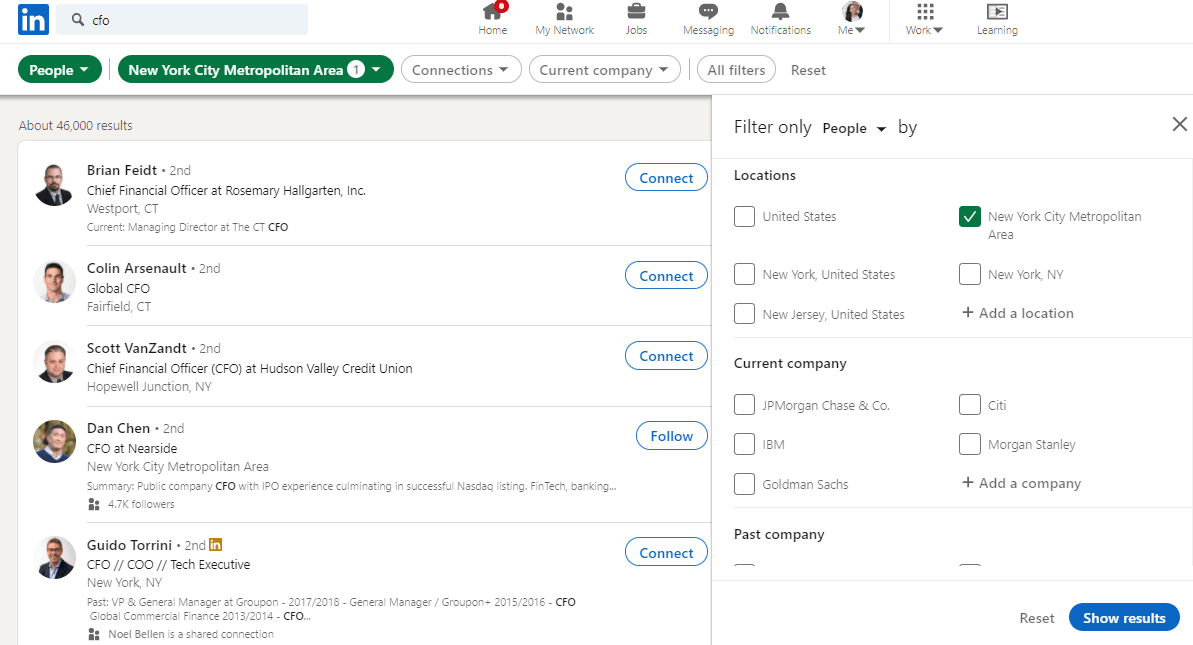
3. Psychographic parameters
To fill in the picture, you would need additional personal information. Psychographic characteristics are a great way to do it, as it will help you perceive your B2B Buyer Persona as more human, which will also humanize your approach.
Dedicate your Buyer Persona a name to start with, and then proceed on with:
- Likes And Dislikes: It is far easier to talk to someone whose general preferences you know, rather than hope that you won’t mess up if you mention something they do not like.
- Character type: This will give you an insight into how you should approach the person and construct your social selling. You can use 16 Personalities or similar to determine character type.
- Brand and influencers: You can choose the general ones or narrow them down. In addition, choose brands or influencers similar to your business to adjust your sales pitch.
- Work motivation: Information such as what drives them to go to work every day and what they like to do the most.
- Story Behind Buyer Persona: You can write a short description of what led them to a current position, what is their main trait, how many years they’ve been doing business, and so on.
- Preferred means of communication and Social Channel use: It’s also a good idea to find out where the ideal buyer spends time online and how they like to communicate so you know whether you should use multichannel outreach.
How to come by this kind of information?
If you have current customers, the best way to gather this kind of information is by simply talking to them. Here are a few key points to talk about with your customers:
- Means of communication they prefer;
- Social Media they consume the most;
- What is considered to be an achievement in their job role;
- Their motivations;
- What tools do you use as part of your daily routine? Why?
- What they like and dislike most about the job and communication with people;
- How they would describe a product’s purchasing journey;
- How would they describe their working persona;
Through these questions, the idea is to understand your potential customers’ true behavioral patterns and motivations. The more qualitative and quantitative detail you gather from this conversation, the better you will be prepared for these types of B2B Buyer Personas.
If you do not have your customer base or someone from your buyer persona to talk to, you can use LinkedIn to search for this kind of person and see what they write about in their post and gather information from there.
4. Identify buyer personas’ goals and pain points
In most cases, your prospects’ goals will be your own. Keep in mind, you are not just a salesperson, but the helping hand, a friend in need for their business efforts.
That is why you need to identify their goals, priorities, challenges, and pain points. Furthermore, depending on their pain point, you can adjust and personalize your outreach more to pinpoint and present what your prospects are looking for.
This is where conversation with your current customers comes into play once more. What you need to keep an eye out for is what are...
- your challenges?
- long-term and short-term goals?
- technology and tools used to achieve your goals?
- your work priorities?
- the influences of your purchasing decision?
Additional Note: If you do not have current customers, reach out to your leads anyway. You would be surprised how many people on LinkedIn will be willing to help by just telling them that you are doing the research.
5. Common objections and value proposition
Sometimes when you talk with customers, they will speak about your product or service. Let them, because they will reveal much about your product itself, and the problems it solves for them.
Furthermore, ask them about what they dislike about your product. It is important to understand negative viewpoints to bulletproof your outreach message. The message with this information will be a valid and irresistible value proposition for the B2B Buyer Persona.
Now is the time to ask one last tricky question: What do they usually say when they try to decline the offer from a salesperson? This is perhaps the most valuable information since they will list of objection handling situations that you can prepare for when you outreach this type of B2B Buyer Persona.
6. Assemble your B2B buyer personas
Gather your findings in one place and start building your B2B Buyer Persona. Keep in mind that every piece of information we mentioned above is applicable in practice, be it for outreach or prospecting. You can always go into even more details when defining a B2B Buyer Persona, such as marital status and so on, but the information mentioned above should be your core guide.
With this information, you have a specific description of your potential customer. Give your Buyer Persona name and surname, a picture, and you are done - at least with this one 🙂 Remember to repeat the process in the first step to create a couple more Buyer Personas for the outreach.
B2B buyer persona example and template
Here is an example of how it looks when you sift through the information and present them neatly in the document. A sight for sore eyes, isn’t it?

We’ve even created the template for you. You can download this buyer persona by clicking here. Click on the “Make a copy” button, and it shall be done.
How to use B2B buyer persona in lead generation?
Creating a Buyer Persona can be challenging, but now the real fun begins - it is time to put it into practice.
Remember that these are your IDEAL Buyers. However, if the person outside of your Buyer Persona is interested in your product or a service, do not discard them and proceed with the sales process.
Here is how you can use your Buyer Persona to find leads, create personalized messages and outreach them with more ease.
1. Find leads matching buyer persona using LinkedIn
There are two ways to find leads: by LinkedIn basic account search or Sales Navigator Search.
Find leads using LinkedIn basic search
Go to your LinkedIn account and research the position defined in your Buyer Persona document. Once you do, use additional filters available to narrow down the search according to your Buyer Persona, such as location, industry, and so on.
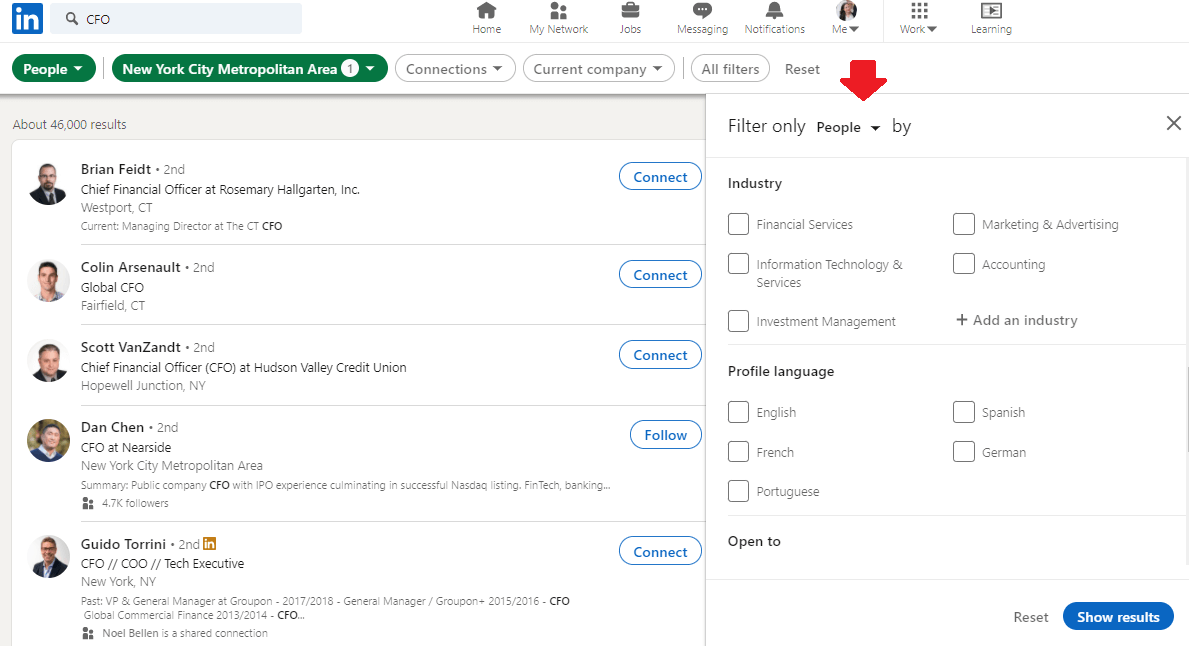
When the search is complete, create a CSV file with every prospects’ first name, last name, profile URL, and email if you can find it. Additionally, you can import variables such as Value proposition from your B2B Buyer Persona document. Save this file for the next step.
Find leads using Sales Navigator
Go to your Sales Navigator account and click on Lead Filters.

You will see the filters list you can use, so insert all the ones from your Buyer Persona document, such as Education, Years of Experience, Job title, etc.

Once you’ve filtered out the search, hit the “Save Search” button to save leads to the lead list.
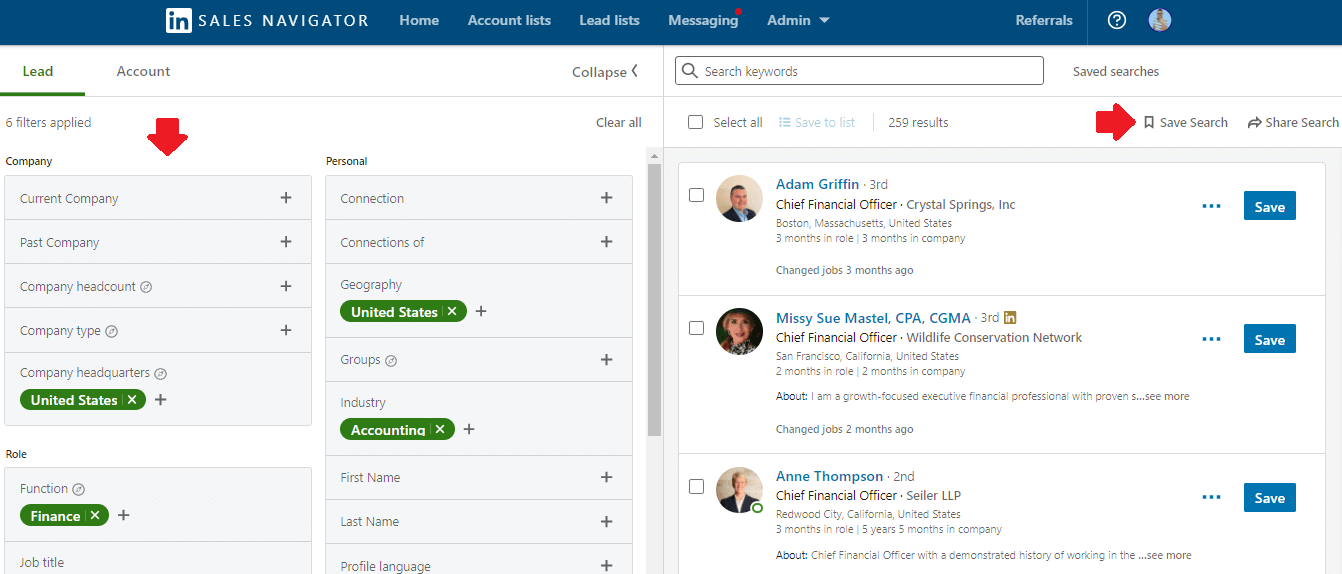
Another great way to find leads that are a twin picture of your ideal B2B Buyer Persona is to find that exact person, preferably your current customer, in Sales Navigator and hit the “View Similar” button. Sales Navigator will find leads most similar to the lead profile you select, according to position, age, education, and so on.

Save this list by clicking the “Save” button next to their names, and you are done.
2. Create an outreach campaign
You can outreach the leads you found manually, but to make this process easier, you can use a sales engagement tool to do it for you. Let’s take Skylead as an example. To create an outreach campaign, take the CSV file from LinkedIn results or URL from the Sales Navigator lead’s list, and upload or paste it into Skylead.
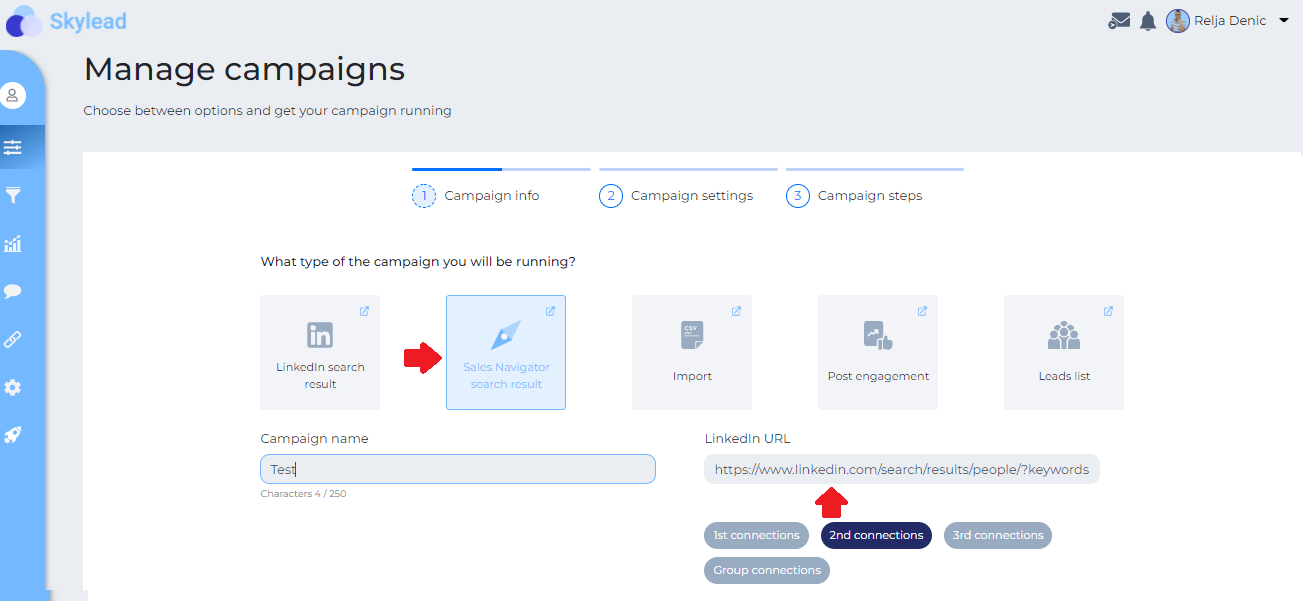
3. Create a Smart sequence for outreach
The Smart sequence will allow you to define the steps you need to take for your outreach towards the selected leads. Move and connect the elements, such as actions and conditions, will result in a sequence such as:

4. Personalize your approach
Remember when we mentioned the value proposition, motivation, and type character your B2B Buyer Persona is? This is where you are going to use them. When figuring out the message for the outreach, be sure to personalize it according to all these parameters.
Depending on how many steps your sequence has, you might use these pieces of information sporadically. Here is an example of one type of personalized message for outreach.
Hey {{firstName}},
I couldn't help but notice that working as {{occupation}} brings out different challenges such as {{Challenge1}}.
I know that {{Motivation}} is a huge factor in overcoming this challenge. But did you know that {{ValueProposition}} could be a perfect solution for it?
It would be great to hear more about how you operate in this regard and share some of my tips if you’re up for it.
How does Thursday at 1 PM sound?
And you are done! Relax and enjoy the results Skylead brings to you.
Summary
Buyer Persona helps you bring the right prospects to the table. Furthermore, it provides you with the details which you can use for prospecting and outreach, improving productivity and results. Here are the steps to remember:
- Customers’ Break-Down
- Define Demographic Parameters
- Define Psychographic Parameters
- Identify Goals And Pain Points
- Define Common Objections And Value Proposition
- Assemble The Buyer Persona
Now you go! Create your outreach campaign, use the information you gathered and watch leads convert more efficiently and with ease.
Wish to use Skylead to find and outreach your Buyer Persona with ease? We would be happy to meet! Drop us a message via chat on our website. Or, try out Skylead by signing up for a 7-day Free Trial.
In today’s crowded Inboxes, the struggle to get a response is real.
Whether you are reaching out via LinkedIn or email, it has never been easier to get in touch with someone. It’s just that now, standing out in the sea of messages has become an art to be mastered.
There are many reasons why your ideal lead is not replying. However, each solution to this problem starts with catching their attention. One of the approaches that might not be as popular (yet!) with sales reps, but that showed itself pretty effective is including personalized GIFs and Images into your outreach routine.
But before you say that personalized GIFs and Images seem unprofessional or that they exceed too much work, let me tell you that I too was skeptical in the beginning. I came across several personalized GIFs our Sales Team uses in their outreach campaigns, and thought to myself - this looks kind of weird.
However, not until I saw their response rates that went up by 63% and experimented with some outreach campaigns of my own, did I realize the power of personalized GIFs and Images.
That’s why I decided to share tips and tricks picked up by talking to sales reps that scaled up Skylead and following top industry professionals on and off LinkedIn.
In this blog, we’ll touch upon:
- How to prepare for outreach to increase your response rates;
- Why personalized GIFs and Images make people reply to your message;
- Dos and Don’ts when including personalized Images & GIFs;
- 10 templates of personalized Images & GIFs that helped level up our Sales Team’s response rates.
Poor targeting equals poor response rates
Yes, we’ve gathered here to talk about how to increase your response rates by implementing personalized GIFs & Images into your outreach routine. However, there is one thing that we cannot stress enough. The absolute prerequisite to skyrocketing the number of your replies, Her Majesty - the Targeting.
You can have the best copy in the world and be the most skilled sales rep that ever walked this Earth, but if you are talking to the wrong person, not much can be done. Yes, there is always a way to ask to be redirected to someone else, but why waste resources? Put some time into LinkedIn prospecting and coming up with a quality outreach plan (messages, channels, segmentation strategy, Images & GIFs), and then just focus on closing the deal.
Good sales reps have a clear understanding of who they want to reach out to and they handpick leads even when using a sales engagement platform to make their lives easier (‘cause, why not? We do live in the 21st century, after all). You would be surprised how many sales reps don’t reach their quotas just because they feel lazy to put some time into quality targeting. It’s quite a shame, especially because LinkedIn offers lots of options to find different profiles for those who think strategically.
- Target leads that attended a LinkedIn event of your interest;
- Use the LinkedIn poll to survey your ideal prospects and then reach out to your target group;
- Connect with LinkedIn members that commented or engaged with a certain LinkedIn post;
- Join a LinkedIn group to make meaningful connections and eventually reach out to other members. Choose a community where your target audience gathers for this approach to work. The more specific the niche, the better the result;
- Sign up for Sales Navigator and take full advantage of its advanced filtering options;
- Apply Sales Navigator hacks that only top-notch industry professionals use when targeting leads.
Why personalized GIFs and images work
They’re eye-catching
GIFs, images, and even vector graphics especially if personalized, are more interesting, dynamic, and eye-catching in comparison to static text. The studies have shown that the average person sees over 5000 marketing messages per day. This number goes up when it comes to decision-makers and top-level managers. Therefore, your message has about 8 seconds to capture your lead’s attention. That’s why, when the lead opens your message, even if initially they didn’t want to reply back, receiving a personalized GIF or Image will stick their minds. Consequently, the chances of getting a response are increasing.
You show extra effort
Some leads that receive a personalized GIF or Image respond just because they recognize the effort you put into your outreach. And we know that in sales, sometimes all you need is that one response to spiral up the conversation in the right direction.
They don’t come off as salesy
Instead of sending a reminder message or trying to sell straight off the bat (which is always a big no-no), going with a personalized GIF or Image seems more low-key, yet far more effective for you lead generation on LinkedIn (or off). It might even make your lead laugh a little bit! And that’s always memorable.
What to pay attention to
- Using humor in your outreach is always a good idea. This applies to personalized GIFs and Images as well. However, before making a joke do your research. Consider each person’s unique cultural background, and avoid anything you even have the smallest doubt might conflict with it.
- Don’t use GIFs or Images that make fun of your or your lead’s competition. It’s just a sign of bad sportsmanship and never comes off well.
- Keep it short and to the point.
- Be prepared that not everyone will appreciate it. Sending personalized GIFs and Images can be a two-edged sword. But - If you don't take risks, you don't drink champagne.
- Know when to stop. If the first doesn’t work and you don’t get a response, don’t send another personalized GIF or Image. Go with a backup plan.
- A/B test different personalized GIFs or Images to get a response that you wish for.
How to make a personalized GIF or image?
There are two ways to personalize a GIF or Image - manually or through a sales engagement platform.
I and our Sales Team use Skylead’s native Image & GIF hyper-personalization feature. However, you can do it manually with any other tool you feel comfortable with.
As far as Images and GIFs are concerned, we simply download them from the internet or from Giphy, for instance. More creative ones take their own photos or mini videos that turn into GIFs on Ezgif (super-easy, btw) and then personalize them to fit their leads (and needs).
If you’re using Skylead for your outreach, this is how including a personalized GIF or Image looks on LinkedIn and in an email.
LinkedIn message
A personalized GIF or Image shows as a link with a preview. That way your lead is more likely to click on it, as people tend not to open these kinds of files otherwise.
Email message
A personalized GIF or Image is fully embedded in the body of the email and it shows as represented below.
10 templates of personalized images & GIFs
Send a personalized Image to your lead to invite them for a zoom chat.
Hello Amie,
Thank you for adding me to your network!
I saw that you’re a Head of Marketing at Edge Project. I help B2B companies generate more leads through deep personalization on LinkedIn.
Let’s jump on a Zoom call sometime this week?
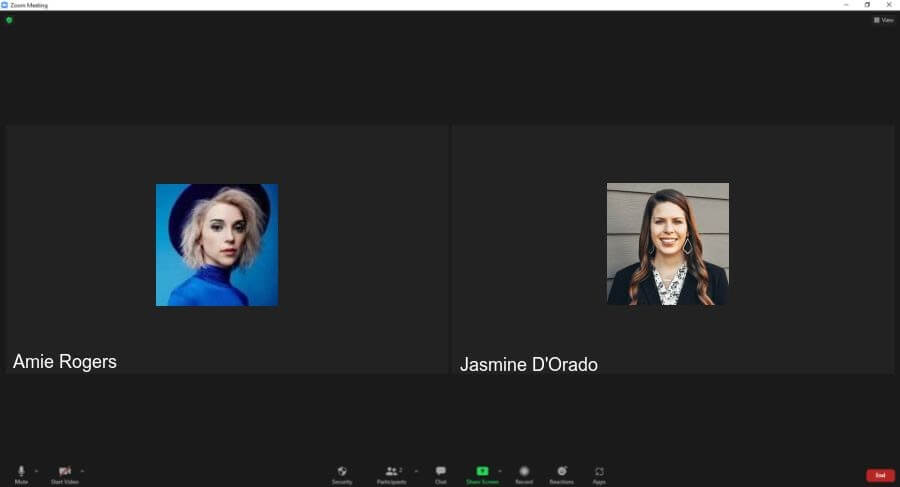
Example #2 Conversation starter
Thank your lead for accepting your Connection Request. This can be an excellent conversation starter. Adding a message copy is optional, as this personalized GIF speaks for itself.

Example #3 Humanize your pitch
People want to talk to real people not company pages anymore. This is the number one concept of social selling. Yes, LinkedIn has account profiles as well, but outreach should always be done by people who work in these companies and should represent the personification of that brand. Showing your face in the outreach improves response rates.

Example #4 Overcome common sales objections in a humorous way
One of the most common objection handling situations is I already have a solution. If you don’t know how to approach it, break the tension with a humorous personalized GIF or Image, and then take it from there.
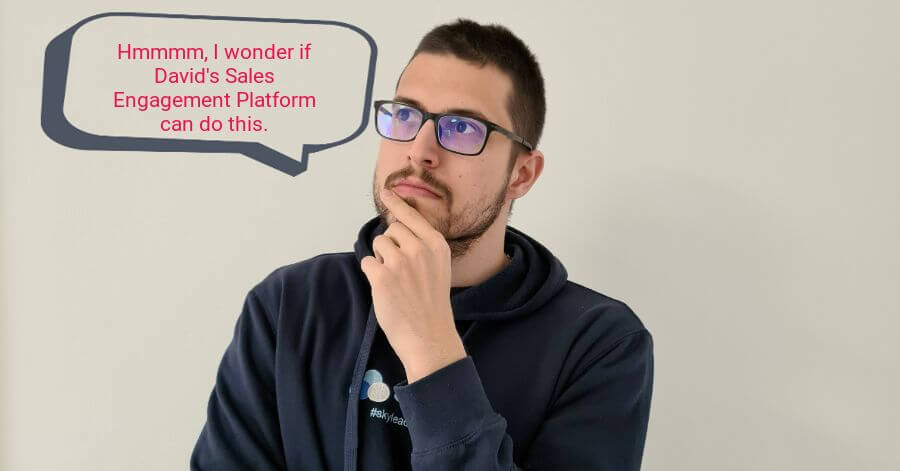
Example #5 Ask for something
Asking complete strangers to fill out a survey or give your their feedback (or anything for that matter) is a really arduous task, as they don’t owe you anything. The truth is, no one owes you anything. However, feedback and surveys help you and your business grow. Always be listening to your customers, right? Here’s a fun way to get a response.
Hello Iris,
Thank you for attending my webinar “Content Marketing For Niche Markets”.
Quick question - what were the most valuable lectures for you? Is there anything you found redundant for your niche in particular?
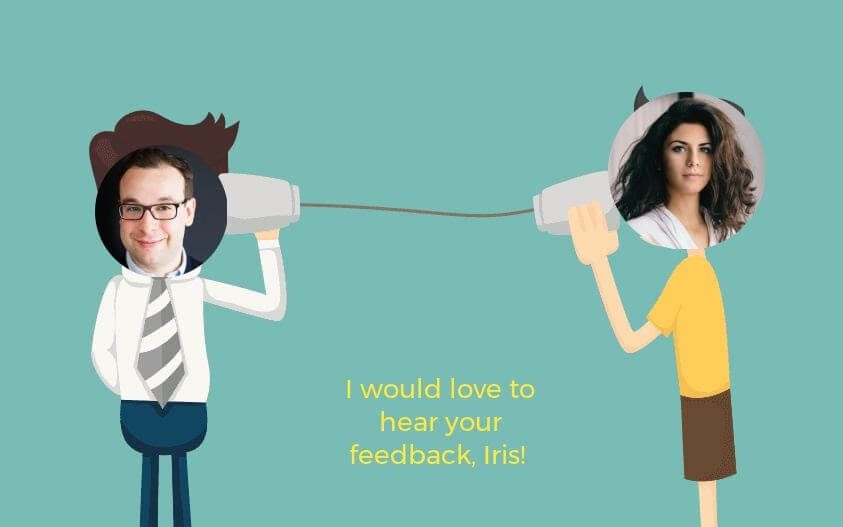
Example #6 Make your email invite more casual
There are so many different professional communities and popping a link to your lead to join yours is not enough anymore. You can always lighten up your message with a personalized GIF and make your lead click on the link to at least check it out for a start. It will definitely draw attention among others who just write something like Join my community here {{link}}.
Hello Marie,
I saw that you are Head of Sales at FlyProject. I have this community dedicated to the sales industry that I would love you to join.
We discuss - cold outreach, growth tactics, and anything sales-related.
Here’s the link https://www.facebook.com/groups/sales.tribe.community
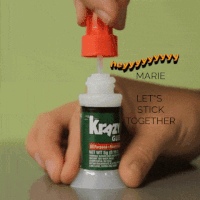
Example #7 Make them ask you for more information
Experiment. Play with your outreach. You will only know if you try. Yes, some might say that this message should maybe give more information about the event itself. However, have in mind that nowadays everyone checks out you and your company on LinkedIn before replying to any sort of message either way.
Hey Helen,
Wanna join my…

Example #8 Pinpoint a problem that you offer a solution to
You can make an industry-related joke and strengthen it with a personalized GIF so that your offer doesn’t seem too salesy.
Hey Jeremy,
What does the SEO professional see when they see twins?
Duplicated content.
Jokes aside, every business needs an SEO touch-up, and I just might be your girl!
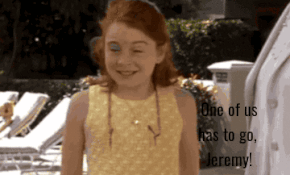
Example #9 Illustrate your end-goal in a non-salesy manner
As mentioned above, GIFs and Images in outreach can be an excellent alternative to a salesy message. Or, at least, then can soften it a bit.
Hello James,
I don’t know if you’ve heard the news, but JKL Transportation & Logistics has a truck shipment that currently offers the highest number of destinations around the world.
Since you expressed some concerns regarding truck shipment in David Jones’ post, I just wanted to offer help and clarification regarding some issues. I truly believe that E-jewel can benefit from it!
Let me know what you think!
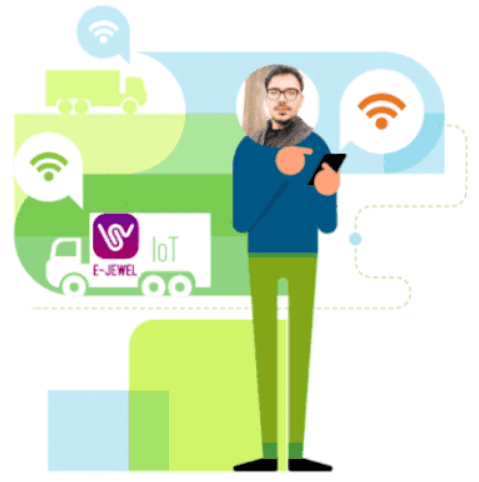
Example #10 Pump up your lead’s enthusiasm
Booking a call or scheduling an appointment should not be taken for granted! Not only did you work hard for it, but it is equally important to keep your lead pumped for it as well! Replying simply with Ok, it’s a deal can be substituted with something like this. It will keep your lead excited as well and eager to hear what you have to say!
Alright, Danny!
It’s a date! Monday, at 3 pm.
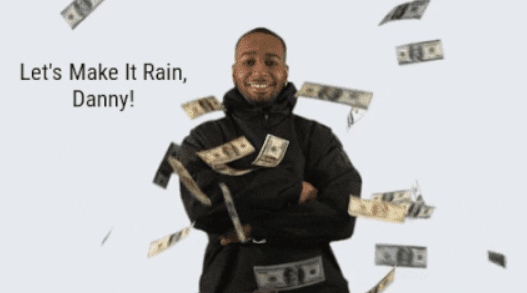
To sum up
Yes, the struggle to get a response is real but pretty overcomeable with the willingness to think outside the box.
‘Cause, what would you rather - work hard and book less or work smart and book more?
The way you do your outreach directly mirrors the way you do your business. People recognize that. Putting extra effort into addressing your leads communicates that you are the person who always strives to deliver more than expected. And who wouldn’t want to work with someone like that?
Speaking of, you know who also strives to deliver more than expected? Skylead. Sign up for a 7-day free trial, and see it for yourself!
